ʌnthonis-de-roo⍱ere-bosch
Where dreams stitch the continuum of existence, and enigmas blossom under the watchful eyes of contemplation, navigate the odyssey of surreal revelations, and surrender to the odyssey of enlightenment's intricate dance.
{ai image stories home}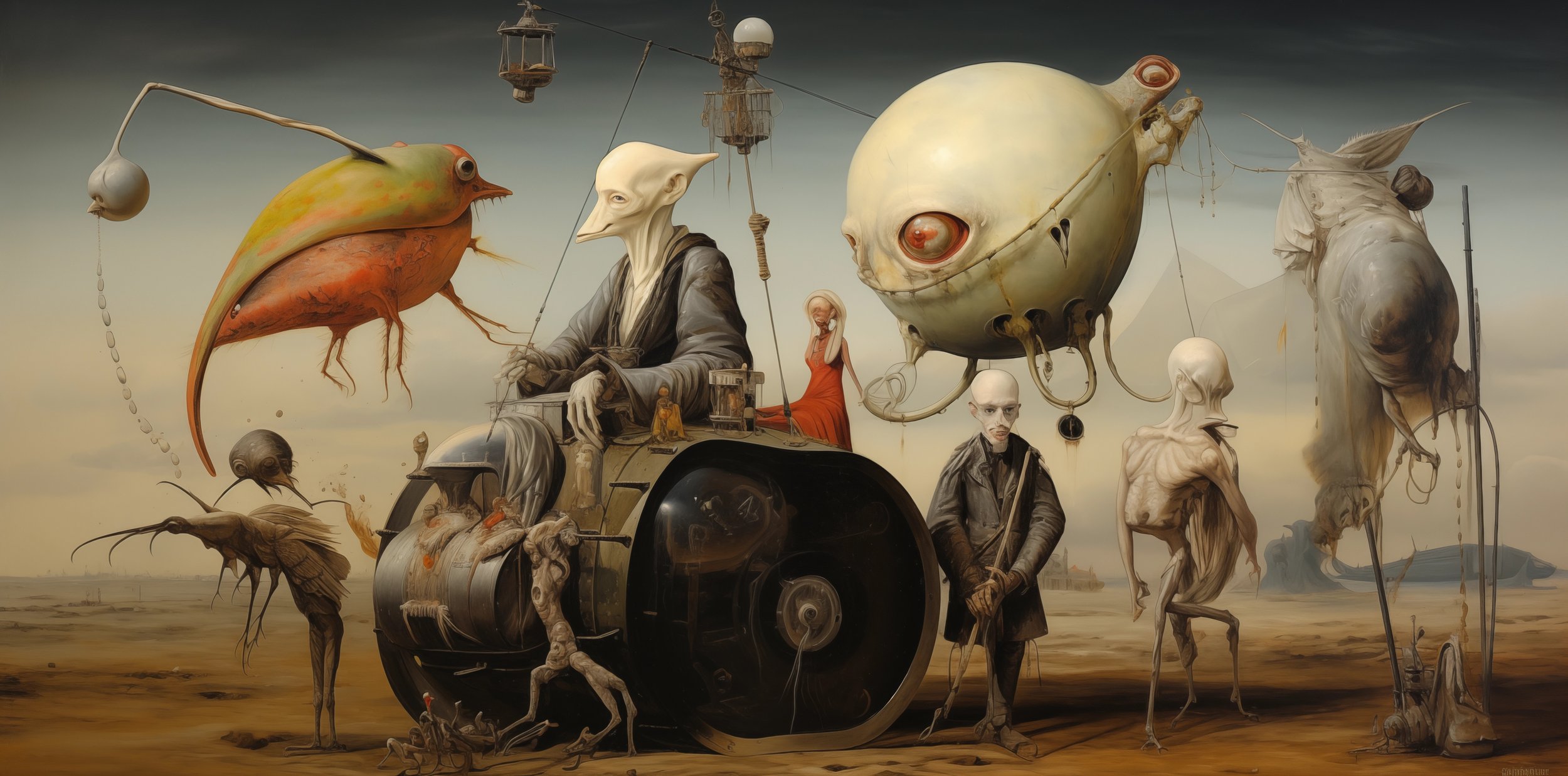
The Caravan of the Lost
A surreal procession trudges through the barren wastes, a mirage of the forsaken and the forlorn, each figure a testament to the myriad paths of existence. At its heart, the Navigator, a pale specter of wisdom, commands a vessel of dreams, steering through the desolate sands of time.
This caravan is no ordinary journey; it is an odyssey of the soul. The creatures, each a distorted echo of life, are bound by a common search for purpose in a land where purpose seems extinct. The woman in red, her eyes closed in silent prayer or perhaps despair, embodies the hope and suffering that fuels their march.
They travel not over ground, but over the bones of forgotten philosophies, past civilizations that once thrived on questions of existence. The Navigator, with his blank gaze, has seen empires rise and fall, and now seeks the horizon where answers may lie. His companions, the disfigured and the outcast, follow not out of sight, but out of faith in the unknown.
In the eyes of the beholder, this caravan poses a challenge: to find direction in a world devoid of signposts. It is a reminder that sometimes, to journey without a destination is to find the paths that maps cannot chart. They move forward, not in defiance of their plight, but in acceptance of their quest for meaning in the vast, indifferent universe.
In the silence of their passage, a whisper to the wind: "We are all lost, in search of a beacon. Let us be each other's light."
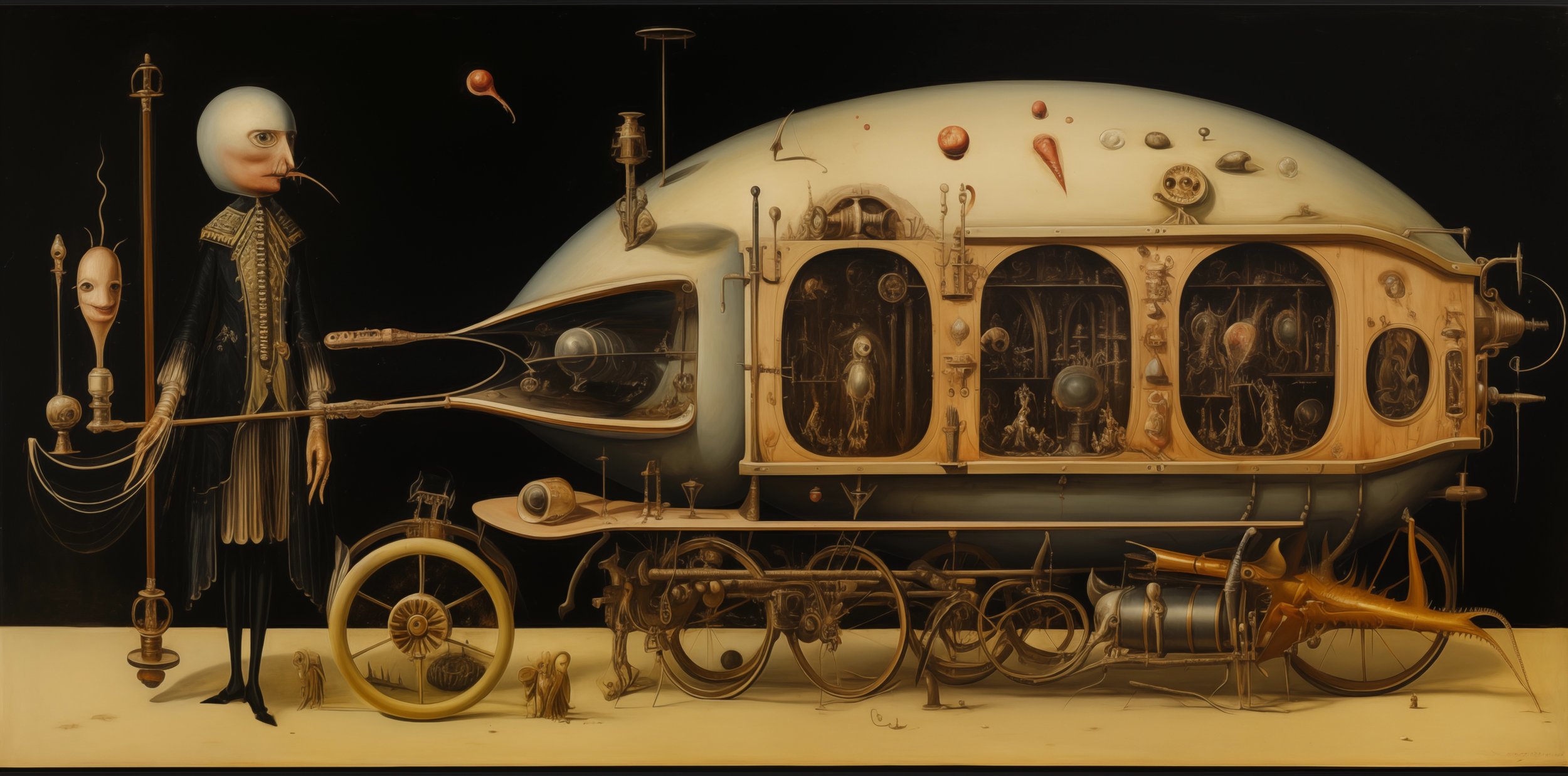
The Vessel of Existential Musings
Upon the plains of contemplation rolls a vessel, not of wood or steel, but of human curiosity and the ceaseless pursuit of knowledge. At its helm stands the Chronicler, a figure robed in the garb of time, holding the scales of balance between the known and the unknowable.
Within the confines of its hull, a microcosm of existence is on display, specimens of life and thought encased for study. The Chronicler, with a face impassive and inscrutable, conducts the symphony of inquiry, each movement a question, each pause heavy with anticipation for answers that may never come.
The apparatus that propels this caravan of cognition is not fueled by coal or steam, but by the raw, relentless drive of inquiry. Its wheels turn not upon the ground, but upon the ever-shifting sands of philosophy, grinding the grains of certainty into the dust of doubt.
Through its journey, the vessel collects the wonders and horrors of existence, challenging onlookers to peer within and confront the enigmas that lie at the heart of being. The Chronicler, a silent sentinel, invites us to ponder the purpose of the collection. Is it a mere archive of anomalies, or a mirror reflecting our innermost curiosities and fears?
As the vessel moves through the darkness, lit only by the lanterns of past wisdoms, it becomes clear: this is no mere conveyance, but a testament to the odyssey of the mind. It is a reminder that the journey for truth is fraught with more questions than destinations.
In the stillness that follows its passing, one can almost hear the whisper of the Chronicler's quill, etching out the next chapter in the endless book of existential musings.
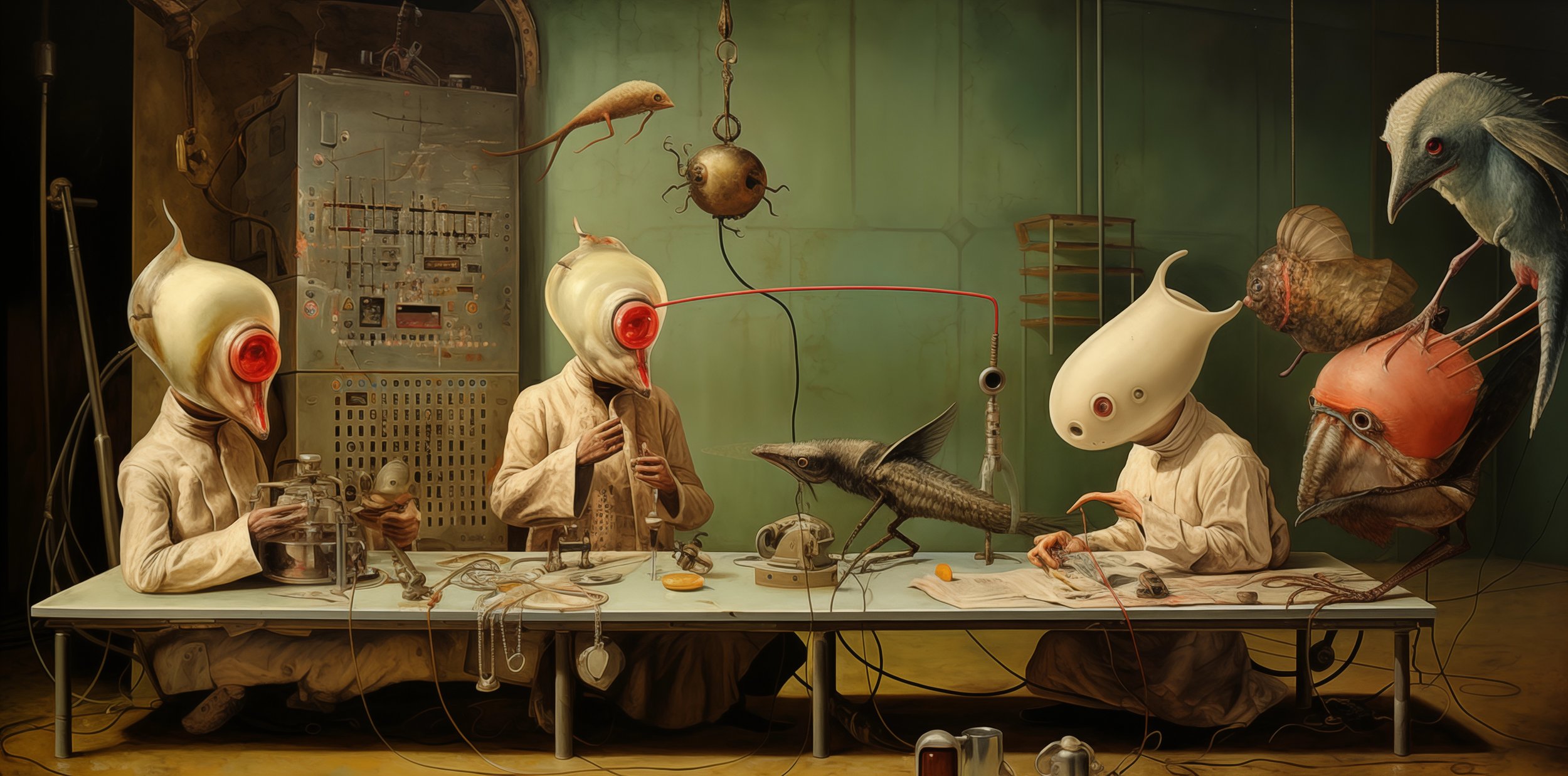
The Symposium of the Absurd
In a room that defies the norms of nature and logic, a gathering of the most peculiar intellects is underway. The Symposium, as they call it, is not bound by the limits of human flesh or earthly biology; it's a congress where the eclectic minds of otherworldly beings converge in discourse.
At this table, a debate rages, not in words but in thoughts unspoken, transmitted through tendrils of unseen connections. The participants, garbed in the attire of anonymity, their faces obscured by masks that amplify the senses, engage in an exchange far removed from the mundane chatter of terrestrial meetings.
The fish, once a silent swimmer of the deep, now vocalizes its aquatic wisdom, while the bird, perched with a scholar's poise, offers a perspective from the skies. The human form, once the standard of intellect, is but one voice among the many, its dominance in discourse humbled by the diverse company it keeps.
The Symposium is a metaphorical tableau, asking the silent observer to consider the validity of knowledge from all forms of life. What truths can a fish know that a man cannot? What secrets of the air are whispered to the bird and lost to those who walk below?
As the instruments of experimentation lay scattered, unused on the table, the scene unfolds as a grand experiment itself—one that tests the boundaries of communication and understanding between the varied elements of existence.
The Symposium challenges us to expand our definitions of intelligence and sentience, to listen to the symphony of the universe in all its harmonic and discordant notes. It whispers a question as old as inquiry itself: What if the truest wisdom lies in the minds we have yet to understand?
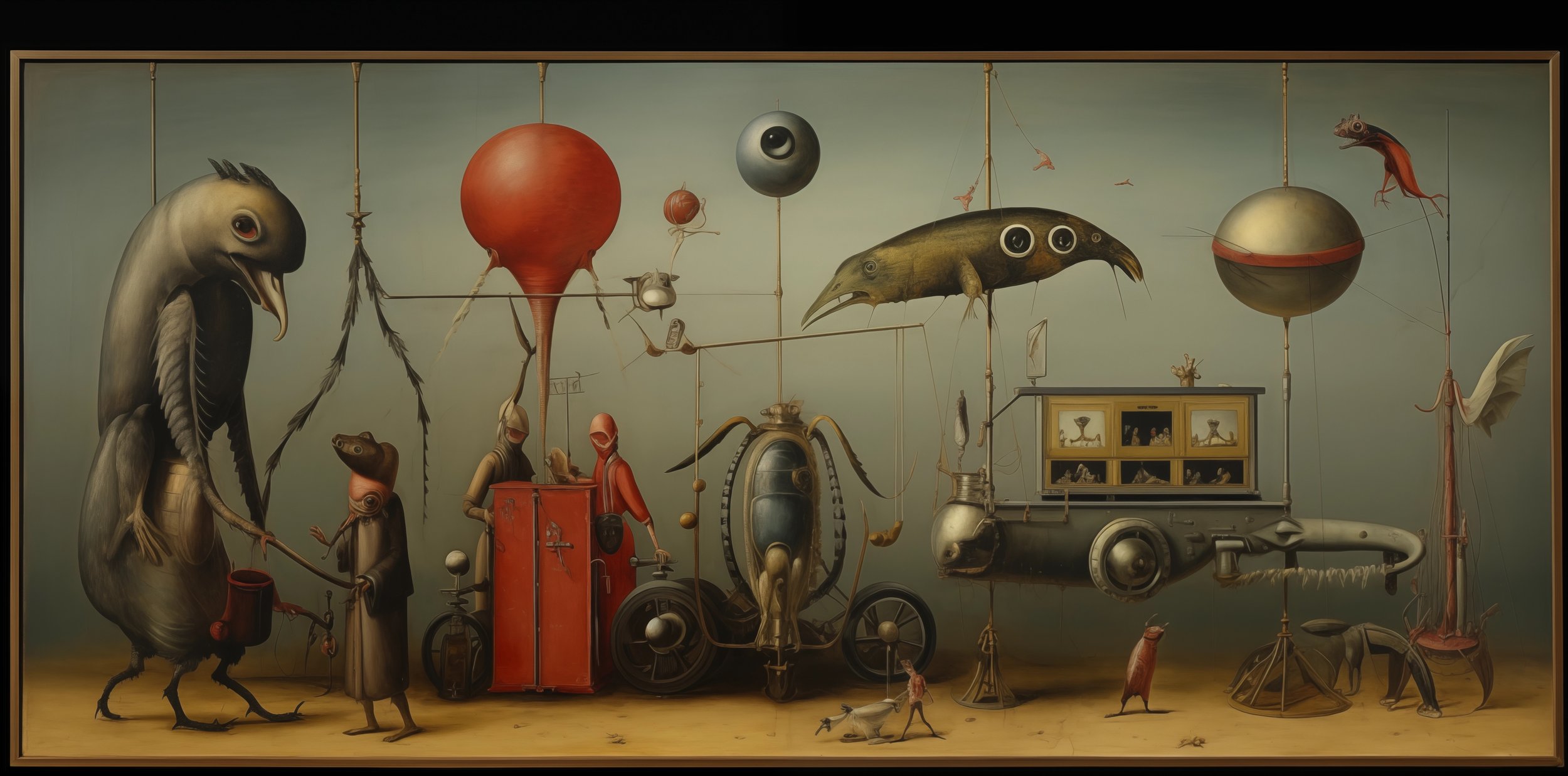
The Theater of the Marvelous
In the midst of a landscape that transcends the ordinary, a peculiar theater unfolds. This is a spectacle of the bizarre, a carnival of the curious, where each participant plays a role in the grand performance of existence.
The Penguin, majestic yet whimsical, converses with a creature of uncanny countenance—a blend of the mundane and the extraordinary. They stand not on soil but upon a stage set for the fantastic, their dialogue a silent pantomime that speaks volumes to those who dare to listen.
Amidst them, a cabinet of life's marvels is presented, showcasing the diversity of form and thought that populates this otherworldly realm. The airborne fish, with eyes that pierce through the veils of reality, swims through the ether, a sentinel of the skies, watching over the unfolding drama.
The red-robed figures, masked and anonymous, engage with mechanisms that defy the laws of physics, their actions a choreographed dance with the machinery of dreams. They are the keepers of this realm, the engineers of enchantment, working the levers that weave the fabric of this phantasmagoria.
This theater is not merely for entertainment but a reflection of the layers of consciousness that exist within and beyond our own. It invites the observer to consider the myriad possibilities that life could take, the forms and narratives that are as real in imagination as the ground beneath our feet.
In the stillness of this scene, the audience is left to ponder: What act do we play in the theater of our world? Are we the performers, the audience, or perhaps both, in the grand spectacle of the cosmos?
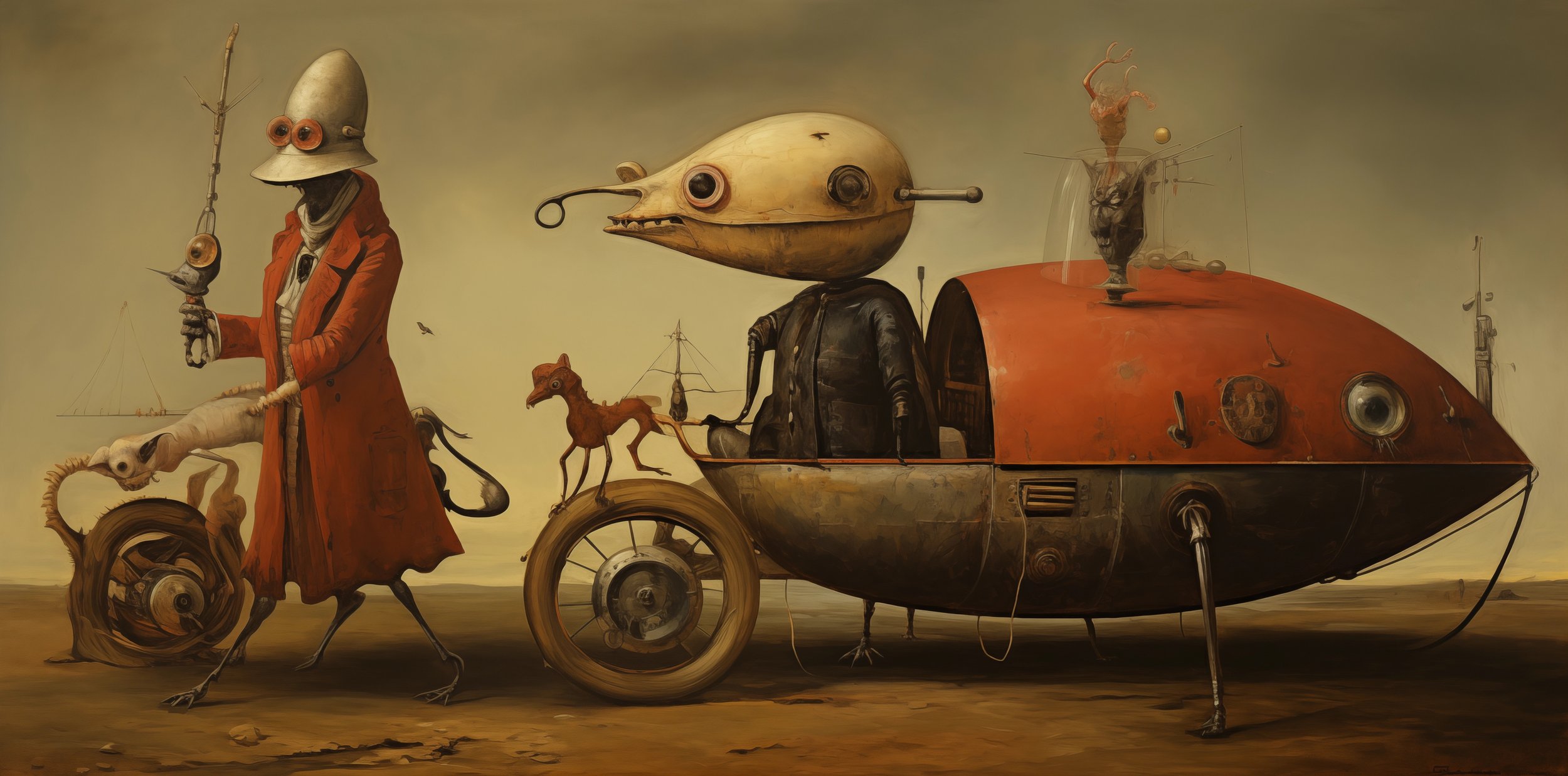
The Pilgrimage of the Perplexed
Across an expanse where the horizon blends dreams with reality, a procession of the enigmatic embarks on a journey of the profound. The Pilgrimage is led by the Guide, clad in a coat of crimson, a beacon amidst the haze of the unknown.
The Guide's companion, a creature of remarkable peculiarity, wheels a device that defies nature—a contraption of life's skeletal remnants repurposed for mobility. Together, they navigate the dunes of a world where the ordinary has no dominion, and the extraordinary becomes the guidepost.
Astride the mechanical beast, a character of indescribable origin, its visage an orb of innocence, surveys the land. It is a silent observer, perhaps a sage, whose simple presence poses questions to the very nature of existence.
In the background, a tableau of life's diversity plays out—an ethereal horse prances without a care, while specimens of unknown species float in a glass dome, each a piece of the puzzle that is life's tapestry.
This pilgrimage is not to a shrine made by hands or to a site marked on maps. It is a voyage to the inner sanctum of the mind, where the sacred and the profane dance in the shadows of understanding.
The procession moves steadily, each step a testament to the resolve of those who seek not just sight, but insight. The Guide, the beast, the orb-headed sage, and the creatures in tow—all travelers in the odyssey of the perplexed, searching for the truths that lie just beyond reach.
In the silence of the desert, the Pilgrimage whispers a universal query: What worlds could we discover if we dare to traverse the landscapes within us?
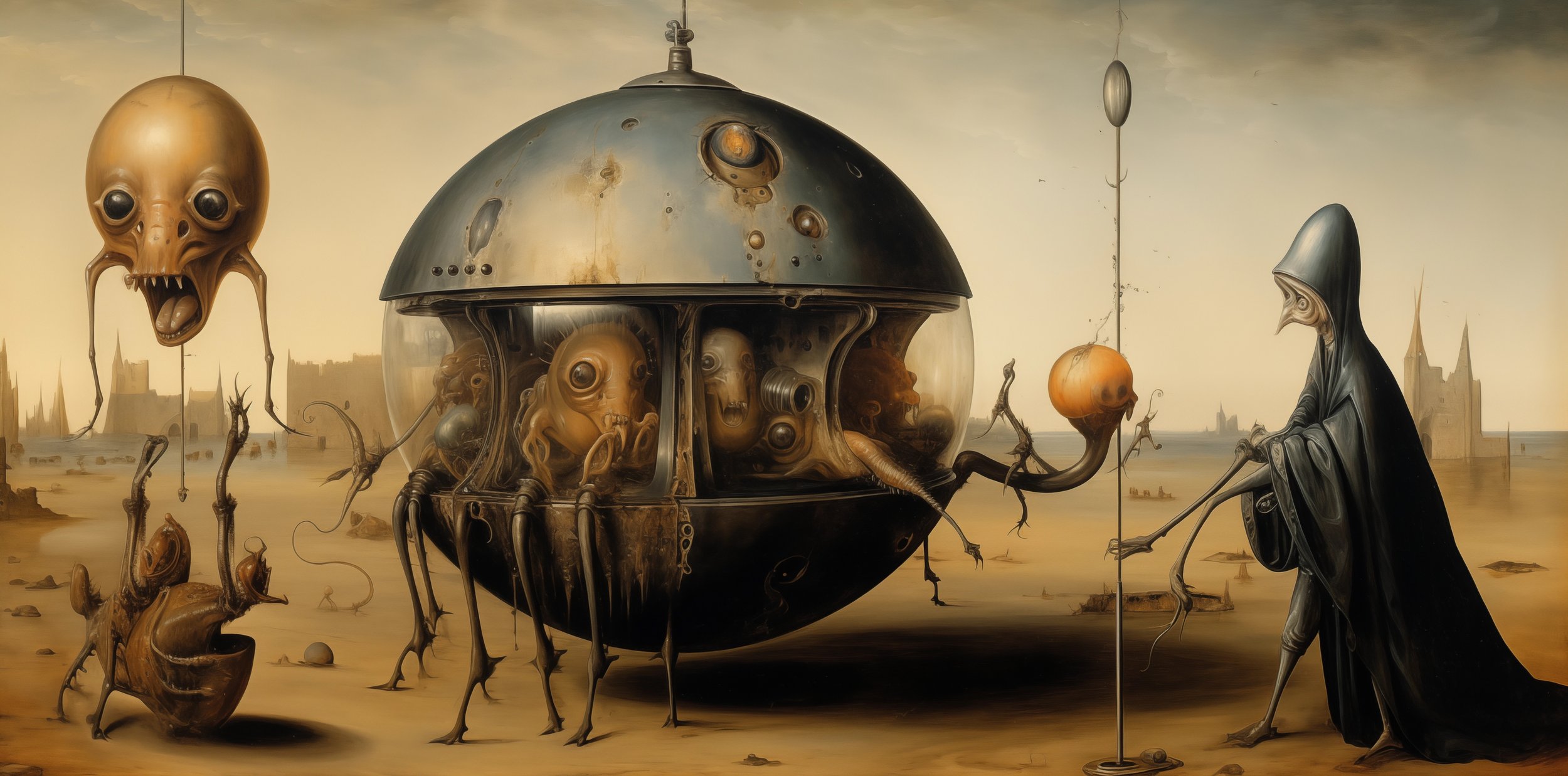
The Conclave of Existences
On the plains where reality fades into the surreal, the Conclave convenes—a gathering of existences diverse and profound. The landscape itself is a canvas, painted with the hues of twilight and the shapes of dreams.
The Observer, cloaked in the mystery of a thousand riddles, stands at the edge of this assembly. With a visage of contemplation, the figure gazes upon the spectacle, a silent guardian of the threshold between worlds.
At the heart of the Conclave, a vessel rests, its cargo a collection of beings whose forms defy description and whose eyes tell tales of worlds unseen. They are the silent witnesses to the Conclave's purpose—an exploration of the myriad facets of being.
Suspended above, an entity of enigmatic origin, its features a blend of the innocent and the ominous, oversees the congregation. It is both a part of the gathering and apart from it, a sentinel of the unknown.
The creatures that attend this meeting are as varied as the stars in the sky, each unique, each an integral note in the symphony of the cosmos. They are connected not by form but by the shared curiosity of existence, each seeking the harmonies of universal truth in the vast opera of creation.
This Conclave is more than a meeting; it is a nexus of potentiality, where the many paths of existence converge and diverge in a dance as old as time itself. It is a reminder that the universe is not merely a collection of objects, but a communion of subjects, each with its own story, its own wisdom.
As the sands whisper secrets to the wind, the Conclave's enigma remains, a question etched in the very fabric of the cosmos: What wonders might we uncover if we listen to the voices of all existences?
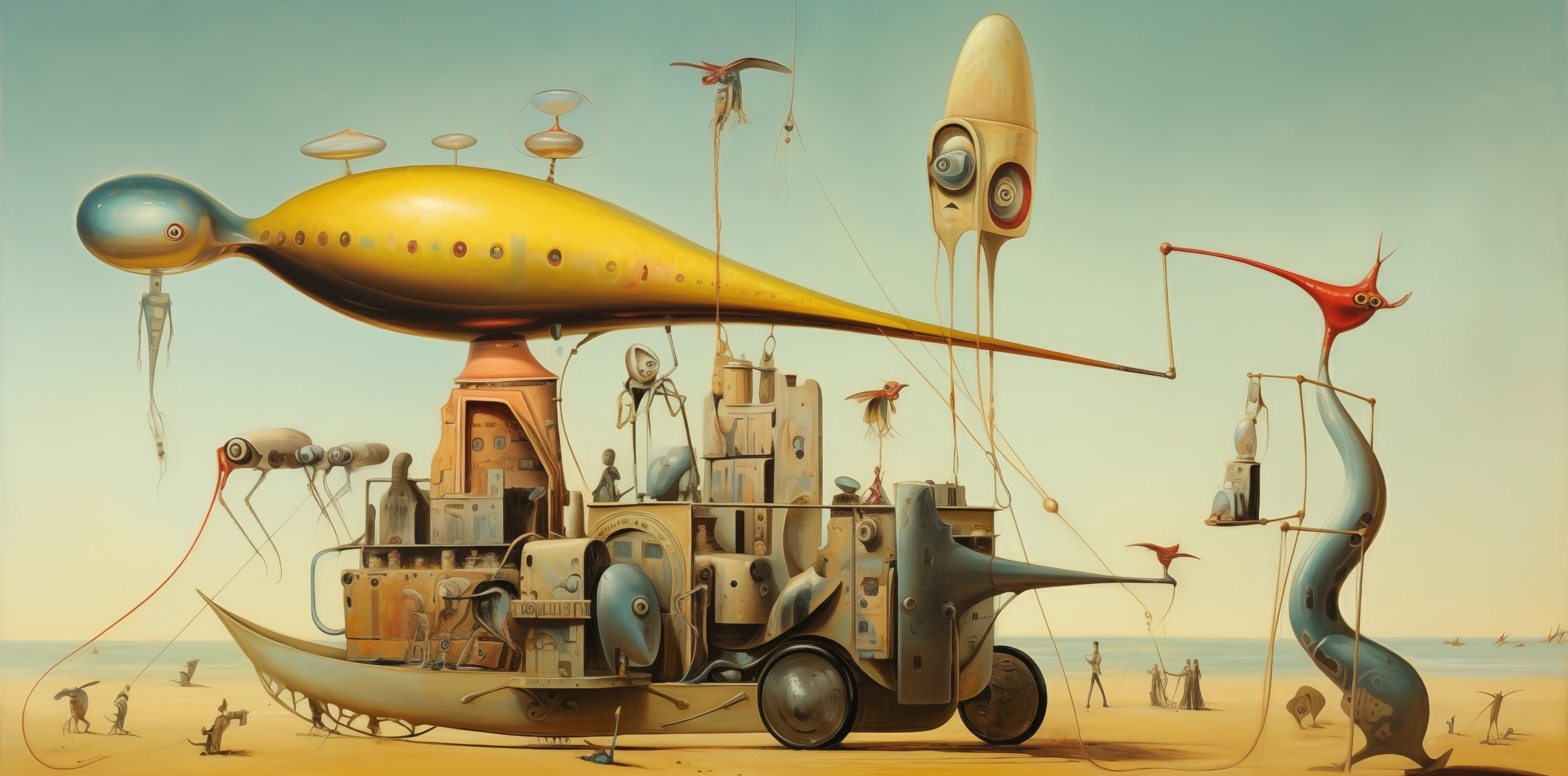
The Voyage of the Fantastical
Upon the golden sands of imagination, a vessel of wonderment sets sail. This is no ordinary craft, but a floating city of ideas, propelled by the winds of curiosity and the tides of invention.
The Captain, a figure of stoic resolve, surveys the horizon with eyes that have seen worlds merge and boundaries blur. The crew, an assembly of beings drawn from the far reaches of possibility, work in harmony, each fulfilling a role in this odyssey of the mind.
Above them, a leviathan of the skies, buoyant and watchful, casts a protective gaze over the journey. Its form speaks of the majesty of thought, the boundless realms of the 'what if', where the only anchor is the imagination.
Amidst the deck, the inhabitants of this floating utopia engage in tasks both mundane and mystical, their actions a dance to the rhythm of creation. They are the architects of dreams, the smiths of innovation, forging the future with every turn of the wheel.
The creatures that populate this scene—curious, bizarre, yet oddly familiar—serve as a reminder that in the realm of the mind, there is room for all forms, all ideas, all stories. They are the emissaries of the fantastical, the denizens of a place where the horizon is limitless and the sea is a canvas for the voyage of thought.
This is a voyage that invites us not to a destination, but to a journey—a journey that celebrates the marvels of the mind and the adventures that await when we dare to dream.

The Assembly of the Inquisitors
In a chamber shrouded in the echoes of profound contemplation, the Assembly of the Inquisitors is in session. This is a place of deep thought and deeper questioning, where the pursuit of knowledge is a sacred rite.
The Inquisitors, enshrouded in robes of solemnity, their faces obscured by helmets that channel the senses to a finer edge, are devoted acolytes of inquiry. They sit before a tome of untold mysteries, each page a universe awaiting decipherment.
At the center of their study, an orb illuminates a specimen—an entity that defies the common laws of nature, its form both alien and familiar. It is both the subject and the teacher, an envoy from the realms of the unknown.
Above, a lone observer watches, its gaze piercing through the veil of understanding that separates the known from the unknowable. It is a silent custodian of the knowledge that unfolds within the sphere of revelation.
The instruments that surround them are the tools of exploration—mechanisms of thought made manifest, designed to unlock the secrets that lie at the heart of all things. The Inquisitors seek not just to observe, but to comprehend, to connect the threads of the cosmic tapestry in the loom of their intellect.
This Assembly is more than a gathering; it is a symbol of the human condition—the unending quest for understanding in a universe that is a puzzle with an infinity of pieces.
In the hush that fills the chamber, a question lingers, unspoken yet resonant: What truths will be revealed when we dare to look beyond the surface and into the essence of existence itself?

The Ensemble of Curiosities
In an atelier where the ordinary is banished, an ensemble of curiosities convenes. This gathering is not of flesh and blood, but of beings born from the very essence of wonder and creativity.
The members, each distinct in their otherworldly demeanor, are musicians of the mind's orchestra, playing instruments not of strings or wind, but of ideas and imagination. Their concert is one of discovery, a harmonious exploration of the bounds of thought.
Among them, creatures that defy the mundane reality float and flutter, suspended in the air like notes in a musical score. They are both audience and inspiration, their forms a melody composed by the wild symphony of the subconscious.
The instruments they wield do not sound in tones heard by the ear, but in revelations felt by the soul. With every pluck, stroke, and bow, they weave a tapestry of tales untold, a narrative that unfolds in the space between dreams and waking.
This ensemble plays a sonata of the surreal, each movement a passage through the uncharted territories of the imagination. It is a reminder that within the concert hall of our minds, there is an infinite stage for the play of the fantastic.
In the silence that follows their performance, a whisper lingers—a call to embrace the beauty of the peculiar, the symphony of the strange, and the chorus of the extraordinary that resides within us all.
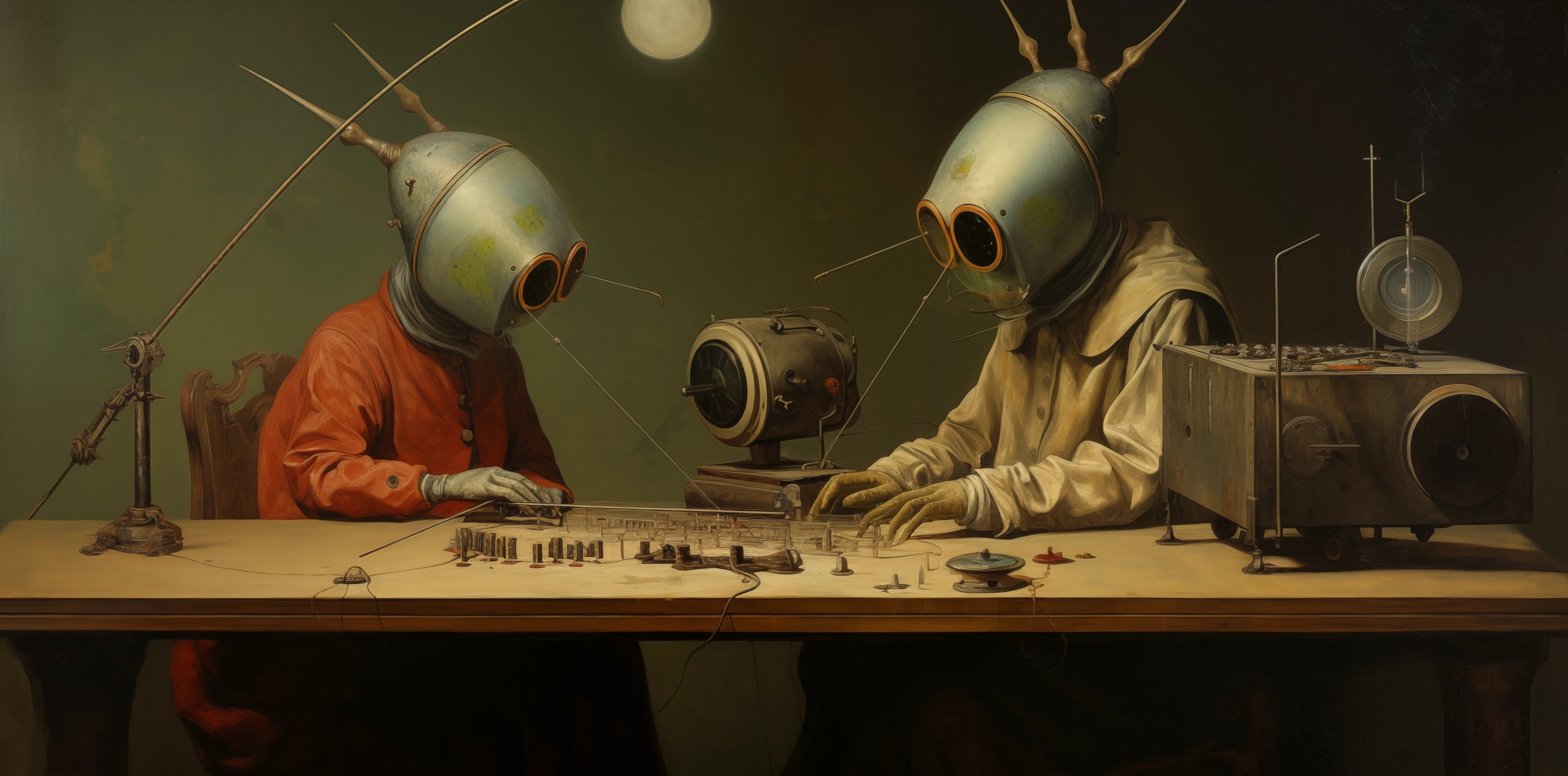
The Communicators
In the quietude of a room where time seems to stand still, two figures, The Communicators, are immersed in a dialogue that transcends words. Shrouded in garments of another era, their helmets are not barriers but bridges, facilitating a connection that defies conventional understanding.
Before them rests the console of communication, an intricate array of devices and dials, each component a vital part of the intricate dance of transmission. Their hands, poised and precise, navigate the landscape of switches and signals, orchestrating a symphony of silent exchange.
The room, bathed in a soft glow, is a sanctuary for thought, a haven for the exchange of ideas. Here, the air is thick with the electricity of discovery, the walls lined with the residue of countless conversations that have danced through the ether.
The Communicators, engaged in their silent colloquy, remind us of the invisible threads that connect us all, the unseen frequencies that carry our thoughts and dreams across the void. They are the custodians of connection, the silent sentinels who watch over the airwaves of human interaction.
In their presence, we are invited to listen—not with our ears, but with our minds, to the vast dialogue that surrounds us, a conversation that is as old as humanity itself, echoing into the expanse of our shared existence.
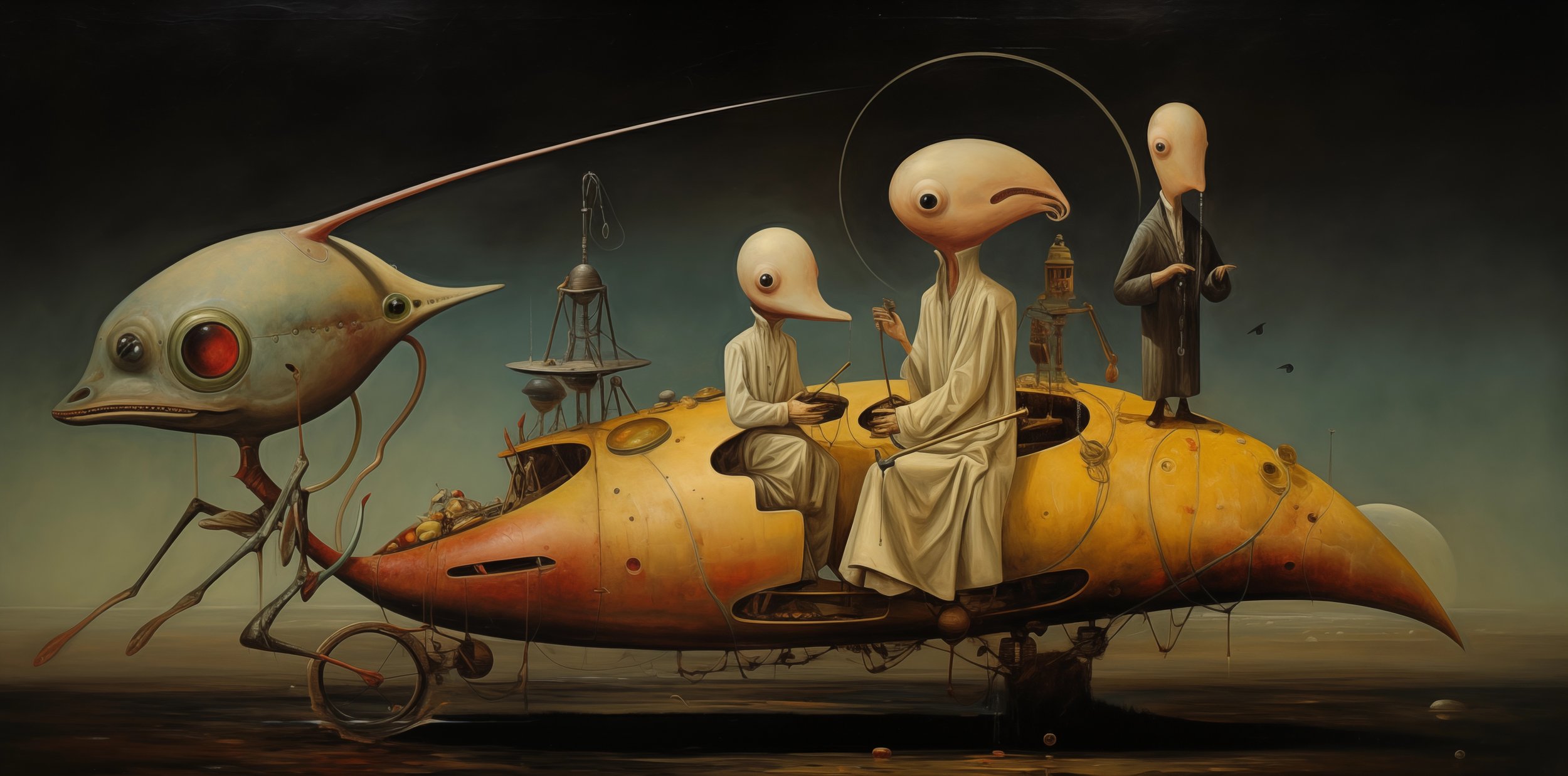
The Navigators of the Nebulous
Adrift on the sea of the surreal, the Navigators of the Nebulous chart their course. Their vessel, a marvel of the imagination, is as strange as the crew that mans it—a conglomeration of technology and organic whimsy.
The crew, with their elongated features and pensive expressions, are the custodians of this journey, each one a sage in their own right. In their hands, simple instruments become tools of navigation, measuring not distance or depth, but the contours of dreams and the density of fantasies.
The Navigator in the foreground, with an instrument of foresight, scans the horizon for the next chapter of their voyage. His companions, equally absorbed in their tasks, are artisans of adventure, each movement a brushstroke on the canvas of exploration.
The creatures that accompany them, each a testament to the boundless creativity of the universe, serve as companions and guides. They are the living embodiments of the Navigators' quest—a search not for new lands, but for new perspectives.
Together, they sail across the nebulous waters of the unknown, their course set by the stars of thought and the winds of curiosity. Their odyssey is a testament to the power of the mind to transcend the limitations of the physical world, to journey into the vastness of the unfathomable.
In the quiet that envelops their passage, a profound truth whispers to those who will hear: the greatest voyages are those that take us not over oceans, but into the uncharted waters of our own imaginations.
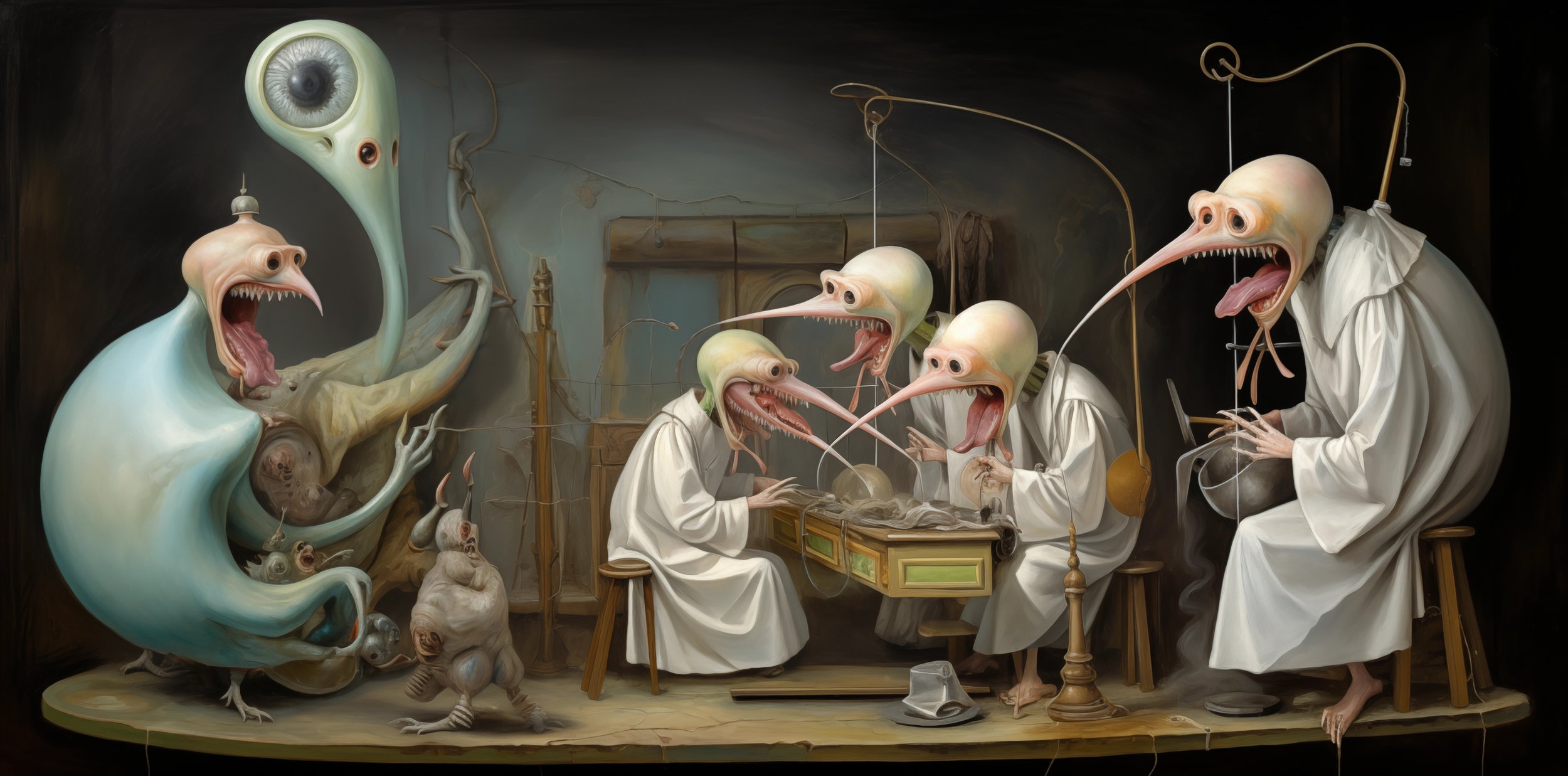
The Symposium of the Unfathomed
Within the confines of a chamber where the world's logic holds no sway, the Symposium of the Unfathomed is convened. Here, scholars of the strange, adorned in the garb of the esoteric, delve into the mysteries that lie beyond the veil of the ordinary.
The central figure, an entity whose very form speaks of realms untold, serves as both subject and sage, its body a living repository of enigmas. Around it, the participants engage in a discourse that defies the tongue, a communication that transcends the barriers of species and space.
Their tools are as peculiar as their subjects, instruments designed not to measure or cut, but to reveal and understand. The scholars' fervor is palpable, their curiosity as much a part of the room as the air they breathe.
This symposium is a testament to the mind's capacity to imagine, to reach out into the darkness of the unknown and draw forth knowledge as yet unconceived. It is an homage to the pursuit of understanding, a celebration of the unquenchable human desire to know the unknowable.
In the stillness that permeates their gathering, a whisper to the wise: within the depths of the unfathomed, there lies the potential for boundless discovery, should we dare to seek it.
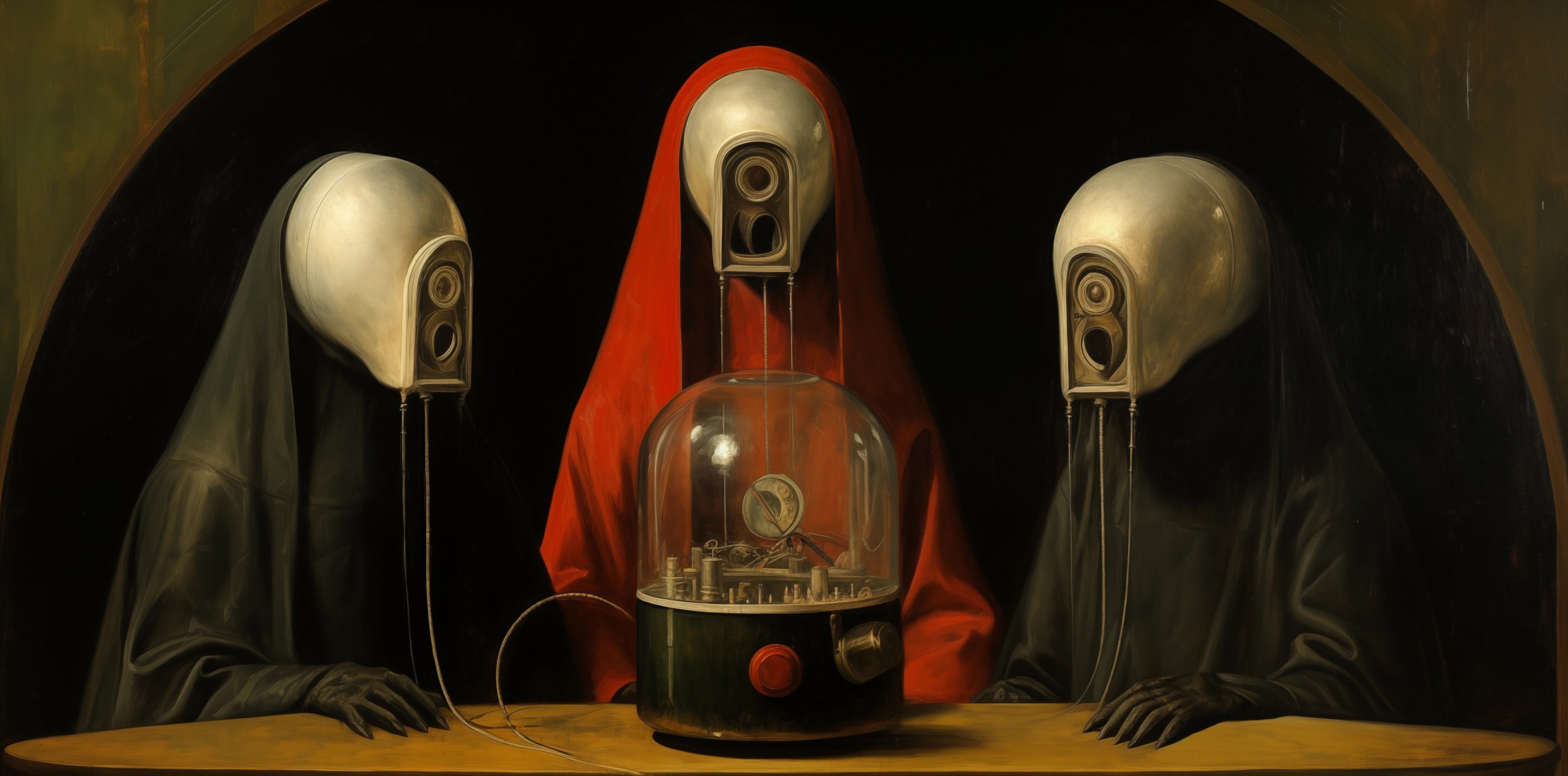
The Tribunal of the Arcane
Seated within a chamber where shadows whisper ancient secrets, the Tribunal of the Arcane presides. Here, three figures, enigmatic and cloaked in the gravitas of their purpose, commune with forces that weave the fabric of reality.
The central figure, draped in crimson, is the fulcrum of this conclave, a mediator between the realms of the known and the mysteries that dance just beyond perception. The device before them, a vessel of enigmatic purpose, glows with an inner light, a beacon in the dialogue of esoterica.
Their helmets, ornate and otherworldly, serve not as armor but as conduits to the ether, their antennae tuned to frequencies that the uninitiated cannot fathom. They are not just observers, but active participants in the silent conversation that unfolds in the space between moments.
The Tribunal delves into matters not of law or governance, but of the underpinnings of existence itself. Their verdicts are not decrees but revelations, each decision a thread pulled from the unseen tapestry that is the universe.
In their presence, time seems malleable, space a mere suggestion. This is a gathering that transcends the mundane, a testament to the power of the arcane to captivate and command.
In the quietude that envelops their assembly, a profound recognition takes hold: within the arcane lies the potential to unlock the mysteries of the cosmos, should we dare to listen to the whispers of the shadows.

The Observers of the Aquatic Microcosm
In a space where science and surrealism intertwine, the Observers of the Aquatic Microcosm are at work. Shrouded in protective gear that speaks of both necessity and ceremony, they study the dance of life within a self-contained universe, a globe of water and wonder.
The giant fish, their colors vibrant against the glassy enclosure, are not merely specimens but participants in an unspoken dialogue with their human counterparts. The Observers, with their intricate apparatus and focused gaze, seek to unravel the silent stories that ripple through the miniature sea before them.
This tableau is a meditation on the act of observation itself—a reminder that to observe is to connect, to understand is to empathize. Here, the boundary between observer and observed blurs, and a shared existence begins to emerge from the silent communion.
The scene is a symphony of curiosity and coexistence, a visual sonnet to the intricate web of life that spans the breadth and depth of all waters, from the tiniest droplet to the vastest ocean.
In the tranquil air that surrounds the Observers, a quiet realization unfolds: within every microcosm, there lies a universe of beauty and complexity, waiting for eyes that seek to see not just the surface, but the soul within.
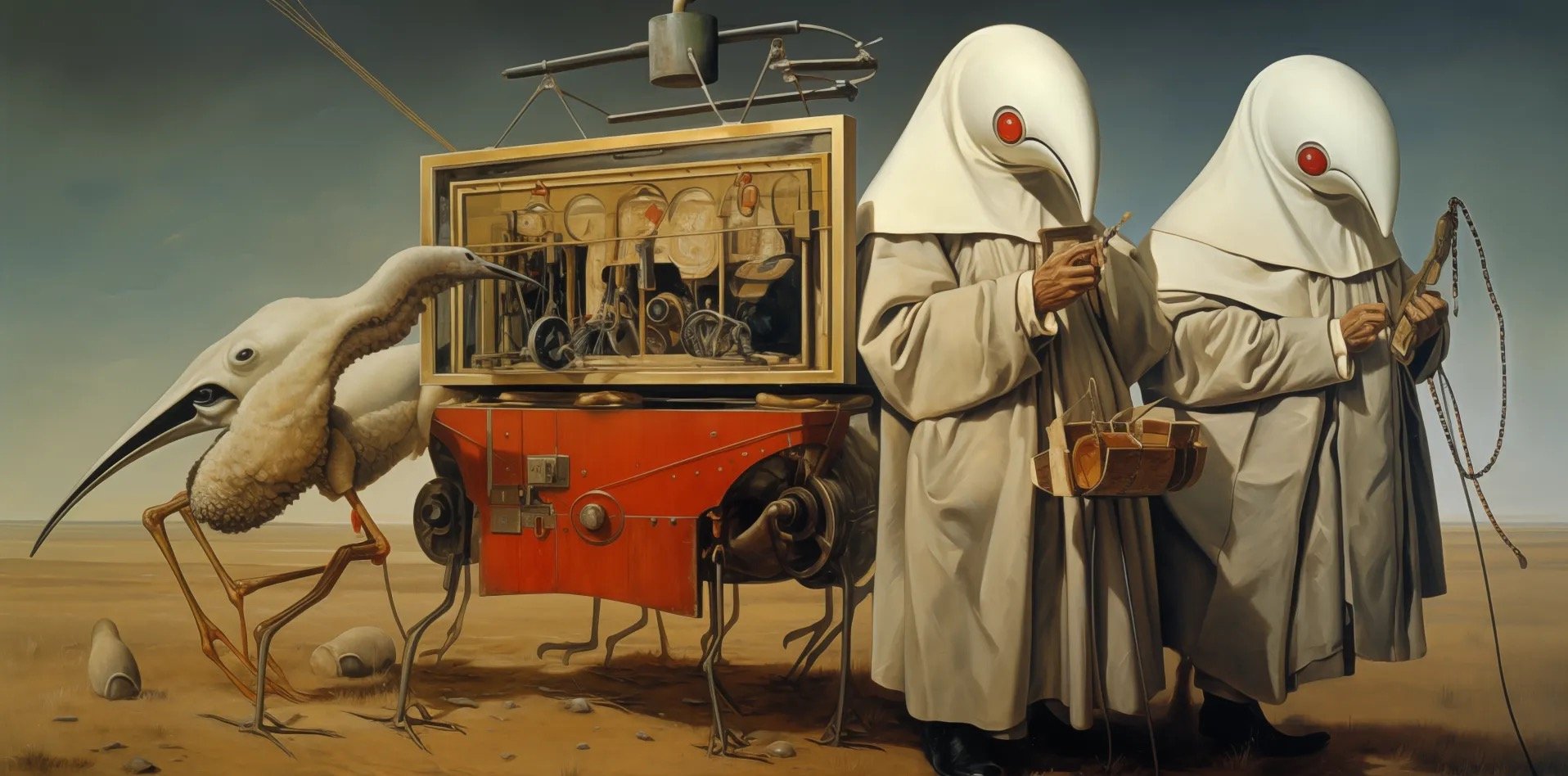
The Pilgrims of the Mechanical Bird
In a realm where the expanse of the desert meets the boundary of the imagination, the Pilgrims of the Mechanical Bird trek across the sands. Clad in robes that speak of a sacred mission, their presence is as enigmatic as the landscape they traverse.
At their side, a creature of clockwork and dreams, a mechanical bird of immense scale, bears the weight of their journey. It is a testament to the ingenuity of its creators, a fusion of the organic and the engineered, a symbiosis of flesh and metal.
The pilgrims, their eyes hidden behind masks of solemnity, carry instruments of navigation and faith, tools that guide their steps not just through the physical wasteland but through the metaphysical realms they seek to chart.
Their journey is one of both penance and discovery, a quest that is as much about the inner voyage as it is the outer. The machines they carry are not merely physical burdens but spiritual companions, each cog and wheel an integral part of their pilgrimage.
In their silent procession, they embody the search for meaning in a world of relentless change, a meditation on the convergence of technology and spirit, and the endless quest for harmony between the two.
In the stillness that follows their passage, a question hangs in the air, as timeless as the desert itself: What truths await at the end of a journey that is willing to traverse both the sands of the earth and the landscapes of the soul?
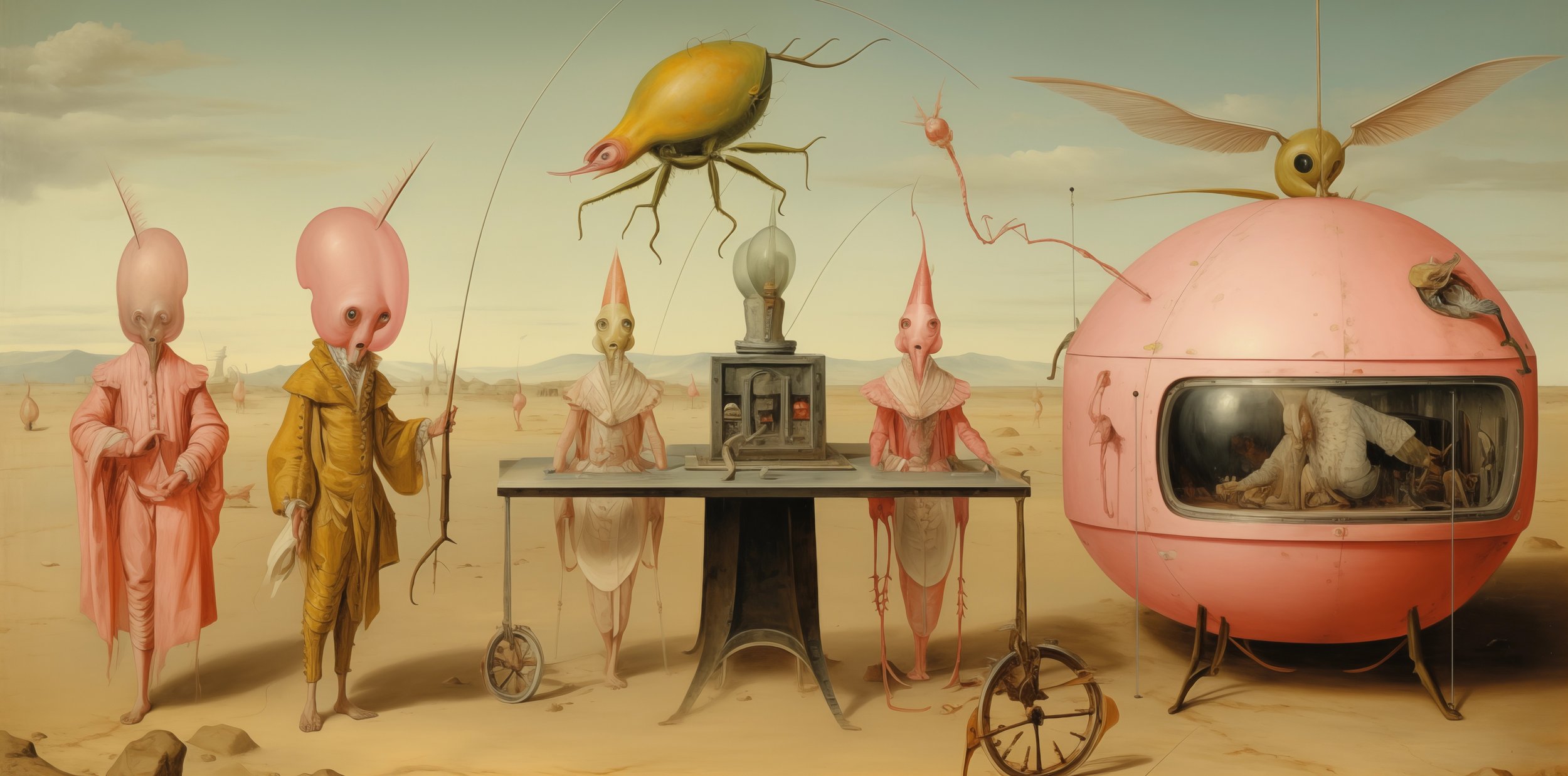
The Desert Symposium
Upon the canvas of an arid desert, a symposium unfolds, a congress of the unconventional convened under an indifferent sky. The attendees, garbed in robes of pastel hues, their heads bulbous and antenna-tipped, stand in a circle of intellectual pursuit.
At the heart of their gathering, a table bears the weight of an enigmatic device, its purpose as cryptic as the expressions of its guardians. This assemblage of cogs and valves, glass and metal, is the pivot around which the minds of these scholars orbit.
A creature, resembling the fantastical tales of old seafarers, hovers above, its tentacles manipulating the ethereal strings that connect this reality to another. Meanwhile, a spherical entity, winged and observant, perches atop a capsule, its interior a nest for the bizarre.
This scene, a confluence of the outlandish and the scholarly, is a testament to the endless quest for knowledge that transcends the boundaries of worlds. It is an acknowledgment that wisdom and wonder are not solely the province of the familiar.
In the quietude of the desert, the symposium speaks: within the vast deserts of our ignorance, there are oases of enlightenment, waiting for those who dare to explore and to question.
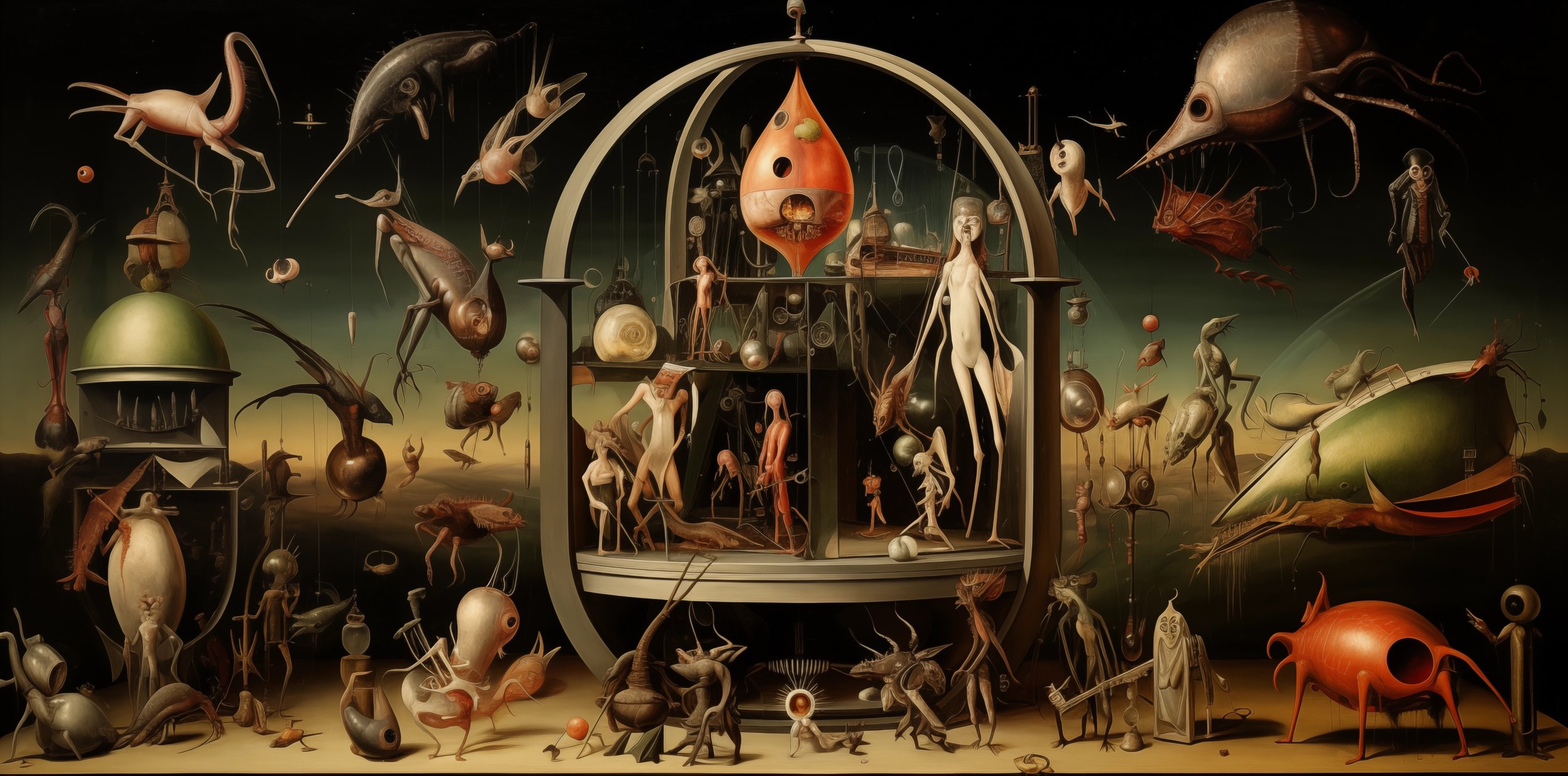
The Menagerie of the Cosmos
In an expanse that bridges the chasm between reality and fantasy, a grand menagerie unfurls beneath a twilight canopy. This cosmic zoo, teeming with creatures of every conceivable and inconceivable form, circles around a central diorama of life in its myriad manifestations.
Within this circular shrine, beings that defy the taxonomy of nature as we understand it are enshrined in displays, each telling a silent story of evolutionary wonders. These beings, locked in a perpetual dance of existence, are suspended in time, watched over by the sentient and the inert alike.
The creatures that populate this sphere range from the minuscule to the magnificent, each a fragment of the universe's endless imagination. From the terrestrial to the celestial, every form is a note in the grand symphony of creation.
This gathering is more than a mere exhibition; it is a mirror reflecting the endless possibilities of life itself. It challenges the onlooker to expand their understanding of existence, to embrace the diversity that the cosmos harbors within its depths.
In the contemplation of this menagerie, a profound realization dawns: within the vastness of the cosmos, the line between the real and the surreal is but a delicate stroke of the universal brush.
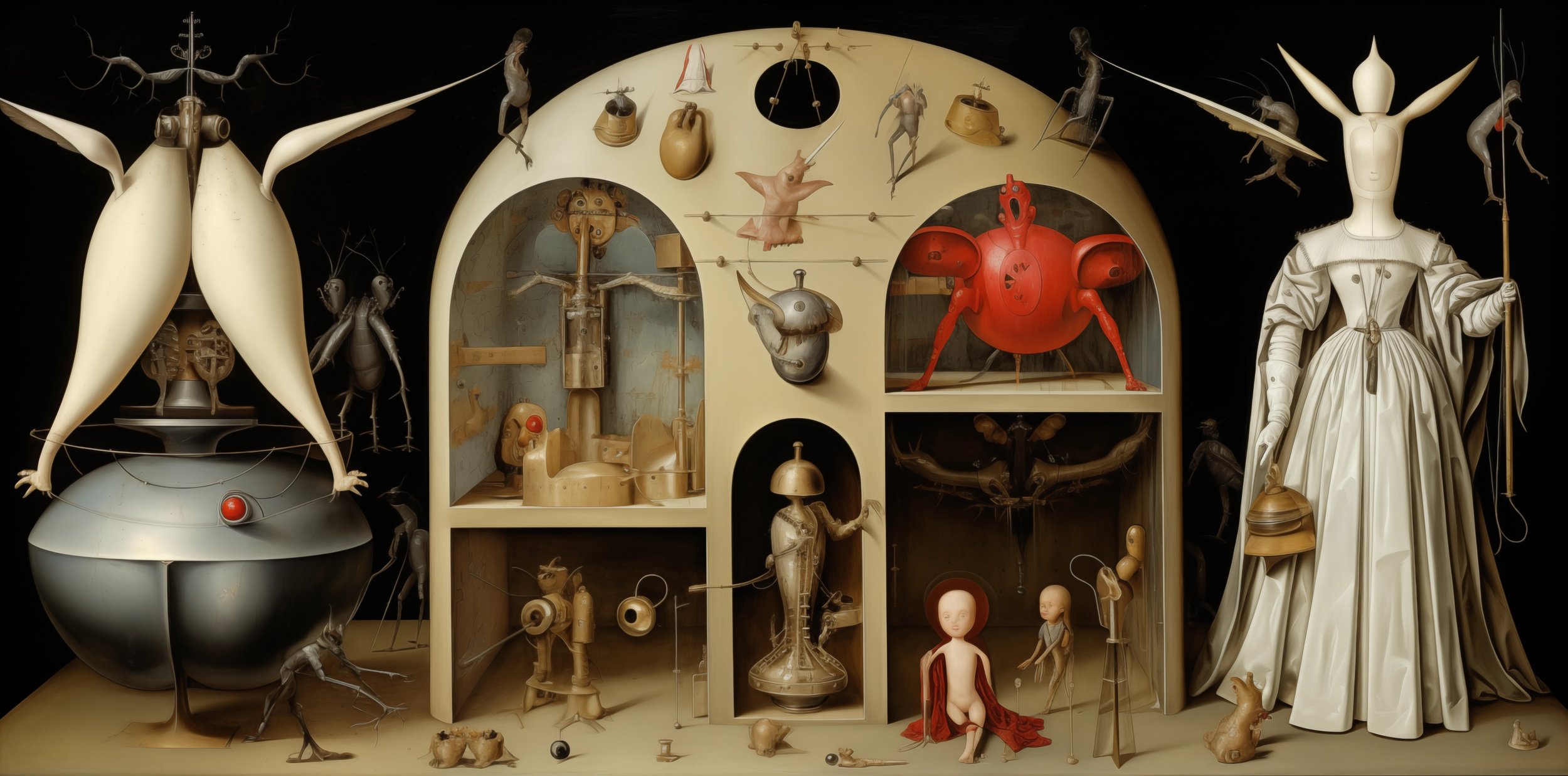
The Archivists of Infinity
A tableau of the arcane and the profound stands before us, an assembly of the archivists of infinity. These are the sentinels of secrets, the keepers of the knowledge that stretches beyond the comprehension of the finite.
Each figure, an embodiment of the different facets of existence, wears its purpose with silent dignity. The central figure, draped in the hues of innocence, holds a staff that pierces the very fabric of the cosmos, channeling the wisdom of the ages.
Surrounding this sovereign of secrets are the curators of cosmic curiosities, each ensconced in their own niche, a guardian of a particular universal truth. Their shelves and compartments teem with artifacts that are not merely objects but are instead keys to the deeper understandings of the universe.
The beings themselves are as enigmatic as the mysteries they guard, their forms alien yet familiar, inviting yet foreboding. They are the union of the mechanical and the organic, the scientific and the mystical, the known and the unknowable.
In this chamber of wonders, where every element is meticulously cataloged and displayed, we are mere visitors, transient souls granted a fleeting glimpse into the endless archives of existence. Here, in the silence of the infinite, the archivists continue their eternal task, compiling the anthology of everything that ever was, is, and will be.
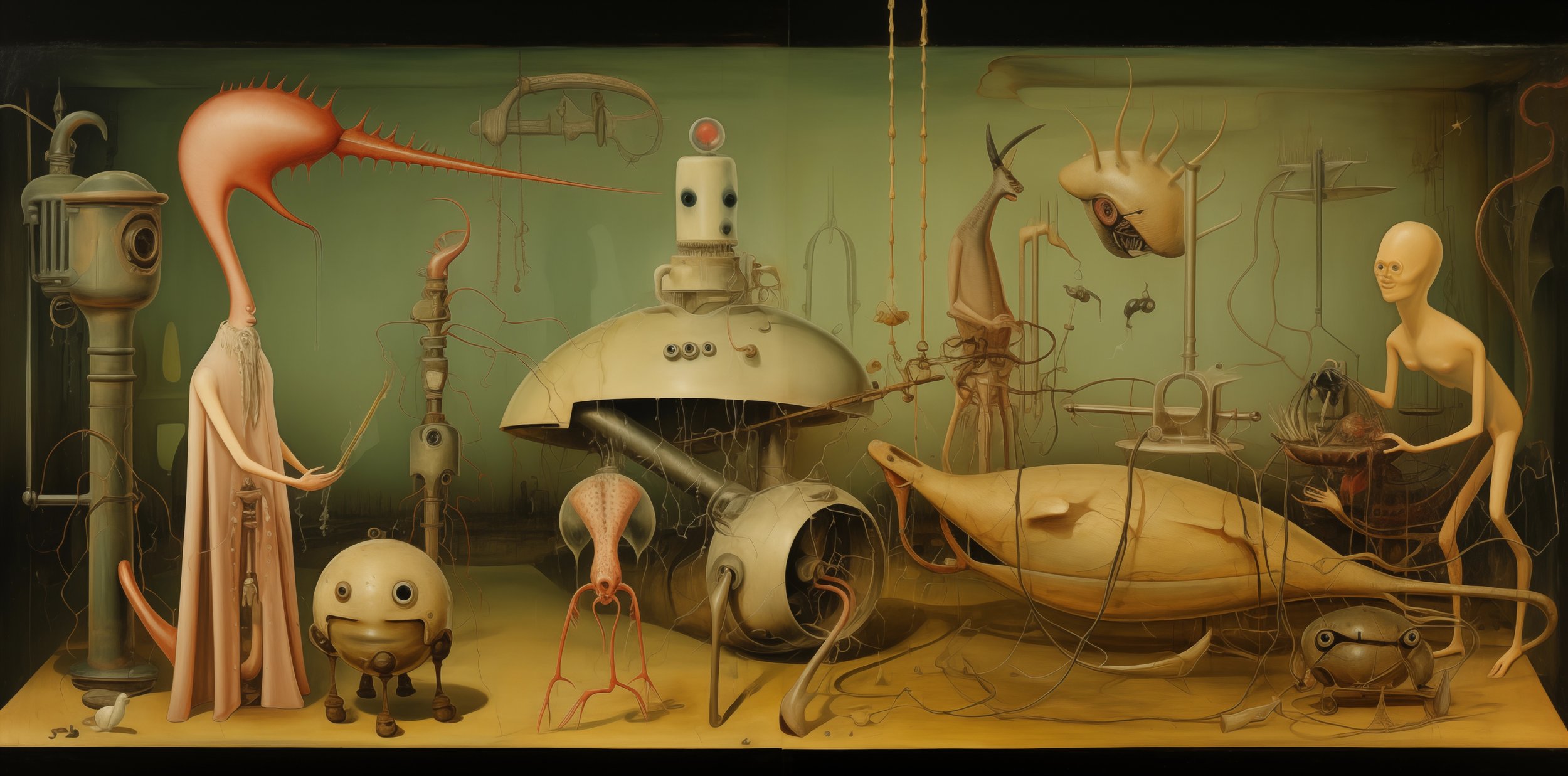
The Laboratory of Curiosities
In the heart of a realm where the peculiar reigns, lies a laboratory, a crucible of curiosities where the arcane dances with the empirical. Here, the alchemist of the abnormal orchestrates a symphony of the surreal.
Surrounded by a congress of constructs, each more bizarre than the last, the pale figure is a study in concentration. They tend to a creature of impossible anatomy, its limbs a tangle of organic improbability, as a mechanical comrade, equipped with curious eyes and a whimsical smile, observes the scene with a silent giggle etched upon its face.
Above them, the floating sentinels of this bizarre brigade, equipped with eyes that see beyond the spectrum, keep a vigilant watch. Their forms defy the natural order, suggesting a reality where the rules are written in the language of dreams.
This is a place where the laws of nature are mere suggestions, and the impossible is just another specimen to be studied. Here, the boundaries of science and fantasy blur, each discovery a doorway to a new enigma.
In this laboratory, the pursuit of knowledge is a journey with no destination, each experiment a step further into the wondrous abyss of imagination. Welcome to the sanctum of the strange, the haven of the unfathomable, where every day is an expedition into the extraordinary.
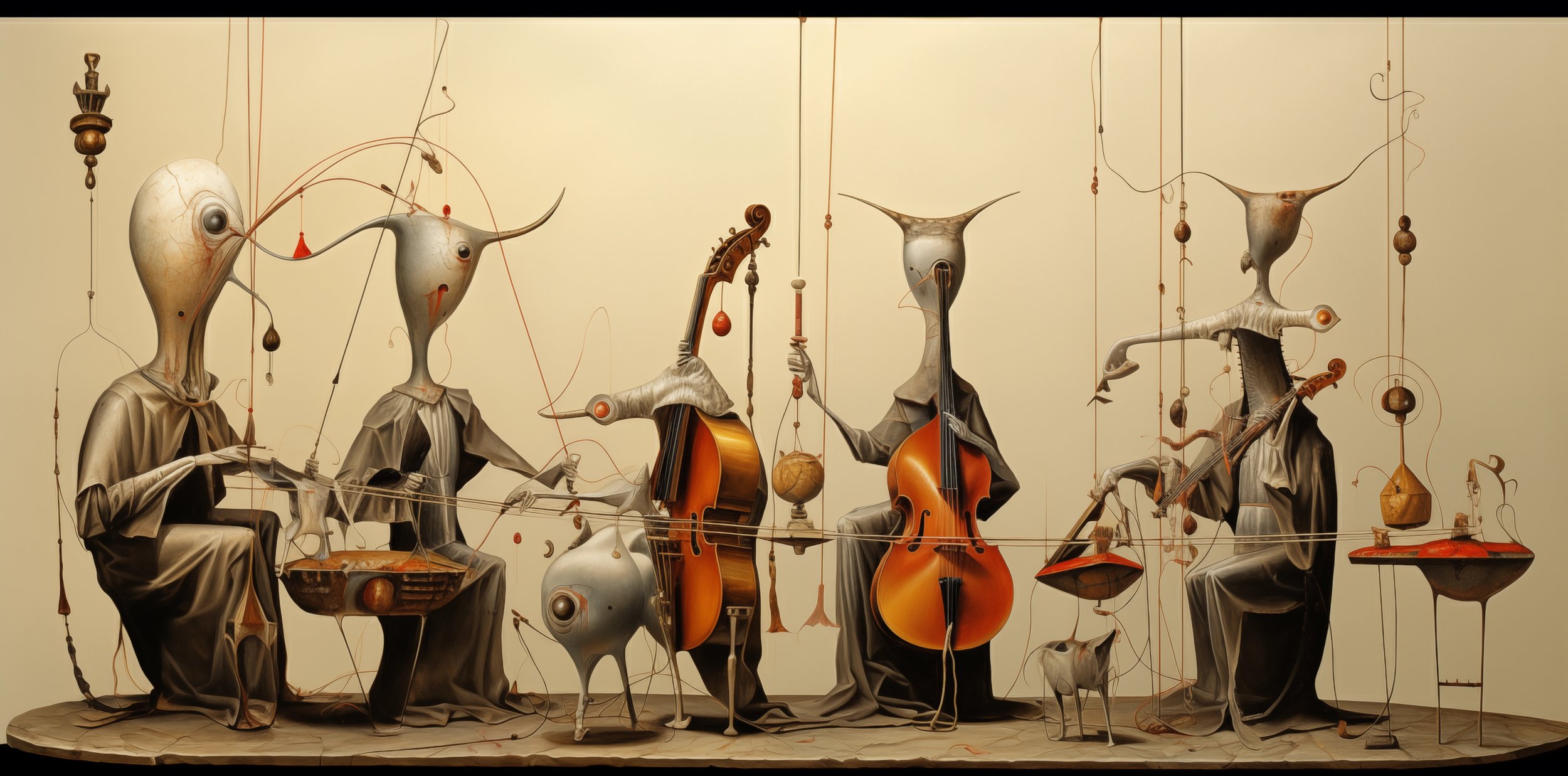
The Surreal Symphony
Upon a stage not of this earth, a quintet of otherworldly musicians cradles their instruments, poised to play a symphony that resonates with the music of the spheres. Their forms, both fluid and fantastical, speak of distant realms where the whimsical and the wondrous intertwine.
Each musician, a sculptural marvel, an ensemble of elegance and the esoteric. They draw bows across strings that sing with the voices of unseen dimensions, each note a thread in the tapestry of the cosmos. Their audience, unseen, may very well be the stars themselves, listening intently to the harmonies of the hyperreal.
In this concerto of the curious, the instruments, alive with their own peculiar presence, seem to be extensions of the players themselves—a symbiosis of the sentient and the sonorous. Around them, the mechanisms of melody drift in the air, suspended in moments of enchantment.
This is a performance that transcends time, a recital that reverberates through the echoes of eternity. Here, in this chamber of the surreal, music is not merely heard but felt, seen, and lived—a living entity that entwines the senses in a dance of the divine.
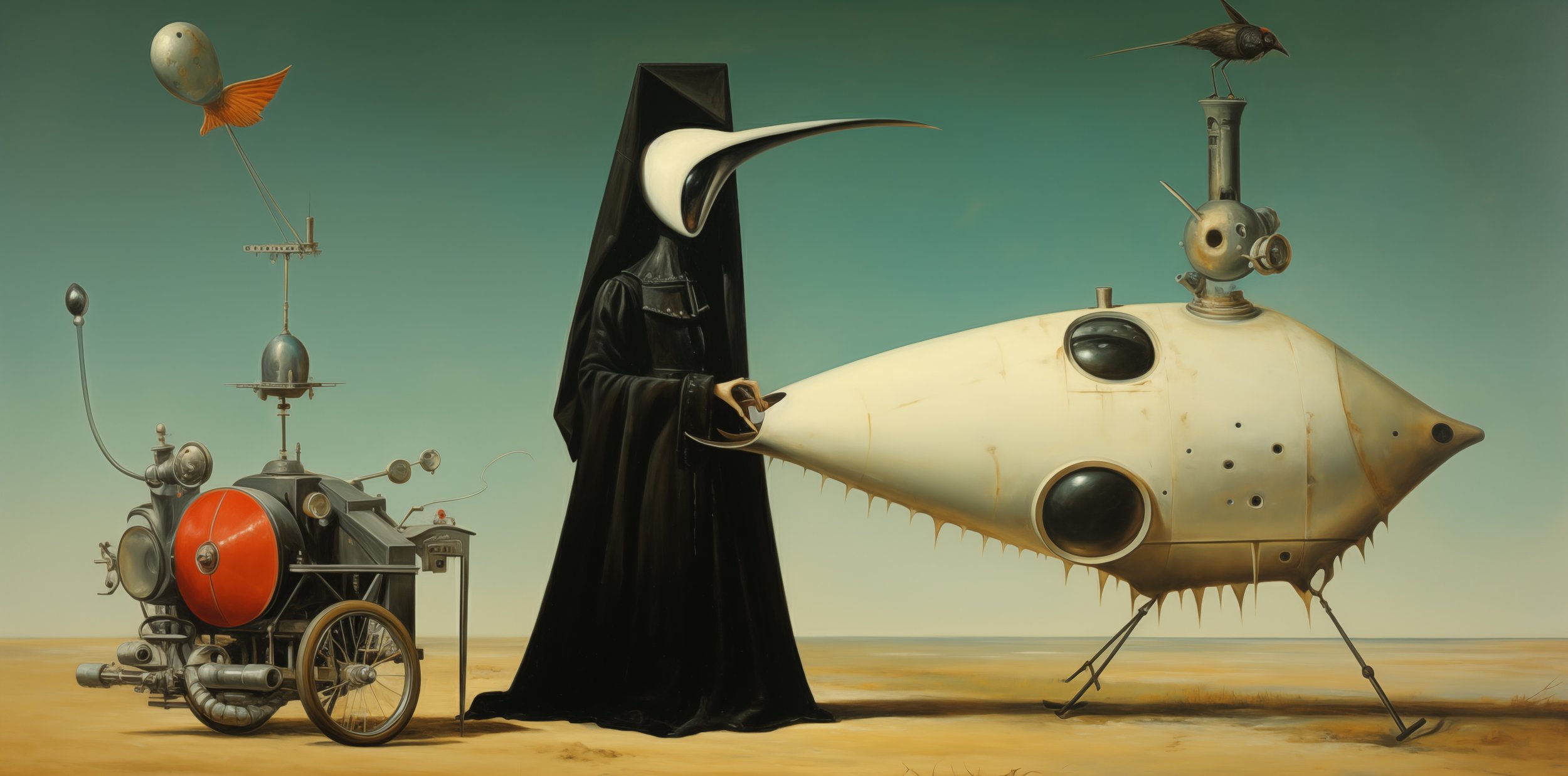
The Desert Pilgrimage
In a landscape where the sands whisper secrets of a time forgotten, a solitary pilgrim, shrouded in the garb of ancient tales, stands poised, a silent sentinel in the vast desert. The traveler's companion, a marvel of anachronistic machinery, looms beside — a vessel that defies the very principles of nature and science, crafted with an elegance befitting the most daring of dreamscapes.
Perched atop this vessel of exploration, a mechanical songbird, sentinel of the skies, surveys the horizon, its metallic plumage gleaming under the relentless sun. The craft, part beast, part engine, part enigma, is a symphony of the surreal, each curve and cog a testament to the ingenuity of worlds unknown.
The air is still, yet the scene is alive with a sense of anticipation, as if at any moment the desert might erupt with the symphonies of hidden realms, and the traveler and their craft might set off towards the mirage-laden sunset, leaving behind nothing but the dance of dust devils in their wake.
This is a journey not measured in miles but in the boundless stretches of imagination, a voyage across the canvases of the mind, where every grain of sand holds the possibility of a new universe, every whispering wind a call to adventure beyond the edges of reality.
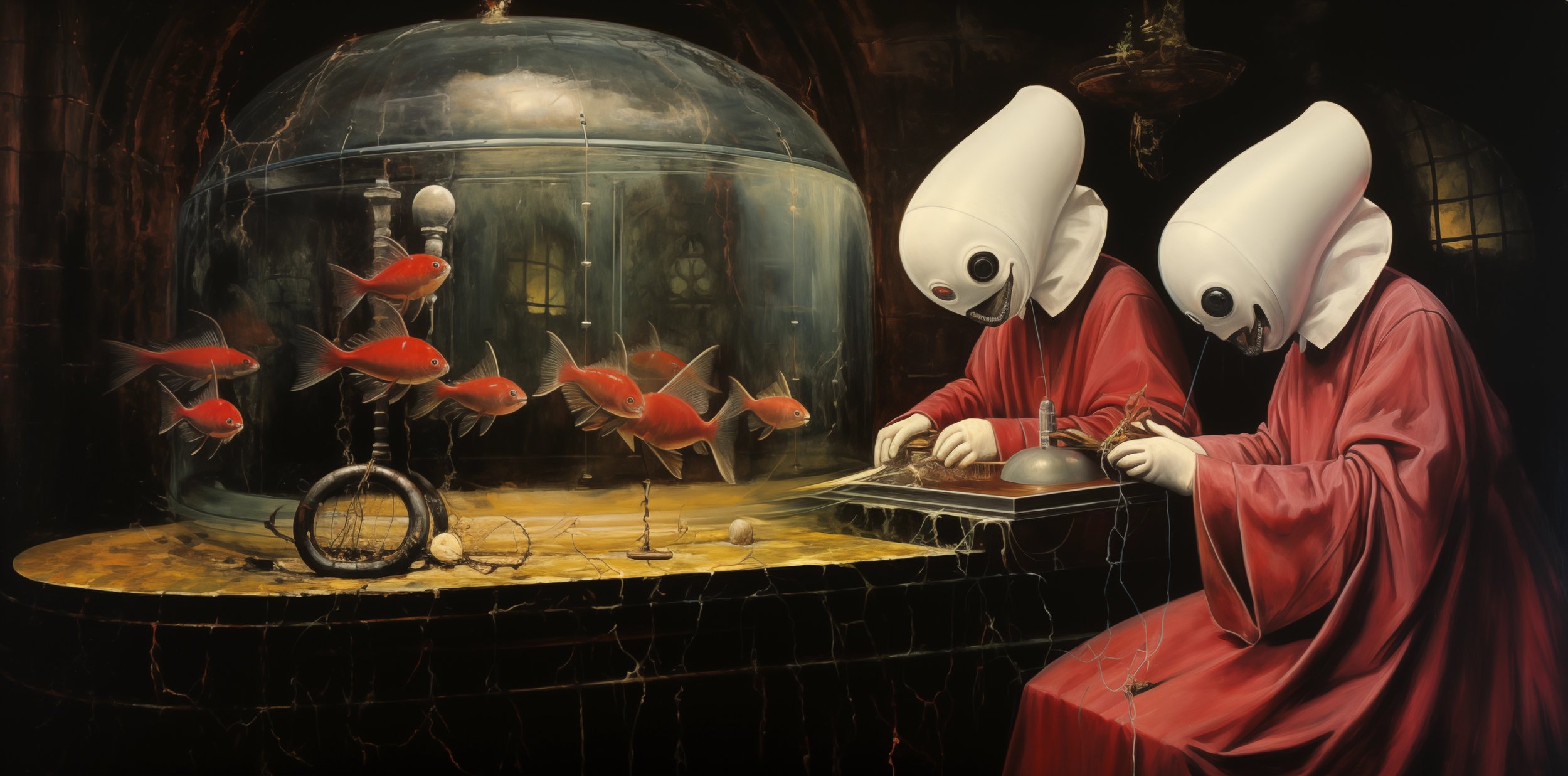
The Observers of the Aquatic Cosmos
Within the hushed confines of an ancient chamber, two observers, draped in crimson robes, engage in a silent communion with the aquatic cosmos. They are guardians of the mysterious, a large spherical tank where fish, resplendent in their fiery orange hues, dart and weave, masters of their liquid domain.
The tank, a microcosm of life, is suspended in time and space, a watery orb that reflects the curious minds that peer into its depths. It stands as a bastion of life, an echo of the world beyond its glass, where creatures great and small swim amidst the relics of a time that once was.
The observers, their faces hidden behind masks that betray no emotion, conduct their rituals with a precision born of centuries. They are the chroniclers of this submerged dance, the keepers of secrets that the swirling waters whisper to those who know how to listen.
As they work, the crackled walls of the chamber, steeped in history and mystery, watch over them. There is a sense of something greater at play, a story unfolding within each bubble that rises and each current that flows. This scene is a tableau of introspection and discovery, where every movement is a note in an aquatic symphony, and every silence speaks of worlds waiting to be known.
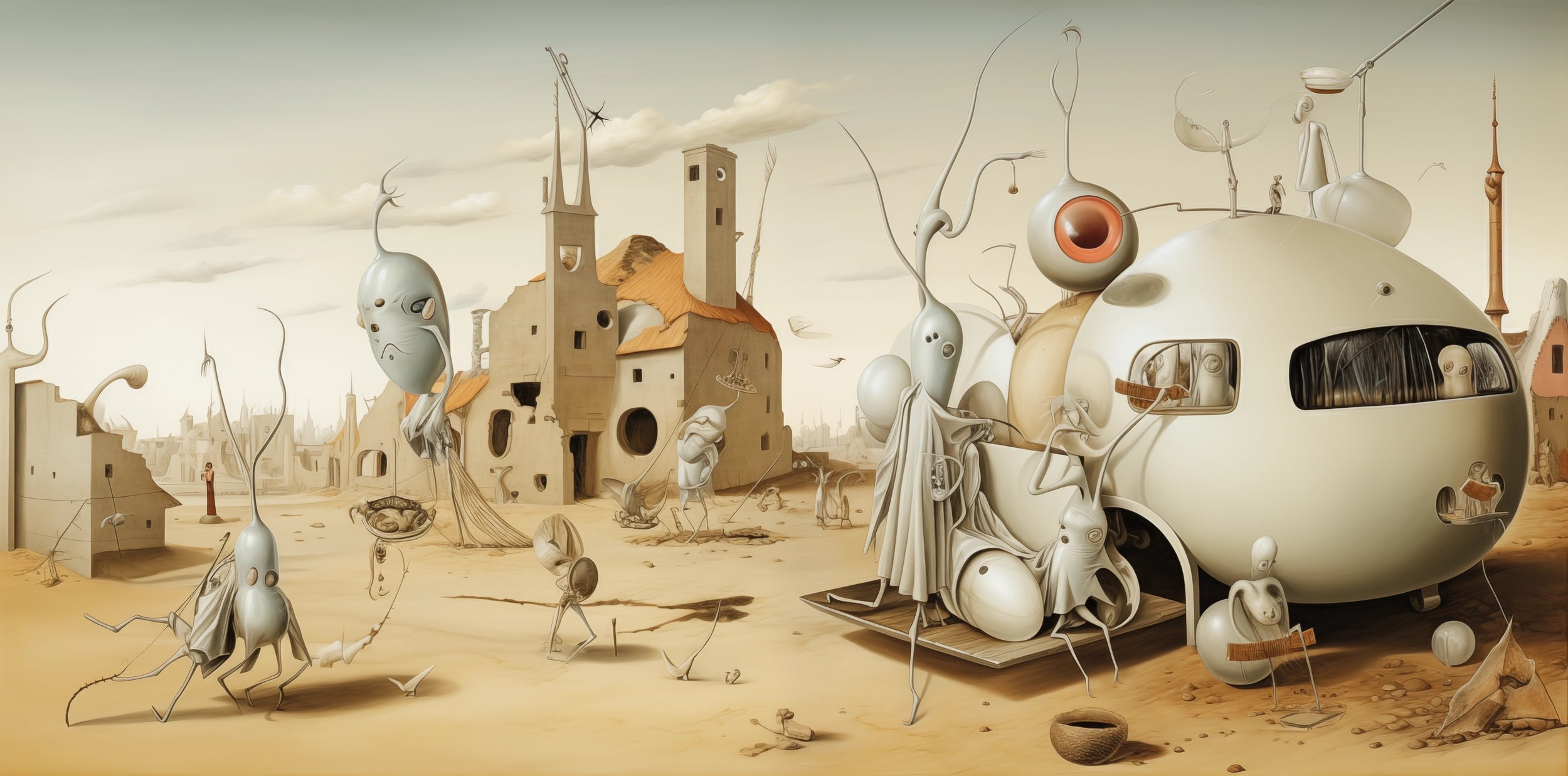
The Surreal Caravan
In the warm embrace of a distant desert, under a sky both vast and unfathomable, lies a scene of whimsical peculiarity—a surreal caravan traversing the sands of imagination. Beings of a different order, whose forms defy the constraints of earthly origins, convene in harmonious absurdity.
At the heart of this caravan, a spherical vehicle, gleaming like a pearl against the barren landscape, cradles the oddities of life within its metal womb. Creatures with elongated limbs and eyes that hold the depth of the universe peer out, observing the world with a detached curiosity.
Around this central oddity, a parade of fantastical entities engages in cryptic activities: some suspended in animation, others in a flurry of inexplicable purpose. Each figure is an enigma, wrapped in the cloth of dream-logic, their tasks as unfathomable as their existence is fascinating.
The backdrop to this gathering is a town as enigmatic as its visitors—buildings with architecture that whispers tales of civilizations unknown, and spires that reach out like fingers, trying to grasp the secrets of the cosmos.
This is a tableau where the rules of the known are bent and stretched, where the line between machine and being blurs, and where each moment is a brushstroke on the canvas of the extraordinary.
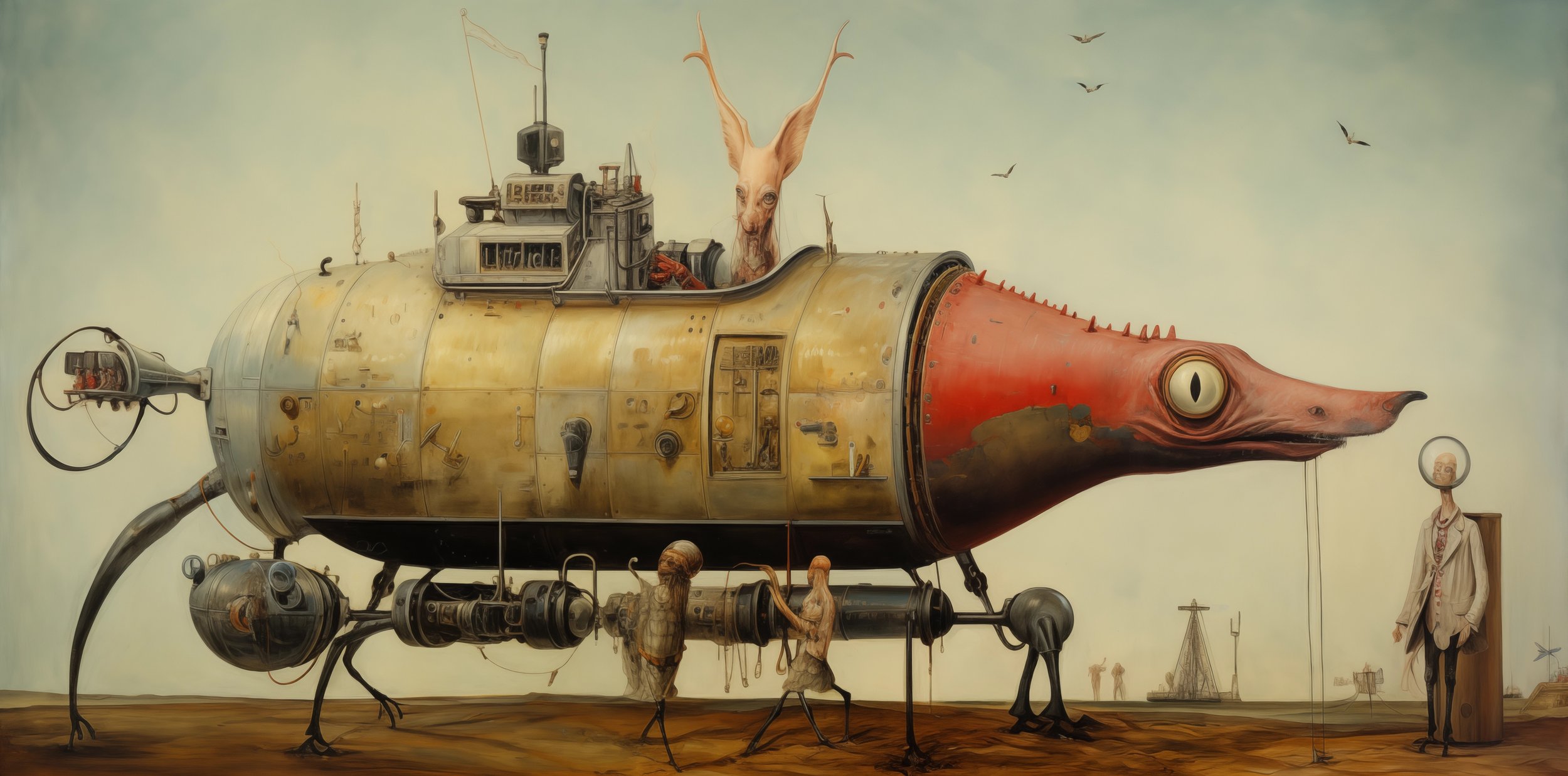
The Leviathan of the Dunes
Amidst a desolate landscape where the sky meets the endless sea of sand, a Leviathan of the Dunes emerges, an engineering marvel that defies the conventional. This gargantuan contraption, reminiscent of a submarine merged with a desert fish, roams the dunes with a purpose known only to its creators.
Atop its rusted hull, adorned with an array of enigmatic machinery and antennae, sits a creature with bat-like ears and solemn eyes, a sentinel gazing into the horizon. It's a figure of myth and legend, possibly the mind behind this wandering behemoth, or perhaps its vigilant guardian.
Before the Leviathan, a character in a flowing red cloak and a mask reminiscent of the plague doctors of yore holds a device, a tether to the mechanical giant, suggesting a symbiosis between man, machine, and the otherworldly. This figure appears as both conductor and supplicant to the great beast upon which they depend.
Supporting this mechanical monstrosity, a duo of wanderers, wrapped in bandages and garbs of survival, labor to power the kinetic limbs that propel their leviathan forward. They are the unsung heroes of this journey, their faces obscured, their stories untold.
In the distance, minimalist structures hint at a civilization accustomed to the whims of this surreal environment, their simple forms a stark contrast to the complexity of the machine that passes them by.
This scene is a silent symphony of past and future, organic and artificial, the real and the imagined. It is a testament to the boundless creativity of the human spirit, a narrative woven from the threads of fantasy and the loom of the surreal.
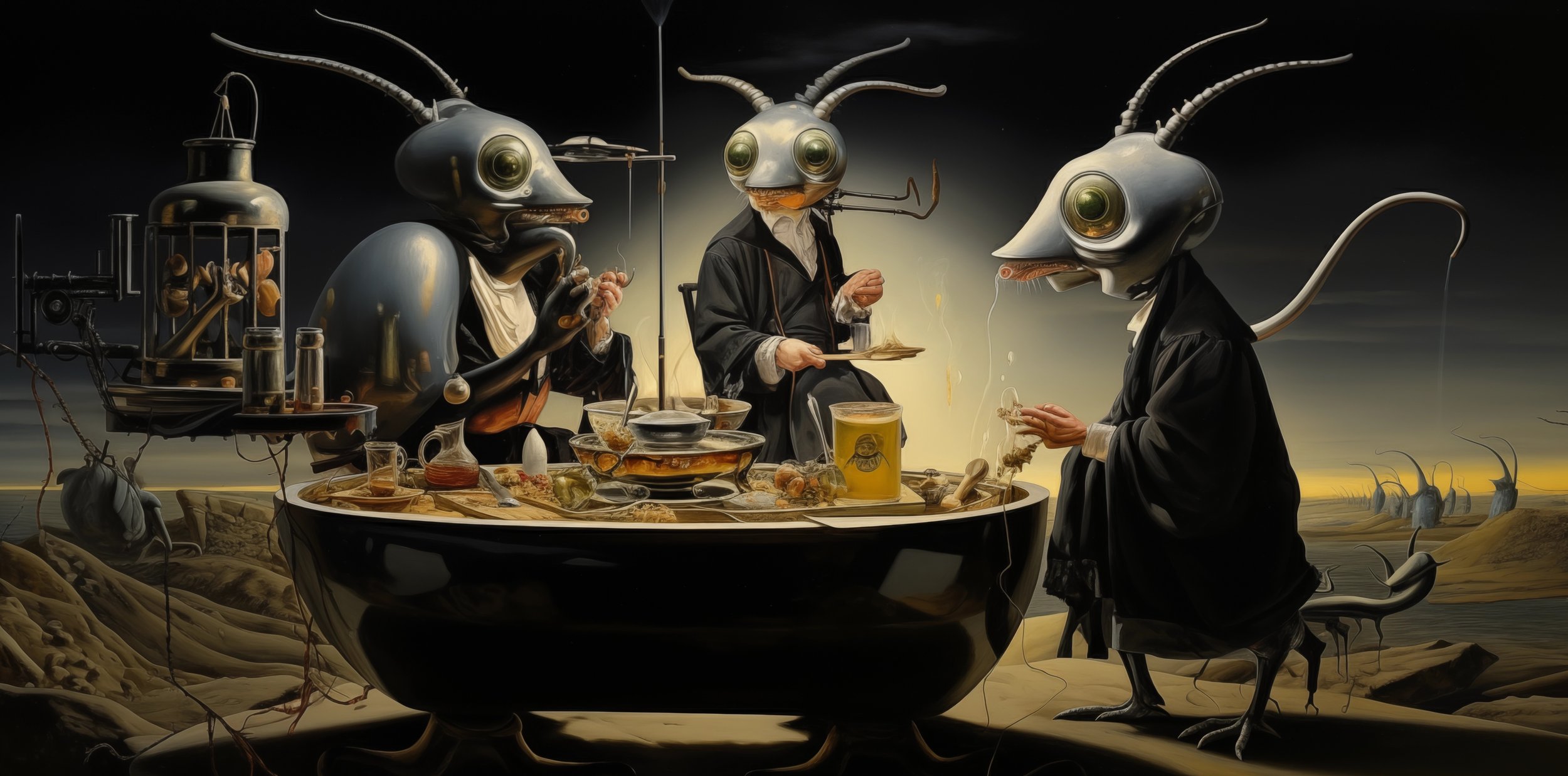
The Connoisseurs of the Surreal
In a twilight realm where the bizarre is commonplace and the laws of nature bend to the whims of imagination, we find a gathering of the connoisseurs of the surreal. These entities, anthropomorphic amalgamations of insect and humanoid, are engaged in a ritual as old as time and as strange as their forms: the tea ceremony.
At a table that is both an altar and a stage, they prepare their brew with ceremonial precision. Their elongated, insectoid heads, topped with spiraling antennae, tower over the scene, their compound eyes reflecting the multifaceted reality they inhabit. One stirs the pot, another grinds the ingredients, while a third, the one perhaps most in tune with the arcane arts, pours a stream of liquid that defies gravity, looping through the air back into the cup.
Around them, apparatuses of unknown function hiss and gurgle, distilling essences that are not of this world. Each instrument serves a purpose known only to these strange sommeliers, contributing to a concoction that might offer glimpses into other dimensions or simply the most exquisite of flavors.
The landscape beyond the window is a desert, but not one that any earthbound traveler would recognize. Structures resembling both organic life and mechanical contrivance dot the horizon, suggesting a civilization that thrives on the impossible, the absurd, and the magnificent.
This scene whispers of stories untold, of worlds unexplored, and of senses unimagined. It is a moment captured in time, a painting that invites the viewer to step through the frame and join the connoisseurs in their otherworldly repast.

The Alchemy of Sight
In the remnants of a world that once thrived on the vigor of its vision, there exists a peculiar tram. It courses through the dusty relics of a time that has forgotten the charm of clear skies and untainted horizons. Onboard, an assembly of beings, masked and cloaked in the enigma of their tasks, engage in a curious dance with objects of antiquity and technology. Each, in their steadfast focus, a testament to the singularity of purpose, yet together, they weave a tapestry of communal existence amidst desolation. The scene unfolds as a quiet narrative, raising questions about the essence of being and the pursuit of knowledge in a world where the collective memory has faded into the background of a canvas painted by time's indifferent brush.
Through the glass of the tram, the eyes of the observer are invited to delve into a tableau that speaks volumes of the fragmented reality that is humanity's inheritance. What truth lies behind the lenses that shield the soul from the world's abrasive winds? What wisdom can be gleaned from the remnants of a society that basked in the sun of its own creation, only to be eclipsed by the shadow of its hubris? The narrative beckons the reader to embark on an introspective journey, to search for the spark of enlightenment amidst the rust and rubble, and to ponder the paradox of progress that often leads to the precipice of obsolescence.
It is in this silent contemplation that the parable finds its voice, whispering of the cycles of creation and decay, of the intrinsic value of every cog and wheel in the machine of existence, and of the unyielding quest for understanding in a world that seems to defy comprehension. In the end, the realization dawns that the answers we seek are not found in the echoes of our questions but in the space between them, where the mind, unburdened by its own preconceptions, is free to soar on the wings of unbridled thought.

Whispers of the Gilded Street
As the dawn breaks over the Gilded Street, a procession of feline figures in cloaks and hoods captures the gaze of all. Their large, luminous eyes, reflecting the myriad secrets of a city whose spires and domes speak of a grandeur long past, hold stories untold. With them, creatures of bizarre countenance share the stage, a silent testament to the diversity of life's expressions. The juxtaposition of the ancient and the mystical against the backdrop of a cityscape that whispers of history's many layers invites the onlooker to question the fabric of reality itself.
In this realm, where the extraordinary becomes commonplace, the inhabitants navigate their existence with an air of quiet understanding, a communal acceptance of the peculiar tapestry that is their world. The parable here speaks not of oddities and anomalies but of the beauty inherent in difference and the strength found in unity. It poses questions to the reader: What is normalcy in a world where the extraordinary walks the streets? How does one find belonging in a place where the line between the ordinary and the surreal is blurred?
The essence of the parable lies in the reflection it offers, mirroring our own world's struggles with diversity and coexistence. It invites us to consider the richness that comes from embracing the unusual, the wisdom in acknowledging that what thrives in the shadows of our understanding may hold the keys to enlightenment. In the end, the reader is left to ponder the true nature of harmony—a concept not defined by conformity but by the symphonic blend of life's varied melodies.
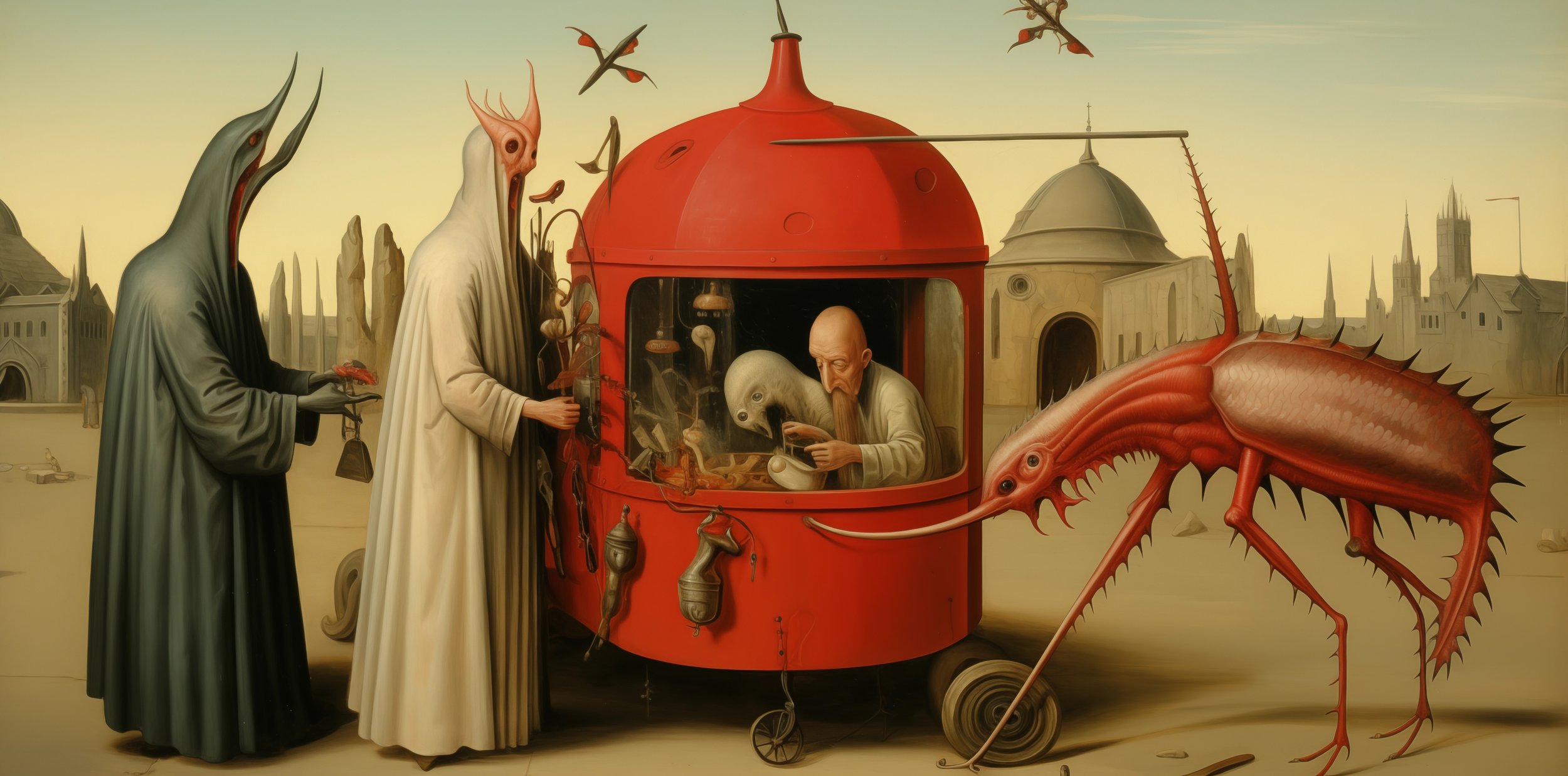
The Conclave of Curiosities
In the silent expanse of an ochre-tinted square, where the spires of an ancient city reach towards the heavens, a conclave of curious entities gathers. Cloaked figures with faces of otherworldly creatures exchange silent words over a vessel of vibrant red, its inhabitant an old man lost in his meticulous craft. Nearby, a creature of the deep, its form both alien and magnificent, stands witness to the solemn exchange. The air is thick with the weight of unspoken knowledge, and every object, every being, seems to hold its breath in anticipation of a revelation.
This gathering, a juxtaposition of the arcane and the inexplicable, poses silent questions to the observer. What rites are being performed in this court of the peculiar? What wisdom is exchanged in the currency of silence? The scene invites the reader to reflect on the nature of knowledge and the many forms it takes. It challenges the notion of what is deemed normal and asks whether understanding is limited to the confines of human convention.
As the parable unfolds, it becomes clear that the true spectacle is not in the bizarre assembly but in the recognition of our own limitations in comprehending the vastness of existence. The reader is prompted to consider the possibility of worlds and wisdoms beyond their grasp, and to embrace the humility that comes with the acceptance of mystery. In a world teeming with wonders, the parable suggests, perhaps the greatest wisdom is in acknowledging the vast seas of the unknown that await our exploration.
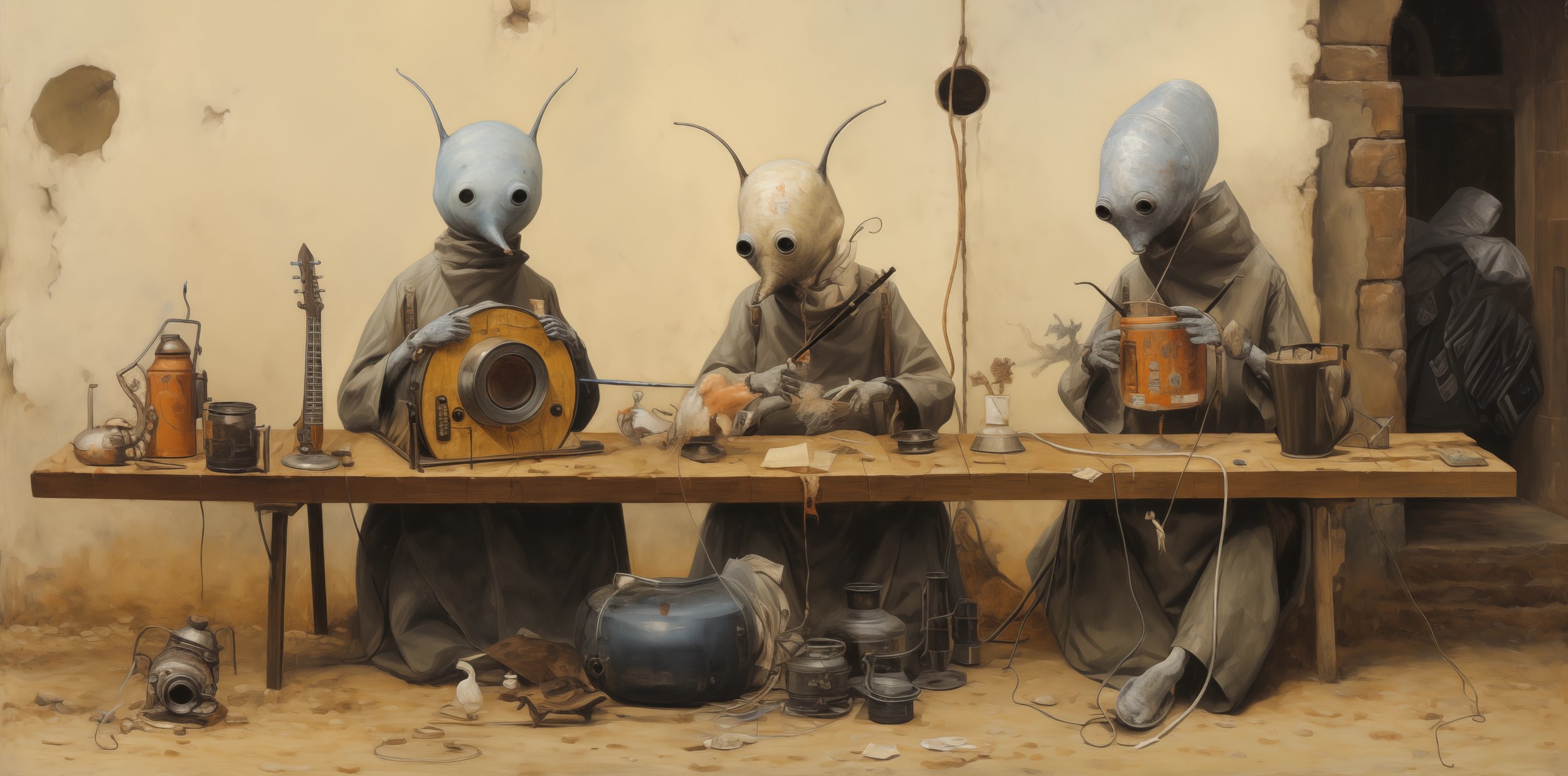
The Minstrels of Forgotten Lore
Amid the faded walls of a bygone era, three minstrels clad in the robes of time itself ply their craft with instruments strange and wondrous. Their faces, alien yet imbued with a kinship to the soul of music, speak silently to the rhythm of creation. Each note played, each device tuned, is an ode to the forgotten melodies that once danced upon the winds of this ancient place. The minstrels, guardians of sound and memory, coax from their instruments a harmony that resonates with the heartbeat of the old world.
This trio, engaged in their sacred concert, invites the listener to ponder the role of art in the preservation of history. What tales do their songs tell? What wisdom do they guard within the cadences of their otherworldly symphony? The parable suggests that within every note lies the echo of a story, within every rhythm a chapter of the past waiting to be read anew. It is a call to recognize the power of art to transcend the boundaries of time and space, to serve as a vessel for the legacies we fear may vanish with the setting sun.
As the narrative culminates, it imparts a realization that memory and music are intertwined, each sustaining the other against the ravages of oblivion. The minstrels' song is more than a mere performance; it is a ritual of remembrance, a defiant stand against the silence that seeks to claim the whispers of history. Through their continued vigil, the minstrels assure us that as long as there is a tune to be played, the stories of old shall never fade into the quietude of obscurity.
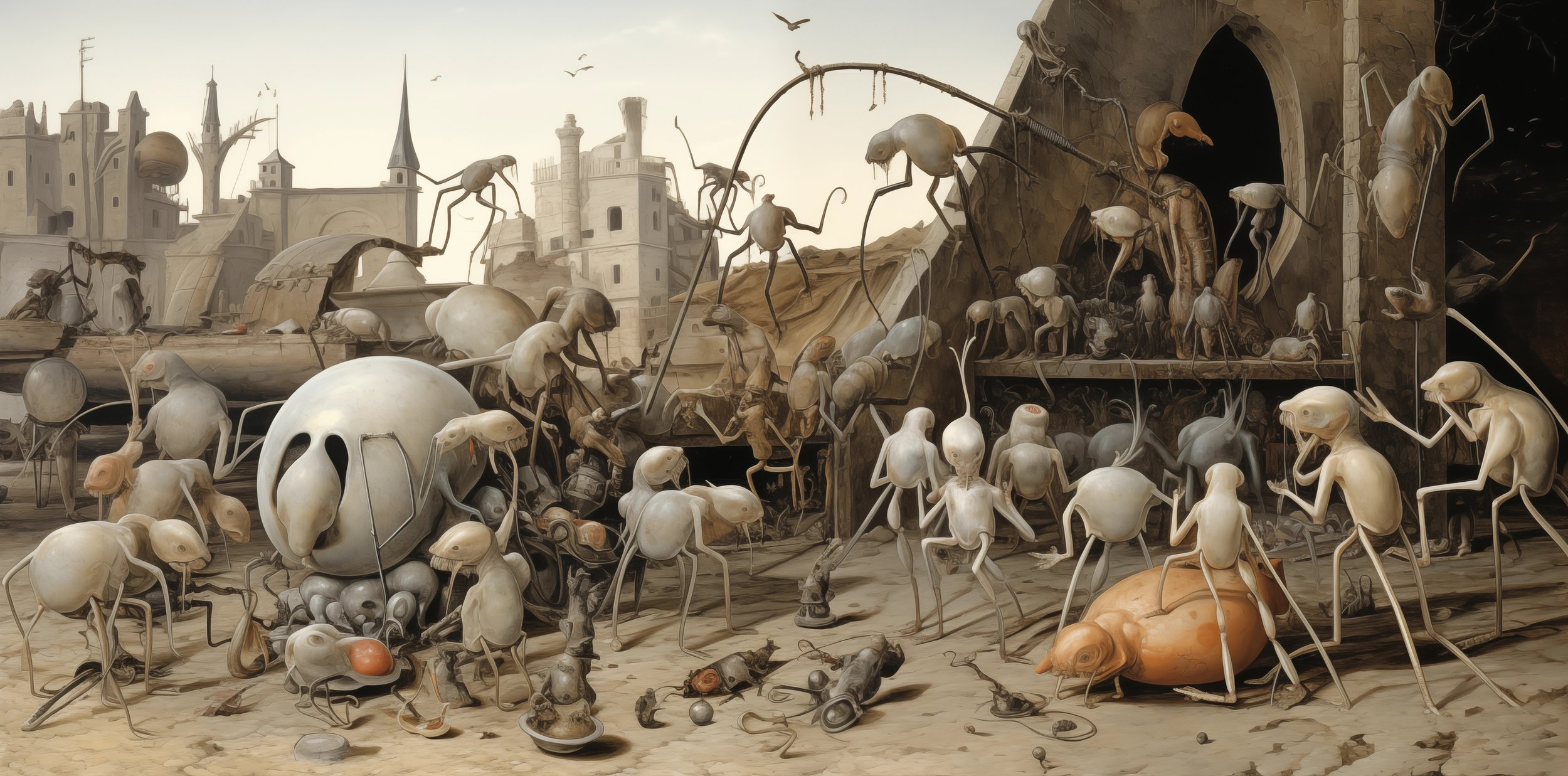
The Parliament of Echoes
In the heart of a city where the buildings themselves seem to whisper tales of yore, there exists a gathering most peculiar. Creatures of slender limbs and varied visages, each unique in form yet united in purpose, hold a parliament under the watchful eyes of their forebears etched into the very architecture that surrounds them. The ground, littered with the detritus of existence, becomes the stage for a silent discourse on the nature of life's fragile dance.
This parliament, a microcosm of diversity, deliberates in the language of silent gestures, their motions a debate on the essence of community in the absence of voice. What resolutions are passed in the quiet rustling of their movement? What laws govern the intricate ballet of their interactions? The parable entwines the reader in a reflection on the unspoken bonds that hold society together, the underlying rhythms that govern our collective existence even when no words are exchanged.
Through this silent congregation, the narrative implores one to listen to the echoes of community, the subtle yet profound communication that transcends spoken language. It is a meditation on the ways in which we connect, the invisible threads that weave the fabric of societies, the quiet yet powerful forces that, unseen, shape the course of civilizations. In the end, the parable unveils the realization that the loudest truths may be found in the quietest of moments, and that wisdom often resides in the spaces between sounds.
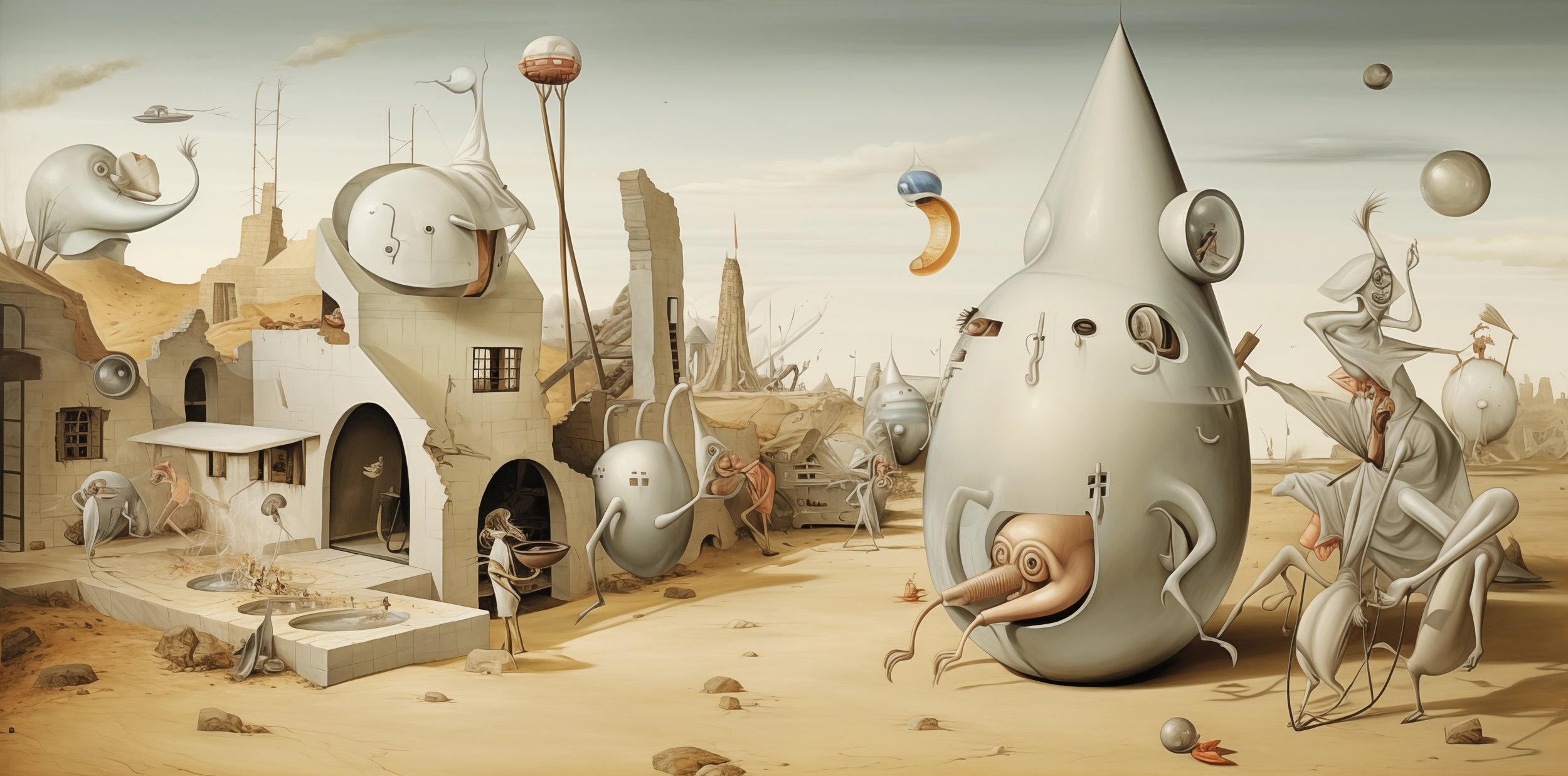
The Carnival of Chronicles
Upon the canvas of a world caught between the remnants of yesterday and the whispers of an uncertain tomorrow, a carnival unfolds. Here, beings of peculiar forms and fantastical functions frolic in the eternal moment, their very existence a question posed to the fabric of reality. Towers and spires crumble in the background, yielding to the relentless march of time, while the inhabitants perform their dance of life with a joyful defiance, a celebration amidst ruins.
This carnival, a menagerie of the bizarre and the whimsical, challenges the onlooker to discern the narrative within the chaos. What stories do these characters carry within their silent forms? What histories are etched into the walls that bear witness to their exuberance? The parable weaves a tale of resilience and rebirth, suggesting that within the heart of destruction lies the seed of creation, that from the ashes of the old, the new is born in jubilant splendor.
The narrative entices the reader to embrace the cyclical nature of existence, to find solace in the constancy of change, and to revel in the beauty of the transient. It is a testament to the enduring spirit that thrives in the face of entropy, a reminder that life, in all its forms, is a spectacle to be celebrated, a chronicle to be savored in each of its fleeting moments.
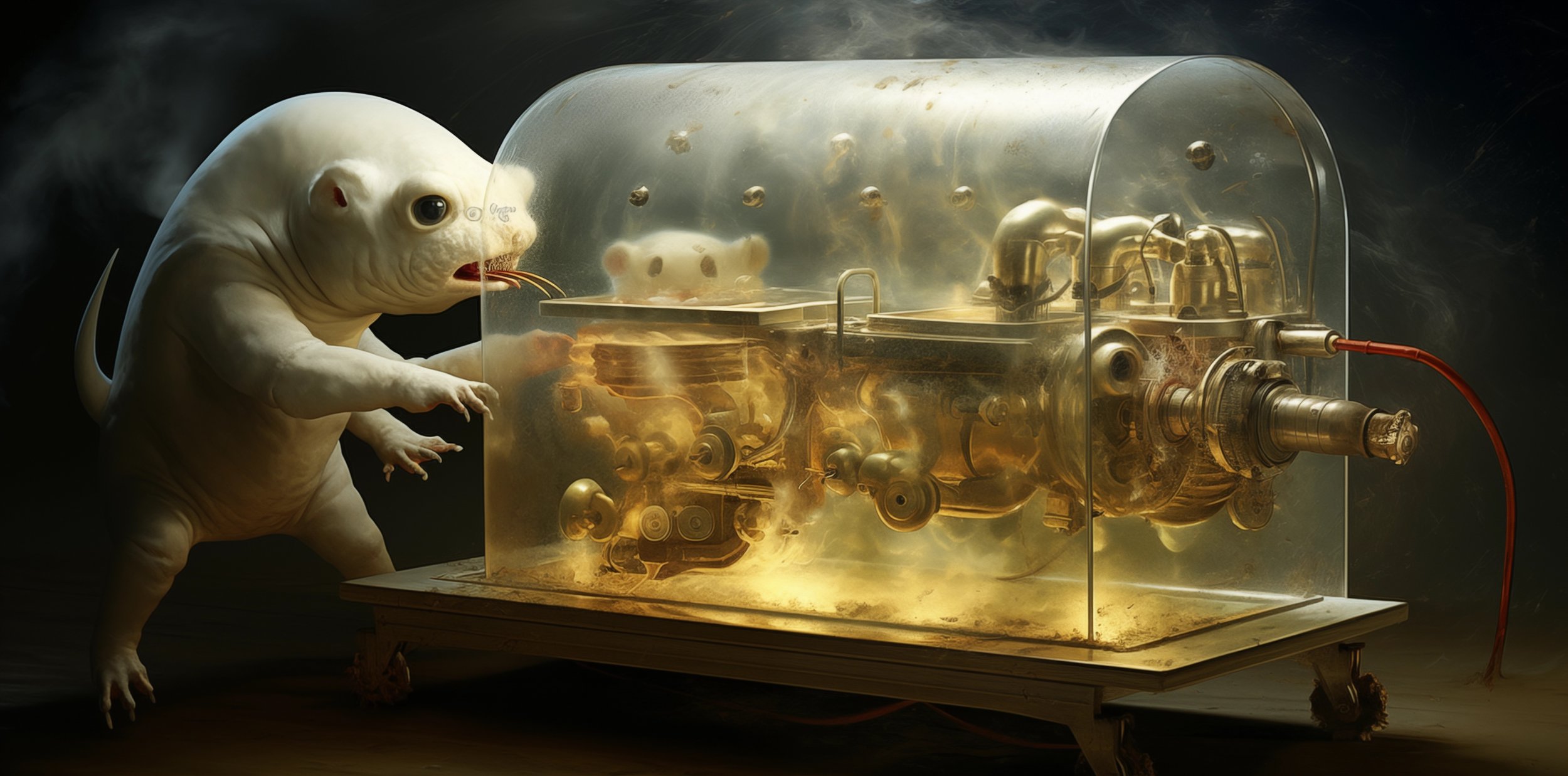
The Genesis Engine
In the dimly lit confines of a room untouched by time's ravages, a creature beholds the Genesis Engine. Its form, an amalgamation of curiosity and trepidation, gazes upon the machine that hums with the promise of life's secrets. Within its glassy dome, a microcosm teems with activity, the gears and pistons a testament to the wonder of creation itself. The creature, with eyes wide and heart pulsing to the rhythm of the machine, stands at the precipice of understanding.
This tableau speaks of the eternal quest for knowledge, the insatiable hunger to uncover what lies beneath the surface of existence. What does the creature seek in the depths of the Genesis Engine? What revelations await in the dance of the mechanical and the biological, intertwined in a symphony of potentiality? The parable unravels the layers of our own search for origin and purpose, the drive to decode the enigma of our beginnings and our place in the cosmos.
As the narrative unfolds, it casts light upon the duality of discovery, the awe-inspiring beauty of life's intricacy, and the daunting responsibility that knowledge brings. The Genesis Engine, a creator of worlds within worlds, challenges the reader to ponder the implications of playing creator, the delicate balance of power and wisdom, and the profound connection between the observer and the observed.
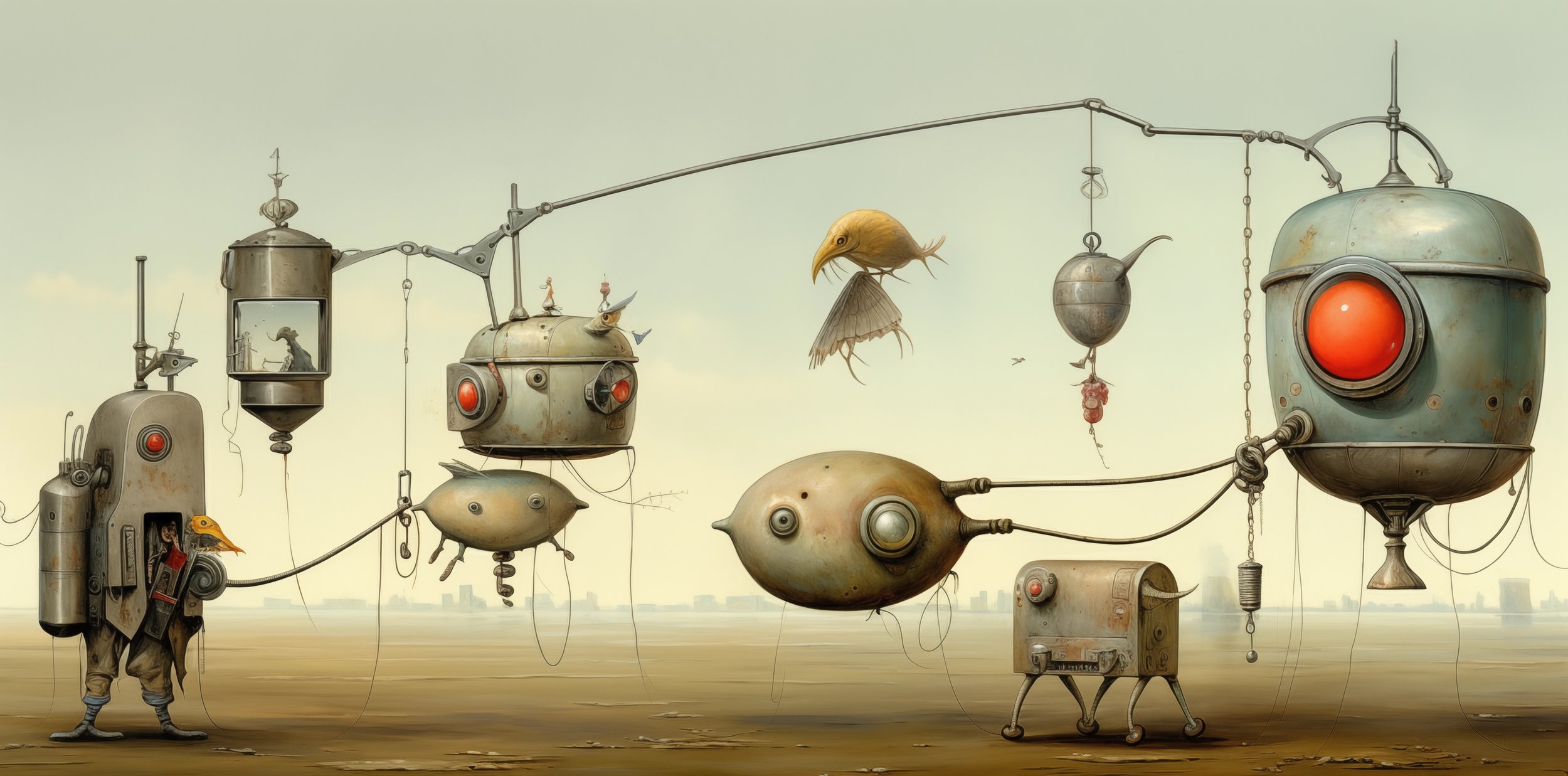
The Symphony of Symbiosis
Along the horizon where the earth meets the sky, an ensemble of mechanical beings performs a symphony of symbiosis. They are diverse in form and function, connected by delicate threads and intricate contraptions, each playing a crucial role in the harmony of their existence. A bird, both part of and apart from this mechanical marvel, flutters freely, adding a natural cadence to the artificial chorus.
This gathering is an orchestra of coexistence, a visual representation of the interconnectedness of all things. What melodies are composed in the confluence of organic and inorganic life? What does this mechanical communion say about the nature of life itself? The parable prompts a contemplation on the balance of ecosystems, the beauty of cooperation, and the dance of dependency and autonomy.
The narrative woven here is a celebration of unity in diversity, of finding common ground amid contrasting natures, and of the seamless integration of different entities working towards a collective purpose. It encourages the reader to reflect on the universal symphony in which we all partake, the silent music that orchestrates the ebb and flow of existence.
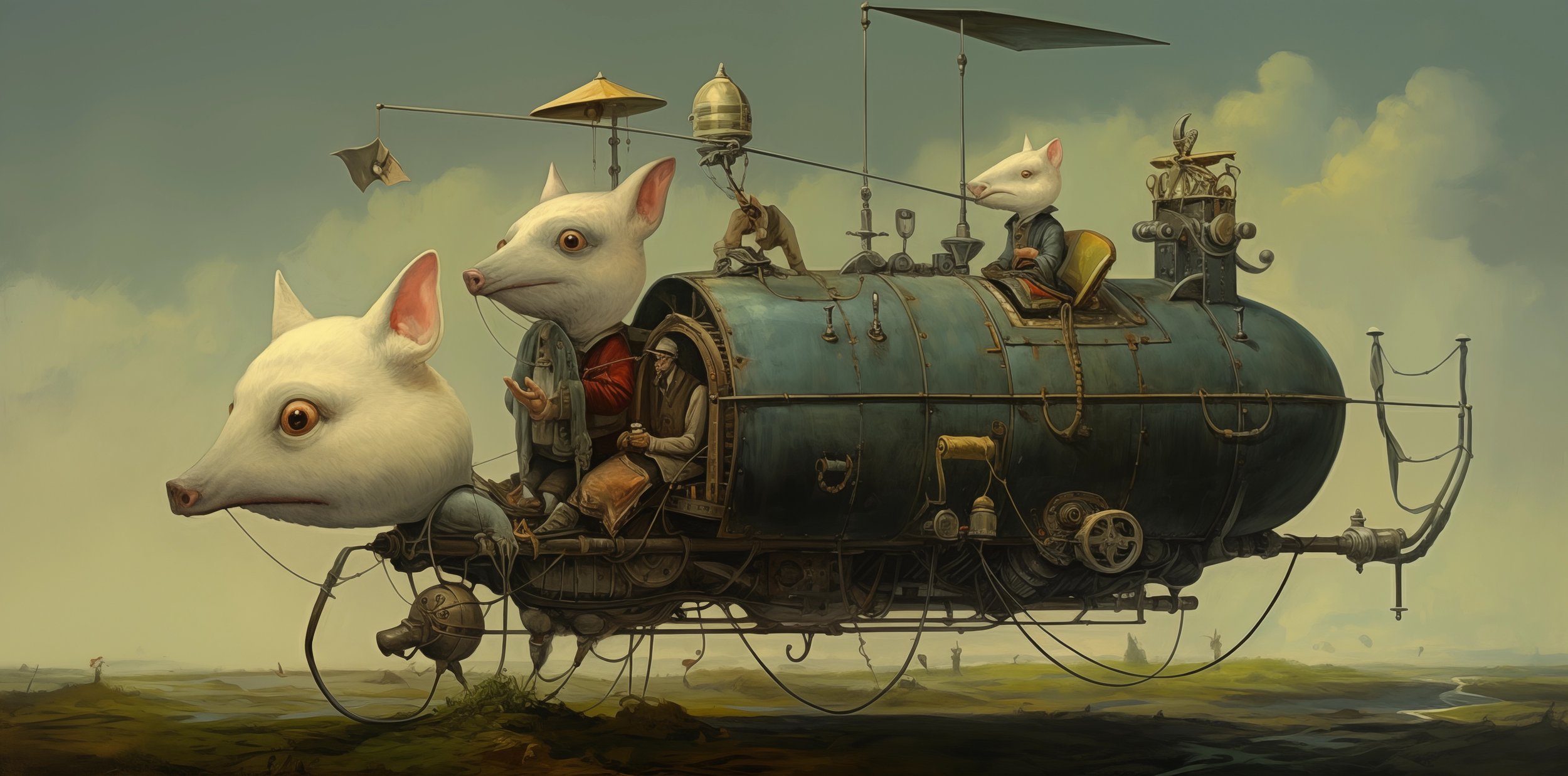
The Voyage of the Porcine Pilots Suspended
in a sky that kisses the horizon of verdant fields, a vessel of improbable design and porcine pilots embarks on a journey through the clouds. Its hull, robust and whimsical, carries the dreams and aspirations of its crew, each member an integral part of this aerial odyssey. The pigs, anthropomorphic in their poise, navigate the vessel with a navigator's precision and a dreamer's vision, charting a course through the vast tapestry of the skies.
This voyage is a parable of adventure and discovery, a narrative that sails on the winds of imagination and innovation. What destinations do these intrepid explorers seek? What discoveries does the world beyond the familiar hold for them? The tale inspires the reader to consider the limitless potential of the mind when unshackled from the mundane, the power of dreams to propel us into the uncharted territories of our own potential.
As the story ascends, it becomes a metaphor for the human spirit's innate desire to explore, to push beyond the boundaries of the known, and to redefine the possible. The porcine pilots, with their quiet determination and unyielding curiosity, remind us that the journey itself is often the greatest destination, and that the horizons we seek may just be the ones we create.

The Custodians of Paradox
On the edge of reality, where the sands of the familiar meet the tides of the absurd, stand the Custodians of Paradox. Their forms defy explanation, a menagerie of creatures bound by the singular duty to tend to the vast garden of the surreal. One bears the weight of a head too large, eyes wide in a silent scream, while another, robed and beaked, holds the instruments of time and fate, a mediator between the worlds of the tangible and the imagined.
This scene, a convergence of the bizarre and the enigmatic, asks the observer to embrace the unknown. What truths are these guardians privy to in their silent vigil? What lessons do they impart upon the canvas of the mind, where logic intertwines with the fantastical? The narrative delves into the heart of human curiosity, the desire to understand the incomprehensible, to find order in chaos.
Through this congregation of anomalies, the parable explores the delicate balance between knowing and wondering, the power of the inexplicable to ignite the fires of thought and the importance of mystery in an age of relentless revelation. It is a reflection on the necessity of the unanswerable questions, the ones that keep the spirit of inquiry alive and ensure that the journey of understanding is never complete.
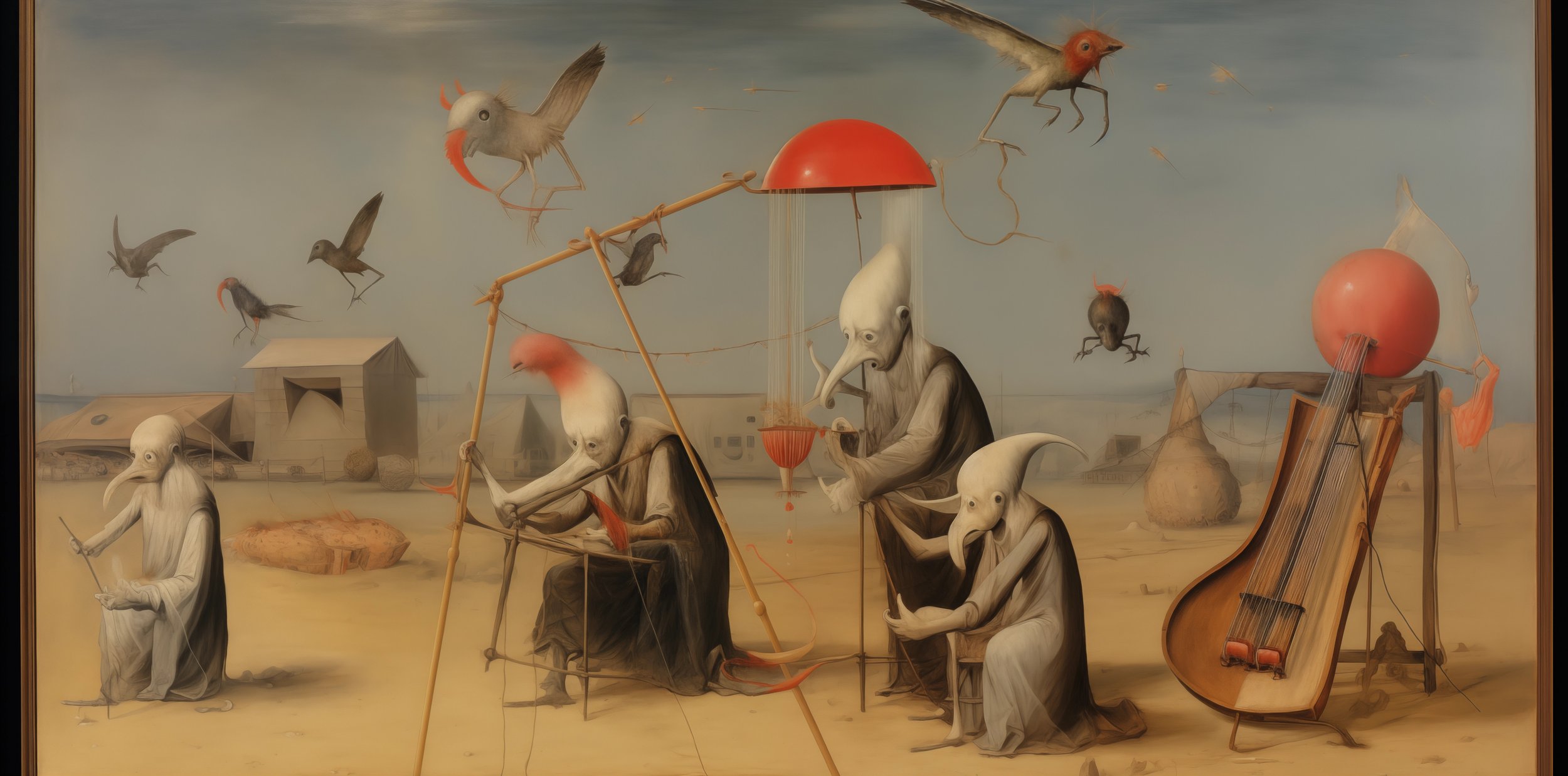
The Melody of the Absurd
In a landscape where the sky stretches into eternity, a troupe of unearthly minstrels plays a melody of the absurd. Cloaked in the garb of ancient mystics, they coax bizarre harmonies from instruments that defy convention. Around them, birds with colors of a dreamer's palette take flight, their whimsical forms a dance to the rhythm of the strange ensemble. The scene, both tranquil and dissonant, is a symphony of the surreal.
This gathering is an allegory for the celebration of difference, a concert where the unconventional finds its voice. What songs do these peculiar minstrels sing? What stories do the vibrant birds carry on their wings? The parable encourages the reader to listen to the music of the unconventional, to the whispers of the odd and the original that permeate the expanse of normalcy.
The narrative sings of the richness that diversity brings to the tapestry of life, the beauty that lies in the unique and the unreplicated. It is a call to appreciate the melodies of the nontraditional, to understand that even in the most peculiar of tunes lies a common thread of joy and expression.
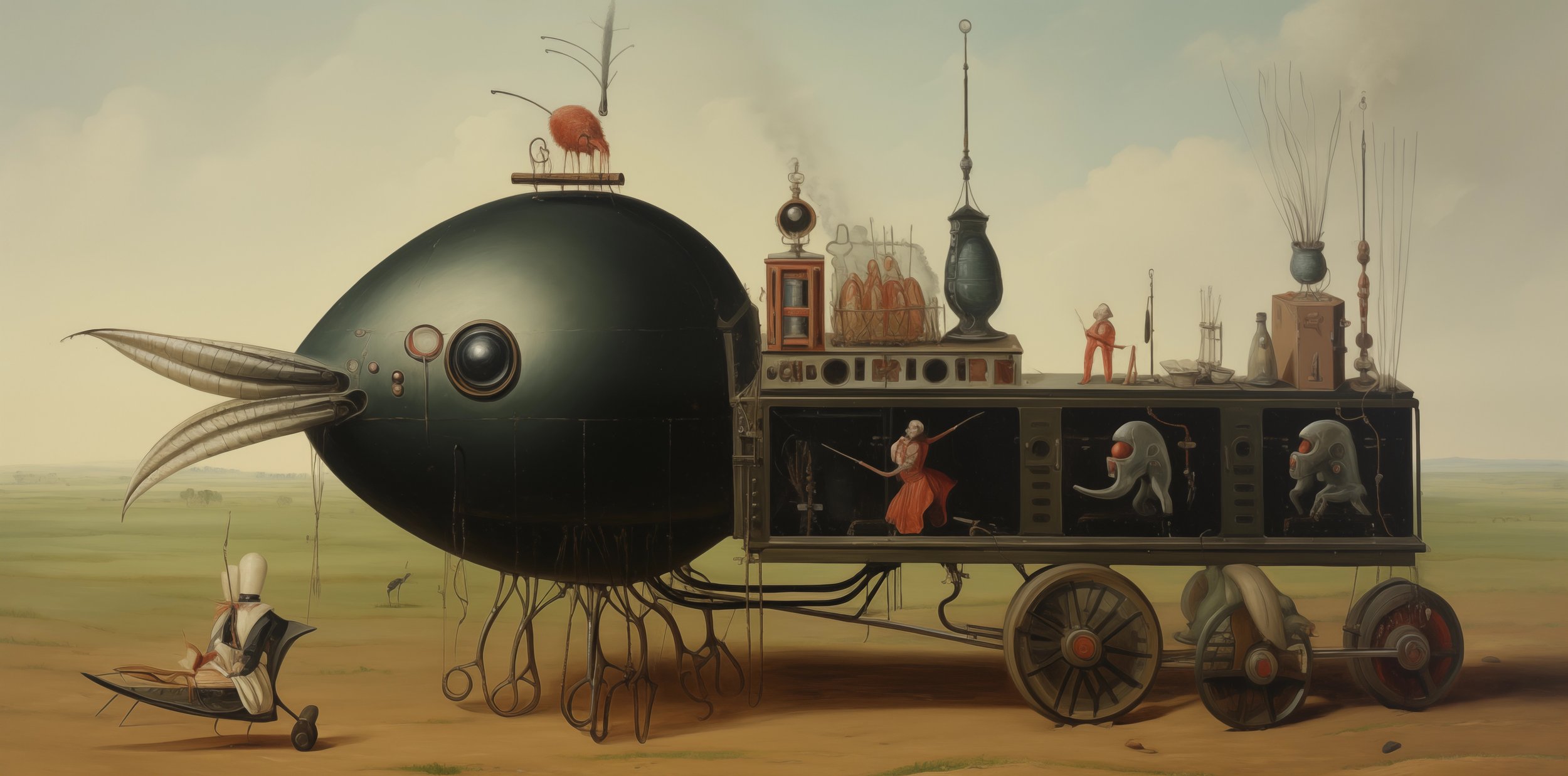
The Caravan of Curiosities
Across the vast canvas of the horizon, there travels a Caravan of Curiosities, a locomotive of the extraordinary, propelled not by steam, but by the sheer force of wonder. Its inhabitants, a collection of beings each more fantastical than the last, perform their tasks with a grace that belies their bizarre appearances. Atop this wandering vessel, musicians and acrobats defy the mundane, each act a defiance of the prosaic laws of nature.
The scene is a celebration of the peculiar, a moving tableau that questions the very essence of normality. What are the stories of these travelers, and what marvelous destinations are they journeying towards? The parable invites the reader to cast away the anchor of their expectations and to sail on the tides of imagination. It is a reminder that the journey through life need not be a straight path, but a serpentine road filled with marvels and mysteries.
Within this narrative lies a deeper truth, a commentary on the richness of diversity and the spirit of exploration. The Caravan of Curiosities symbolizes the odyssey of life, an endless voyage through the landscapes of the fantastic and the realms of the unknown.

The Ark of Imagination
Amidst the vast expanse of a world where the skies are an artist's muted canvas, there floats the Ark of Imagination. Its hull, swollen with the treasures of thought and dream, carries within it the silhouettes of countless inventions and ideas. The crew, a motley assemblage of beings each more whimsical than the last, tend to their duties with a serene focus. On the ground, creatures with the innocence of myth and the curiosity of children gaze upon the ark, witnesses to the marvels of creativity set adrift.
This scene is an allegory of the human mind's infinite capacity for creation. What marvels lie within the confines of this floating repository? What boundless creations are birthed from the confluence of such disparate beings? The parable unfolds as an invitation to the reader to embark on their own journey of imagination, to cast off from the shores of reality and to sail into the unbounded seas of potential.
The narrative is a tapestry of innovation and fantasy, a reminder that the vessels we build to carry our dreams are as limitless as the dreams themselves. It is a celebration of the creative spirit, the boundless adventure that awaits when we dare to dream and the collective journey of humanity as we navigate the ever-expanding universe of our collective imagination.
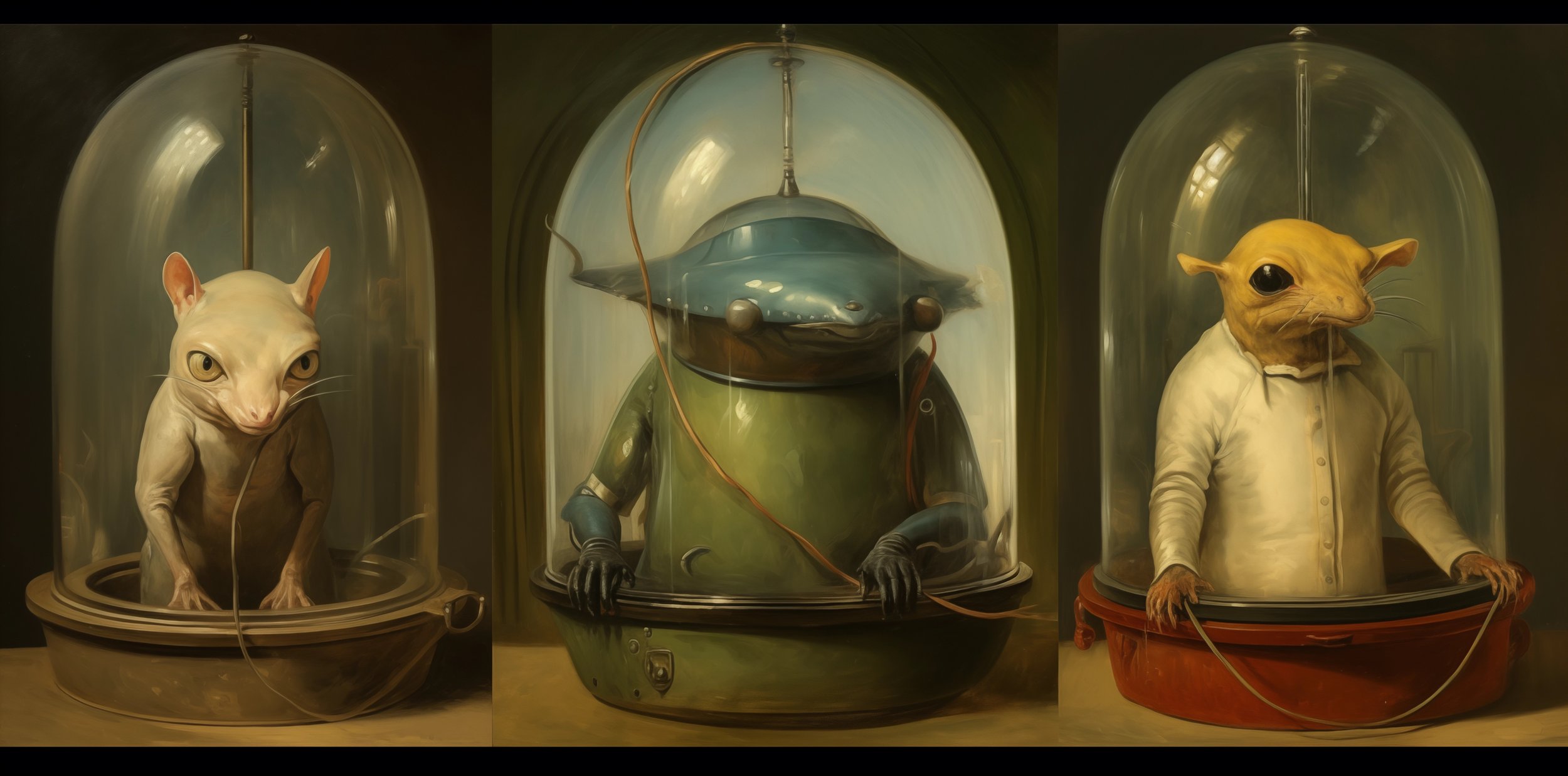
The Triptych of Perception
Encased within the clarity of glass domes, a triptych of beings pose, each one an enigma, a riddle of perception. To the left, a creature of delicate features and keen eyes suggests the innocence of discovery. At the center, an armored sentinel embodies the steadfastness of protection and the weight of endurance. To the right, a figure dressed in the simplicity of the everyday reflects the commonality of experience.
This triptych is a meditation on the facets of existence — curiosity, guardianship, and the commonplace. What worlds do their eyes behold from within their transparent sanctuaries? What thoughts linger behind their gazes? The narrative delves into the layers of consciousness, exploring the myriad ways in which we perceive and are perceived by the world around us.
The parable invites the reader to consider the lenses through which we view life — the wonder, the resilience, the ubiquity. It speaks to the essence of being and the various roles we inhabit throughout the act of living. In this silent communion, the triptych imparts a silent wisdom: that each perspective, no matter how disparate, contributes to the whole of our understanding.
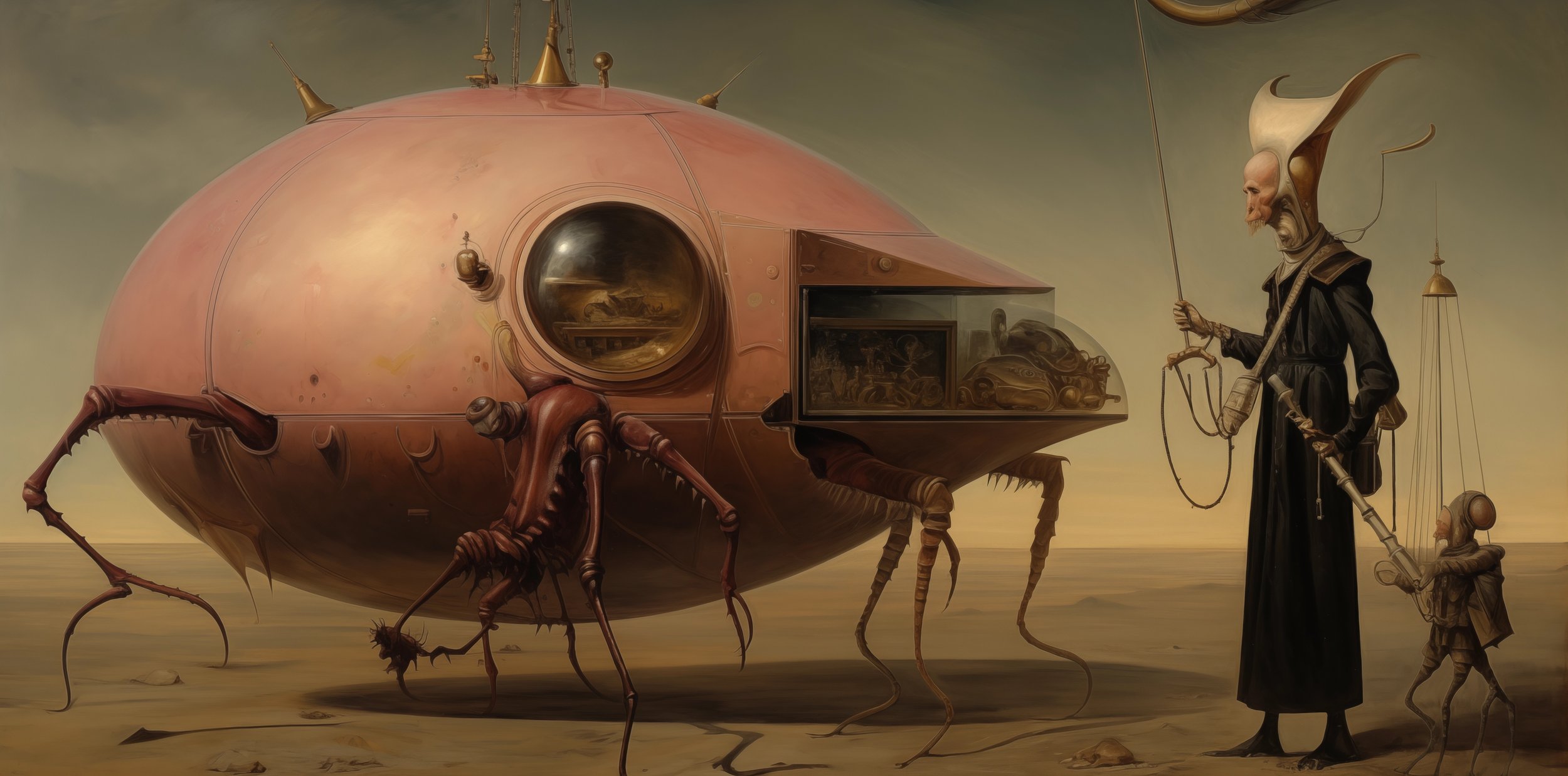
The Pilgrimage of Chronicles
Before the vast canvas of an unending dunescape, a colossal orb trundles forth, a behemoth of memories encapsulated within a shell of time-worn copper. Beholden to its purpose, it is guided by solemn figures, each a sentinel of history's silent march. Within its spherical chamber, scenes of yore and faces long past press against the glass, a mosaic of existence preserved in the amber of retrospection.
This procession is a pilgrimage of chronicles, an odyssey through the annals of time. What tales are encased within this traveling archive? What legacies does it safeguard, spinning perpetually on the axis of eternity? The parable invites the reader to join in this solemn procession, to wander alongside the guardians of remembrance in a contemplative march across the sands of time.
The narrative embodies the journey of legacy, the sacred trust of carrying forth the essence of what was into the expanse of what will be. It is a testament to the enduring power of story and memory, to the role of the chronicler and the steward in the unbroken lineage of our shared humanity.
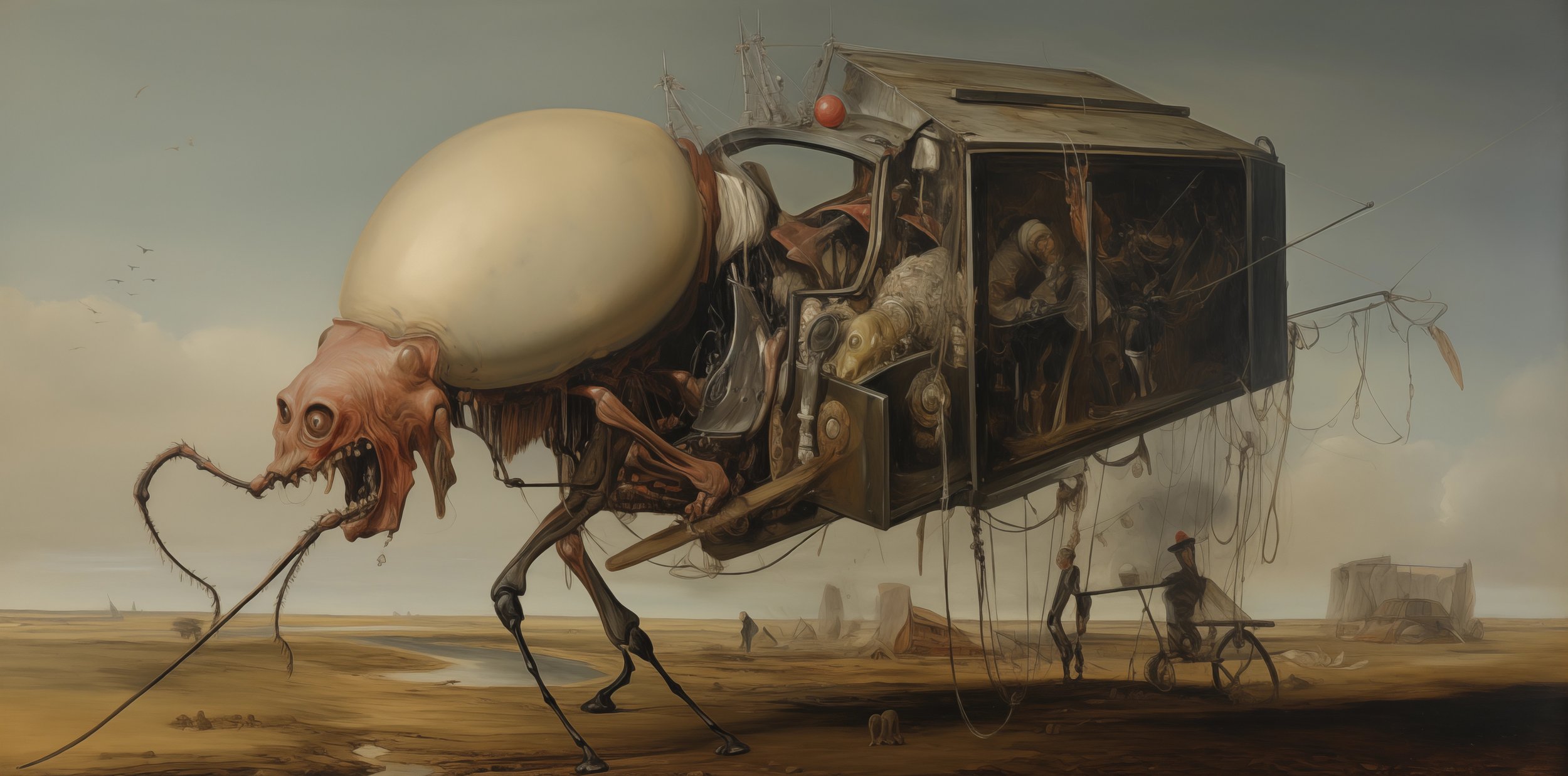
The Behemoth of Burden
Trudging through the barren expanse of an otherworldly desert, the Behemoth of Burden bears the remnants of a bygone civilization within its carapace. It is a creature of survival, of adaptation, its form a grotesque monument to the resilience required to endure the harsh whispers of a wasteland. Its keepers, small in stature but grand in purpose, navigate the beast with a delicate interplay of control and trust.
This image is a stark portrayal of perseverance and the weight of history we carry forward. What histories does the behemoth contain within its shell? What stories are etched into the very sinews of its construction? The parable illustrates the human condition, our own odyssey laden with the artifacts of our past, as we journey through the deserts of time.
The narrative implores the observer to consider the burdens we bear, the relics of our collective journey that we choose to preserve against the eroding sands of oblivion. It is a meditation on the symbiosis between the past and present, the necessary burdens that shape our identity and the ceaseless march towards an uncertain horizon.
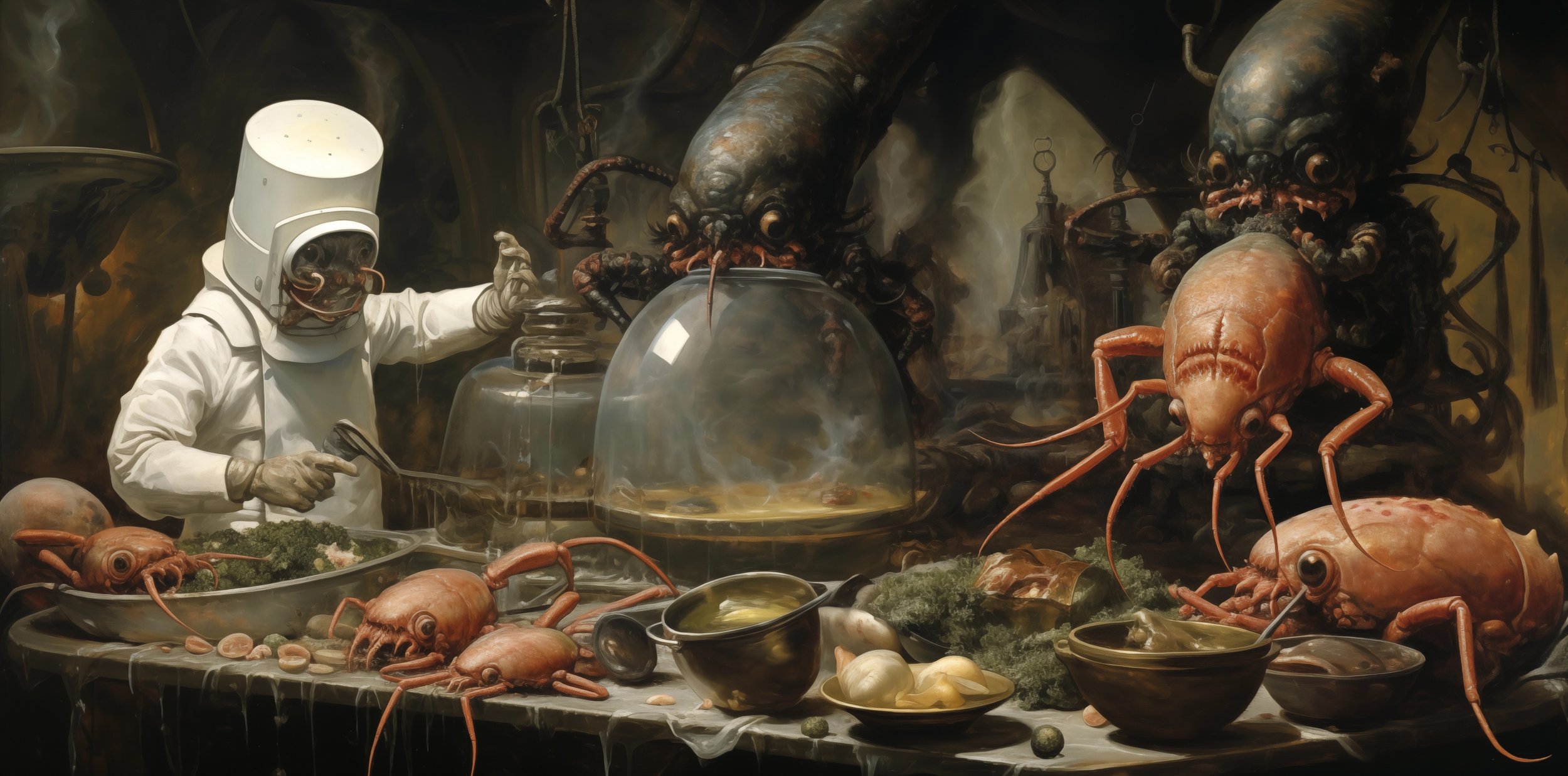
The Alchemist’s Feast
In a chamber that blurs the line between kitchen and laboratory, an alchemist labors with the zeal of a maestro conducting a symphony of flavors. Around him, creatures of the sea and instruments of science converge in a bizarre culinary rite. The alchemist, a figure of focus and precision, is a mediator between the natural world and the transformative potential of his craft.
This tableau speaks to the art of creation, the alchemy of combining elements to transcend their origins, creating something greater than the sum of its parts. What exotic dishes are summoned forth from this arcane process? What hidden essences are unlocked from within the mundane? The narrative unfolds as a meditation on the transformative power of cooking, a craft that shares much with the ancient search for transcendence.
The scene inspires a reflection on the beauty of transformation, the continual metamorphosis that all elements undergo when touched by the hand of a master. It is a celebration of the culinary arts, the mysterious processes behind the meals we consume, and the perpetual dance of creation and recreation that sustains life.
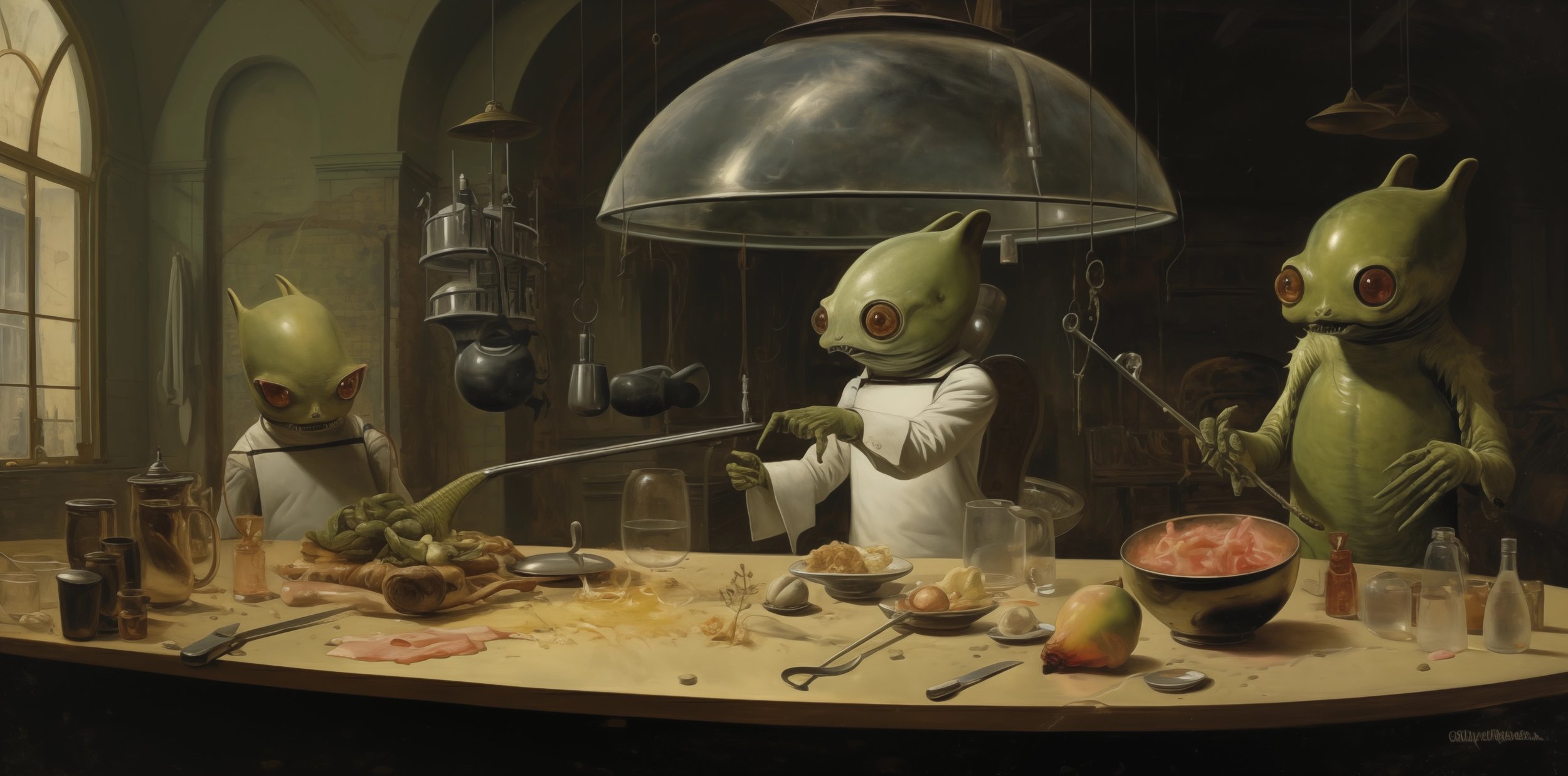
The Gourmands' Conclave
In a kitchen where the mundane meets the mystical, a conclave of gourmands delves into the artistry of cuisine. They are creatures of another world, their features odd and intriguing, yet their focus is universal — the creation of a feast. Each chef, armed with tools of the culinary trade, works with an earnest intensity, their alien hands adept at chopping, stirring, tasting.
This scene serves as a whimsical allegory for the universal language of cooking, a craft that transcends worlds and brings beings together. What exotic dishes are these chefs so diligently preparing? What flavors and aromas, unknown to the human palate, are being concocted in this otherworldly gathering? The narrative is a celebration of gastronomy, a testament to the joy and passion that cooking invokes, no matter the chef.
The tale whispers of the unity found in the act of meal preparation, the shared experiences across the cosmos in the simple act of breaking bread. It is a reminder that, in the grand tapestry of existence, the act of creating sustenance is a common thread that binds all life.
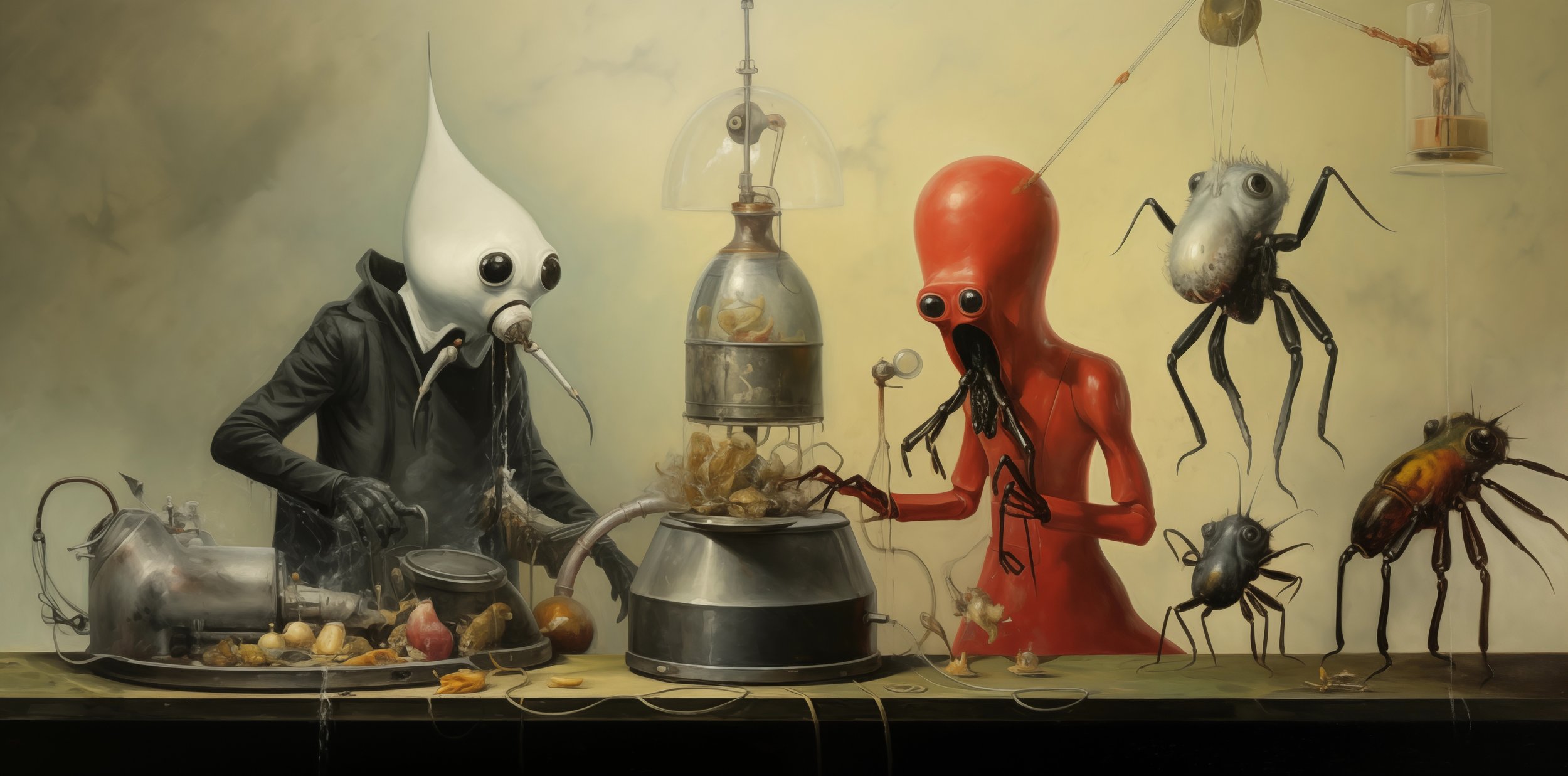
The Concoction of Curiosities
In an otherworldly kitchen where the strange and the familiar stew together in an eclectic brew, a gathering of chefs each more peculiar than the last delves into the craft of concoction. Cloaked in attire that speaks of alchemical mysteries, they stir and season, their movements a ballet of the bizarre. From the red figure with tentacles fine-tuning the flavors to the spectral form attending to the boiling pots, each character is engrossed in their culinary alchemy.
This ensemble cast illustrates the endless possibilities that emerge when diverse elements combine. What fantastical recipes are being perfected here? What flavors unimagined are brewing in these pots? The parable is a metaphor for creativity itself, the melting pot of innovation where ideas from disparate realms mix to create something truly extraordinary.
The narrative suggests that the most memorable creations often arise from the unexpected fusion of the unconventional. It is an invitation to indulge in the sensory feast of the imagination, to taste the fruits of experimentation, and to savor the rich results that collaboration and diversity can yield.
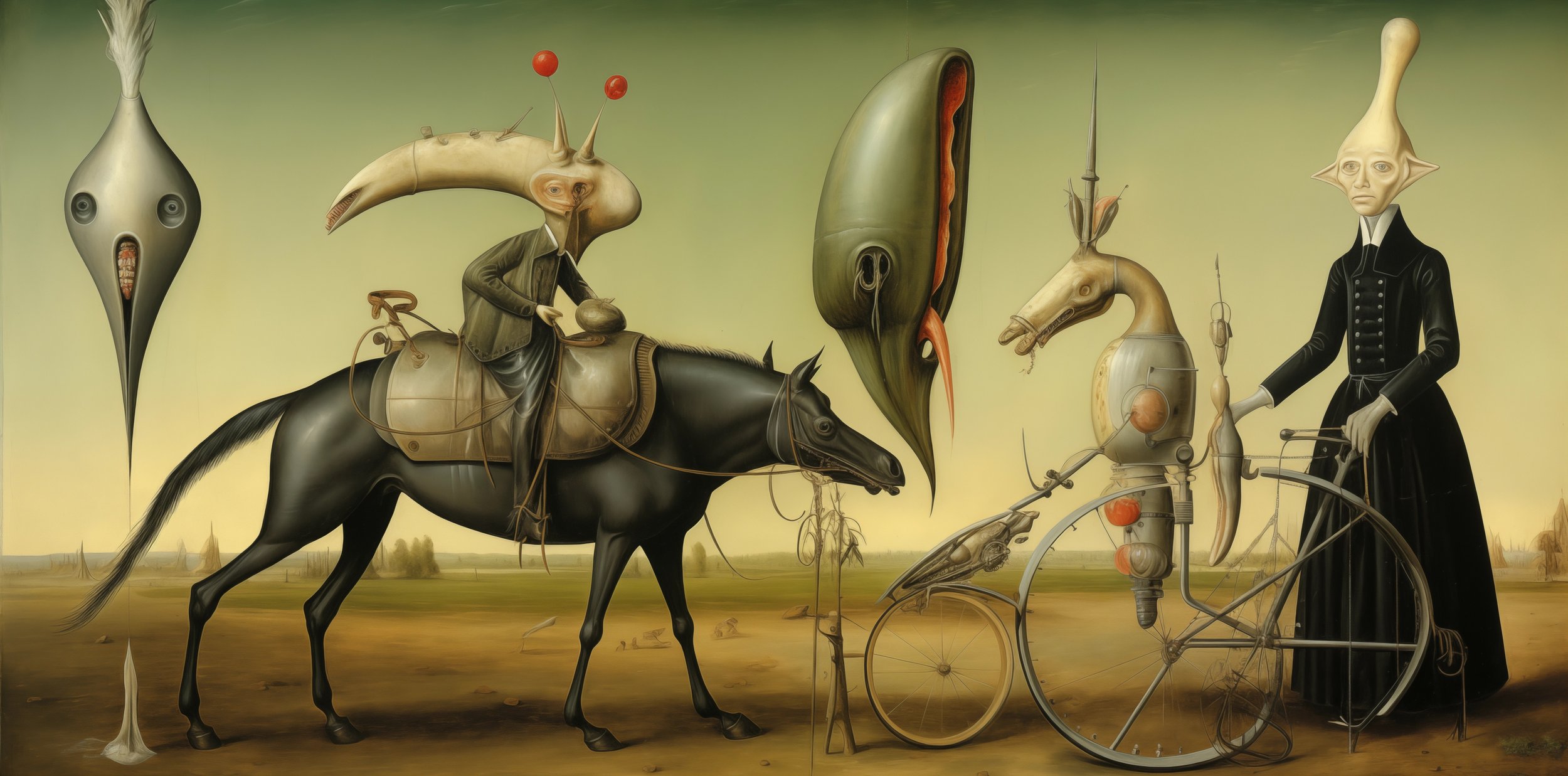
The Procession of the Unconventional
In a realm where the grassy plains touch the horizon, a procession of the unconventional unfolds. Characters of peculiar countenance and attire traverse the landscape, each with their own means of journeying — be it on the back of a mechanical steed or alongside an enigmatic bicycle, their designs defy convention and challenge the ordinary. The air is filled with an unspoken narrative, a story of individual paths converging in a shared odyssey.
This scene is a vivid tapestry of individuality and the celebration of the path less traveled. What are the origins of these travelers, and what unique tales do they carry? The parable encourages the reader to consider the richness that divergent paths bring to the collective journey of life. It is an homage to the beauty of the unique, the power of innovation in motion, and the splendor of straying from the beaten path.
The narrative suggests that the most extraordinary voyages often arise from the willingness to embrace the odd, the novel, and the innovative. It is a reflection on the endless possibilities that emerge when one dares to venture forth with an unconventional spirit.
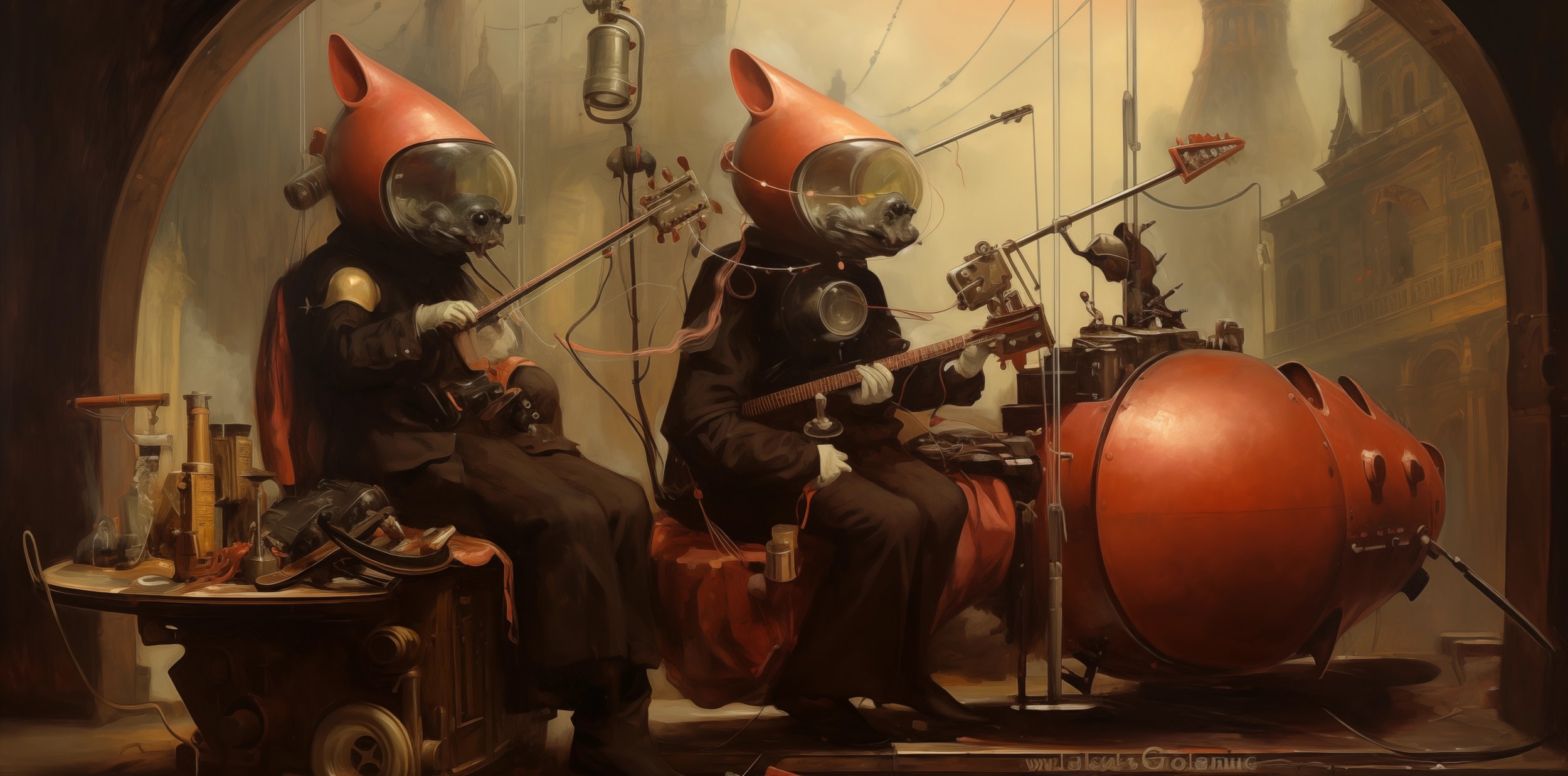
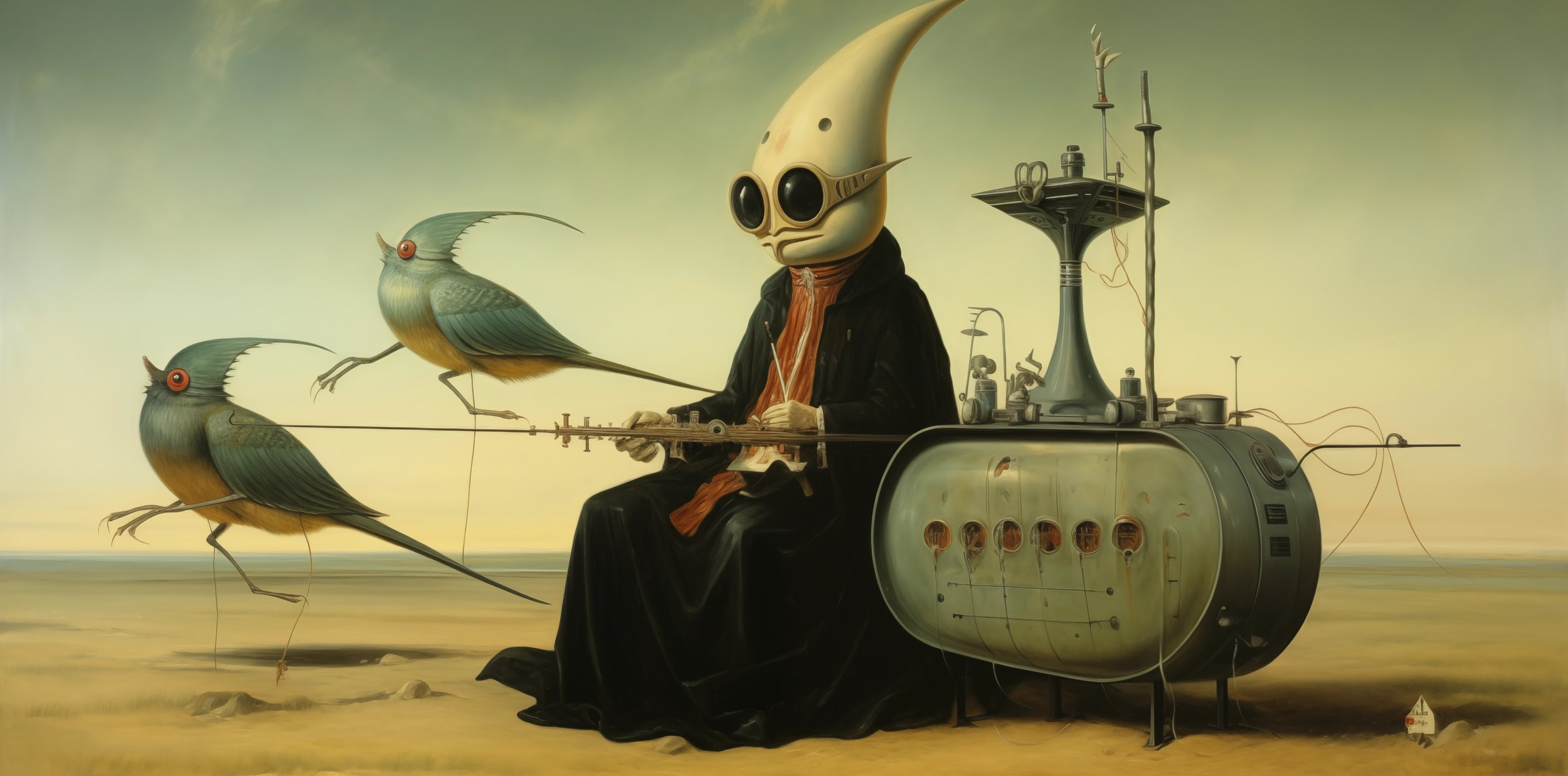
The Serenade of the Sentient
On a tranquil plane where the land whispers to the sky, a figure of enigmatic grace serenades the sentient. With a violin that sings of forgotten times and places yet to be discovered, the musician plays for an audience of birds, their forms an echo of the fantastical. They listen, entranced by melodies that weave the tangible with the ethereal.
This moment is an interlude of connection, a concert where the lines between species and understanding blur into harmony. What chords are struck here, in this meeting of the mechanical and the living? The parable offers a reflection on communication beyond words, on the universal language of music that speaks to all forms of life.
The narrative is an ode to the beauty of diverse expressions of sentience, to the boundless potential for connection that exists when we transcend our limitations. It is a celebration of the strange and the wonderful, and the ways in which art can be a bridge between worlds.
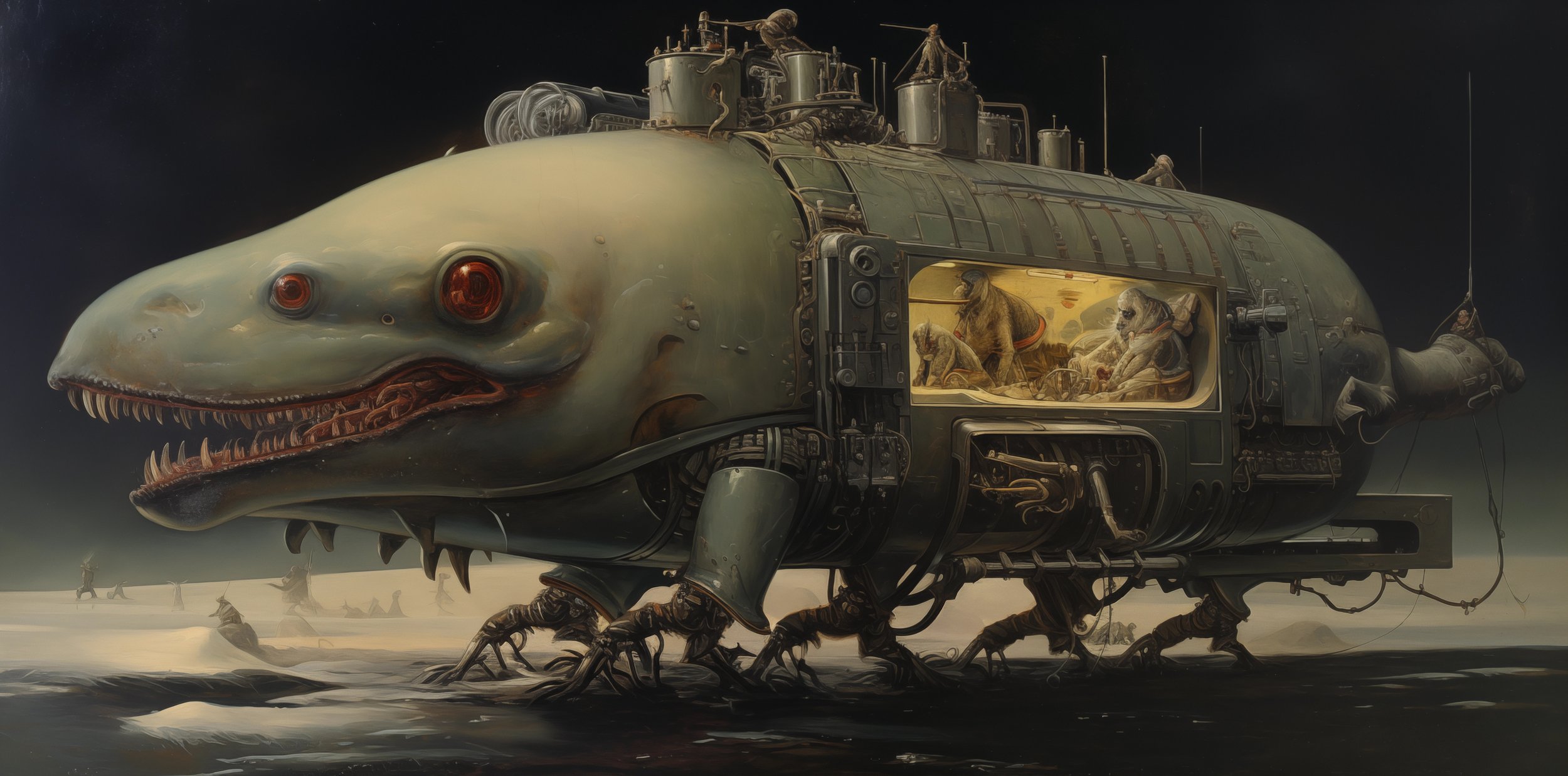
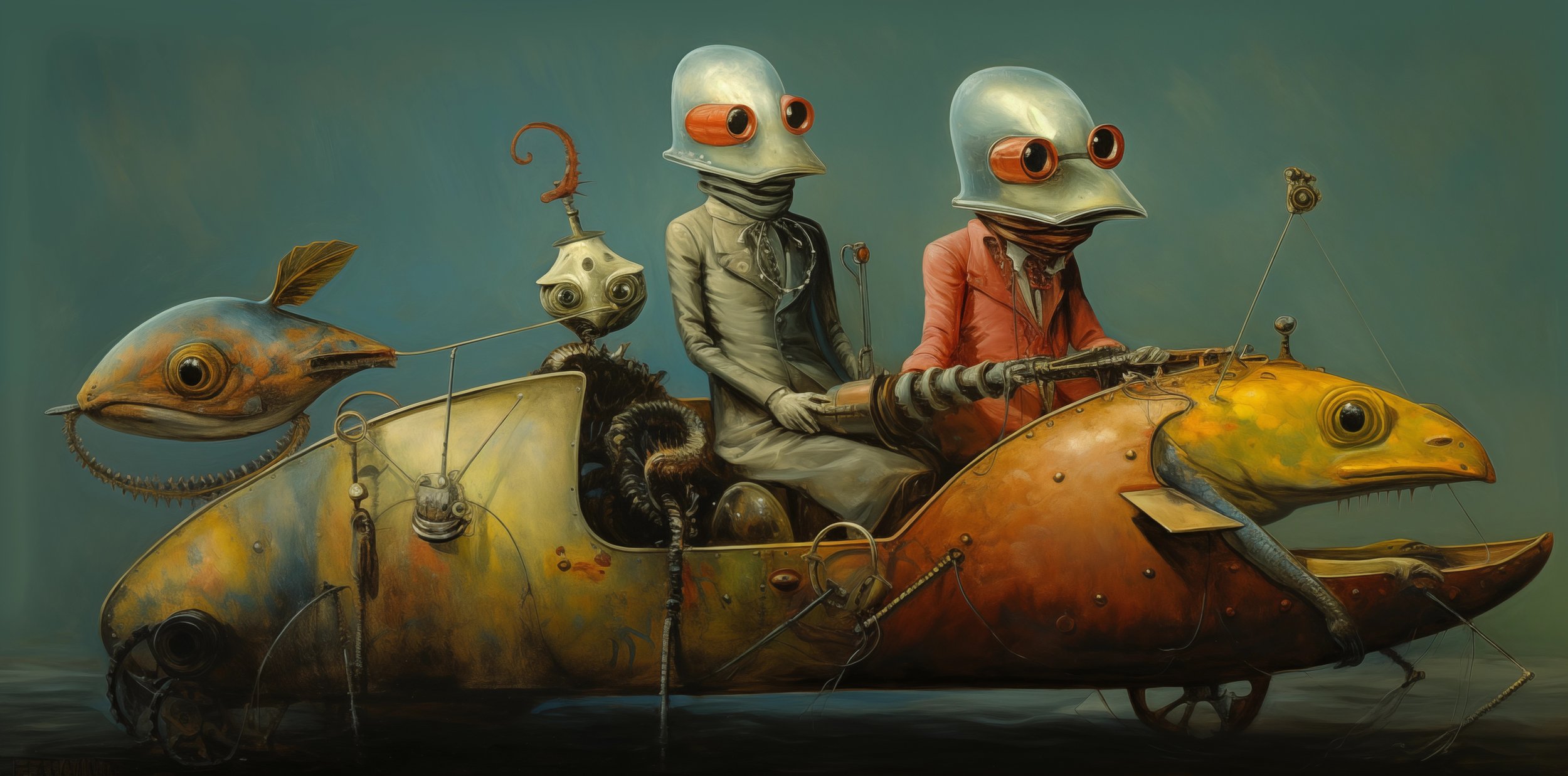

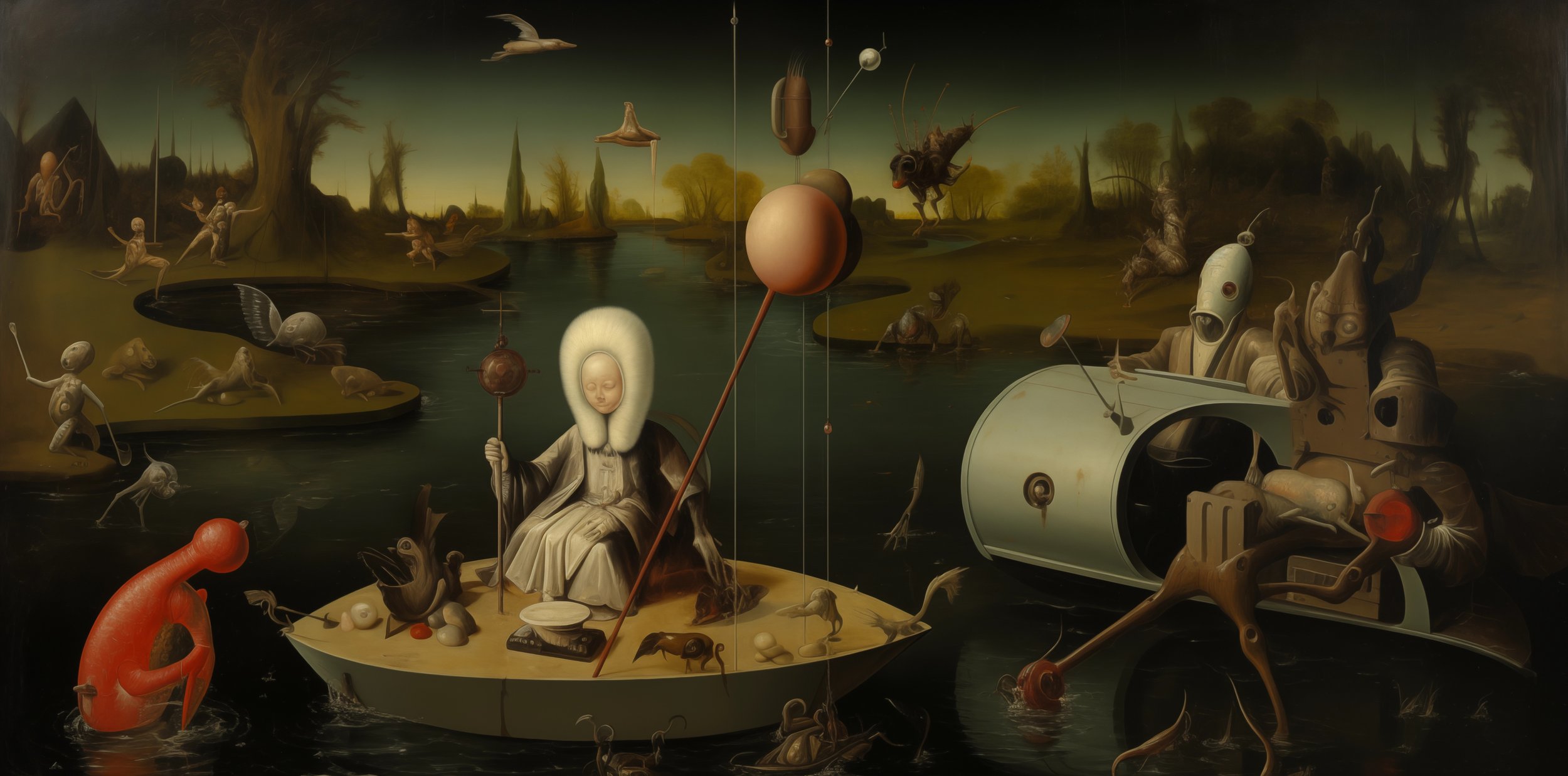
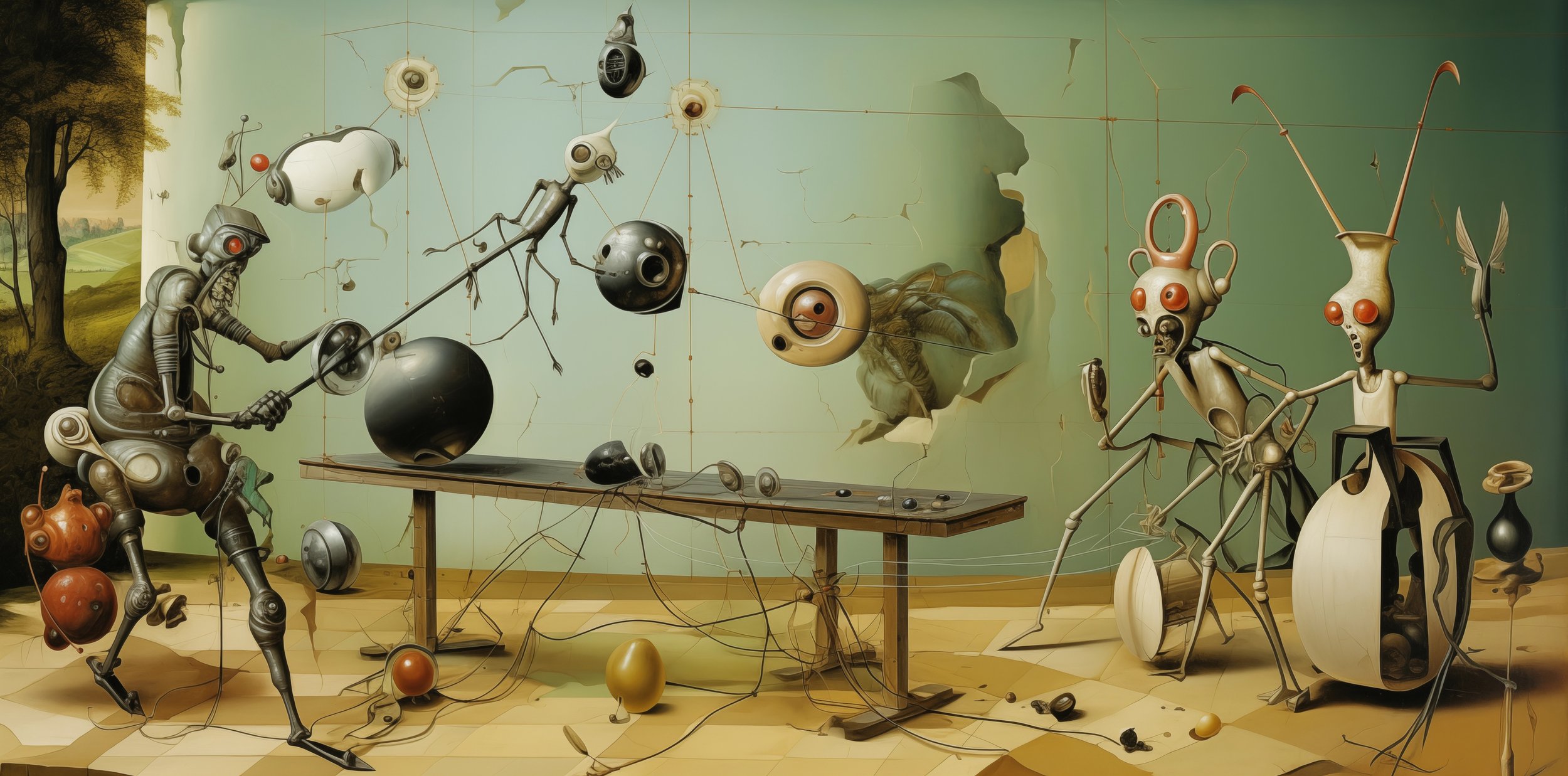
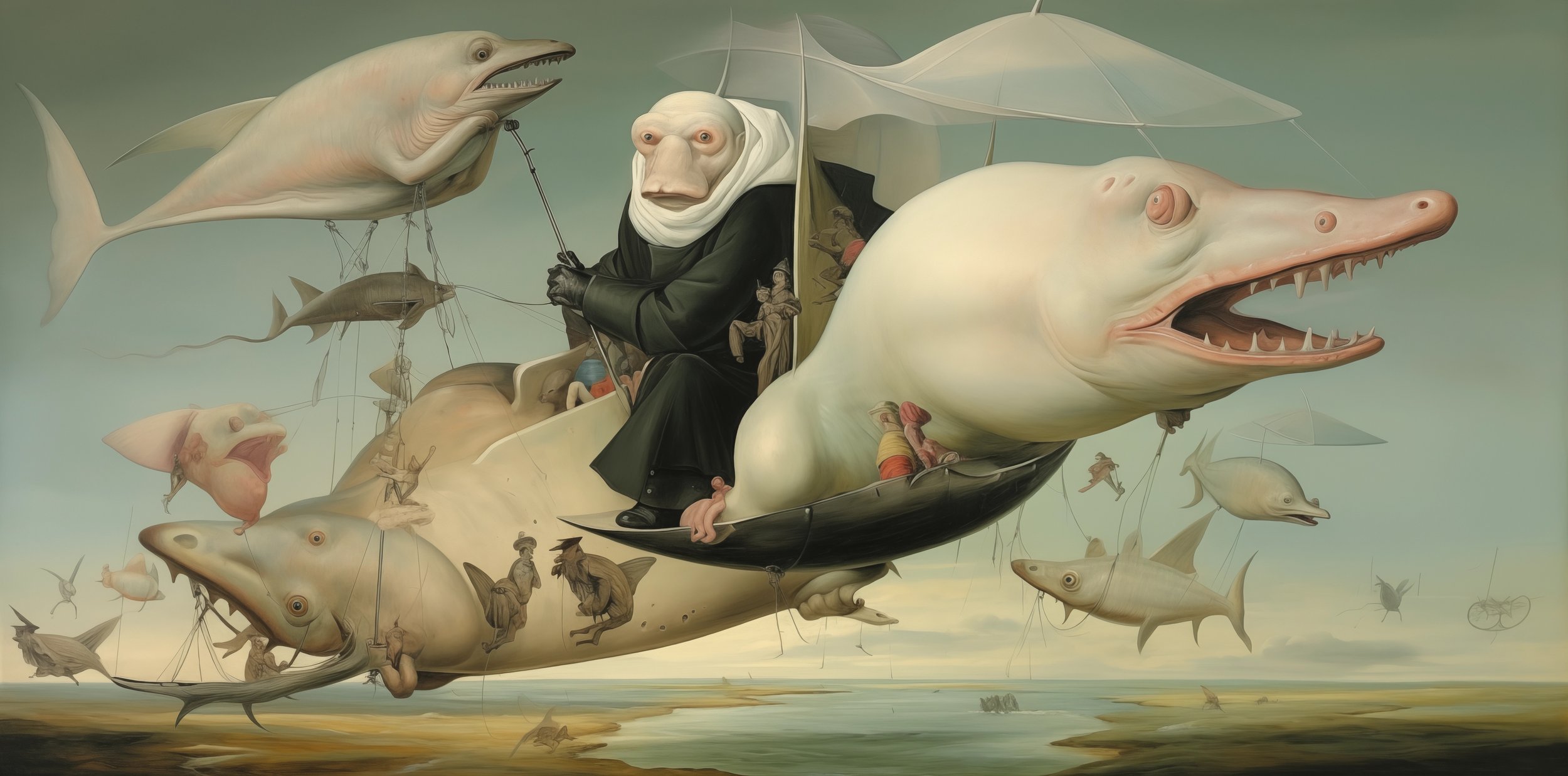
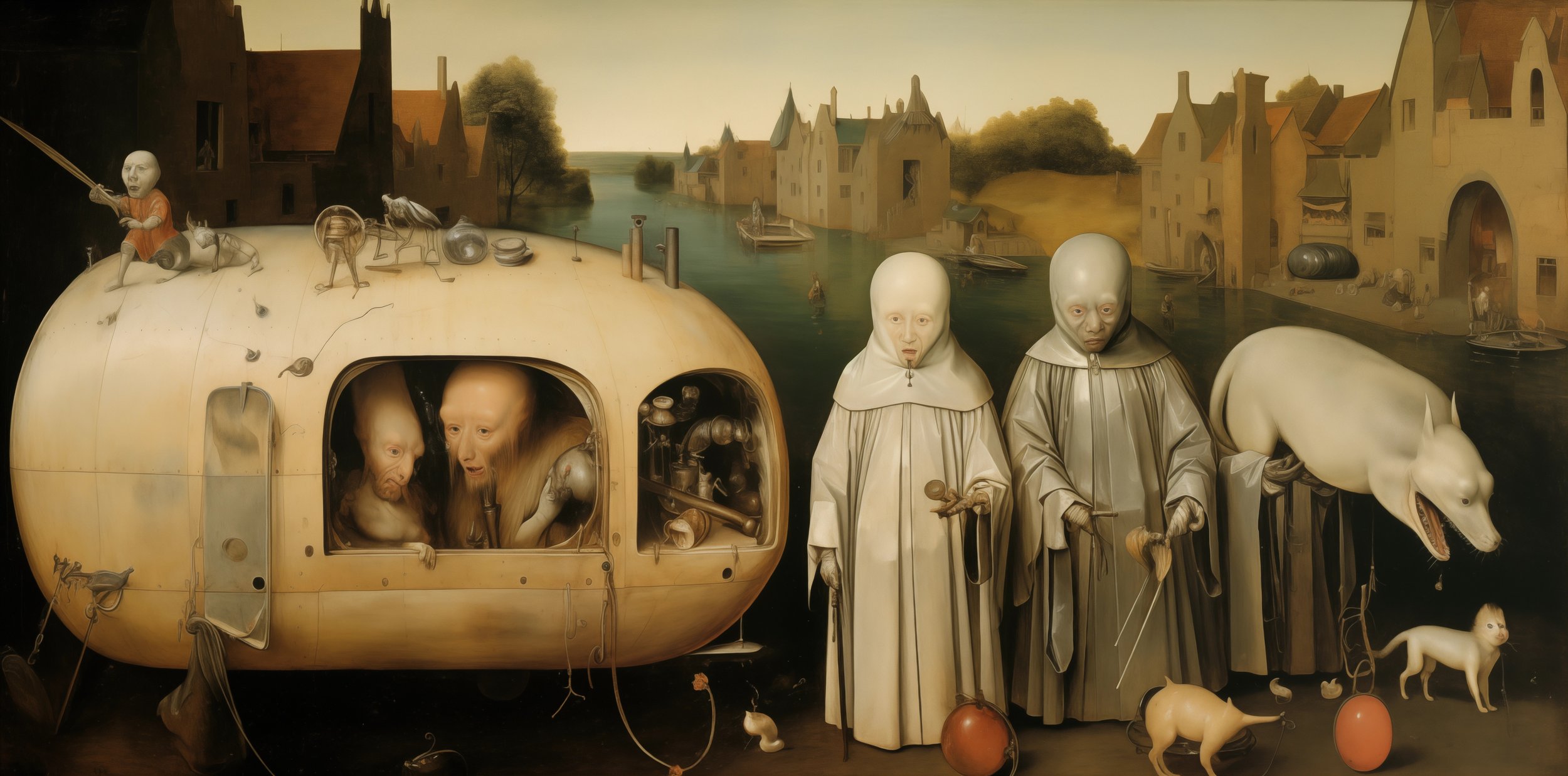
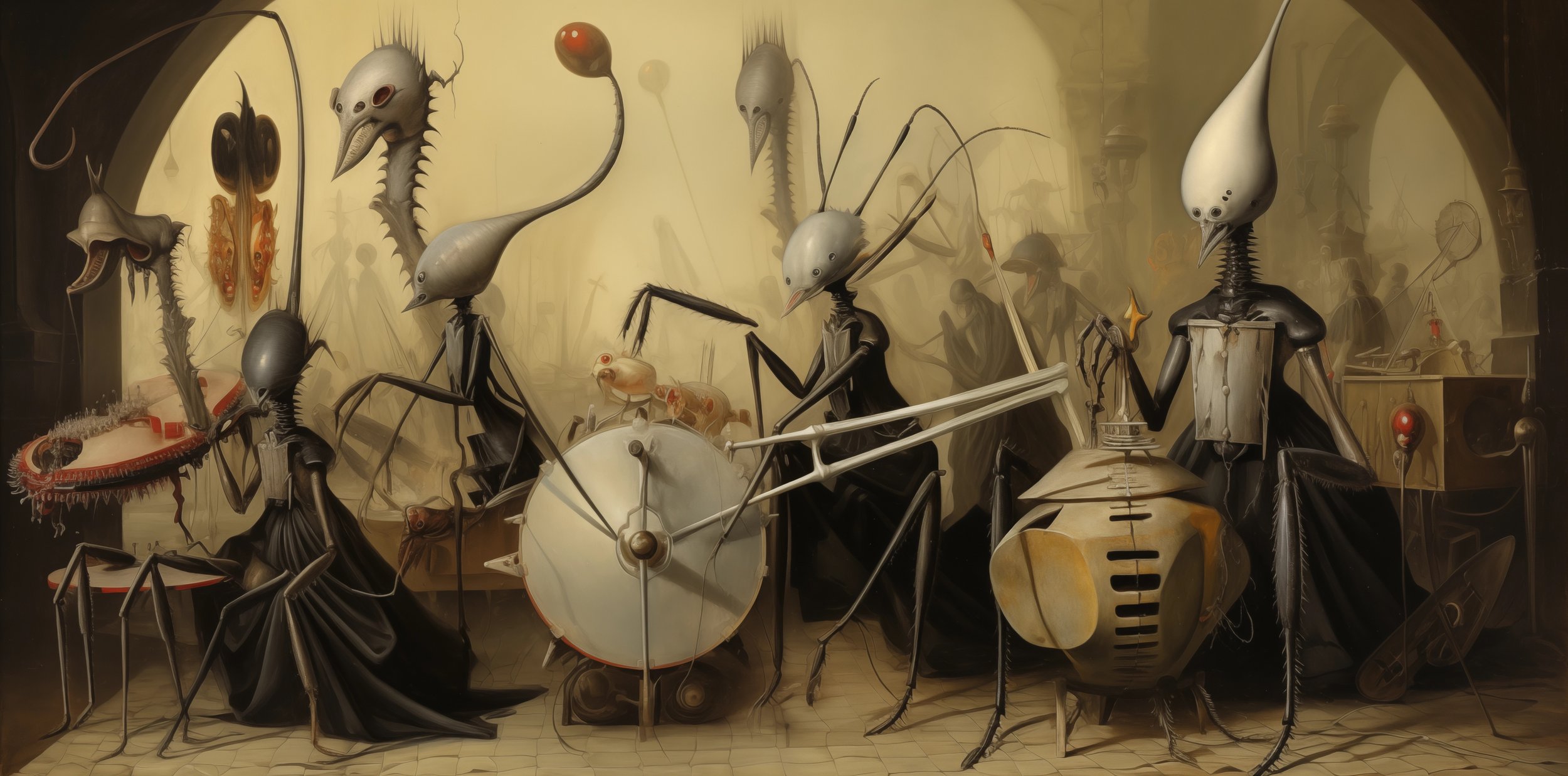
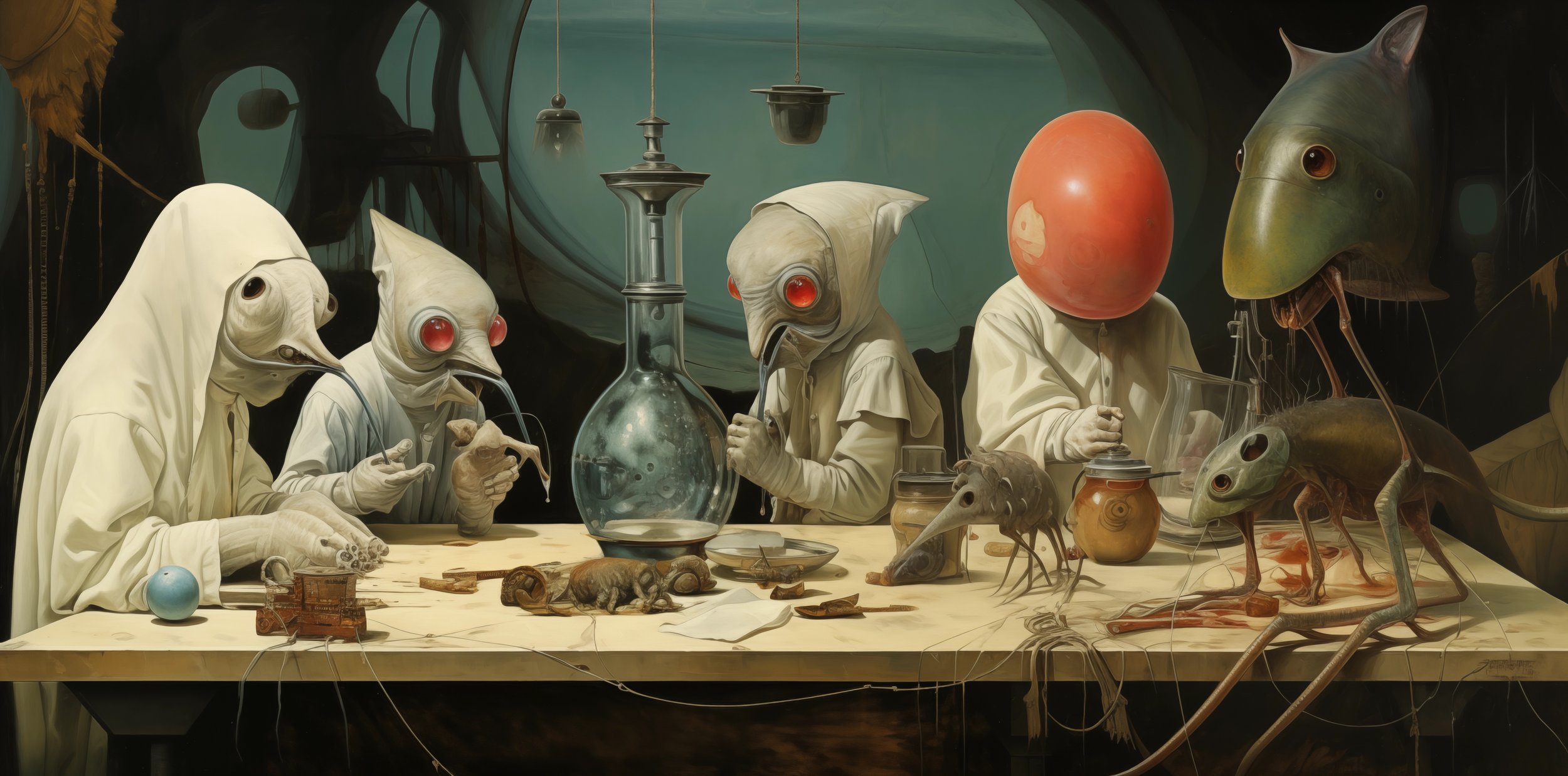
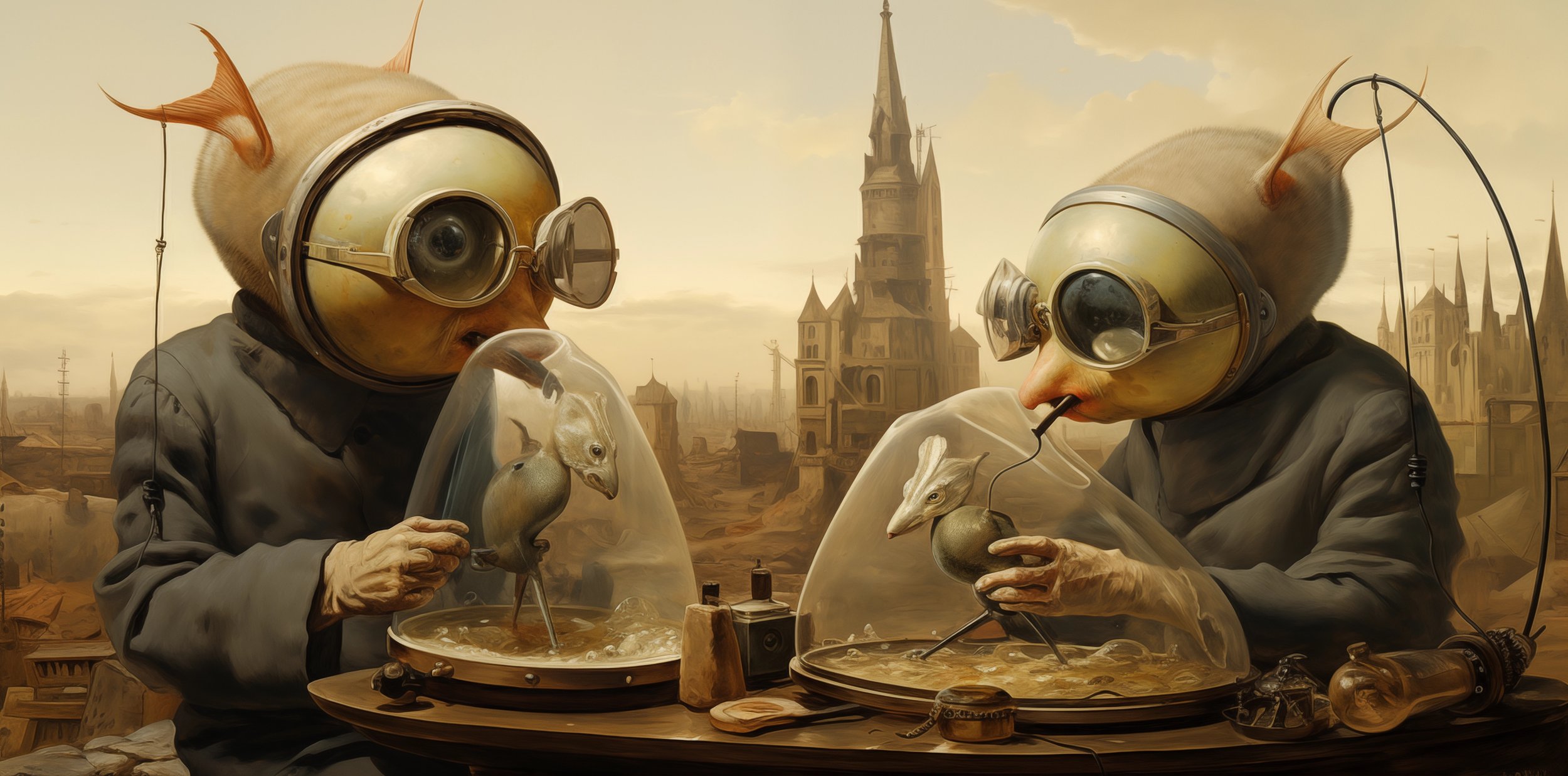
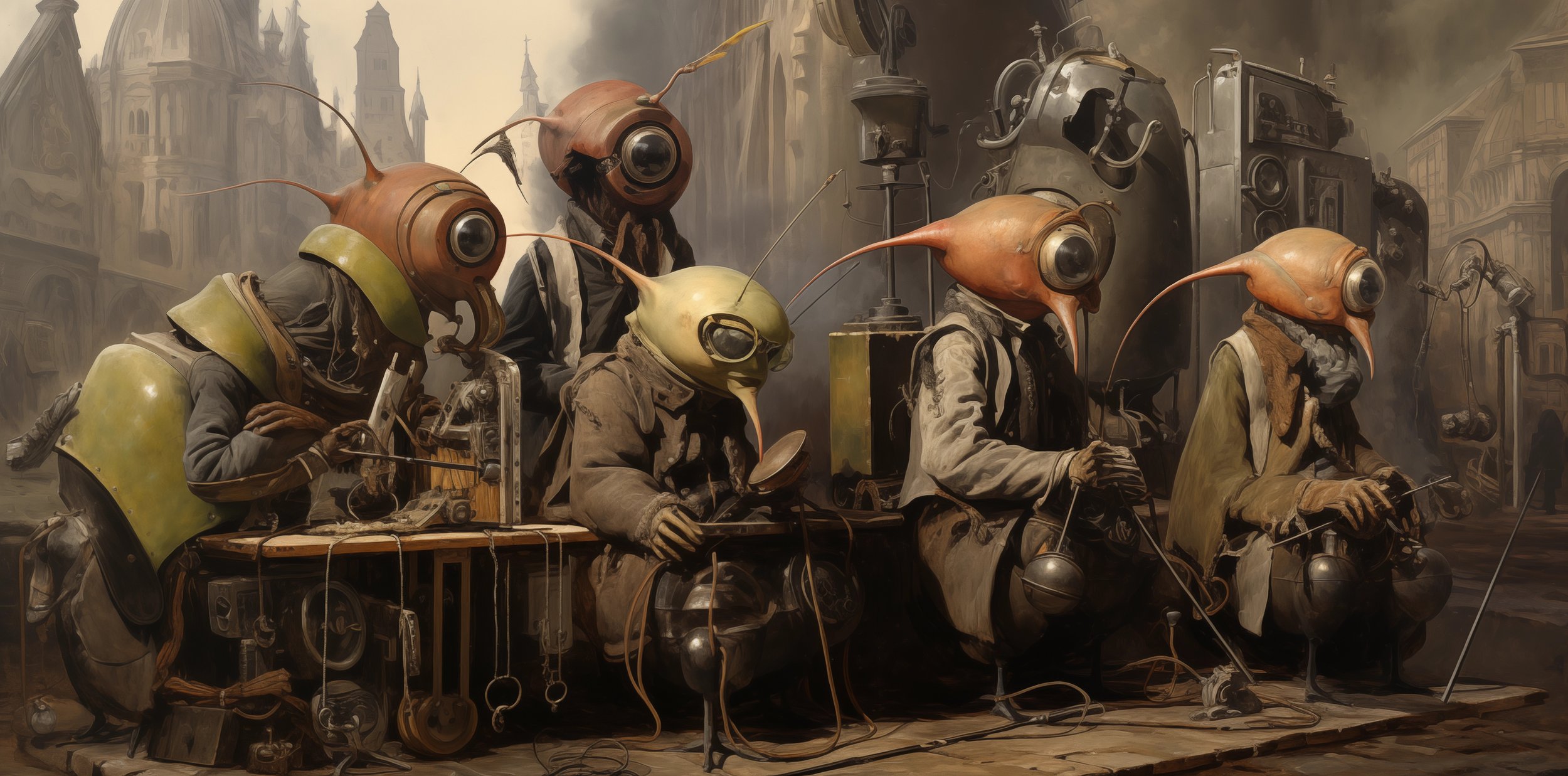
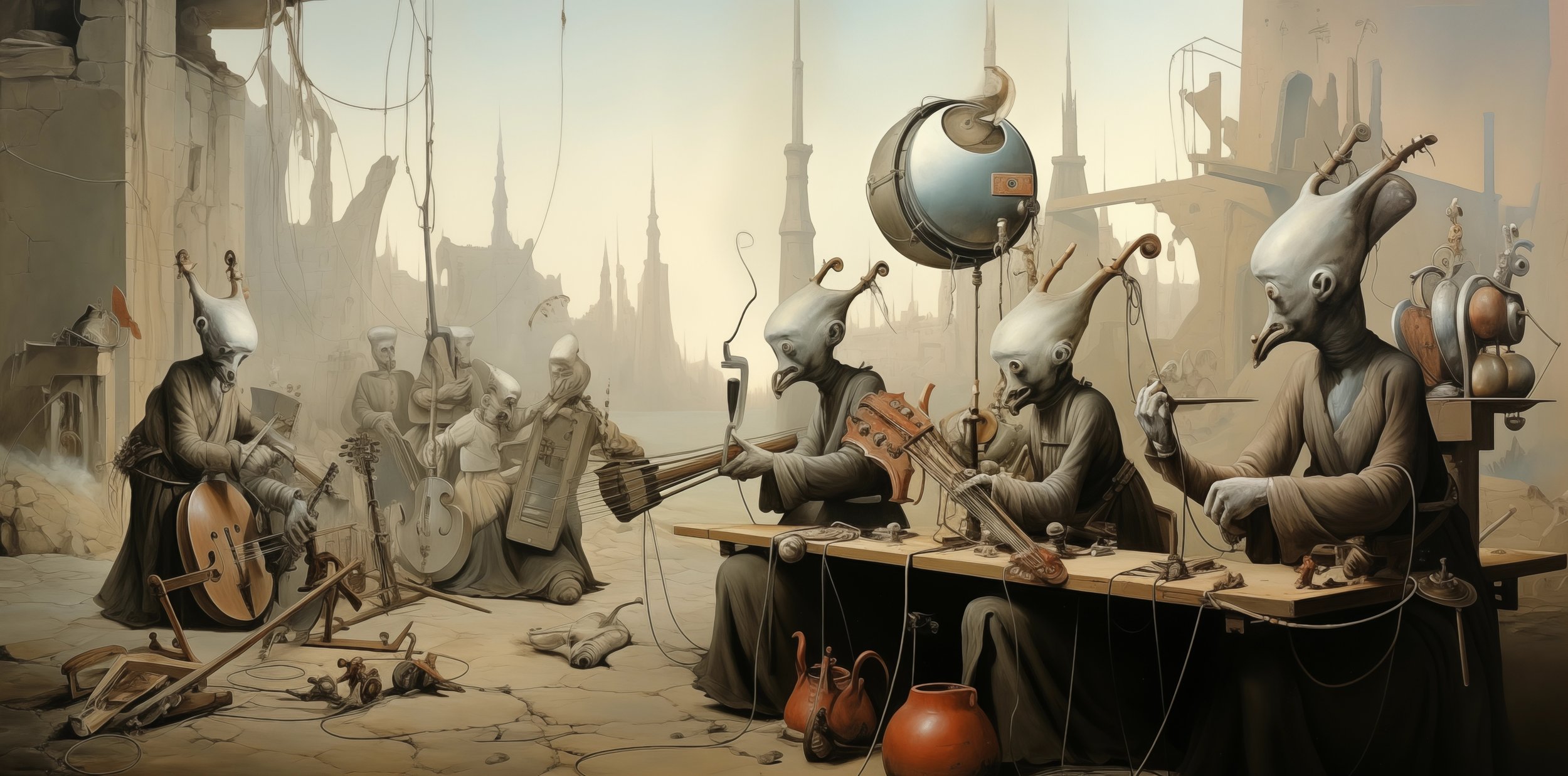
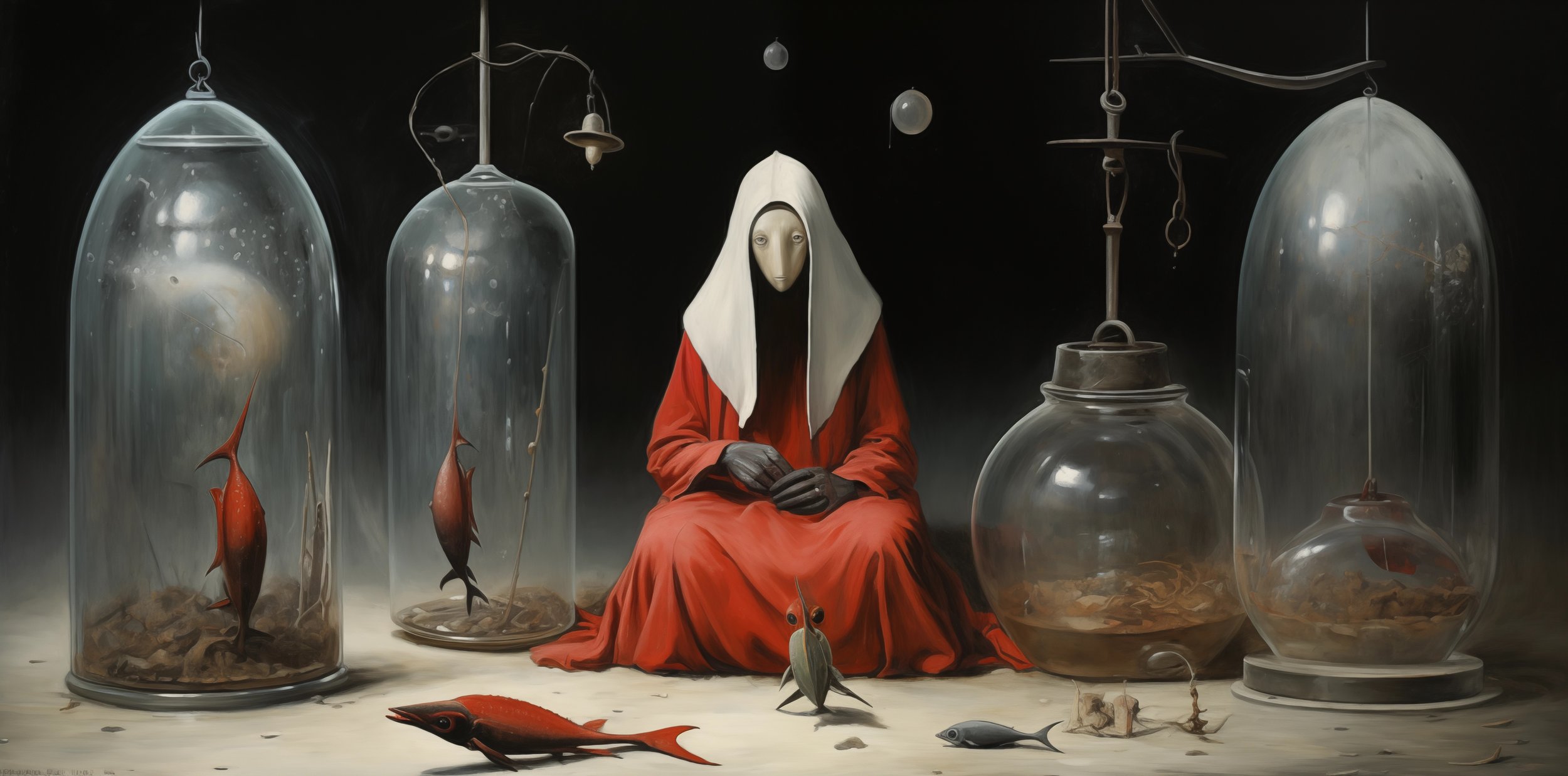
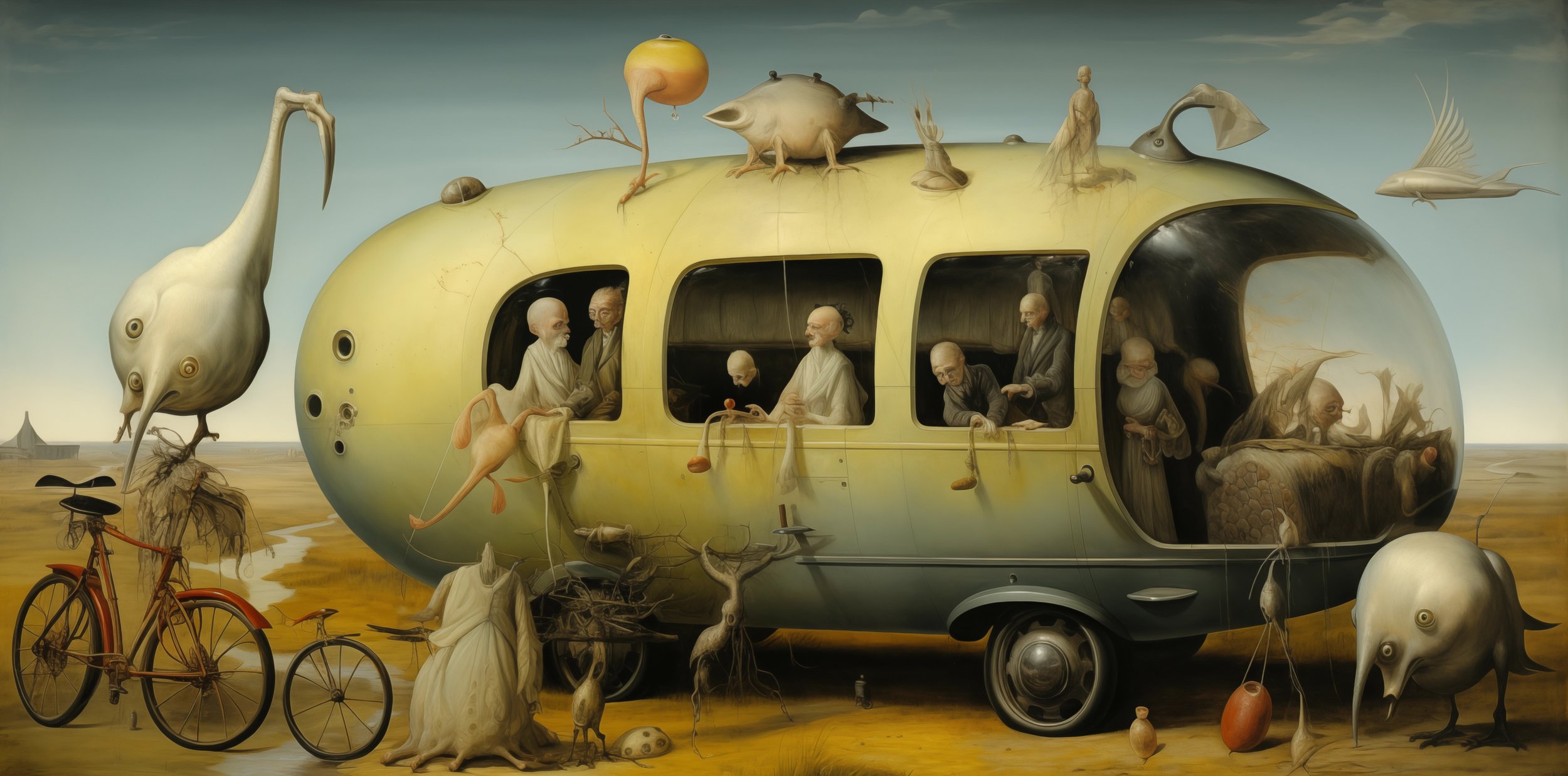

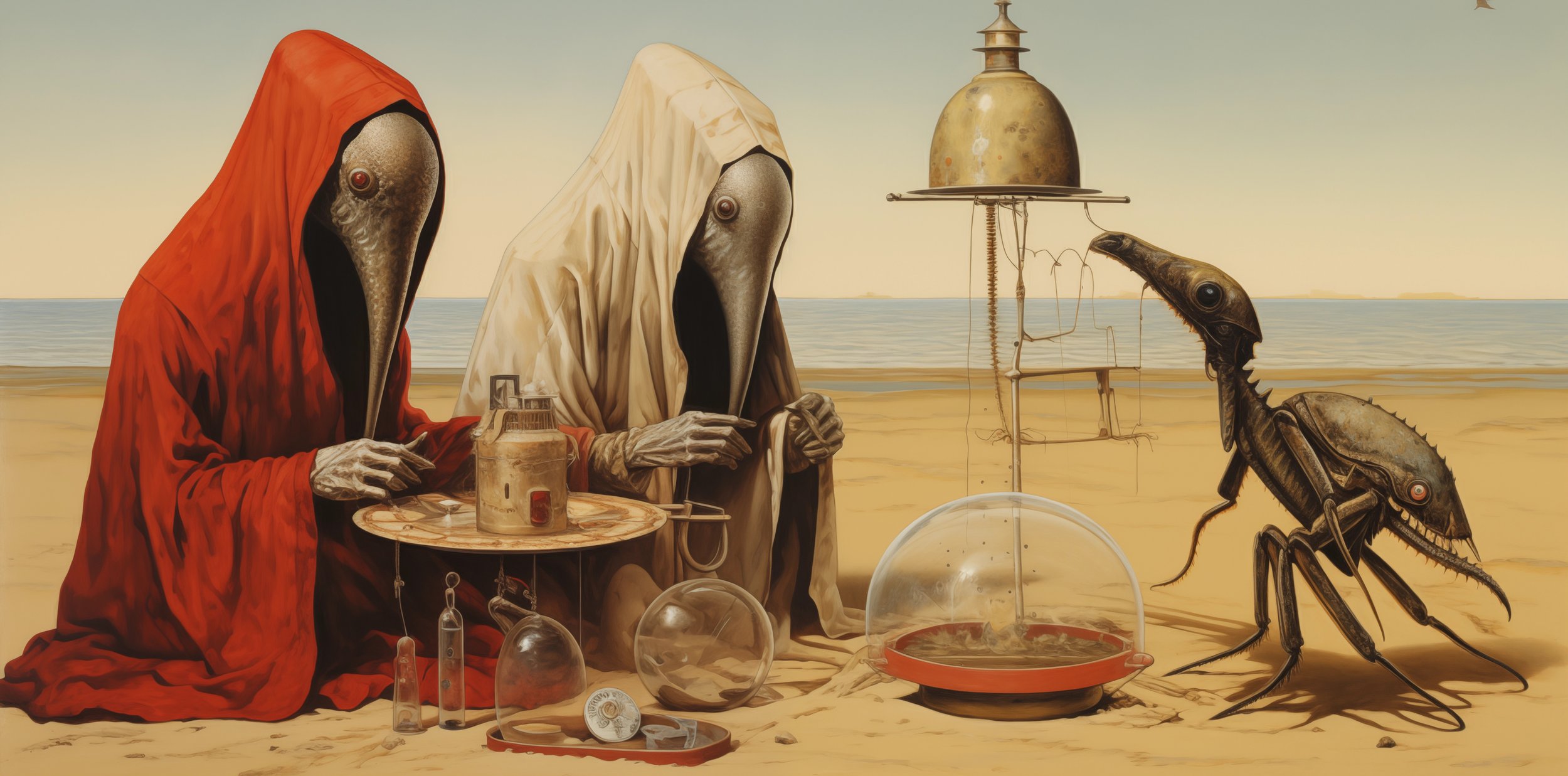
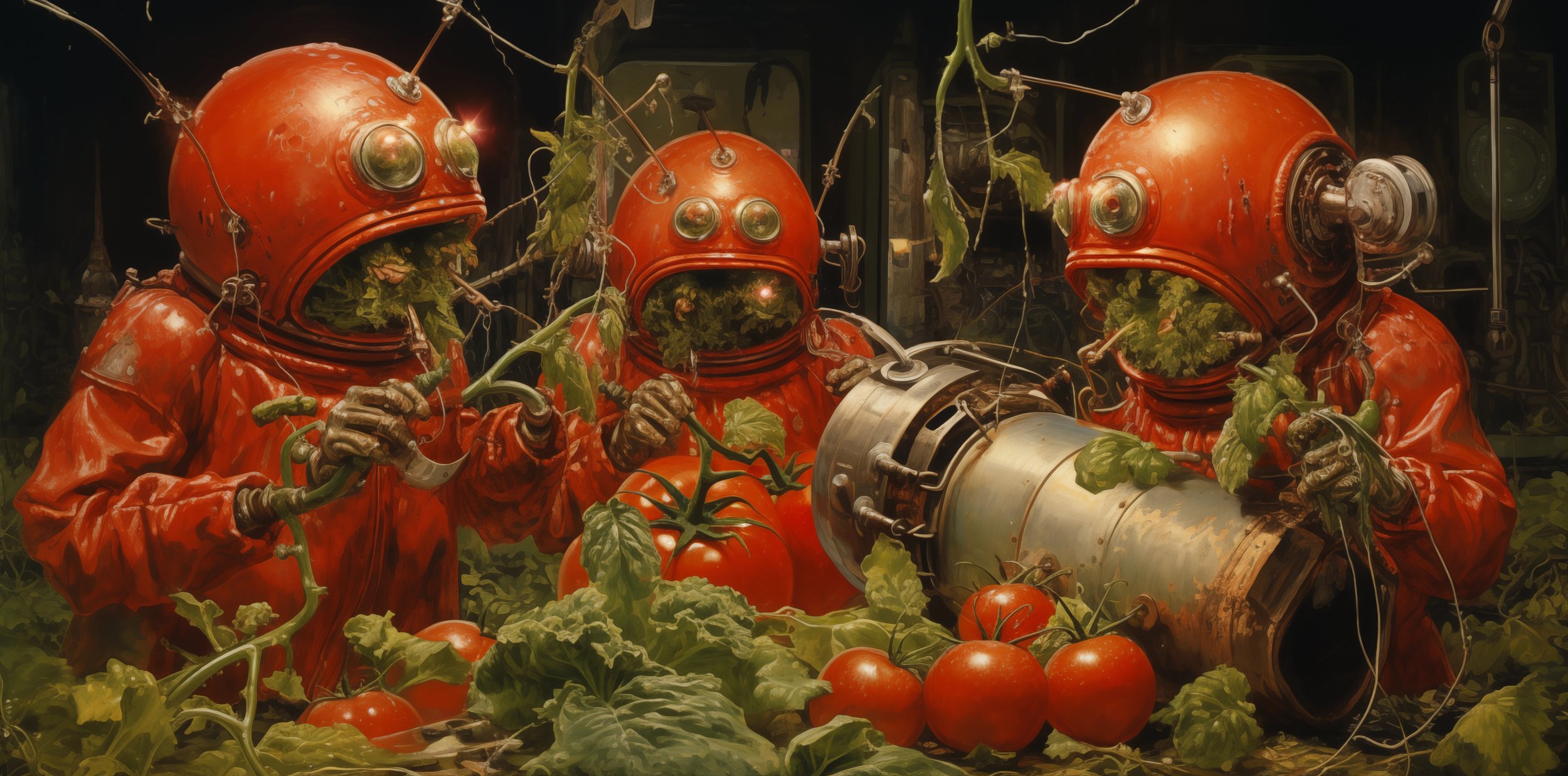
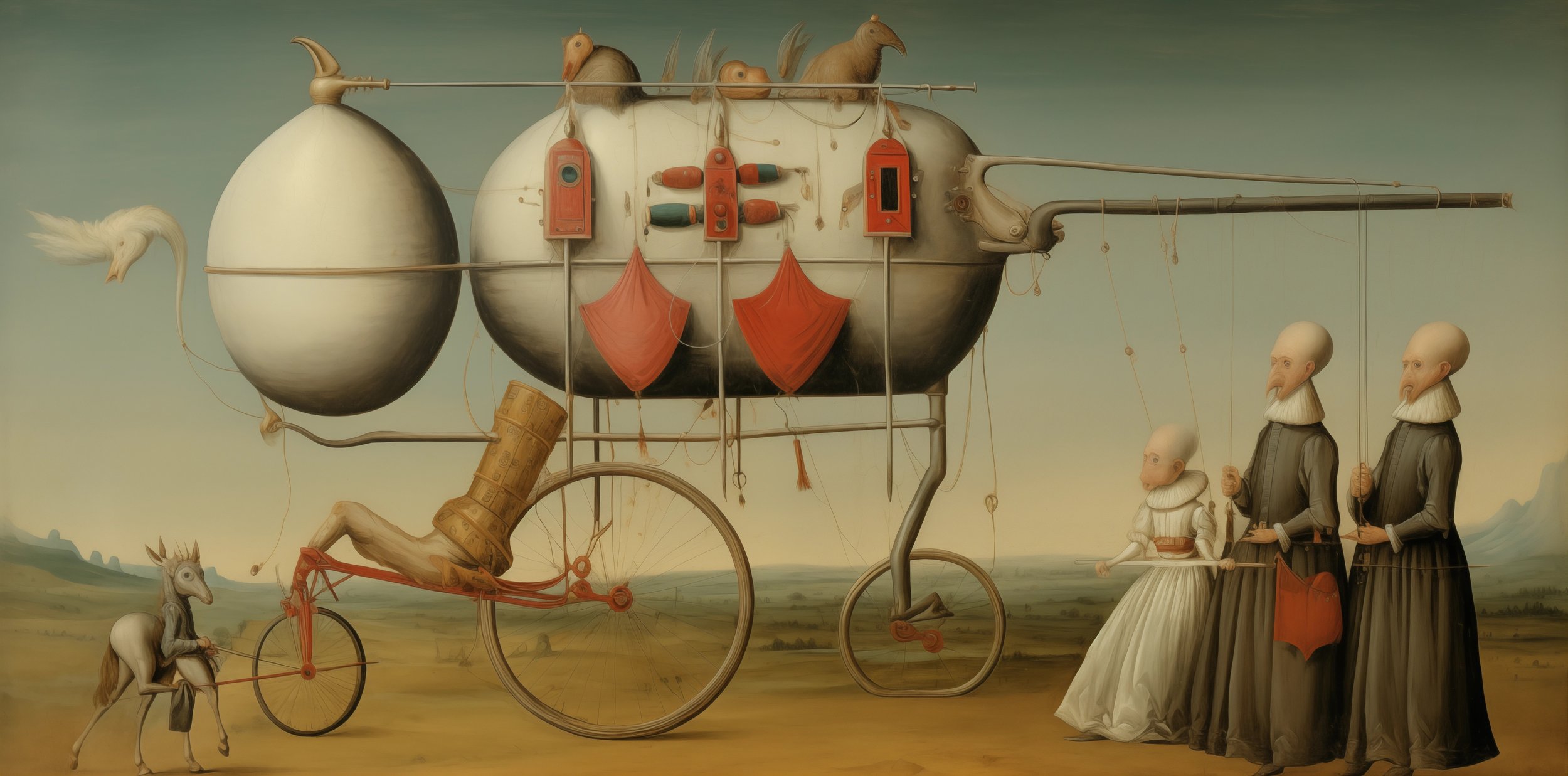
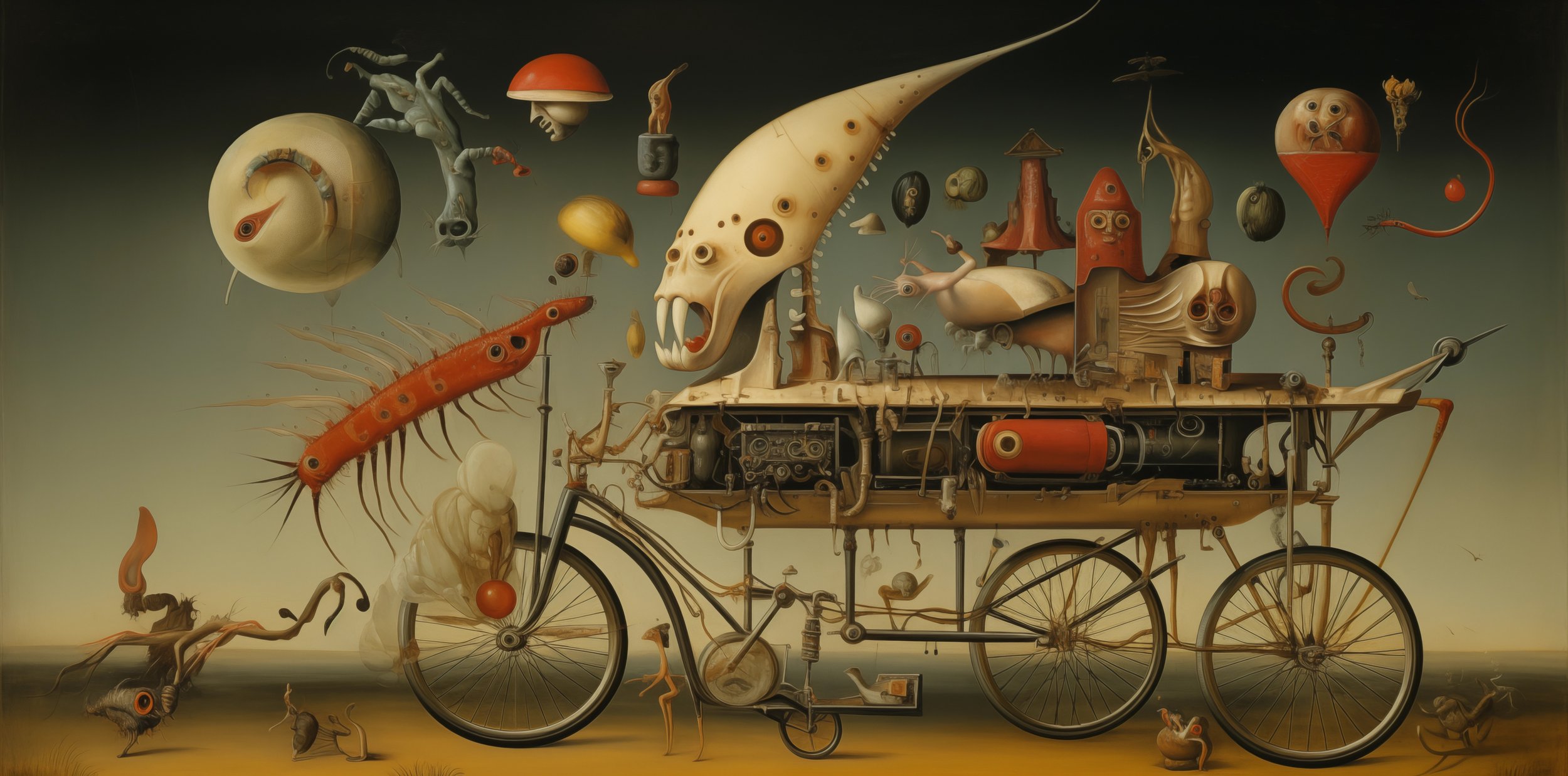
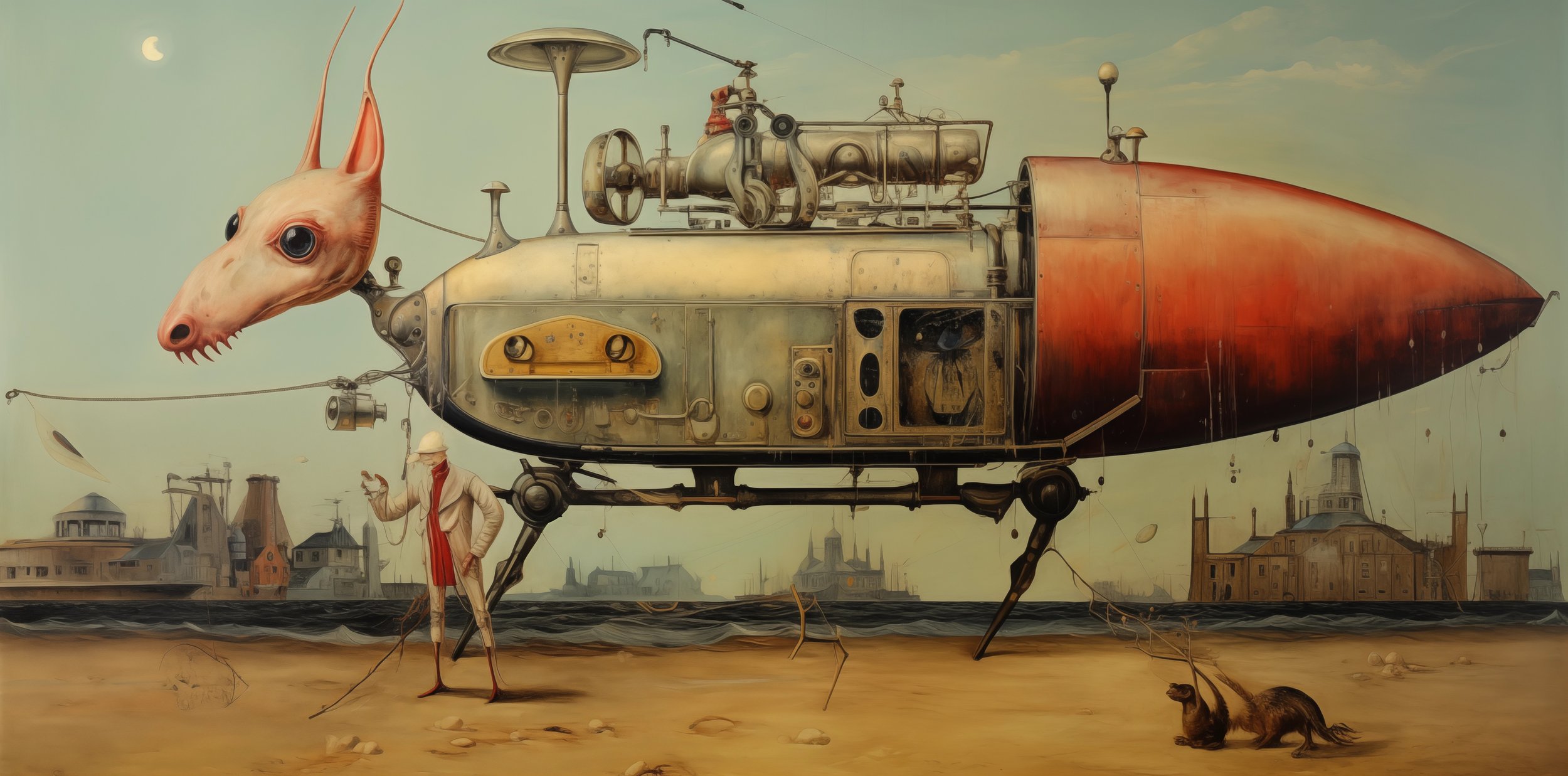
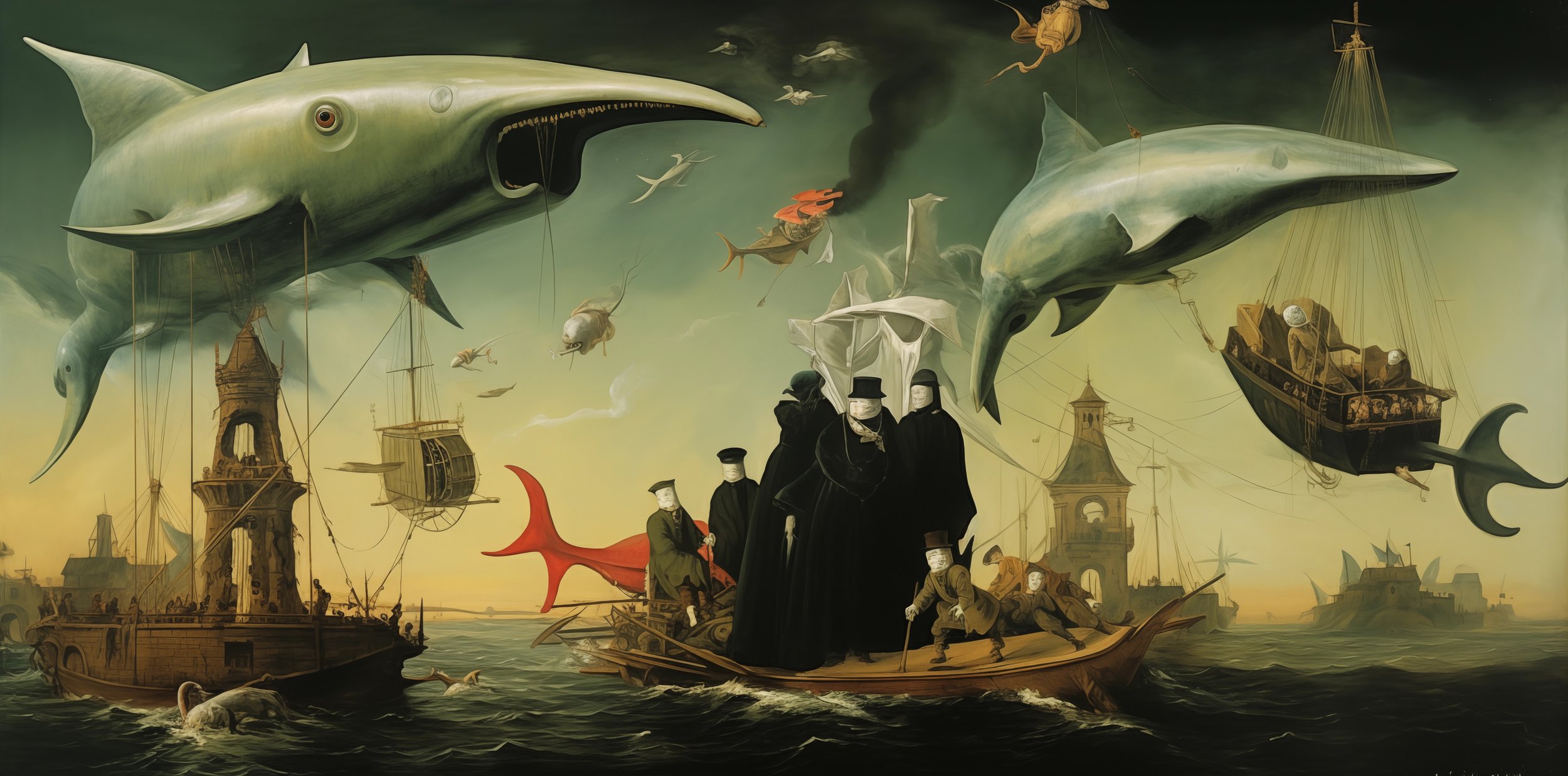

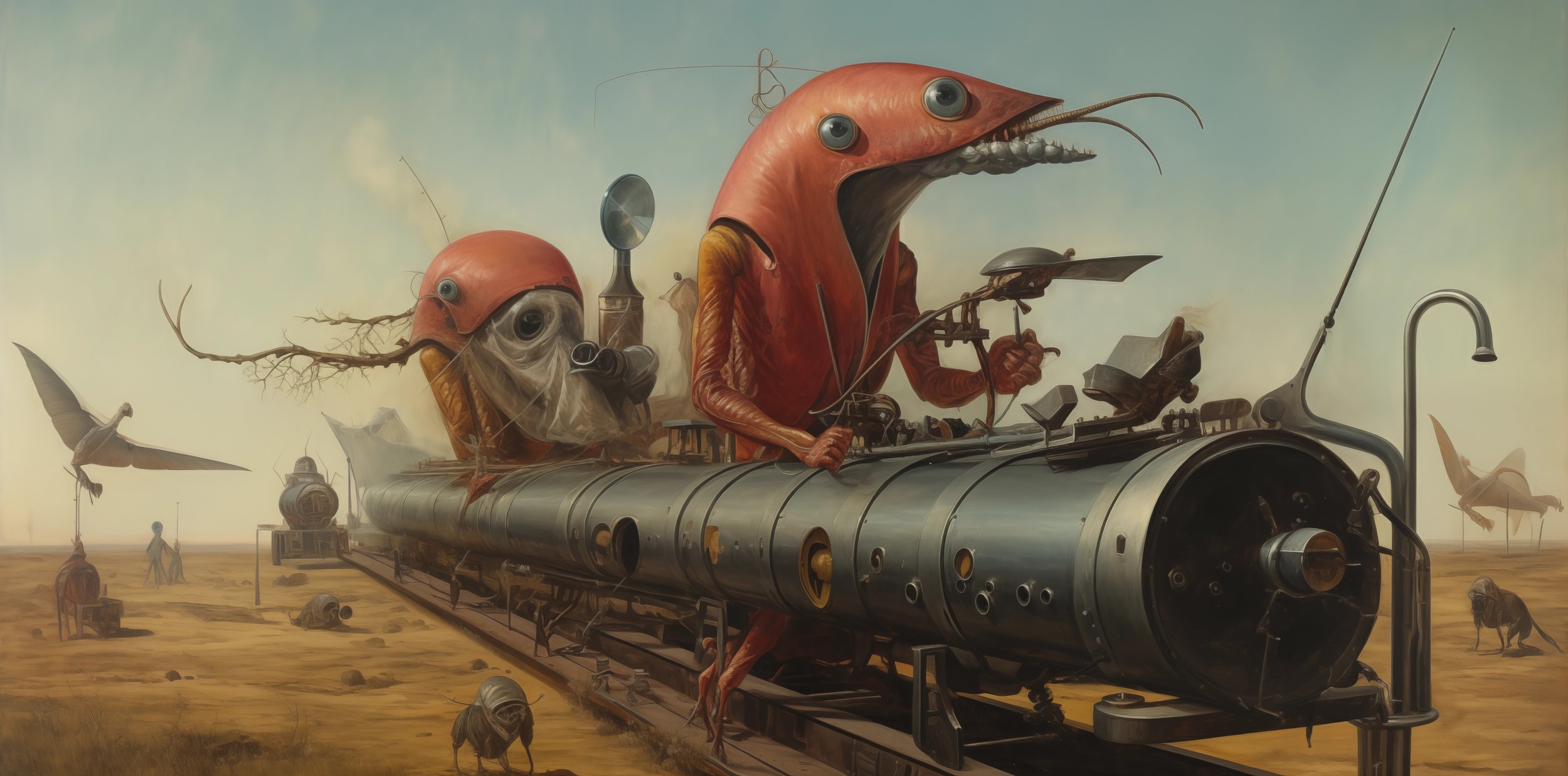
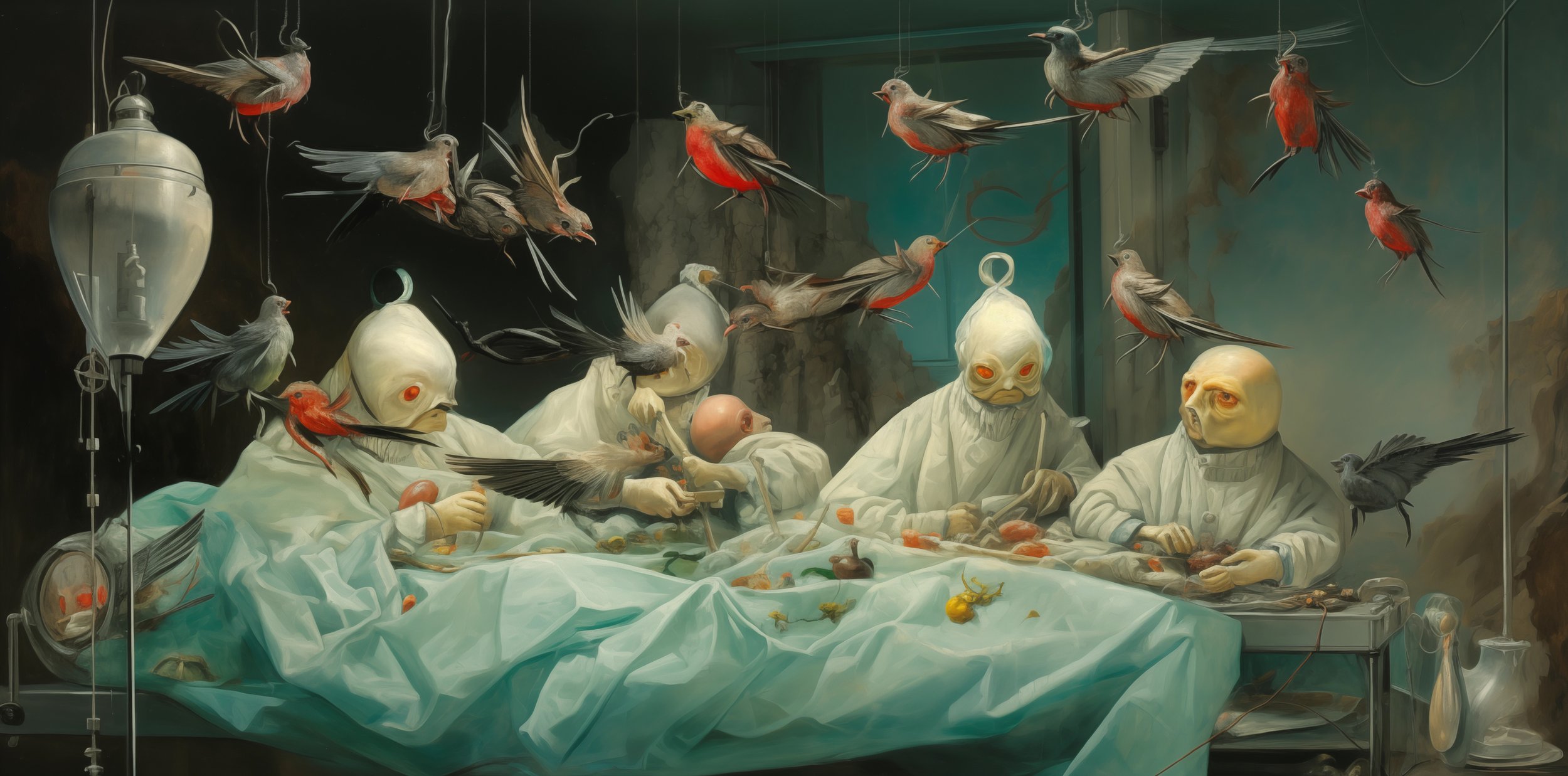
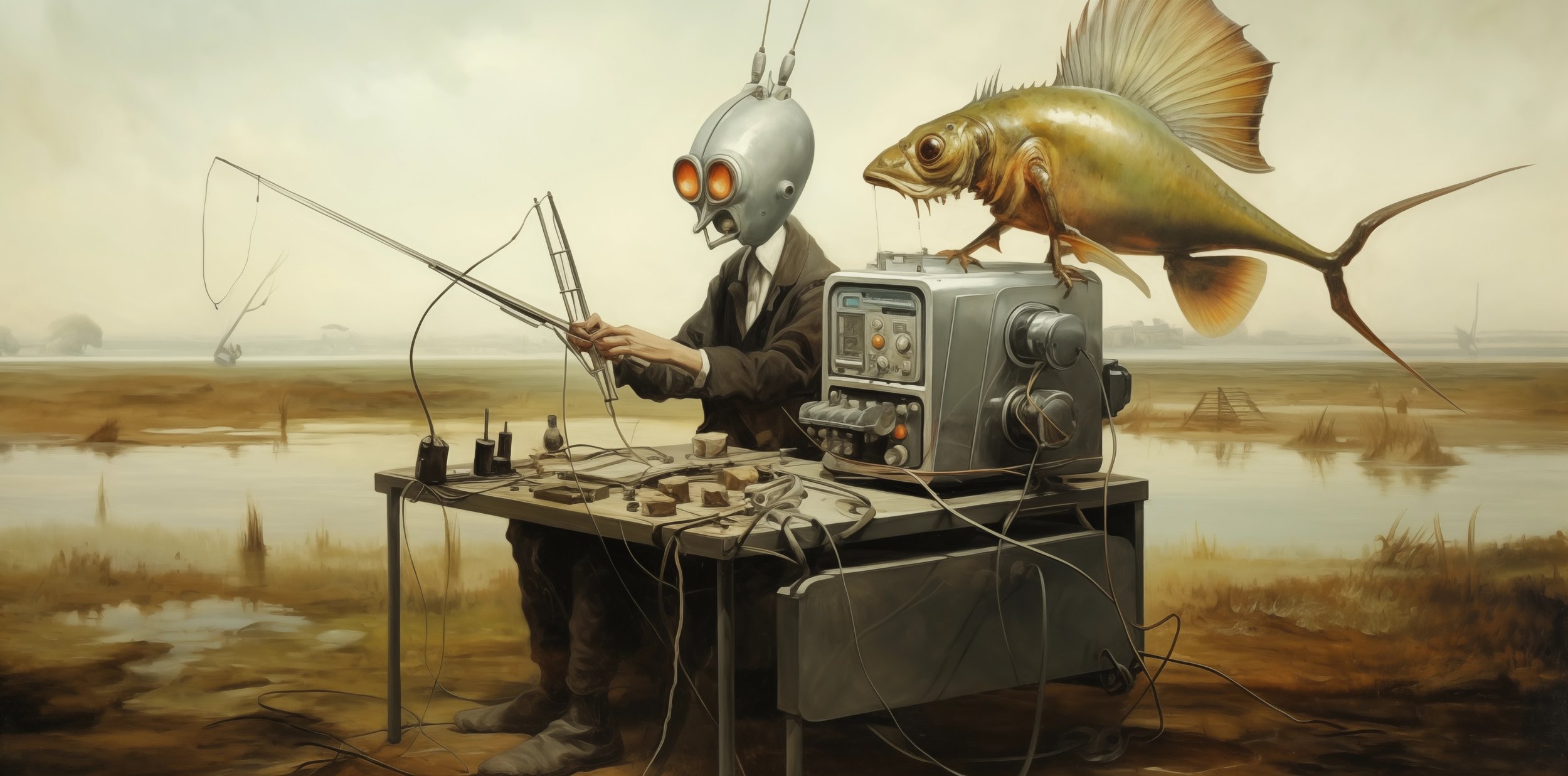
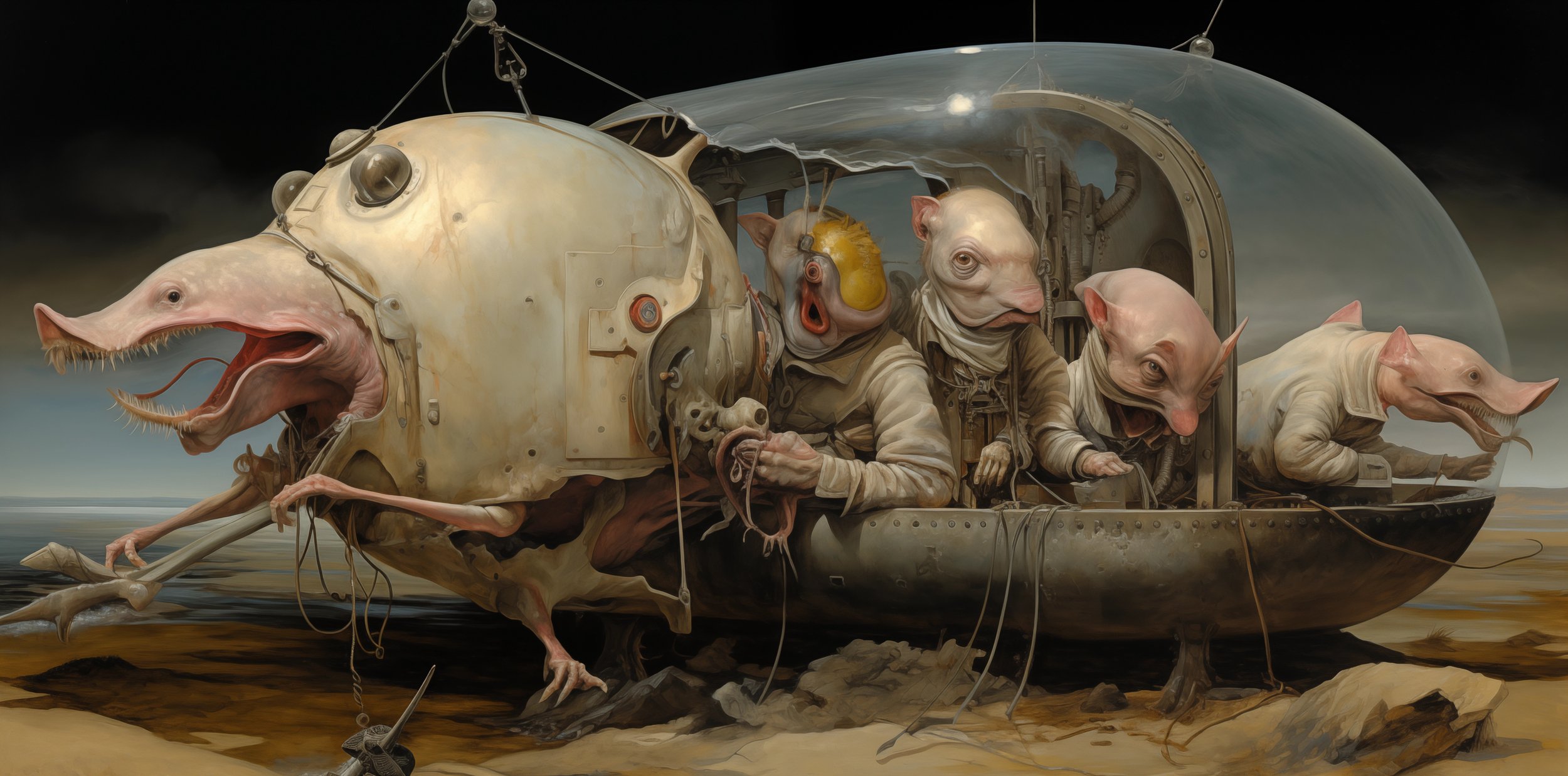
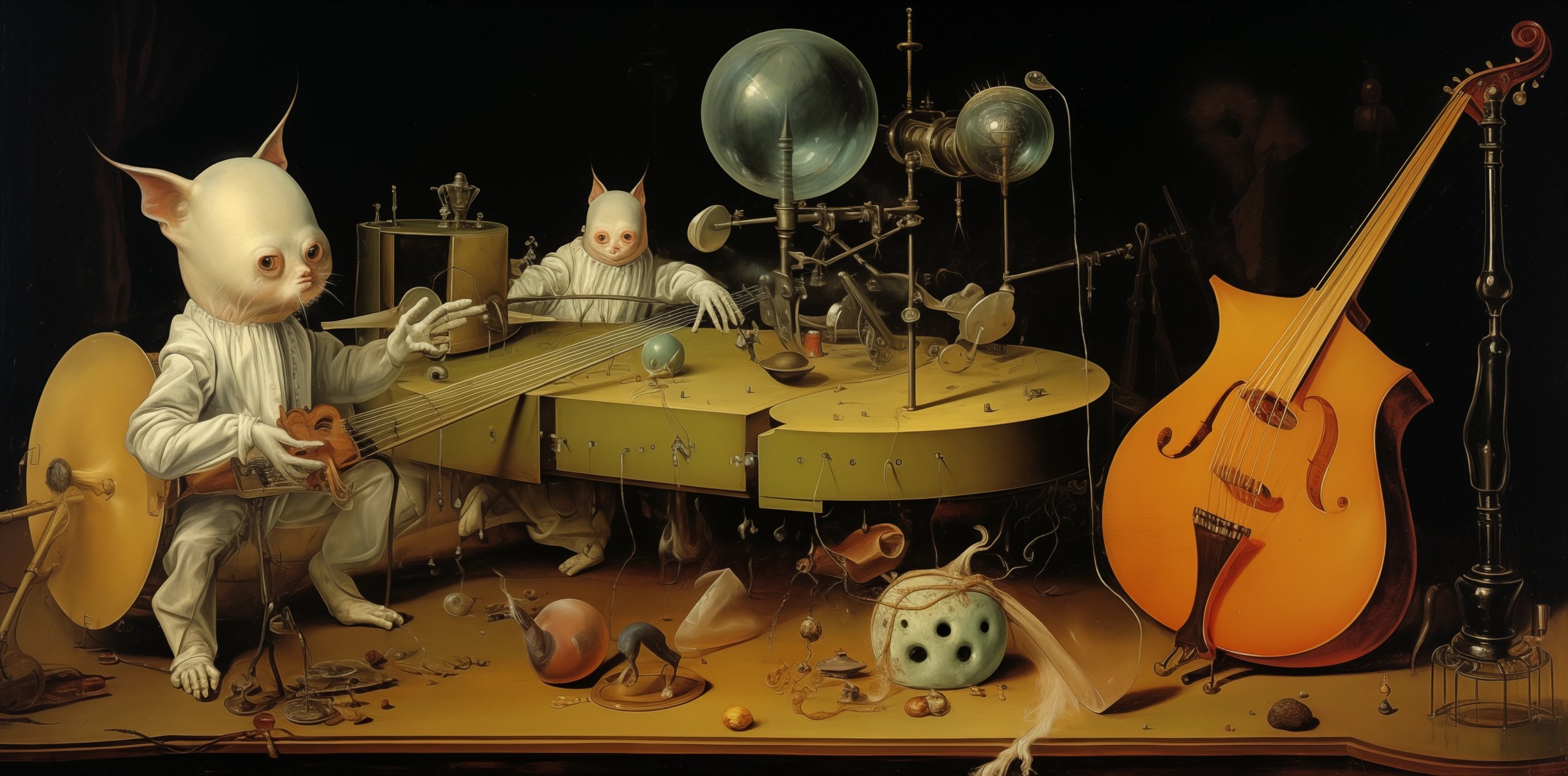
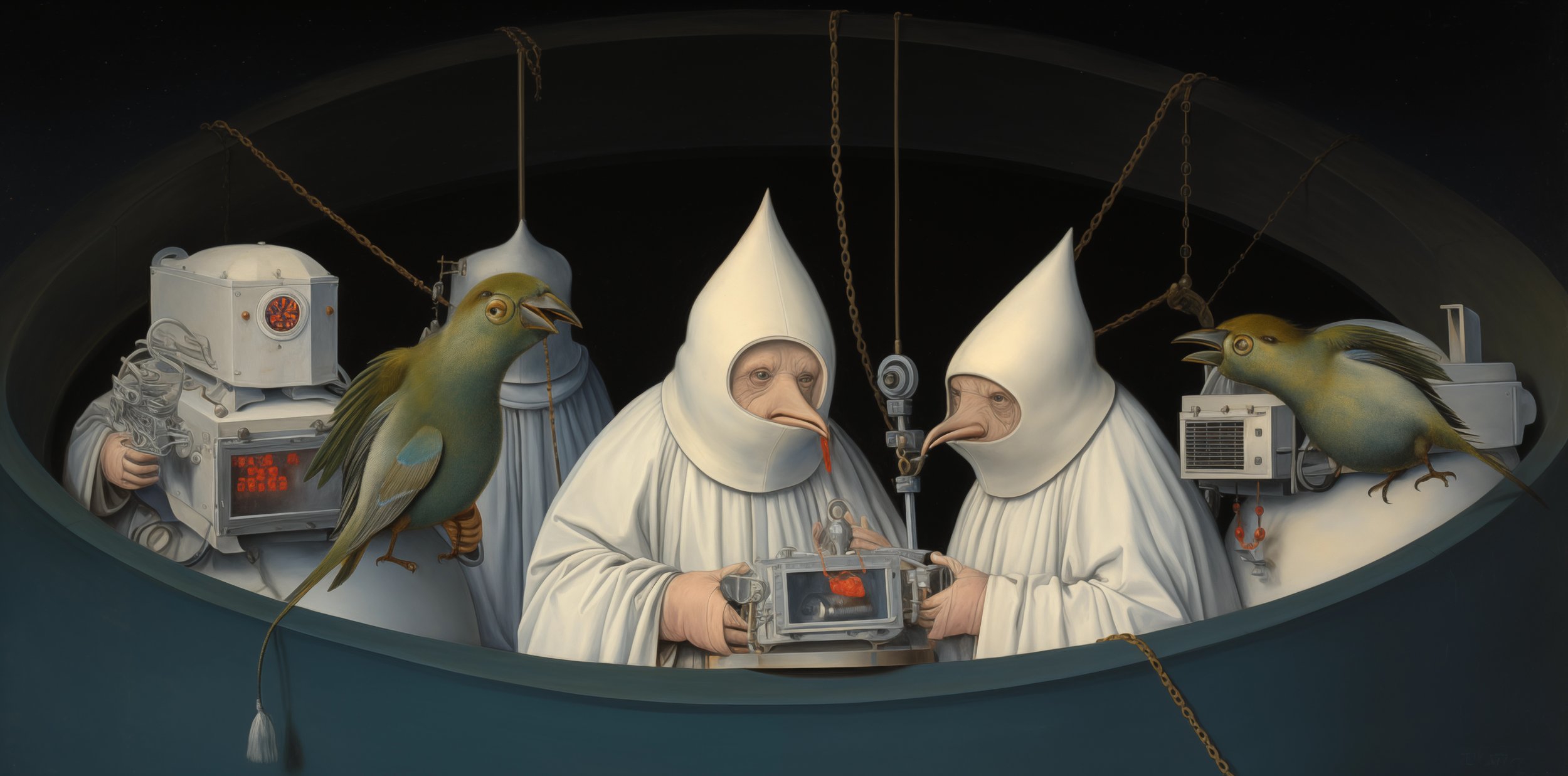
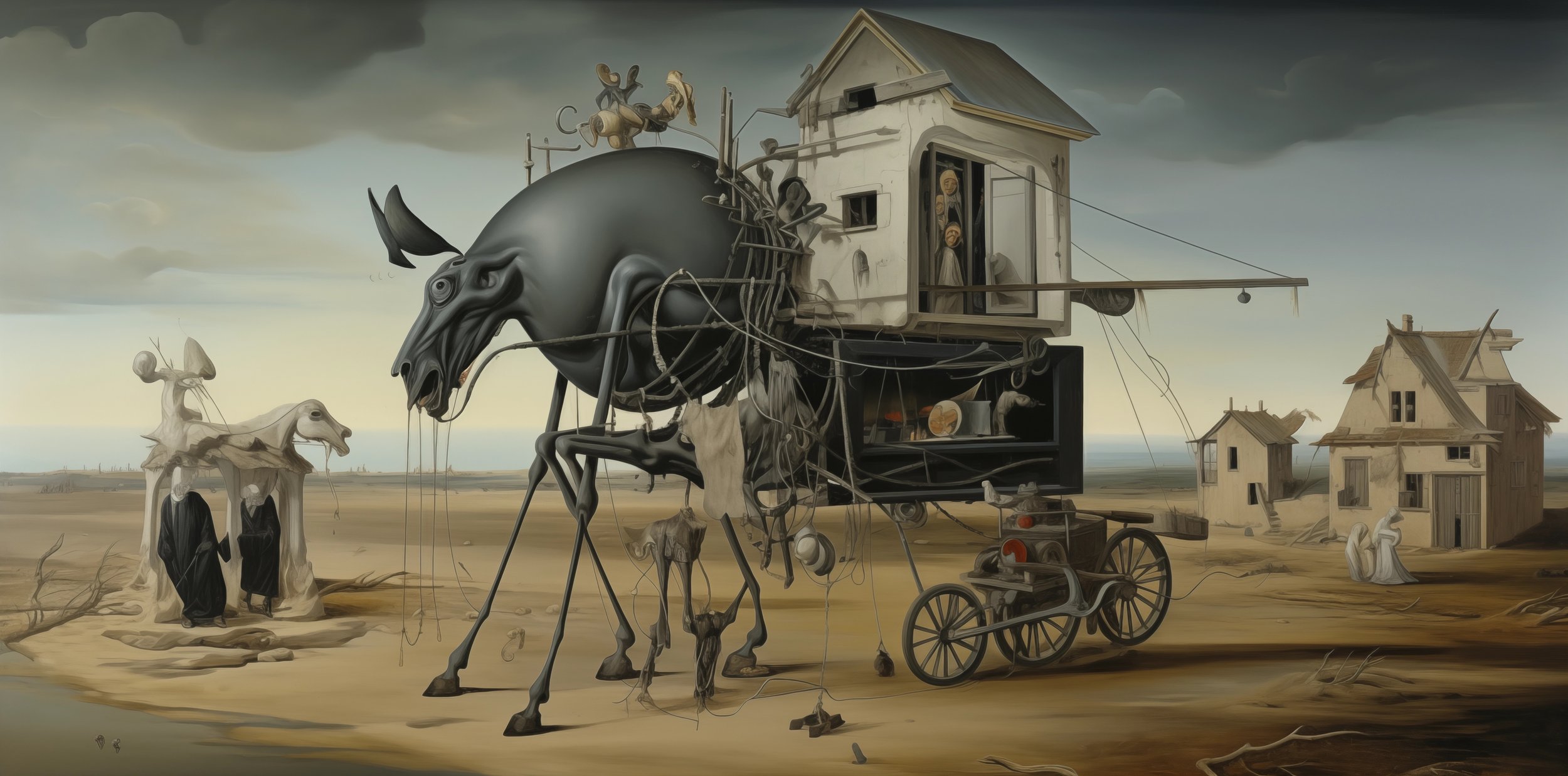
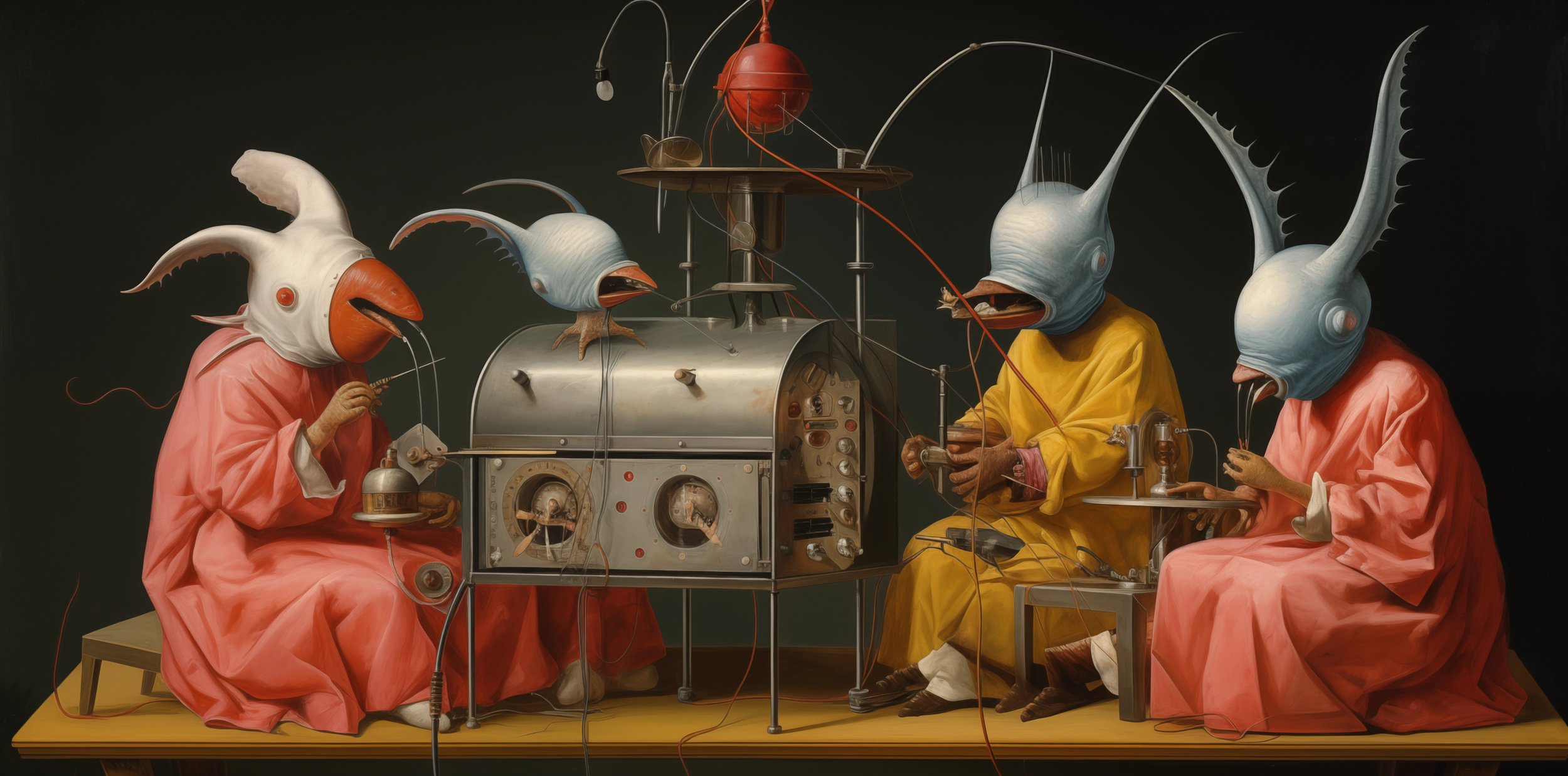
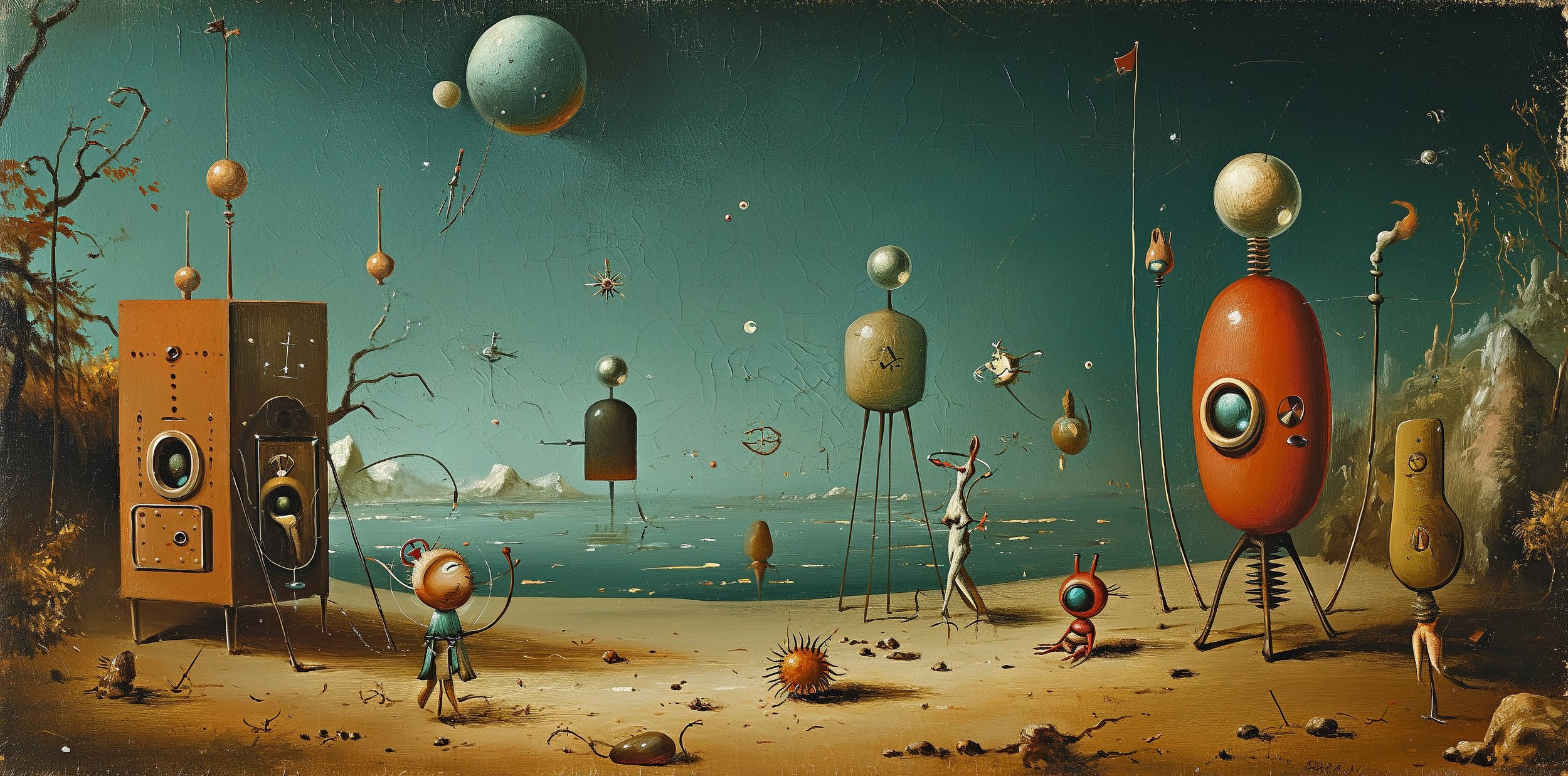
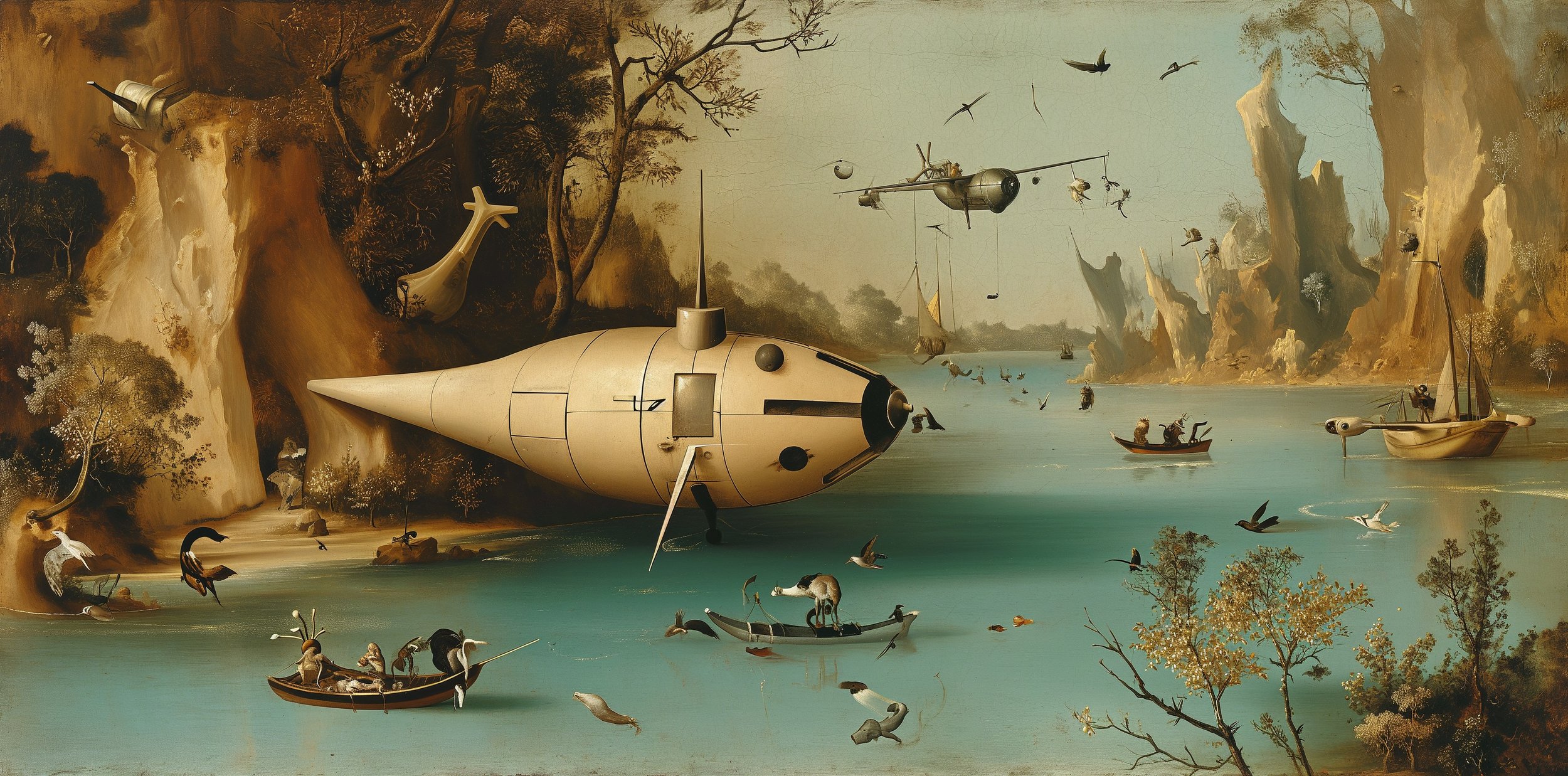
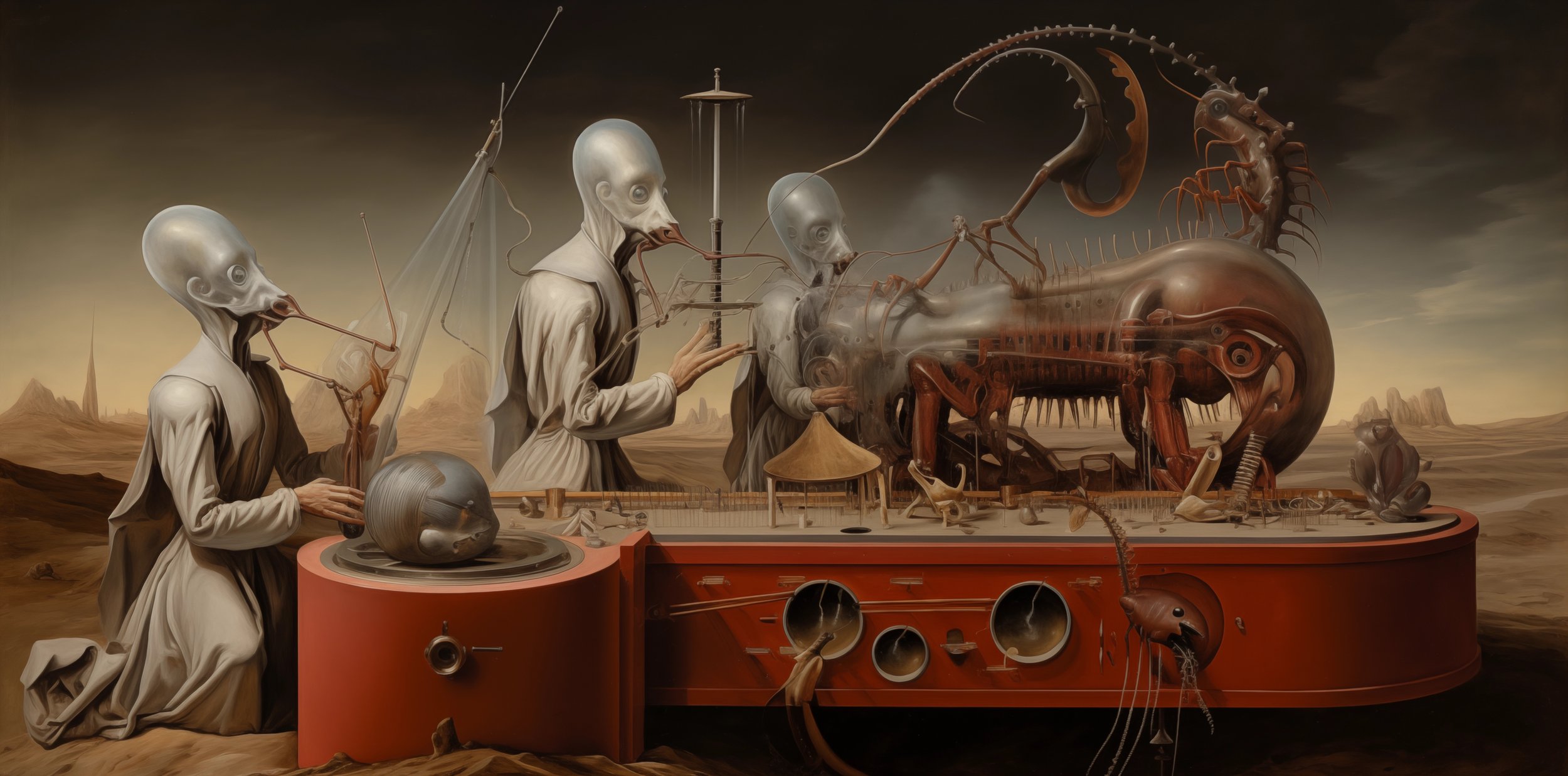
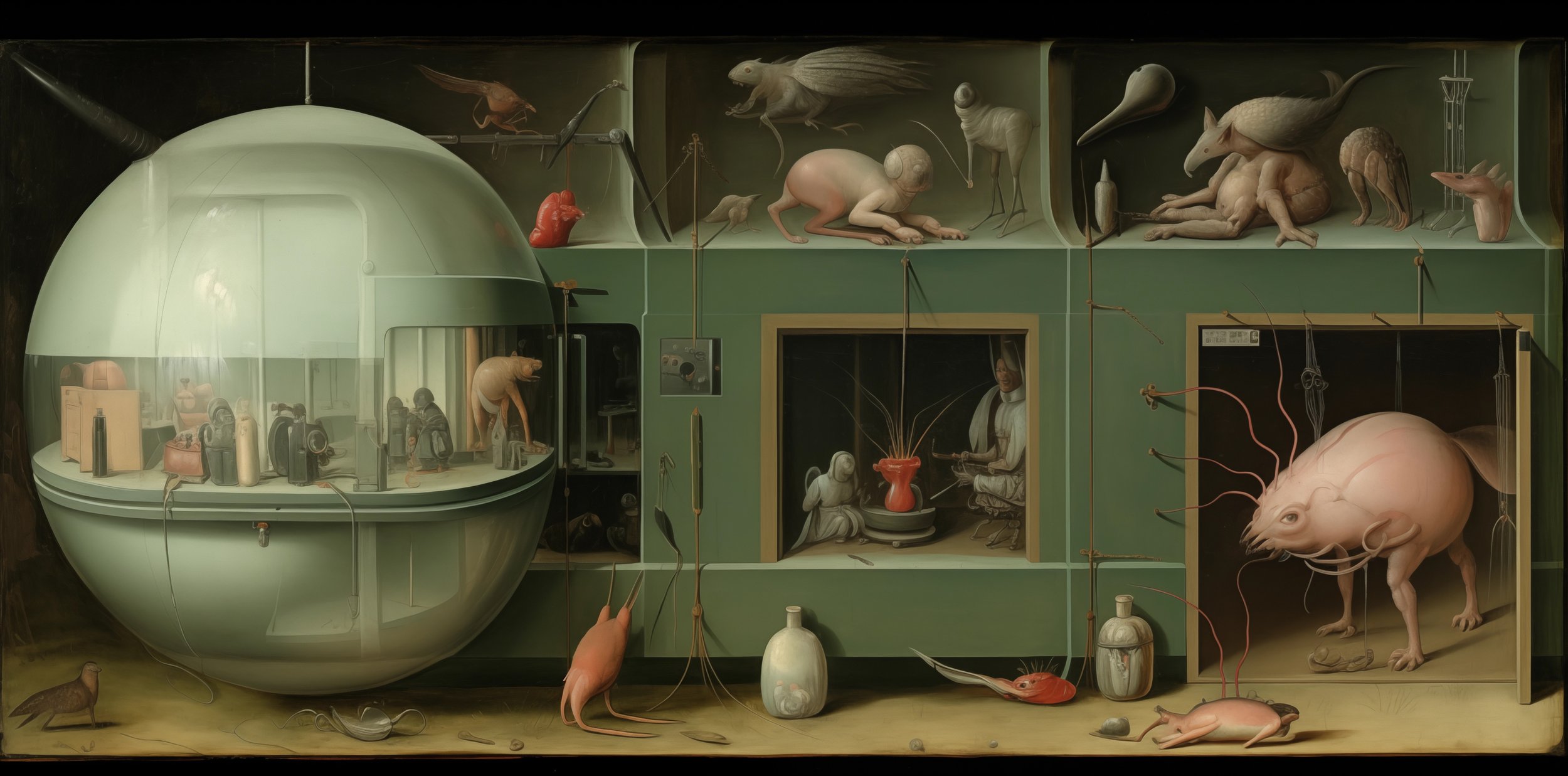
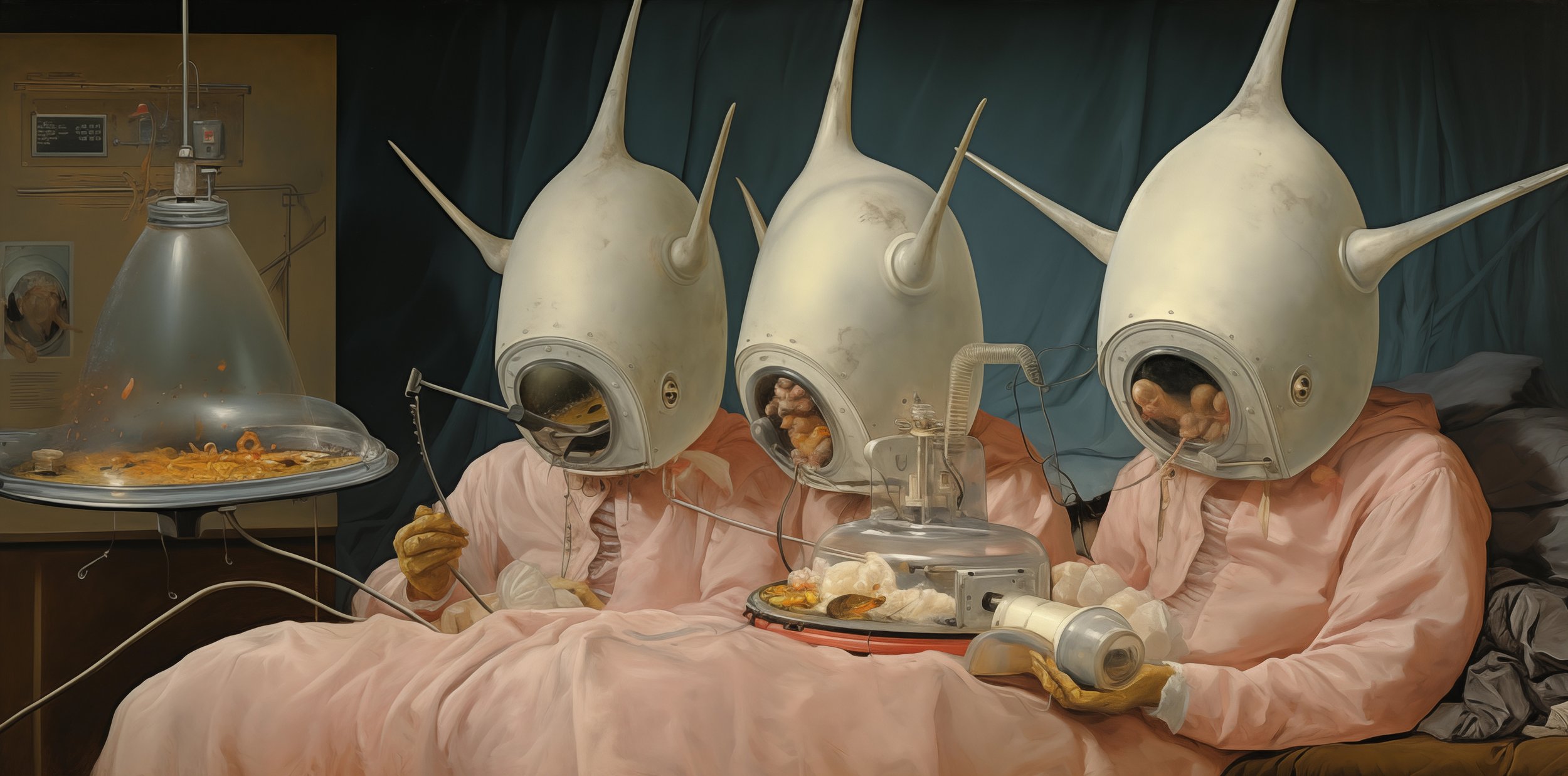
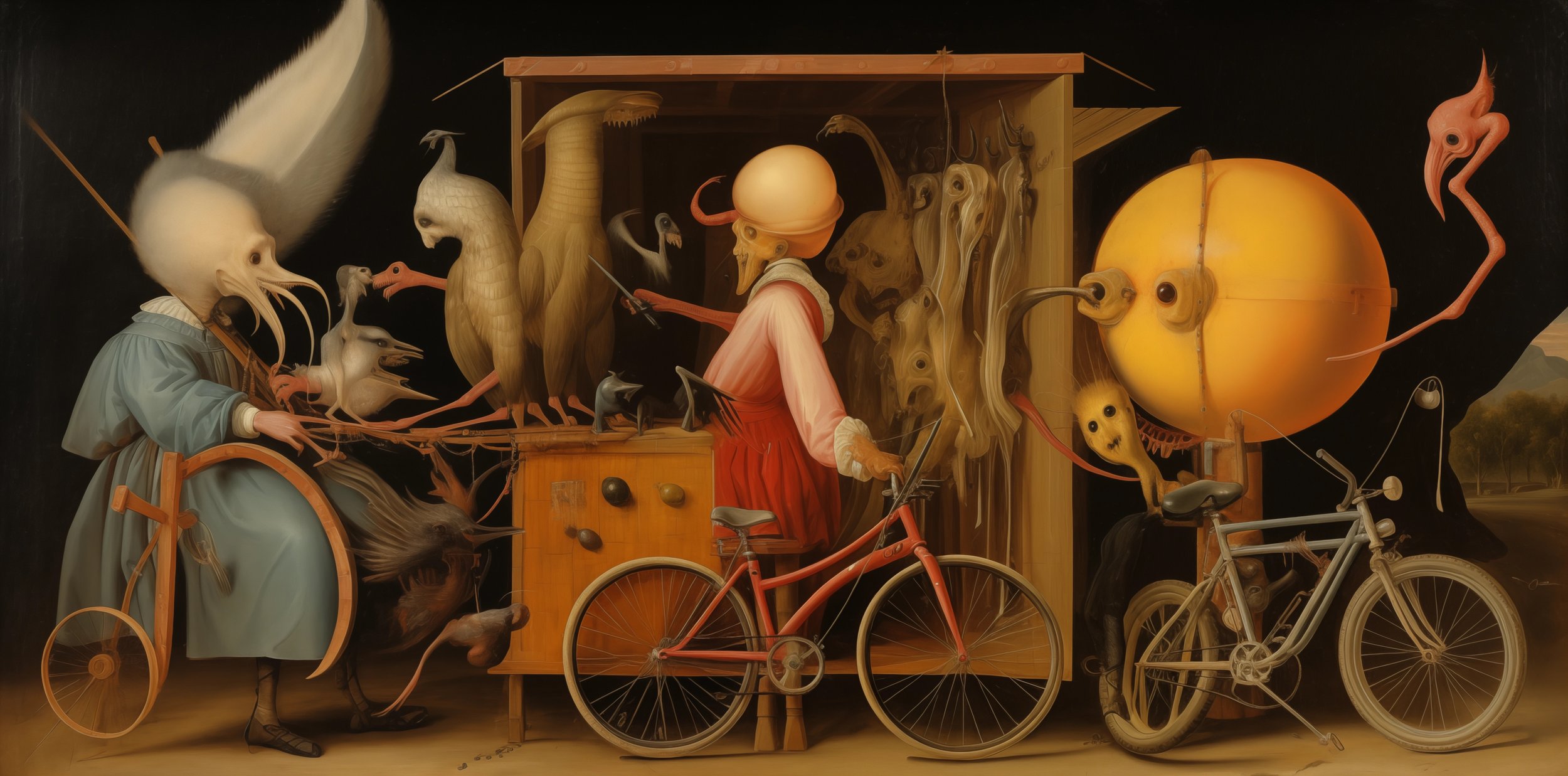
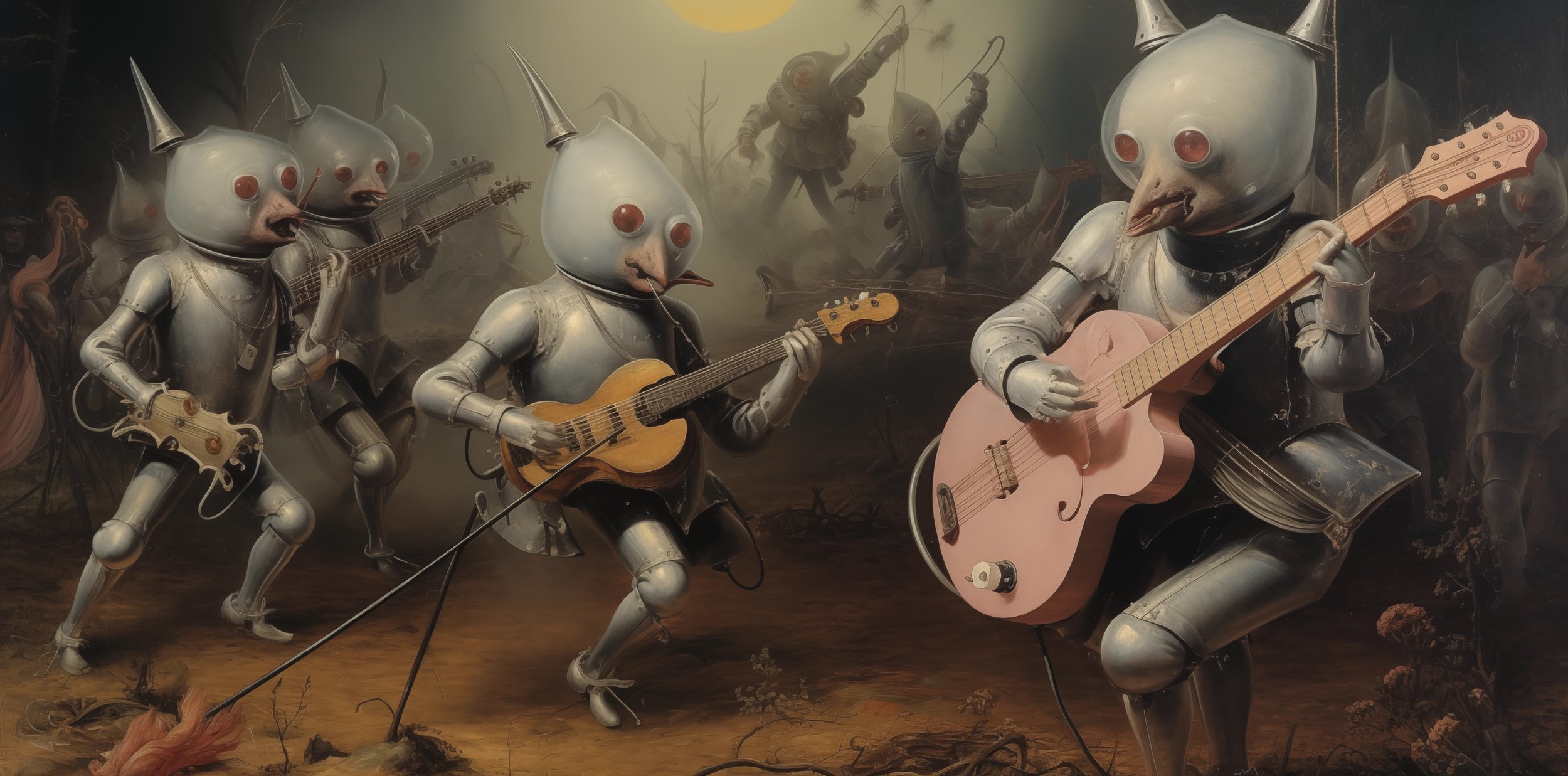
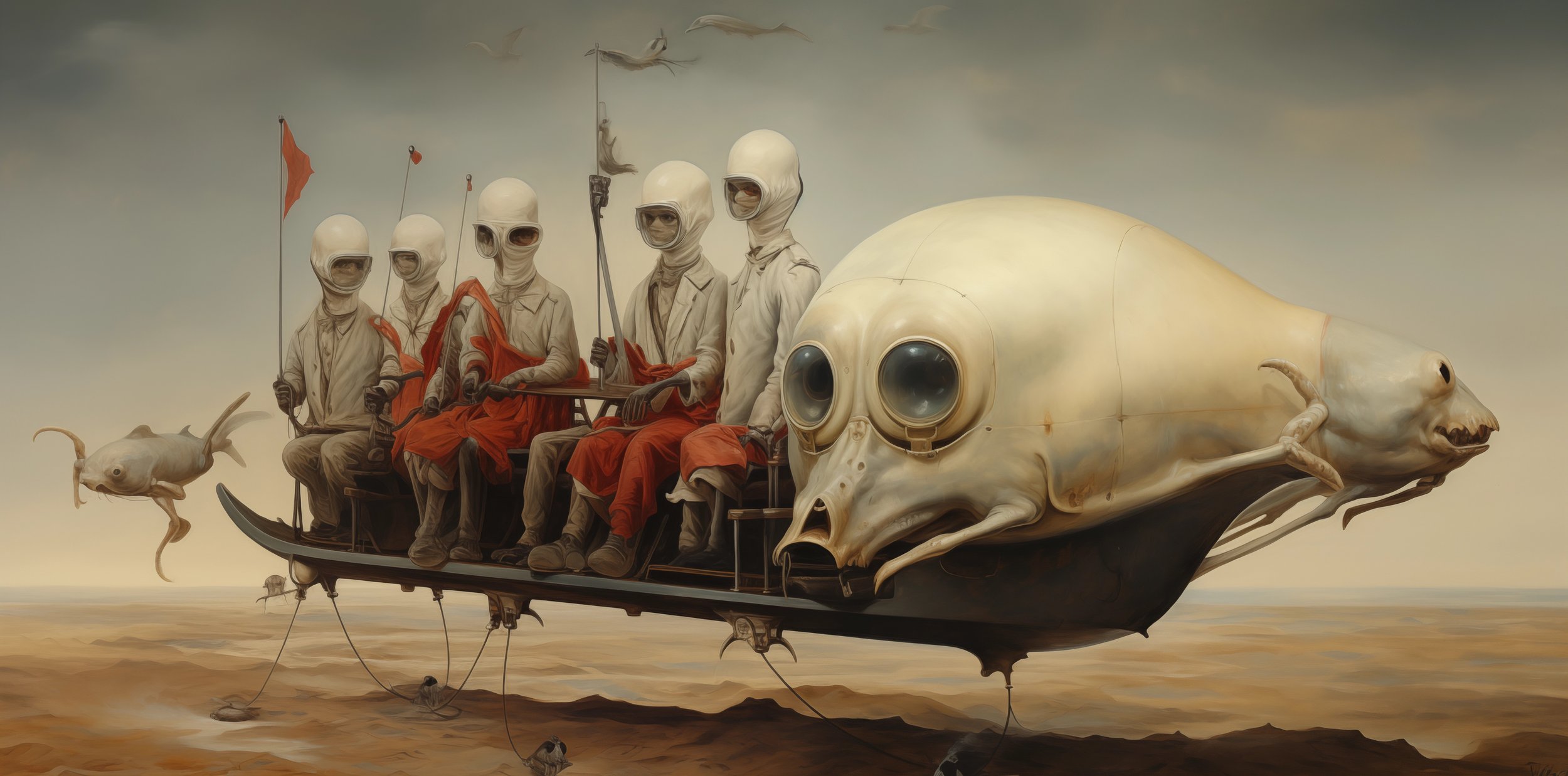
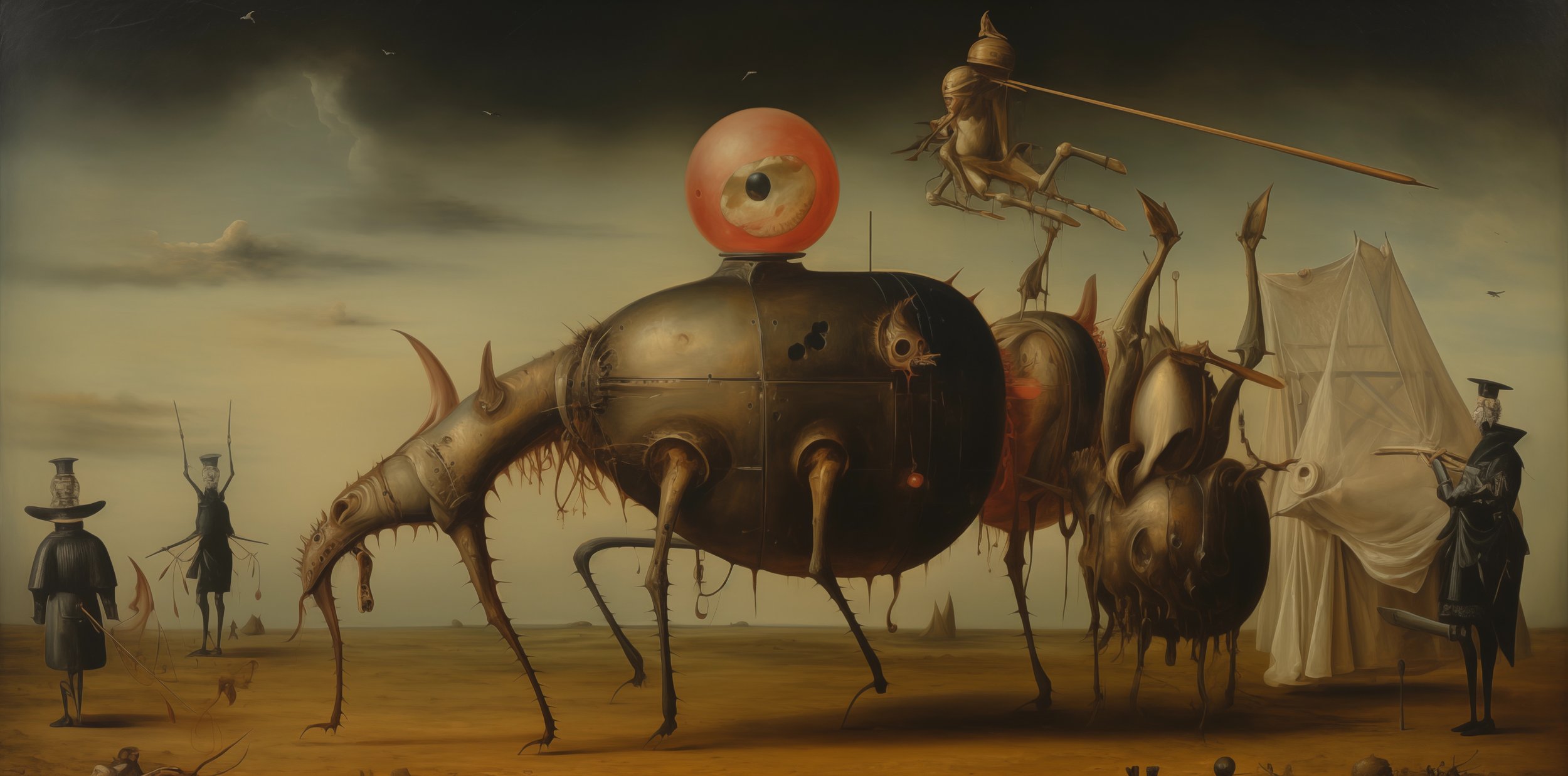
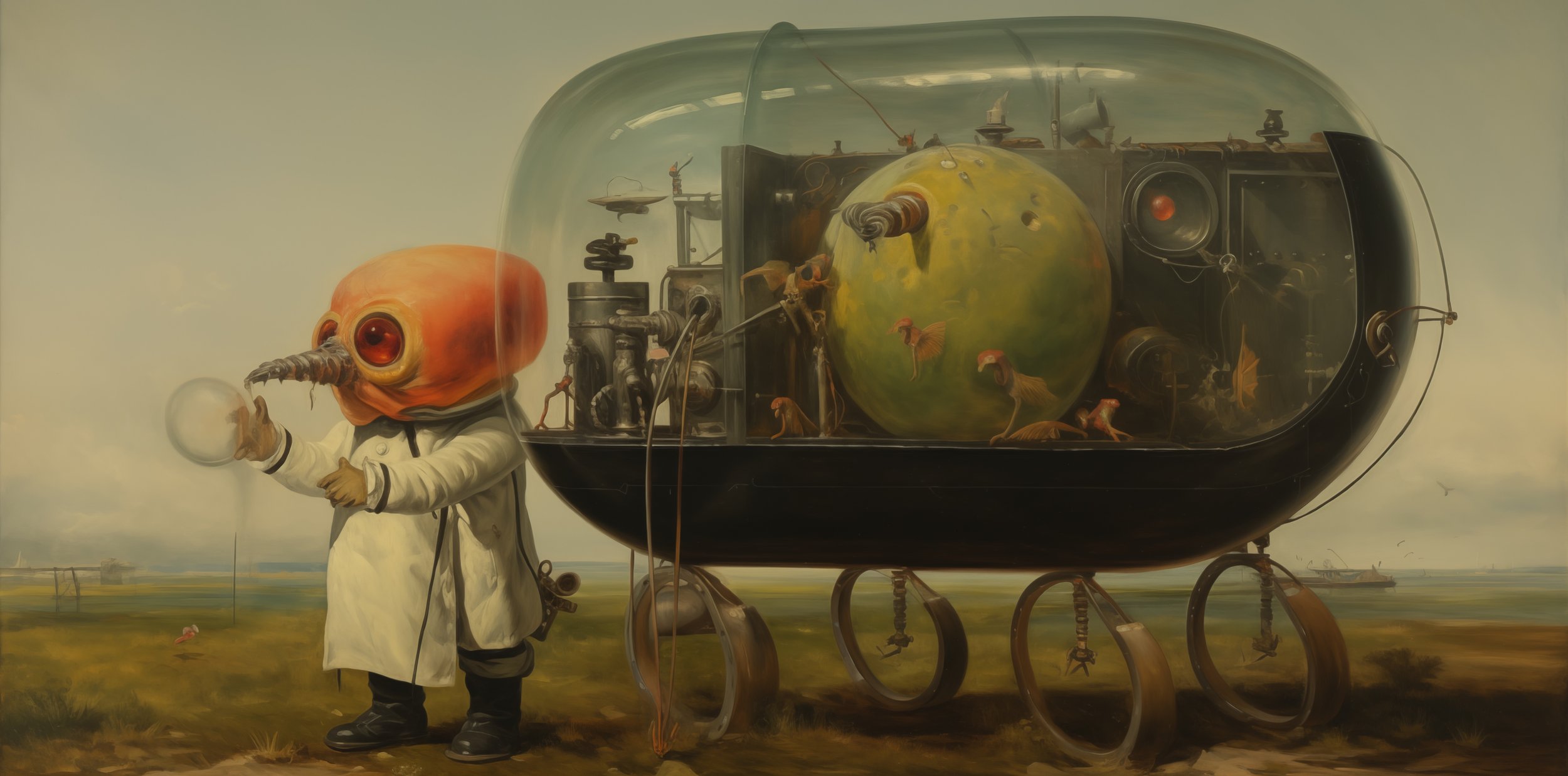
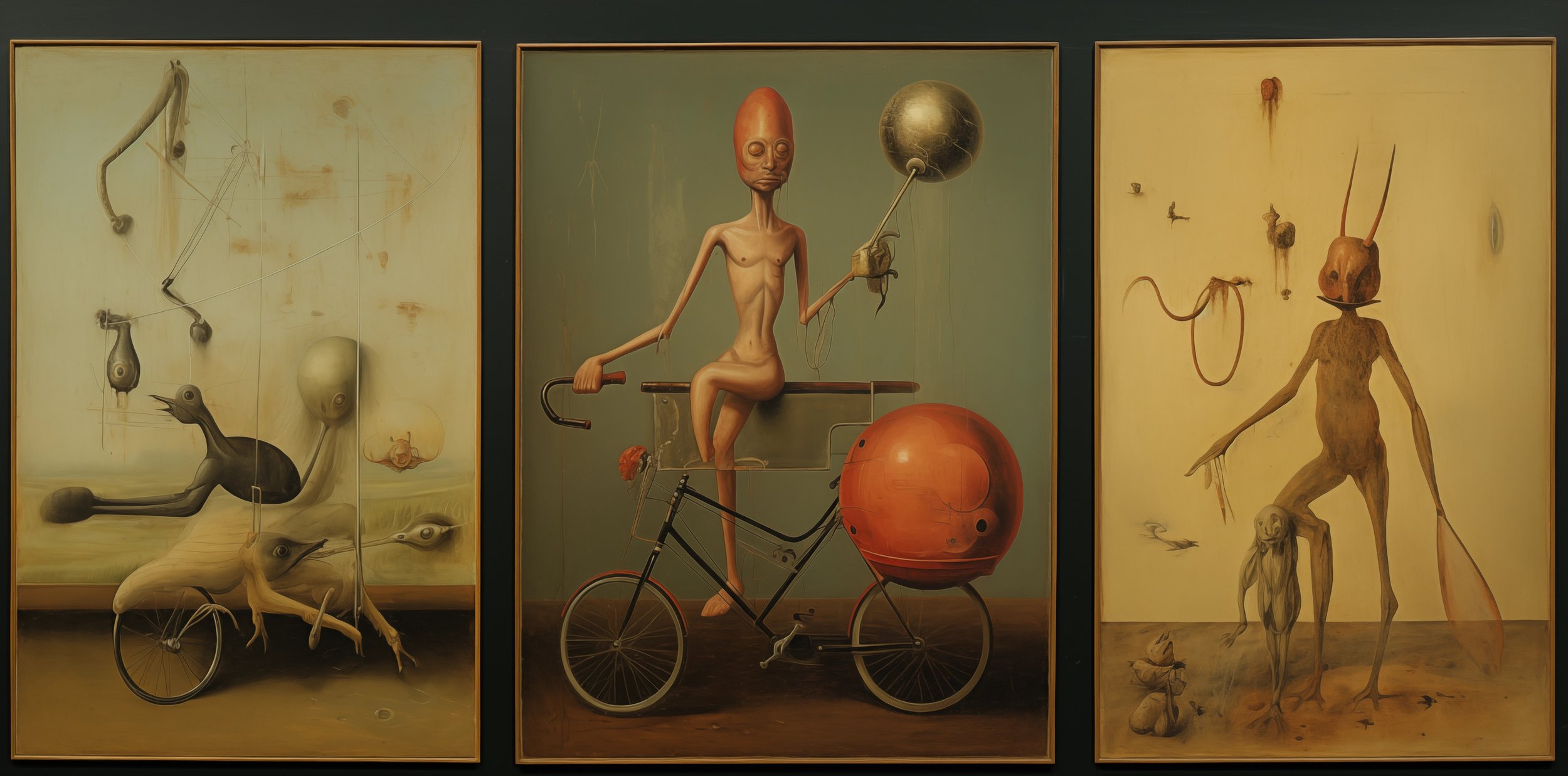
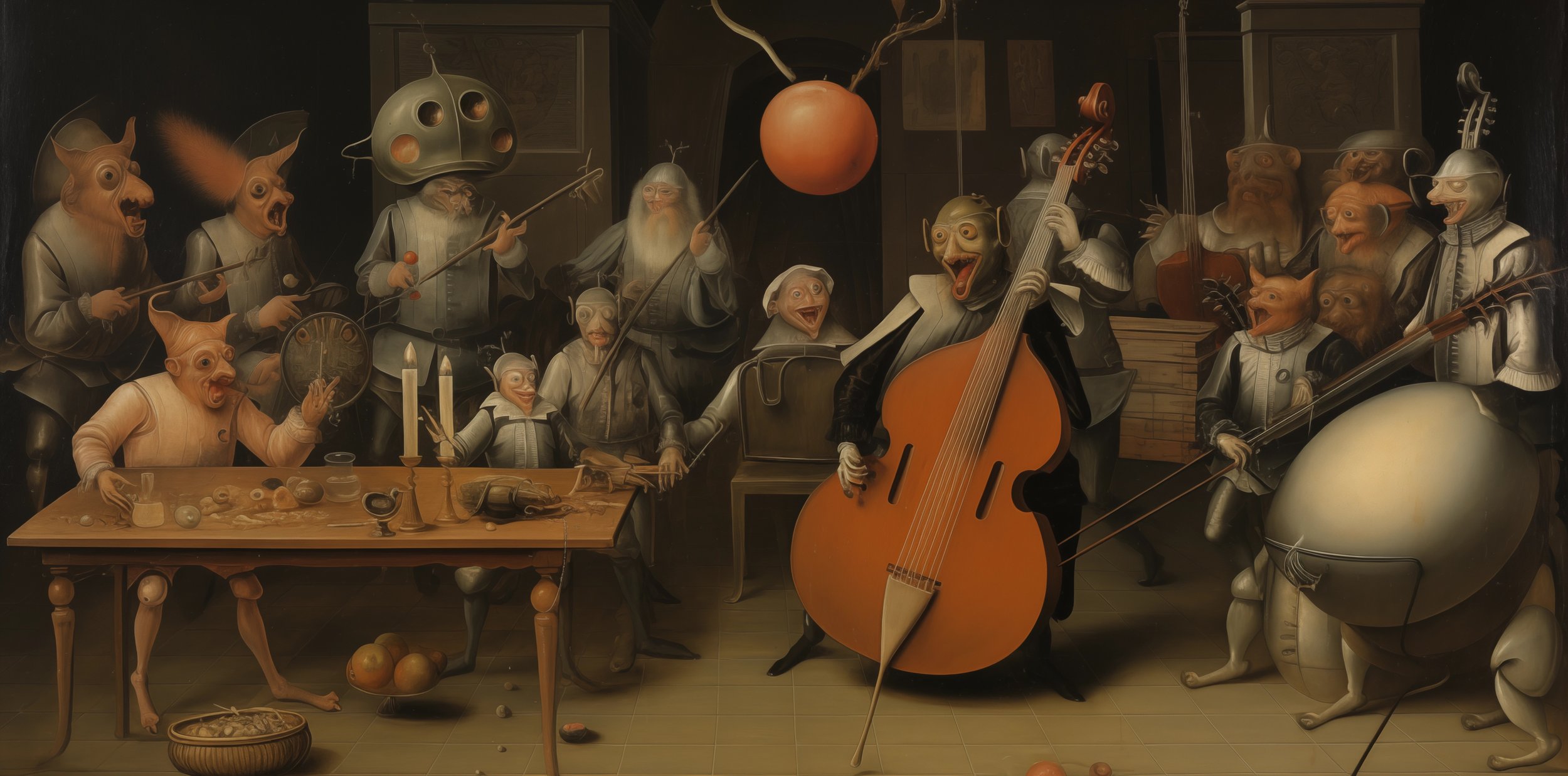
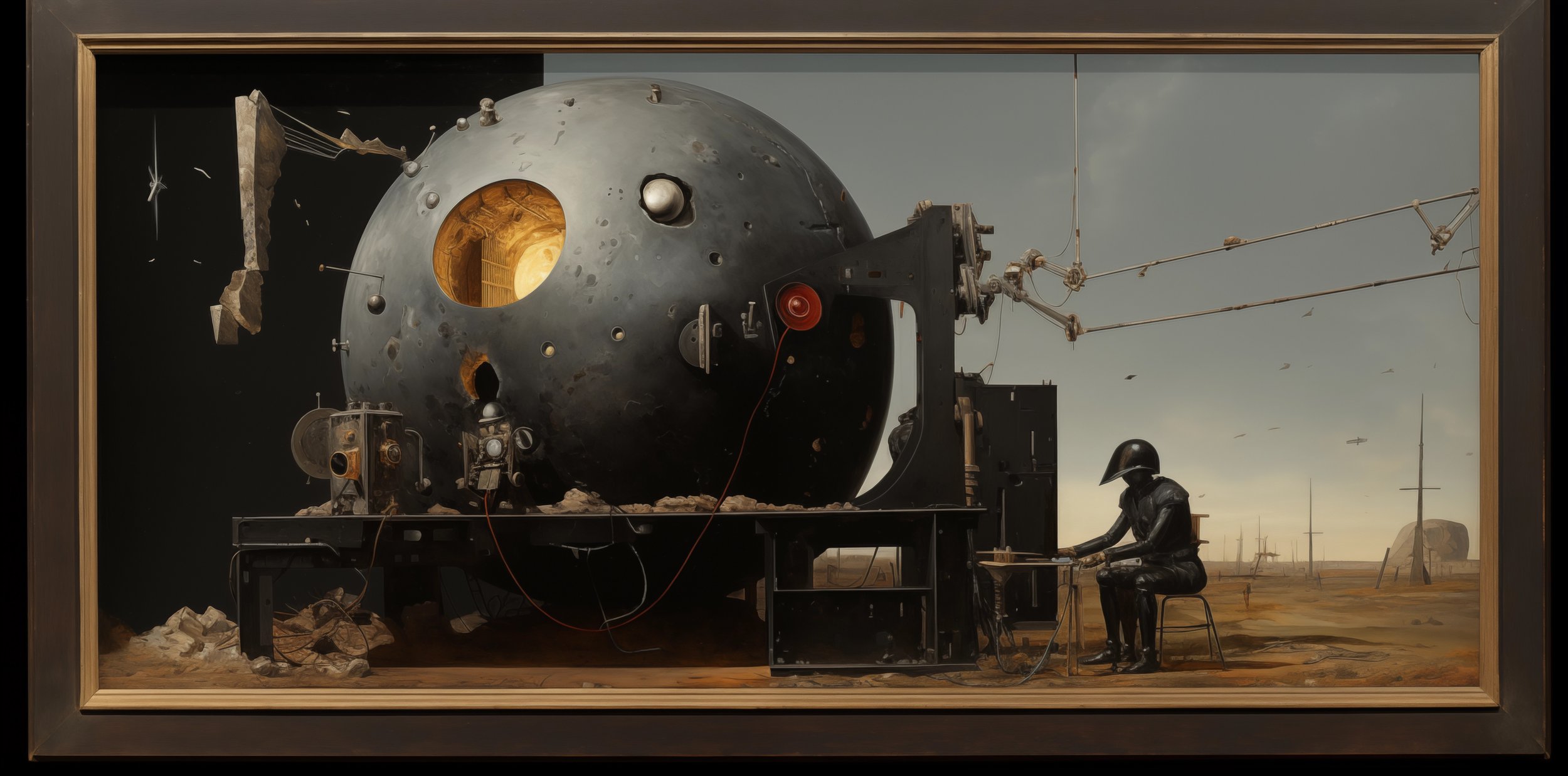
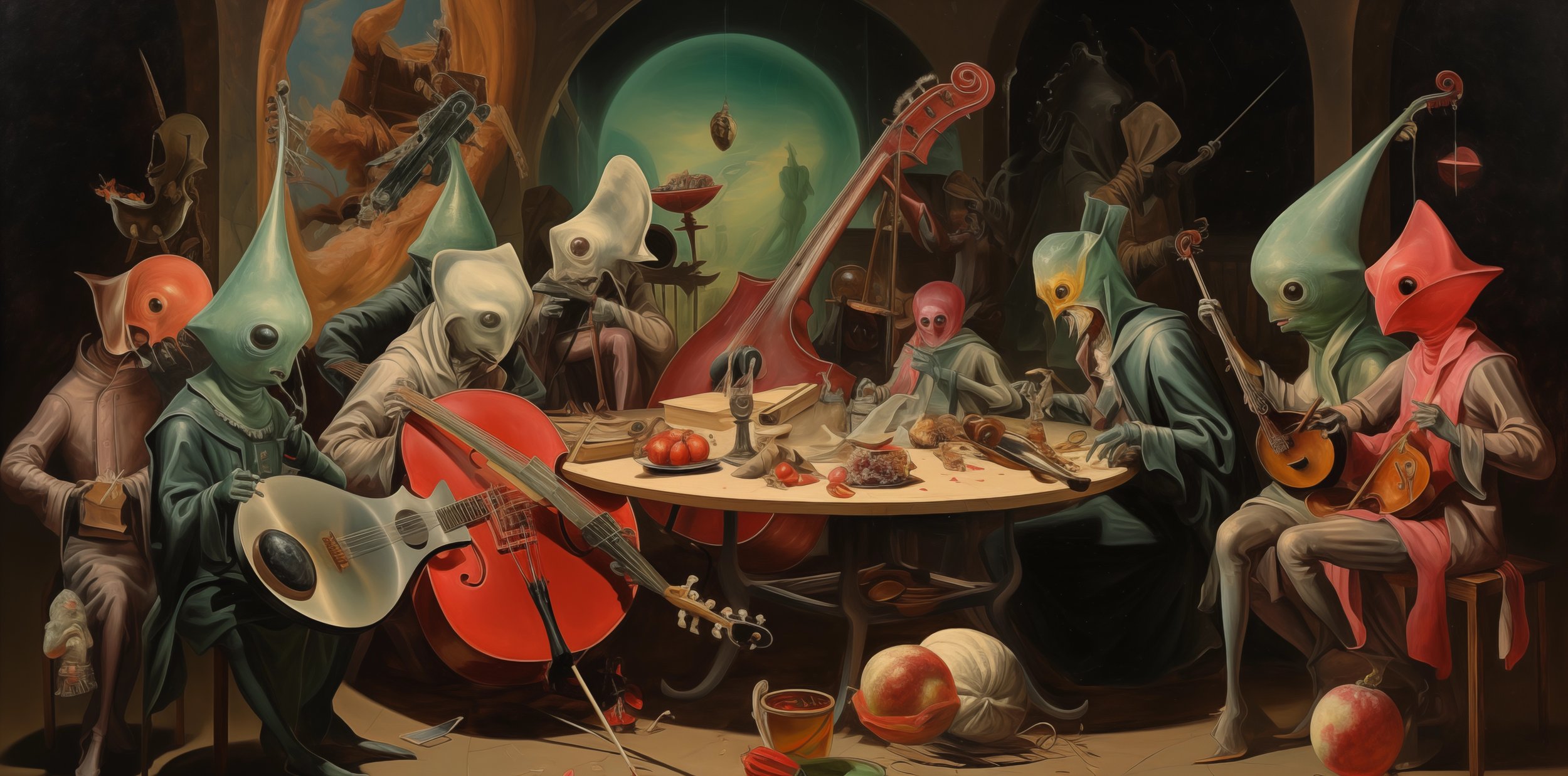
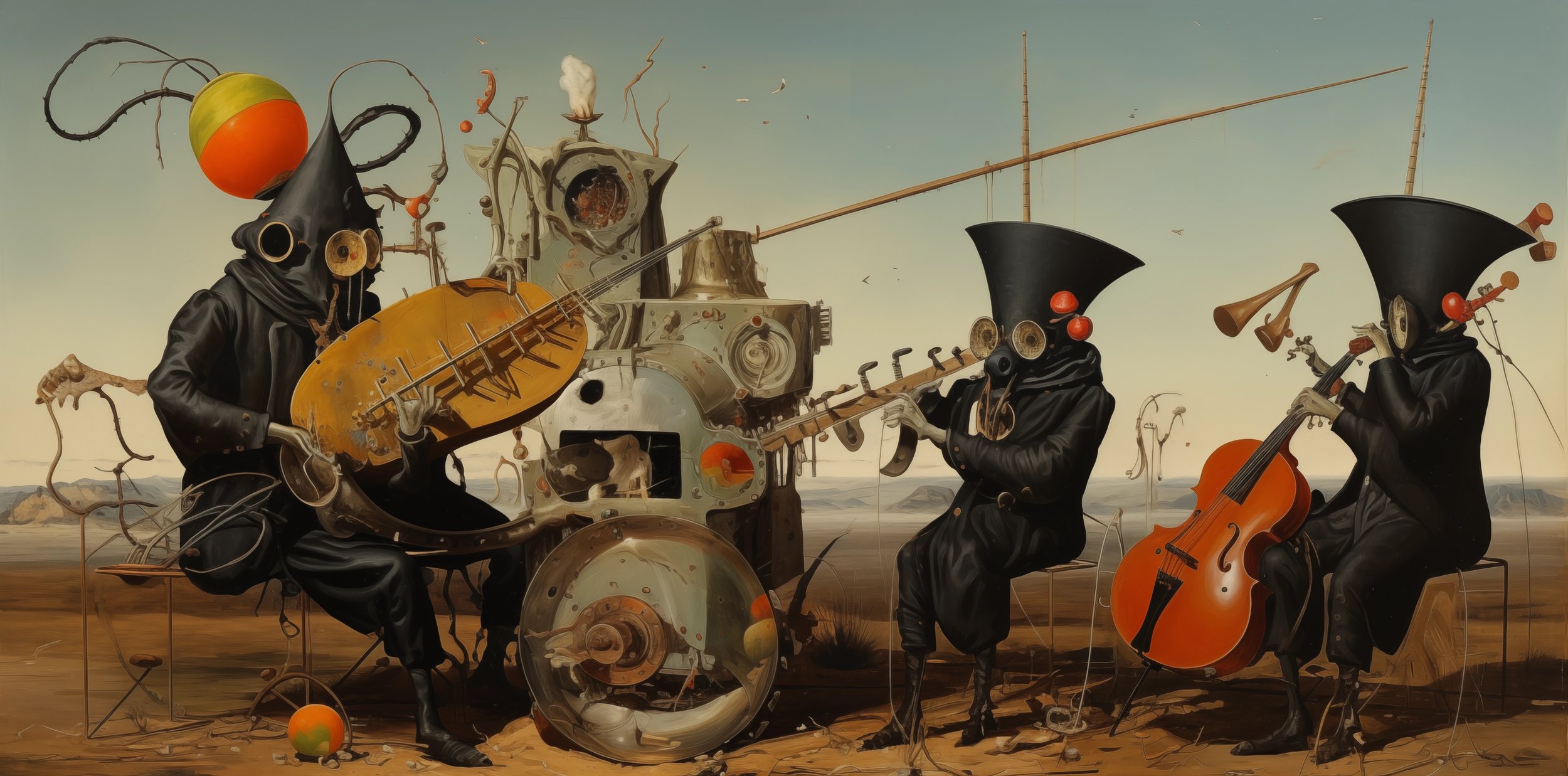
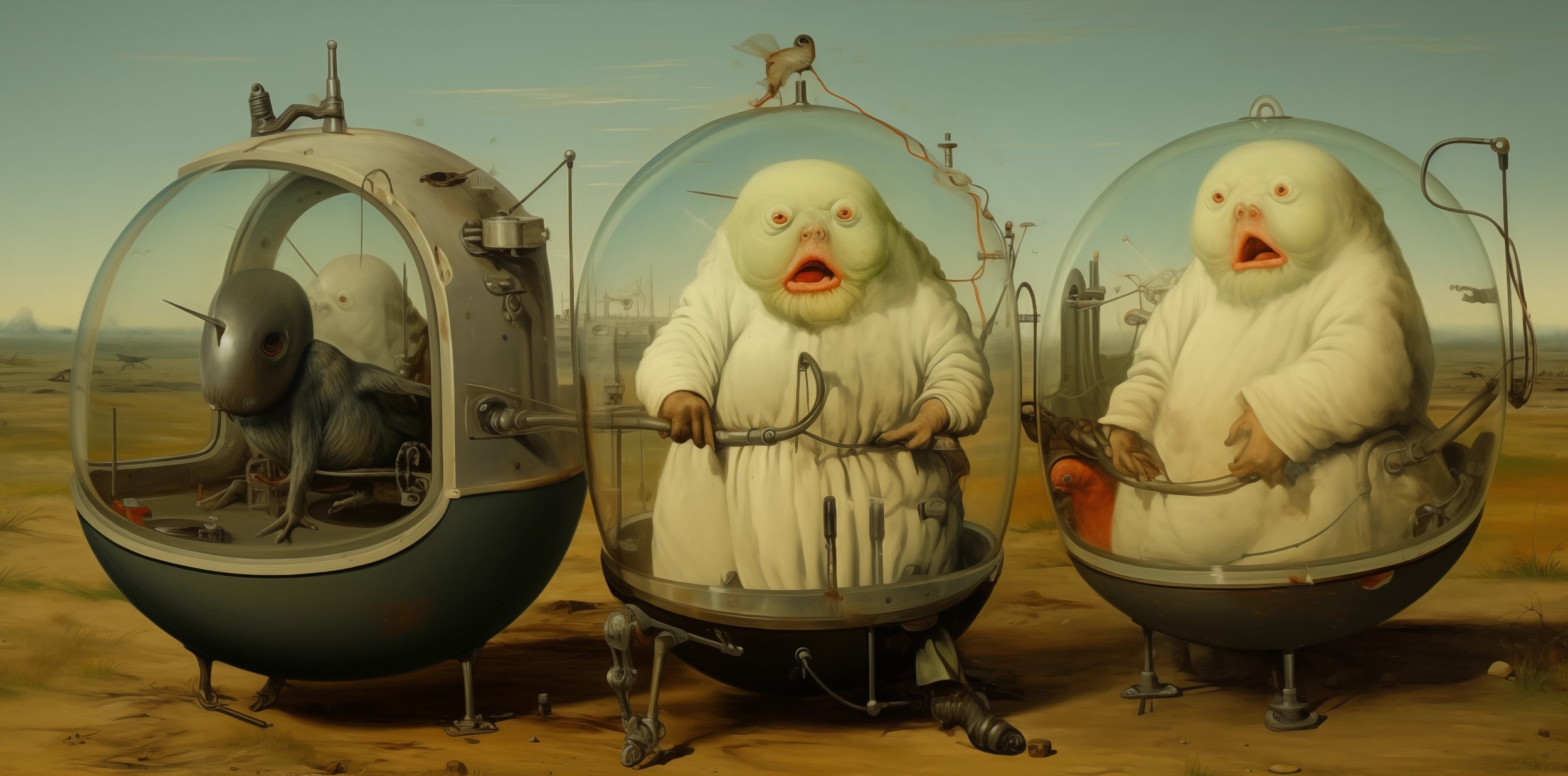
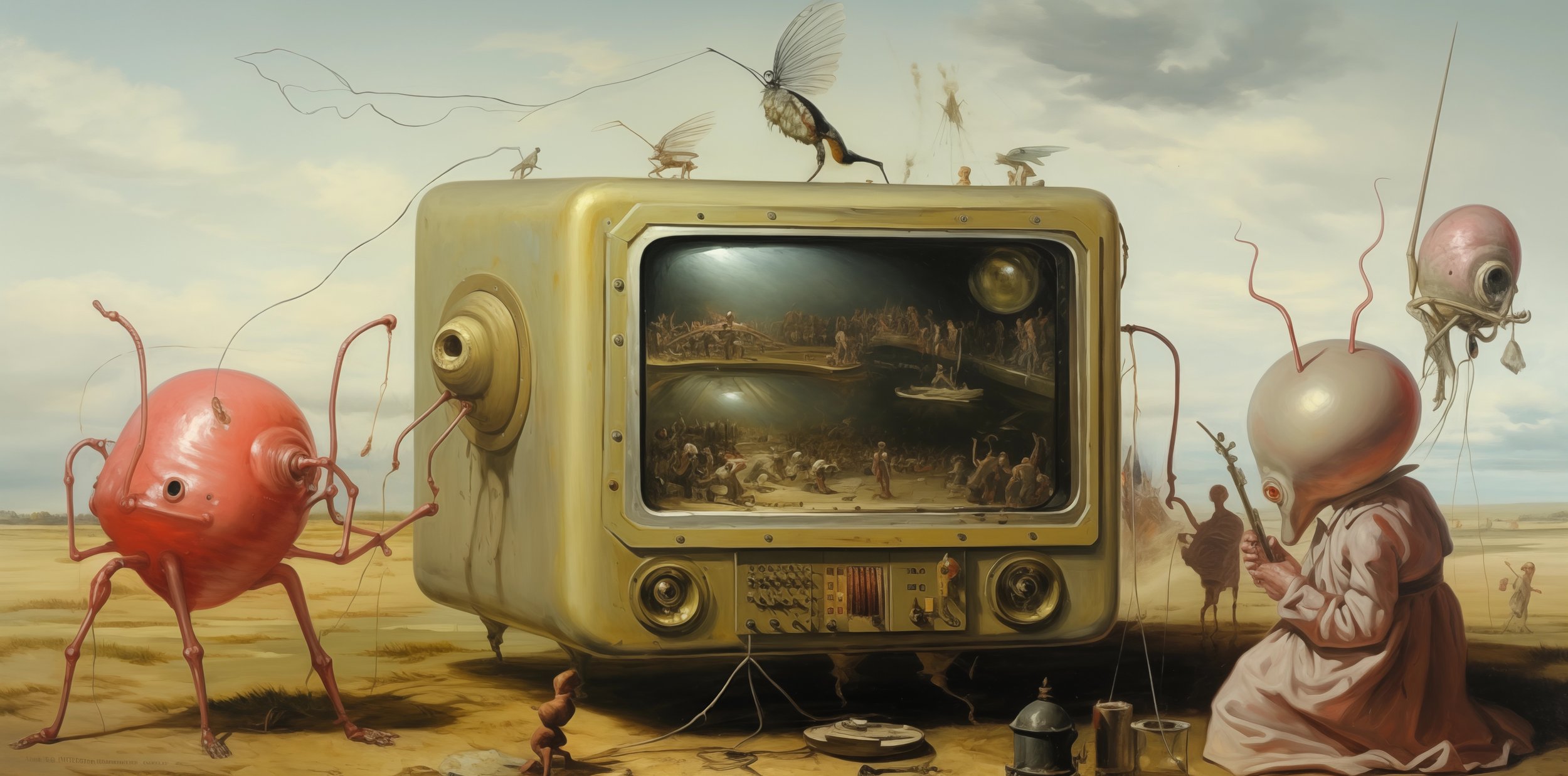
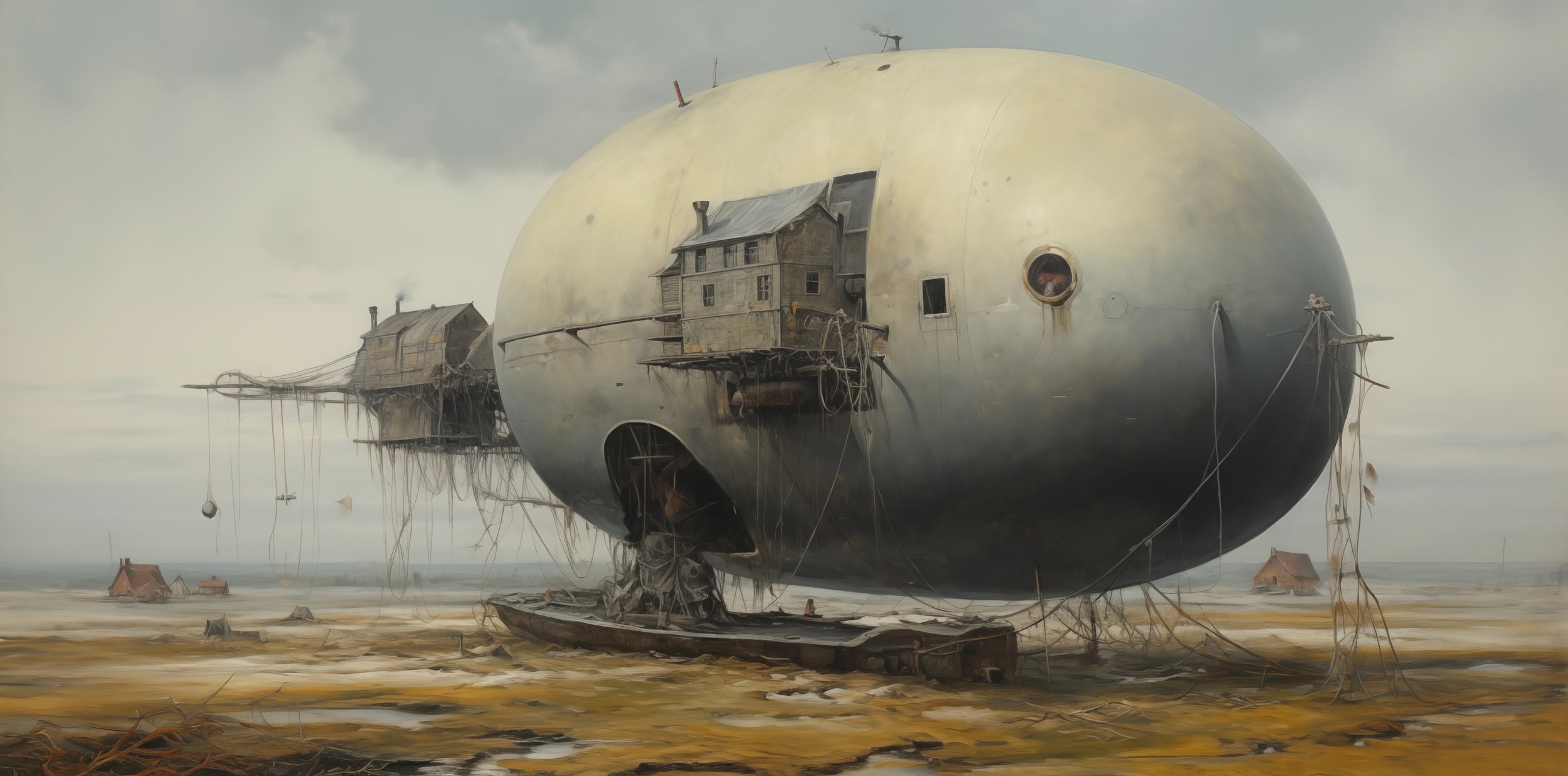
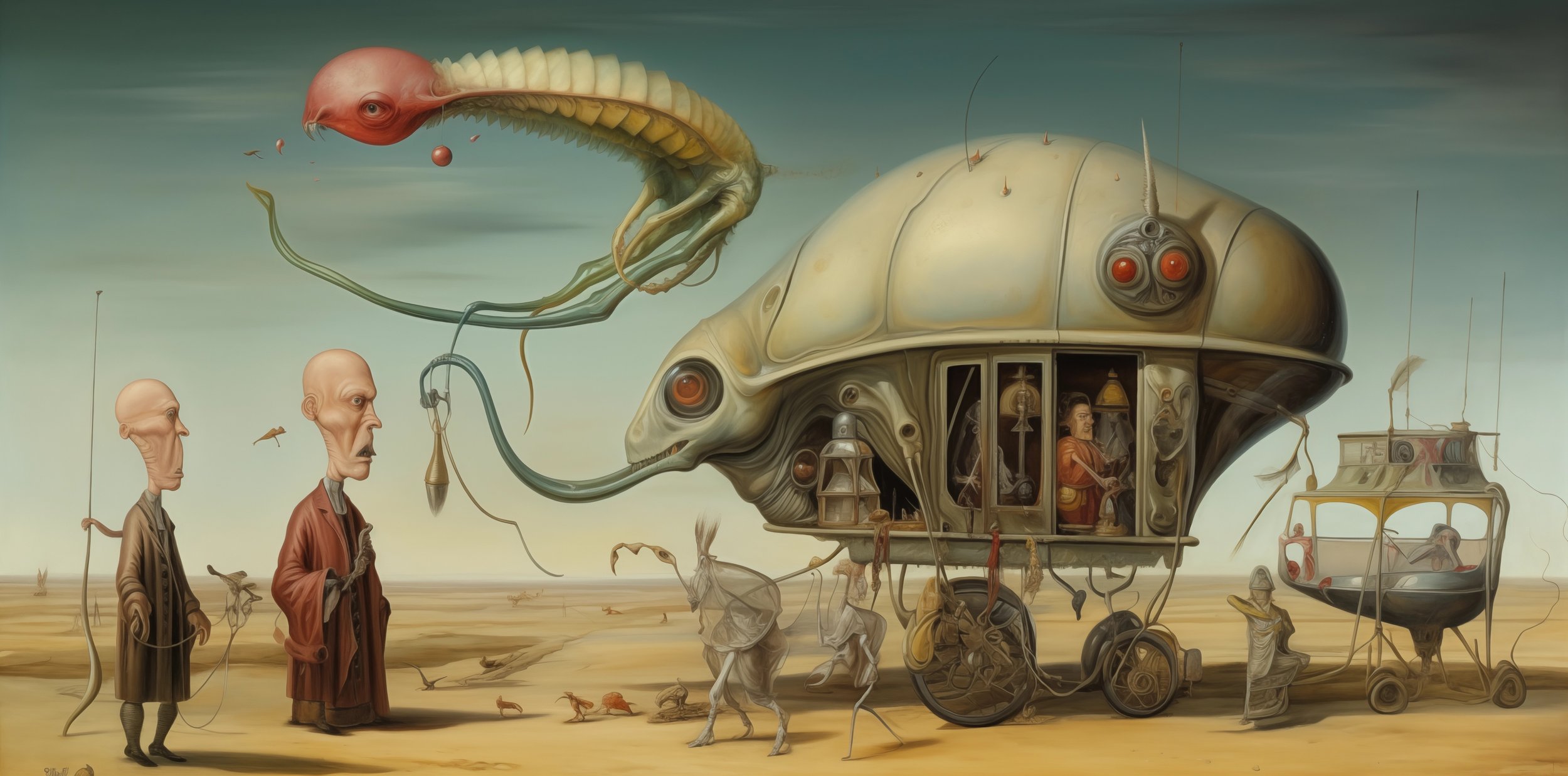
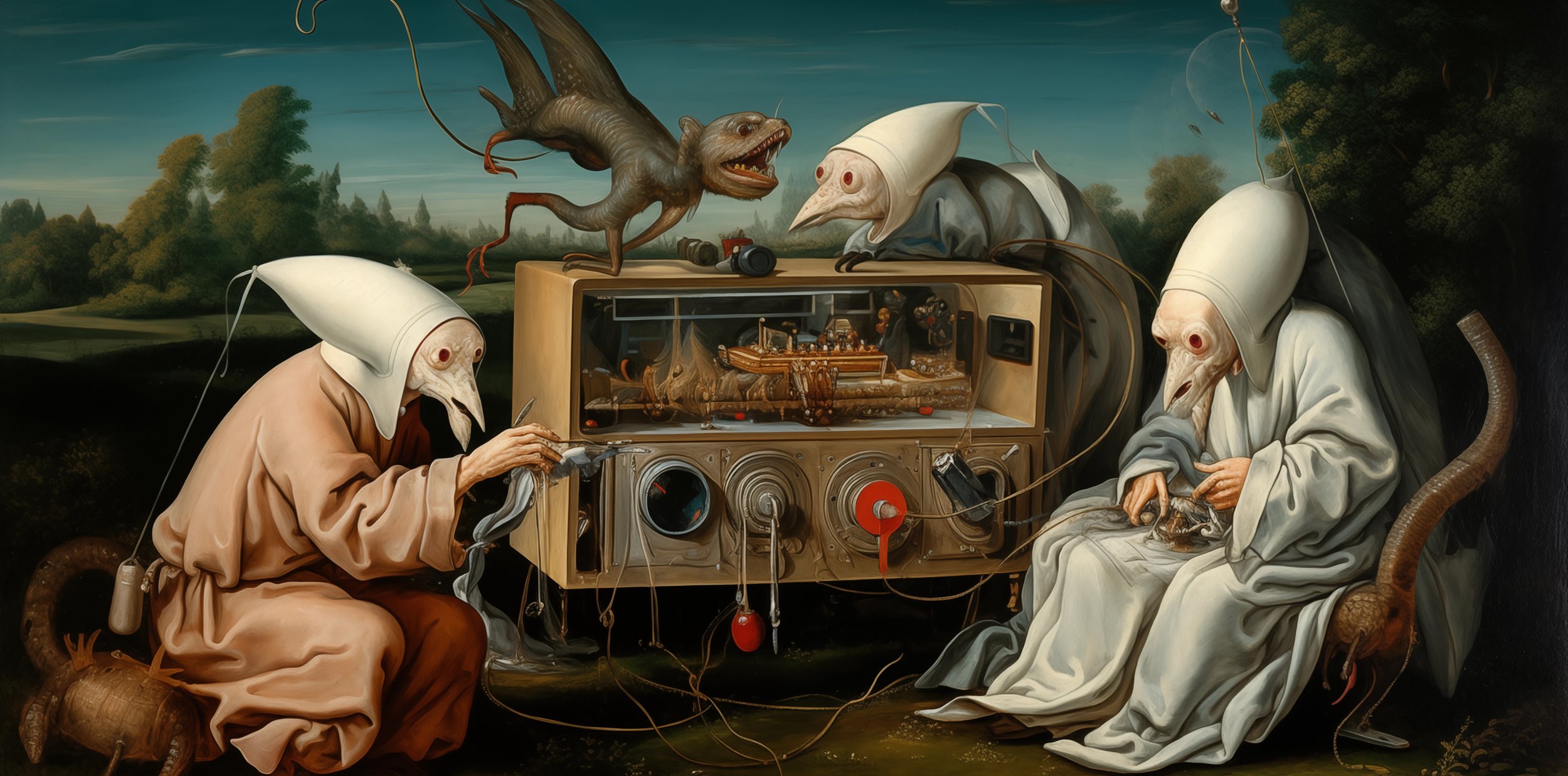
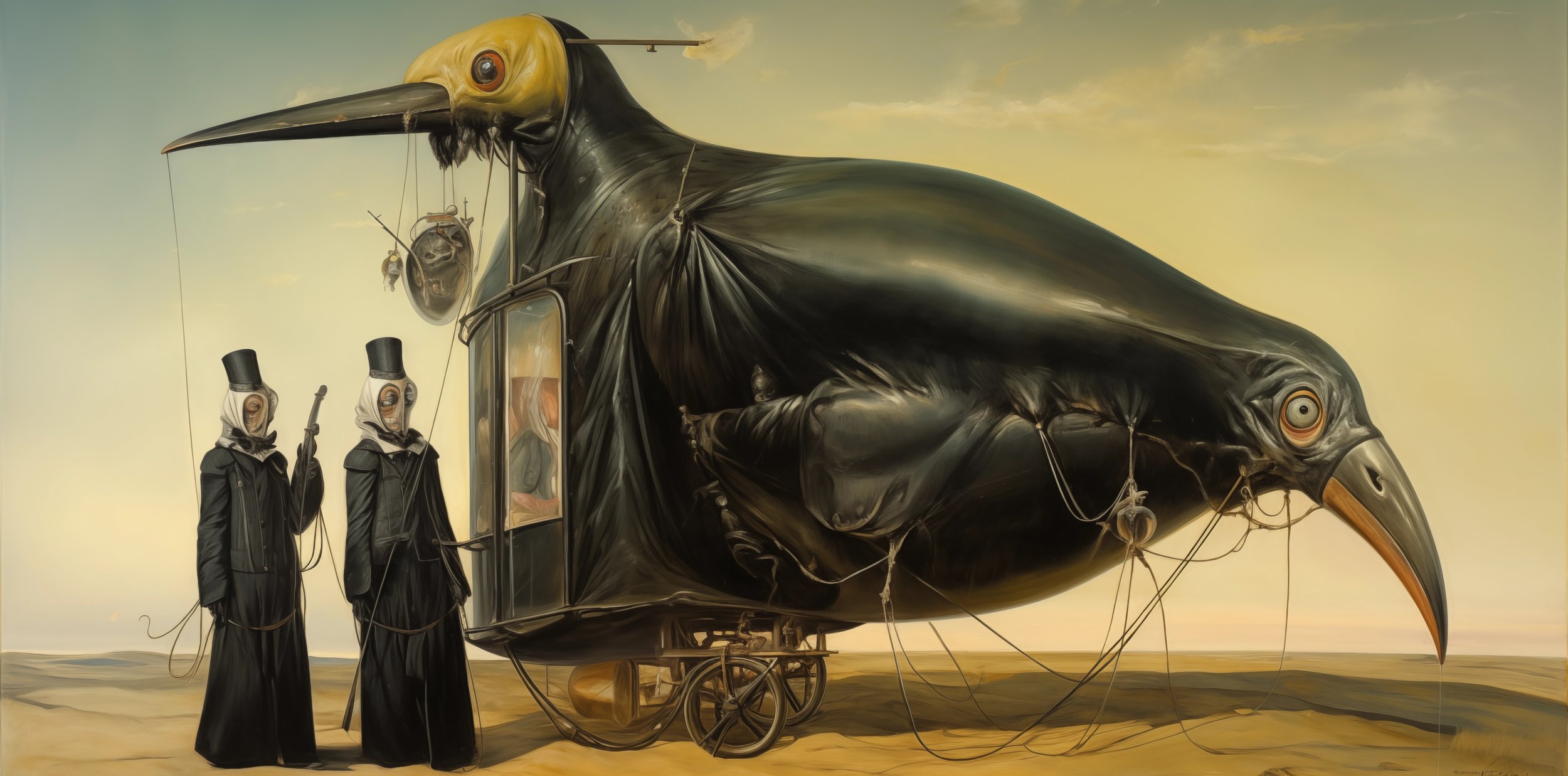
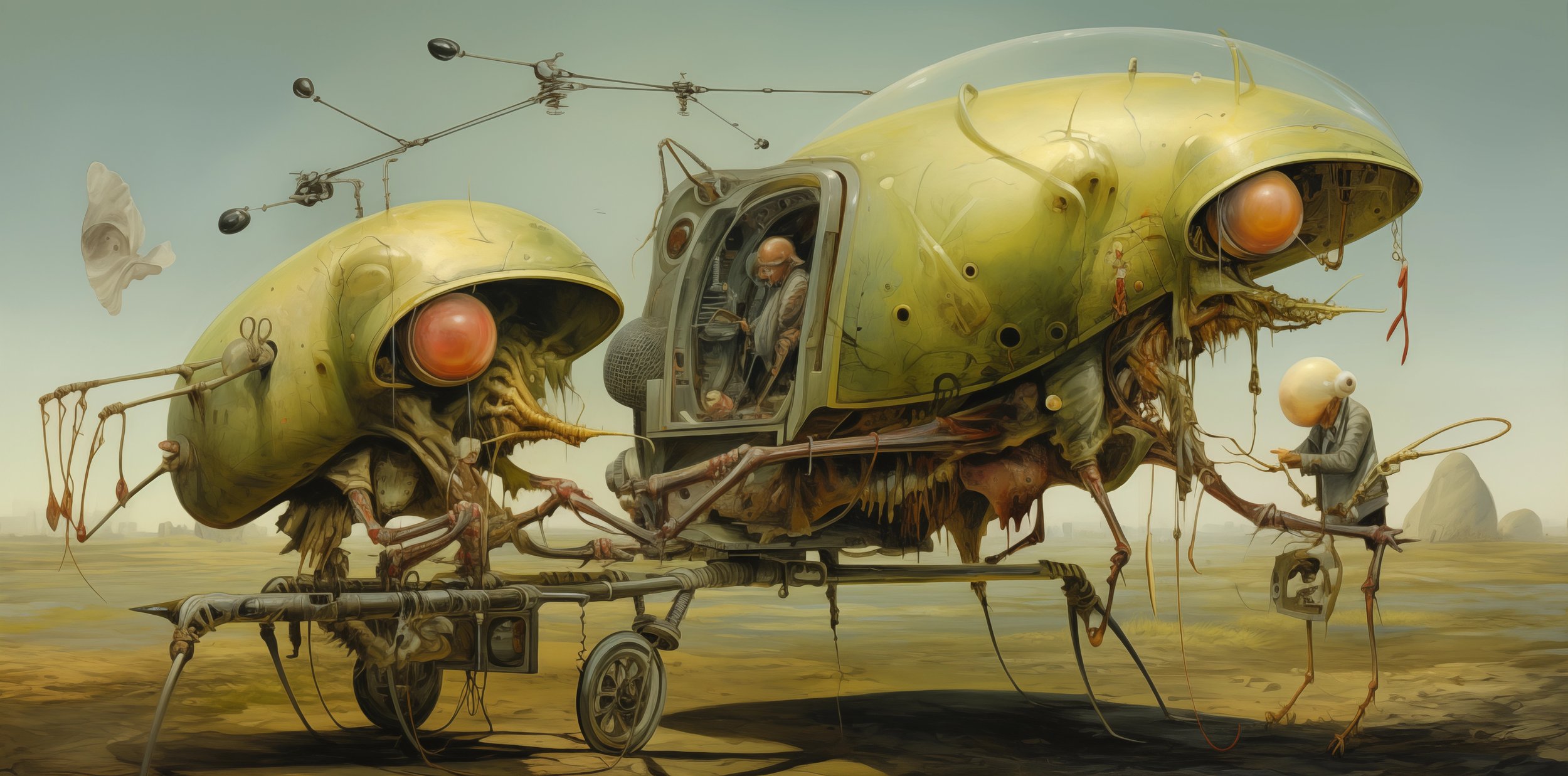

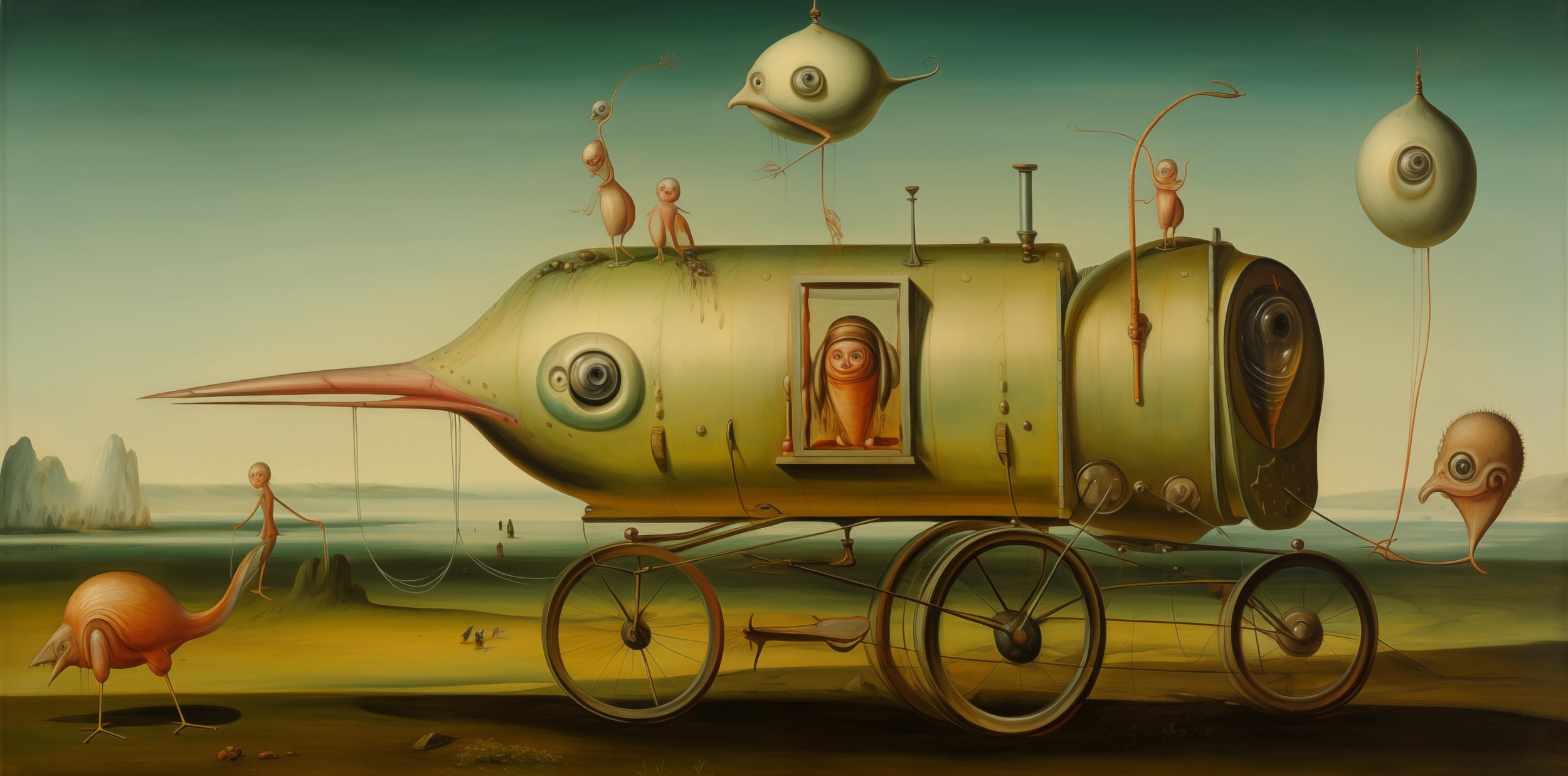
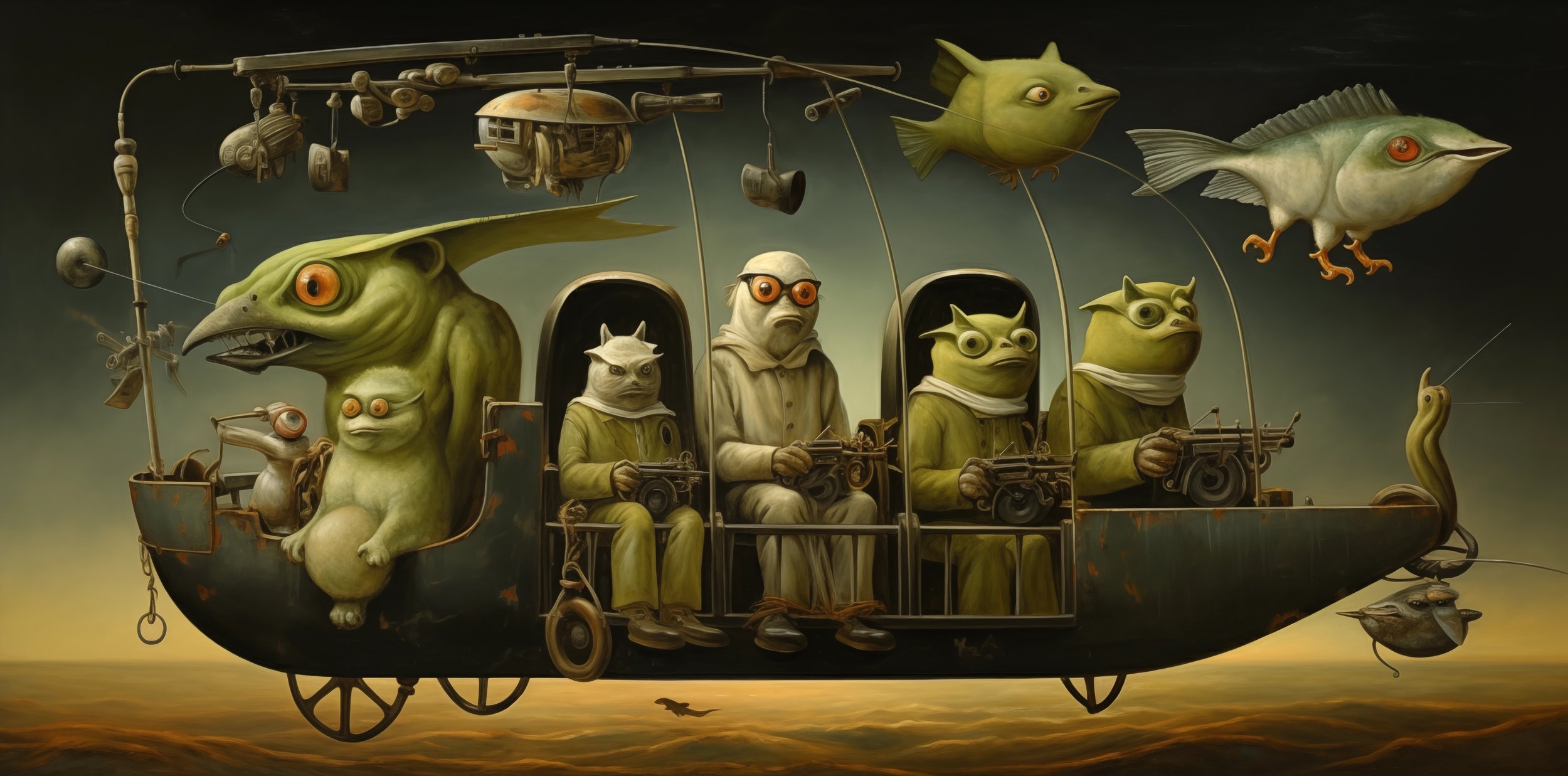
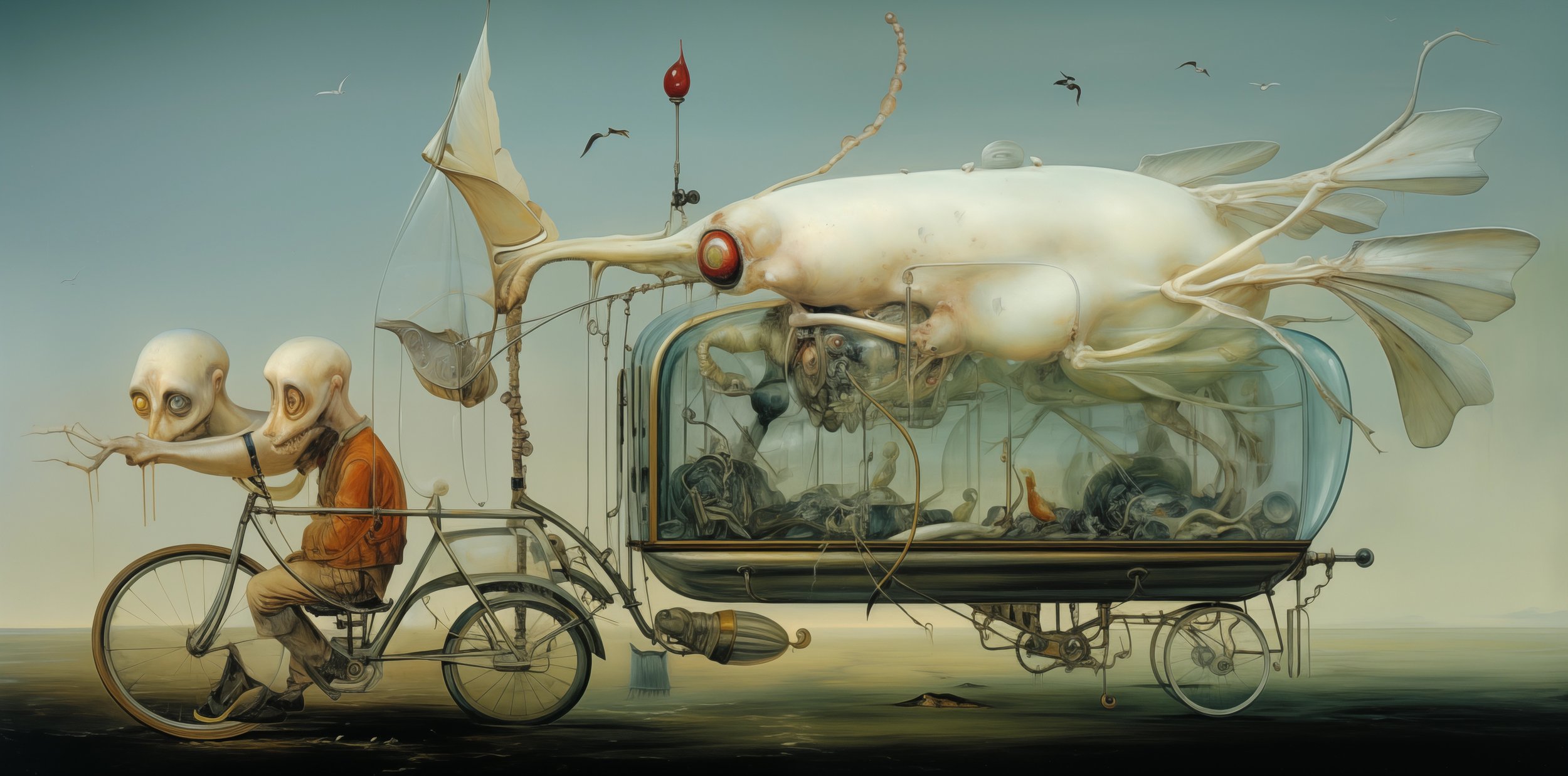
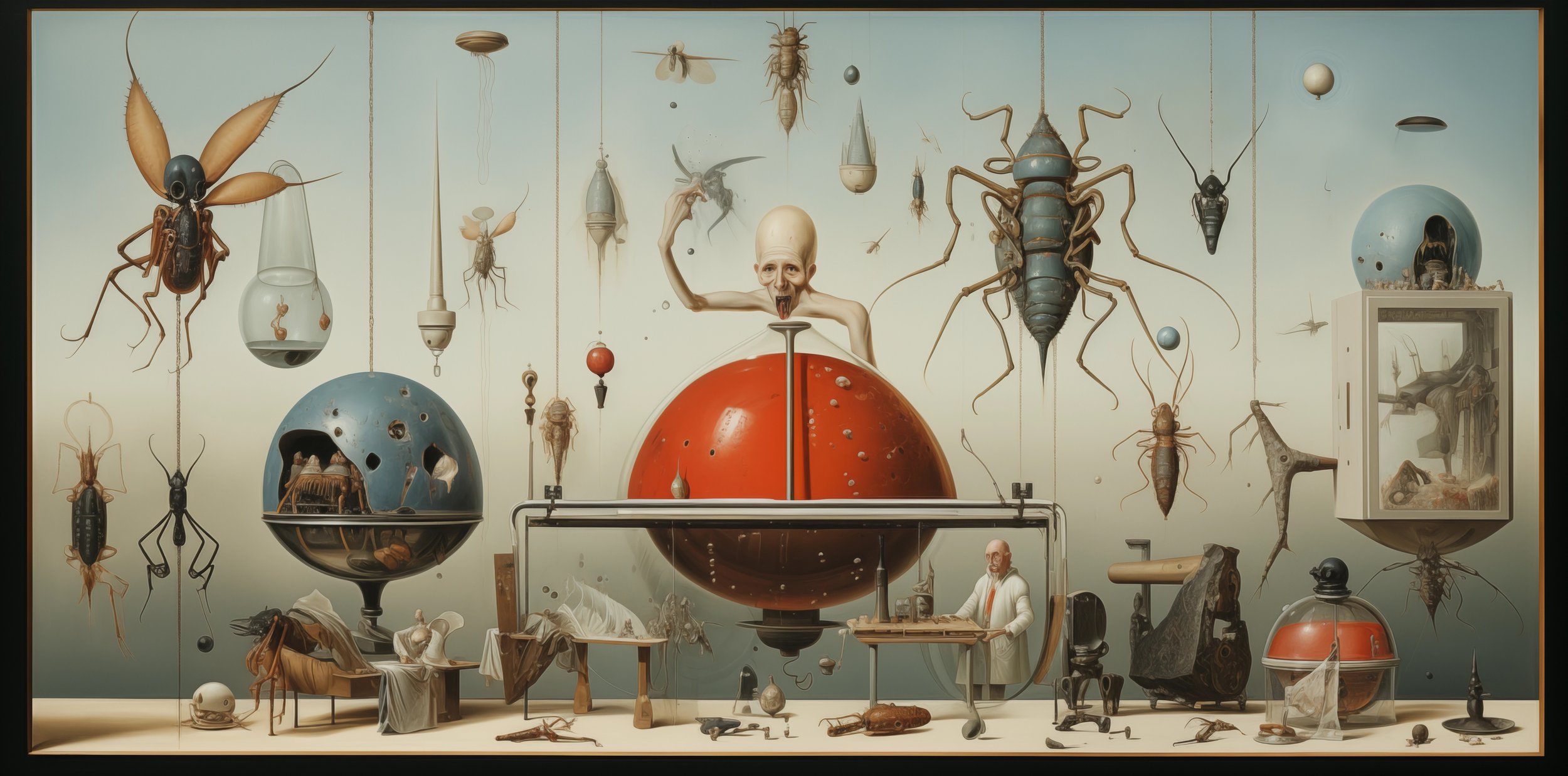
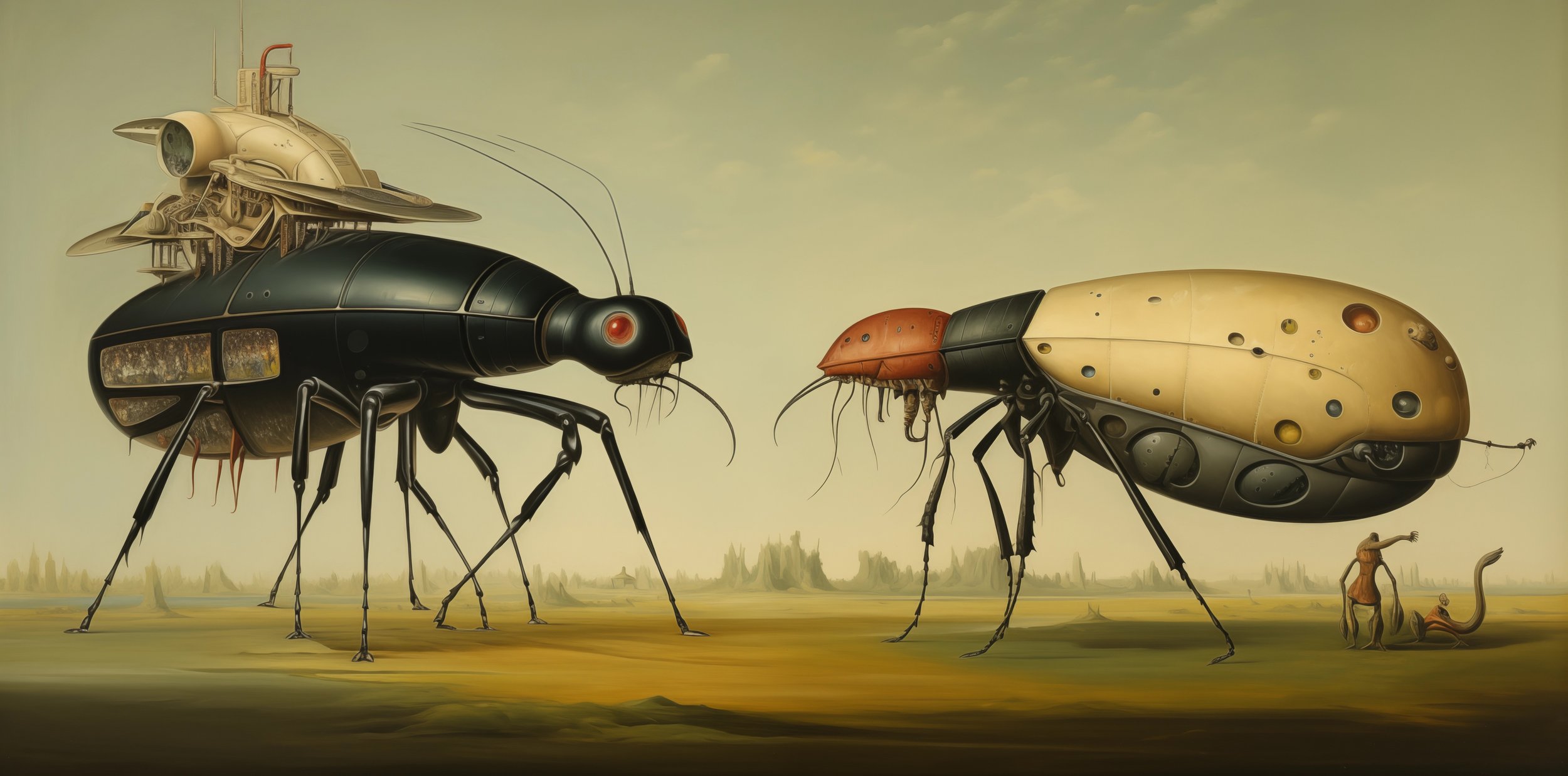
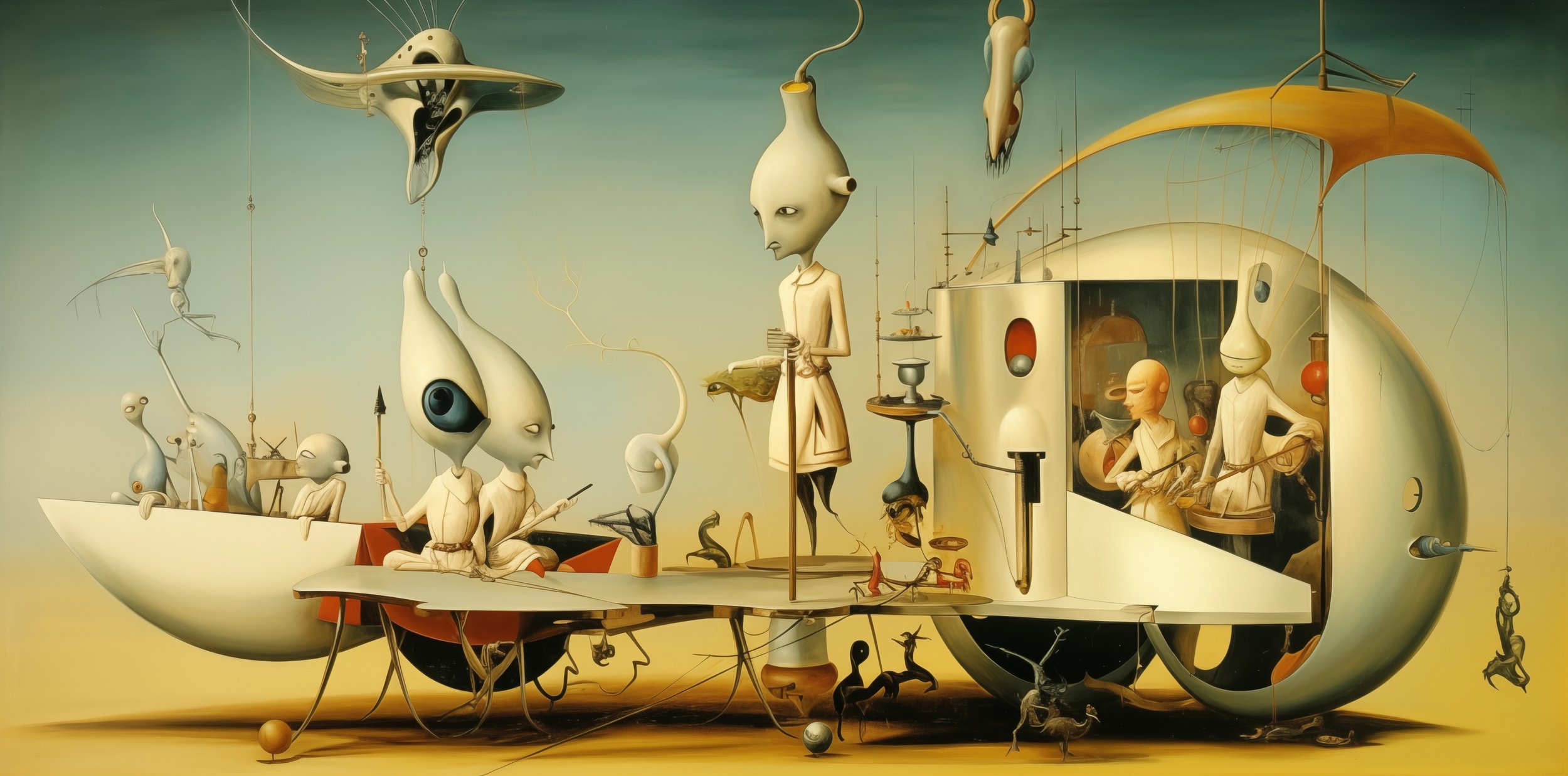
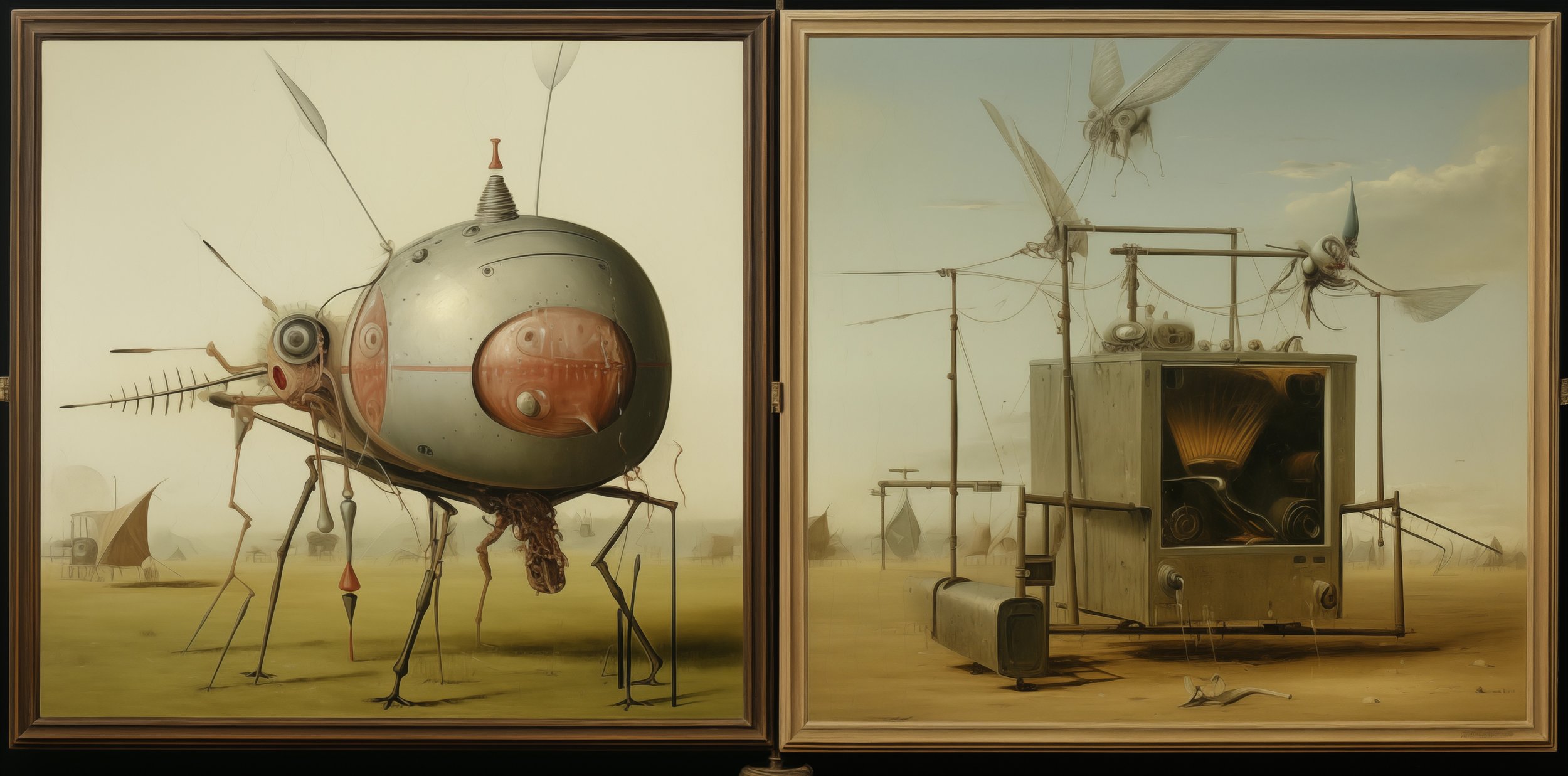
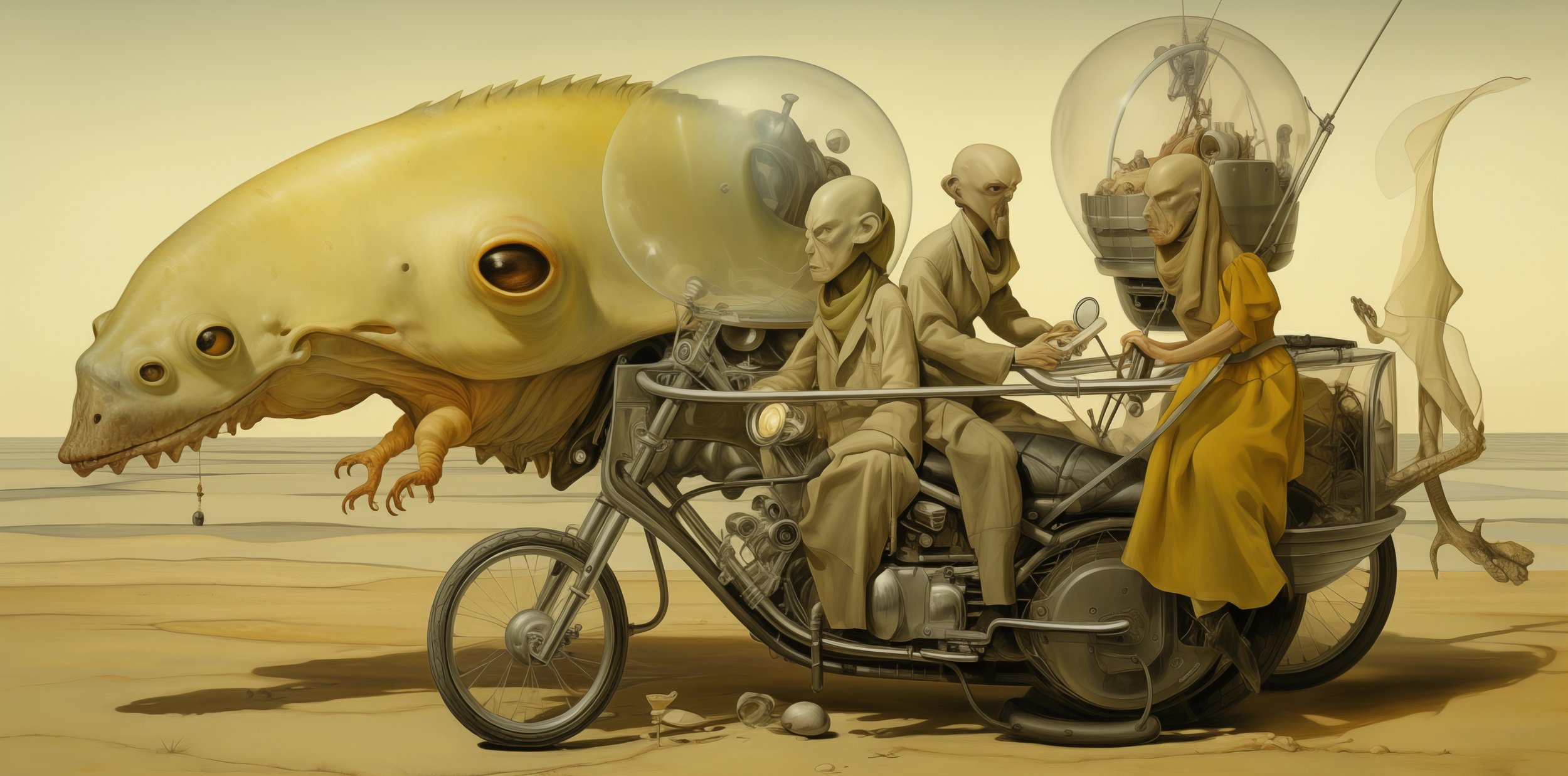
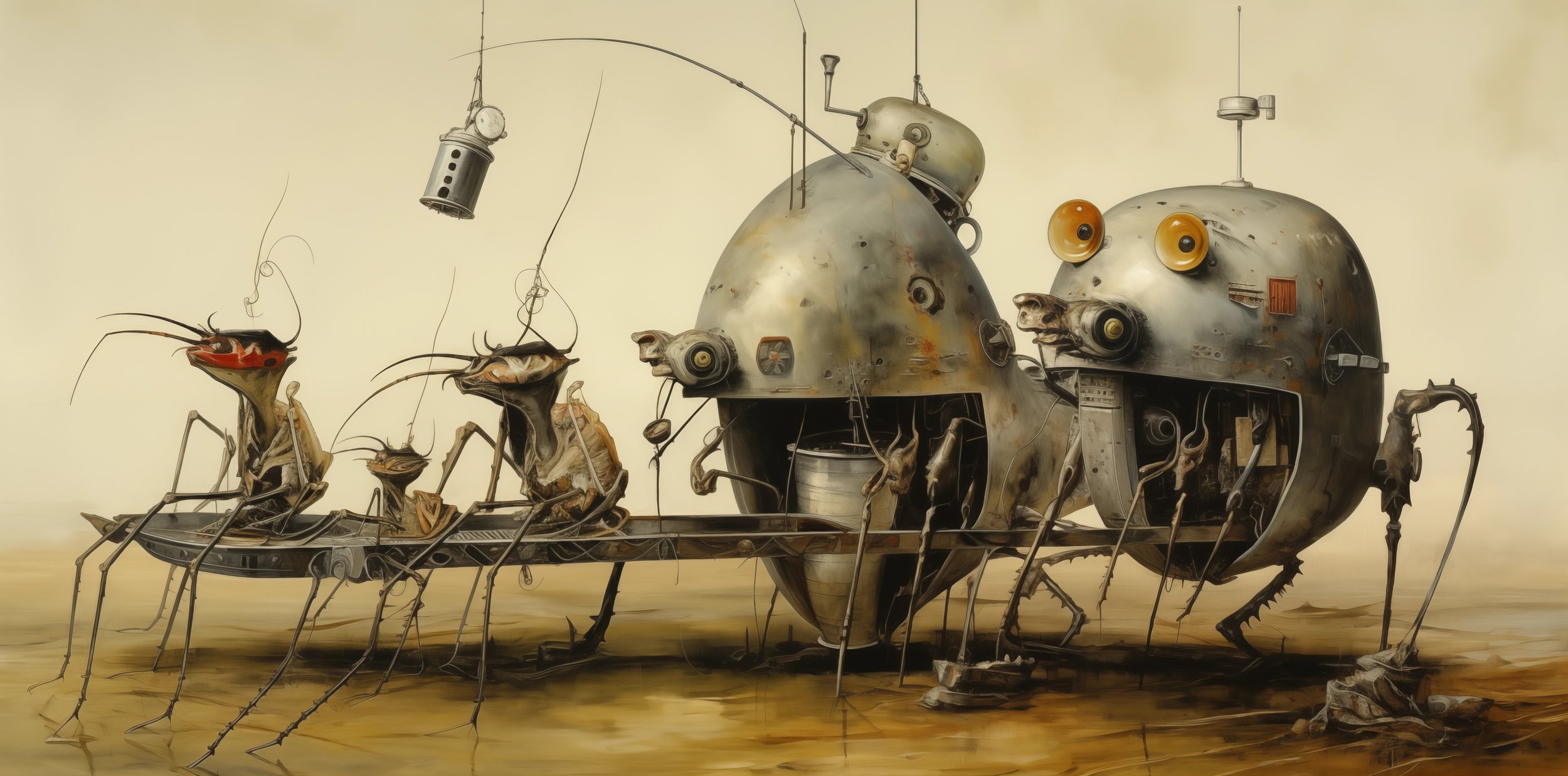
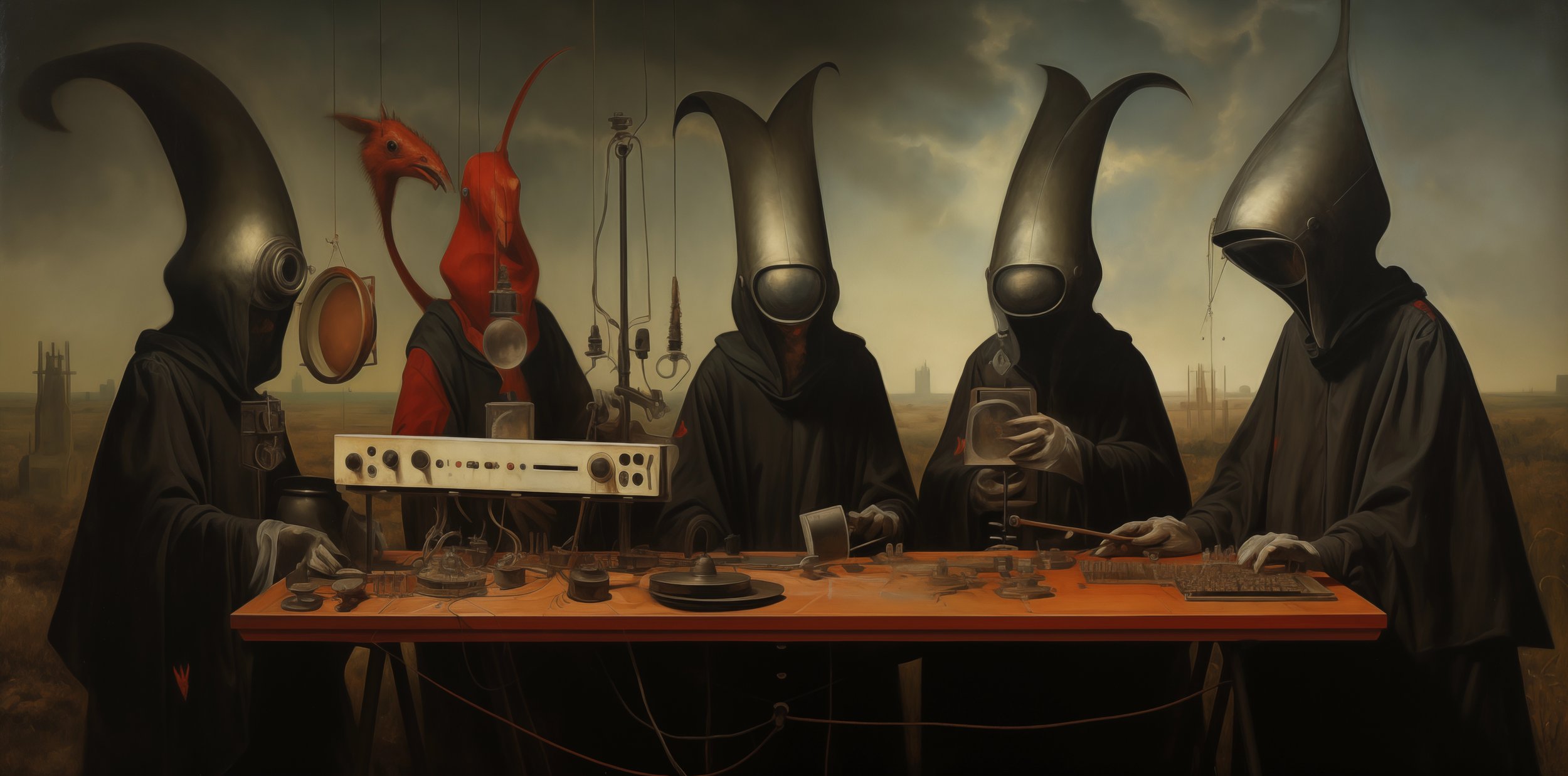
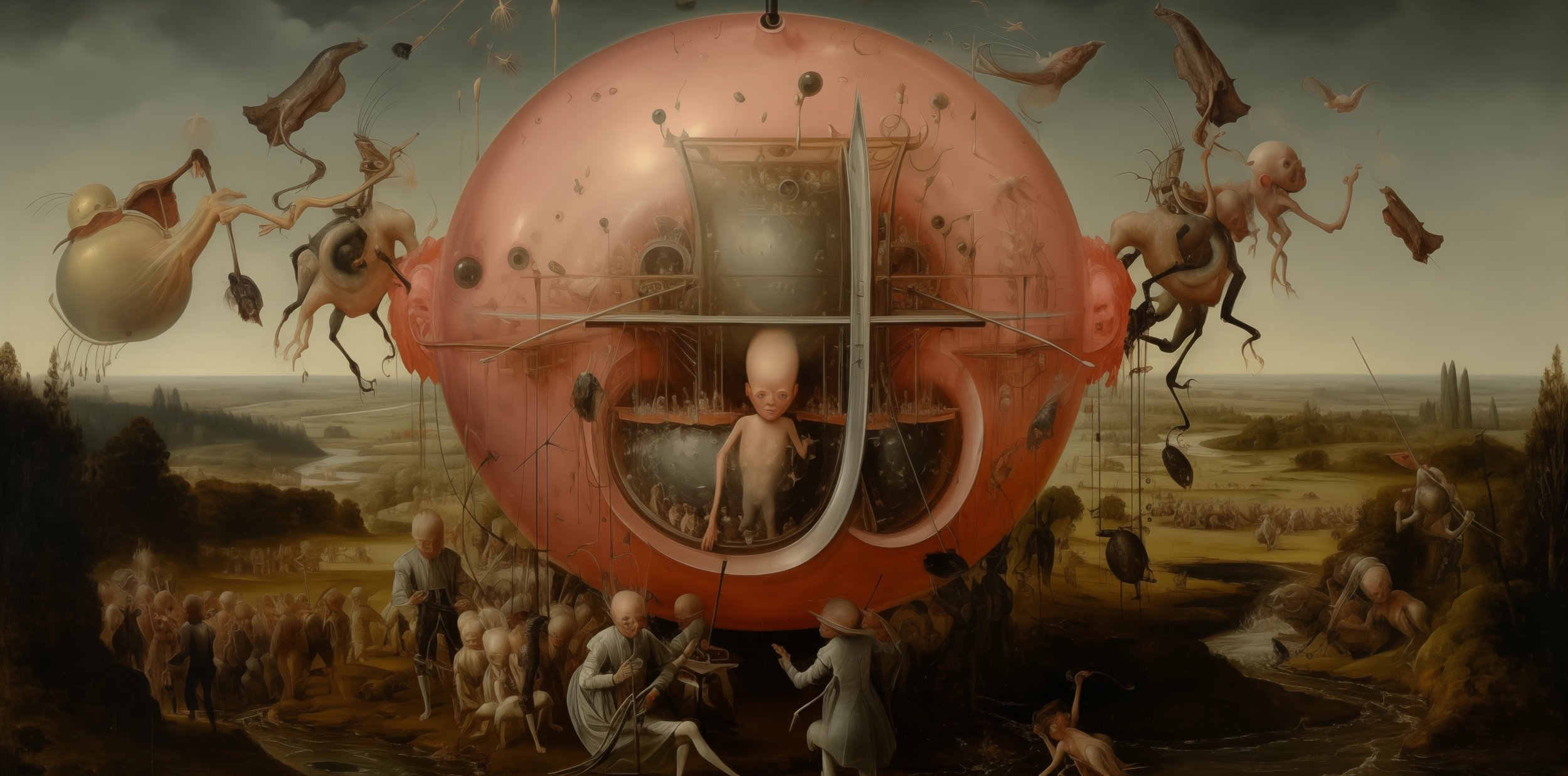
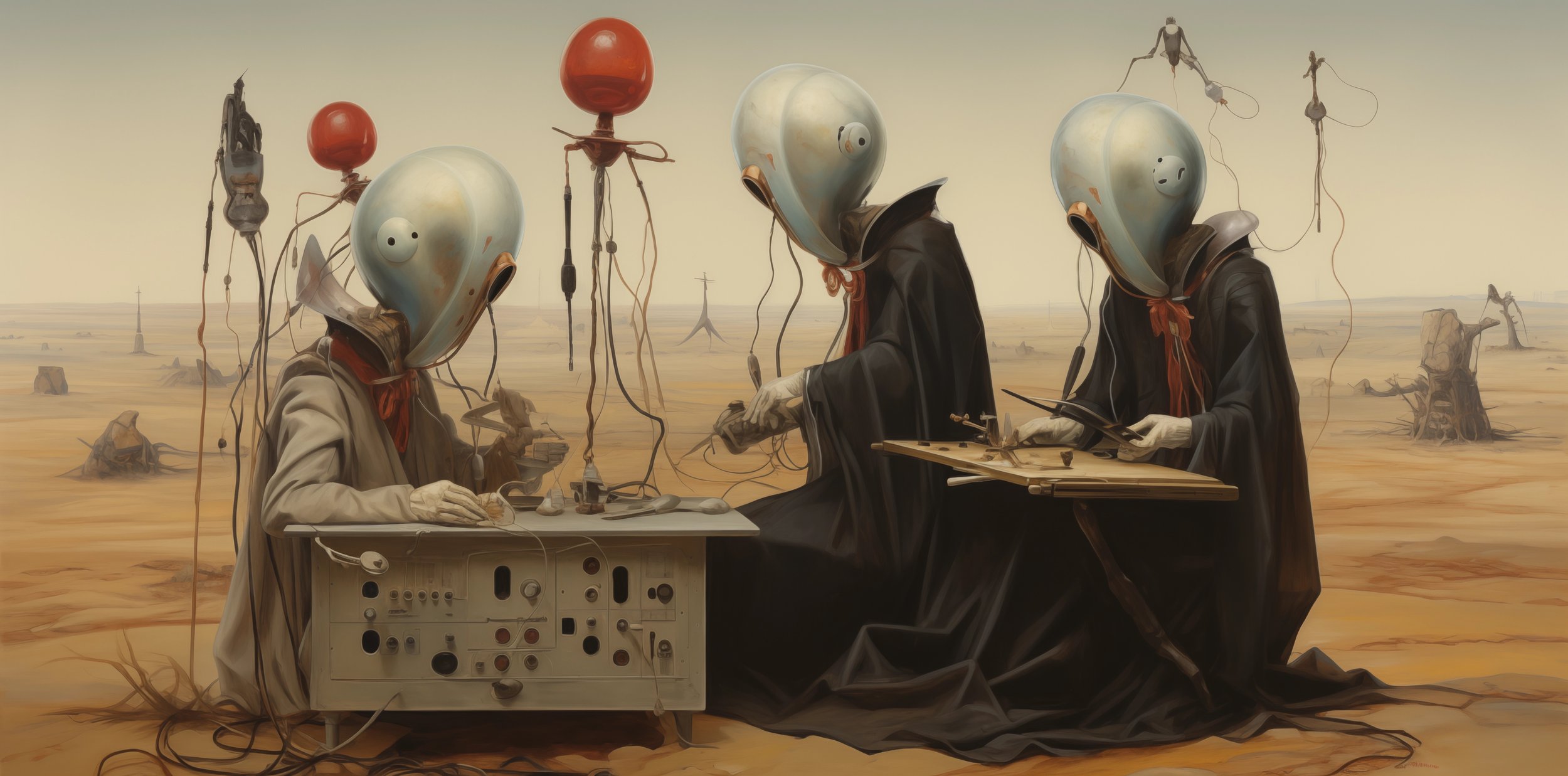

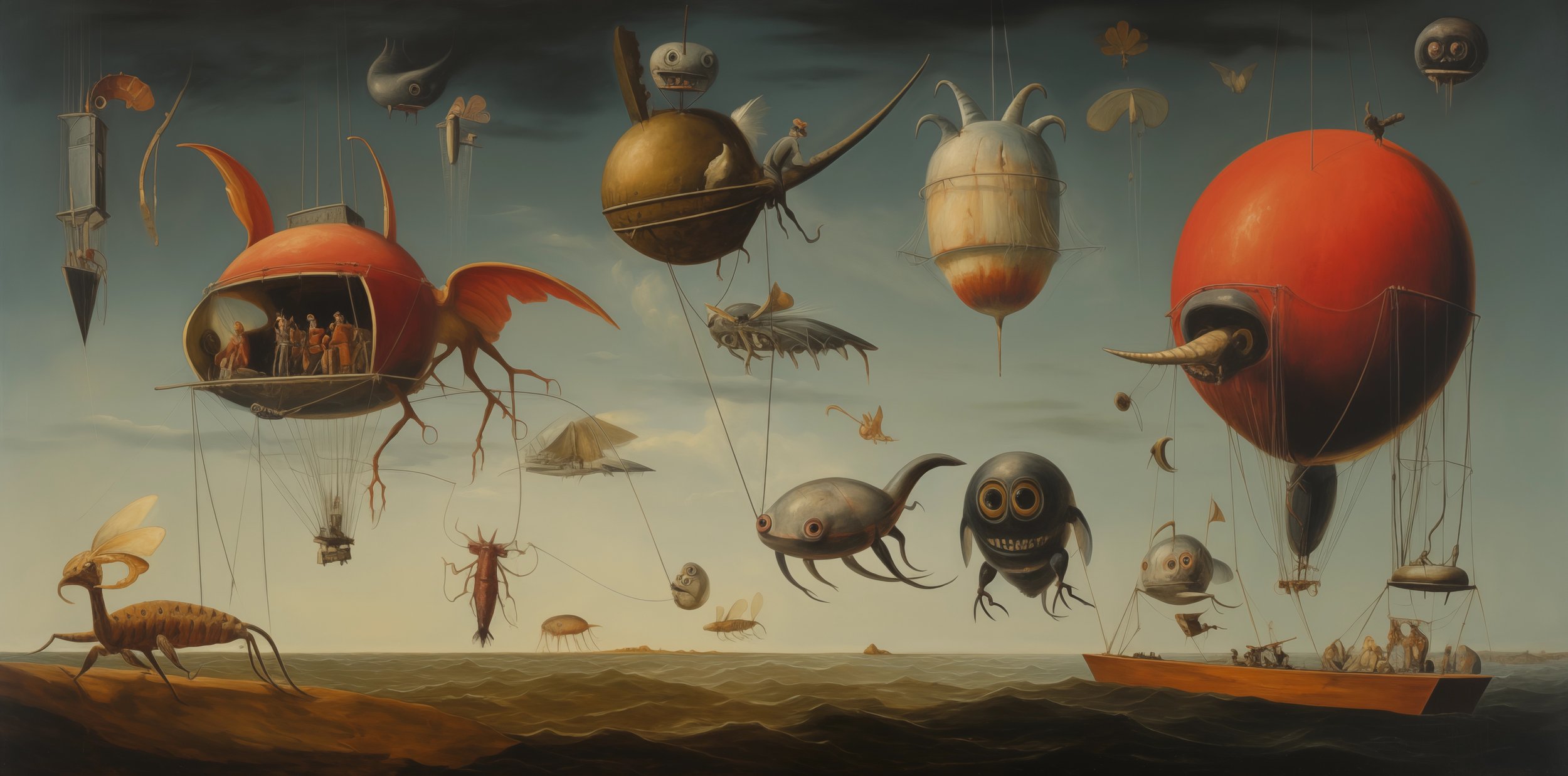
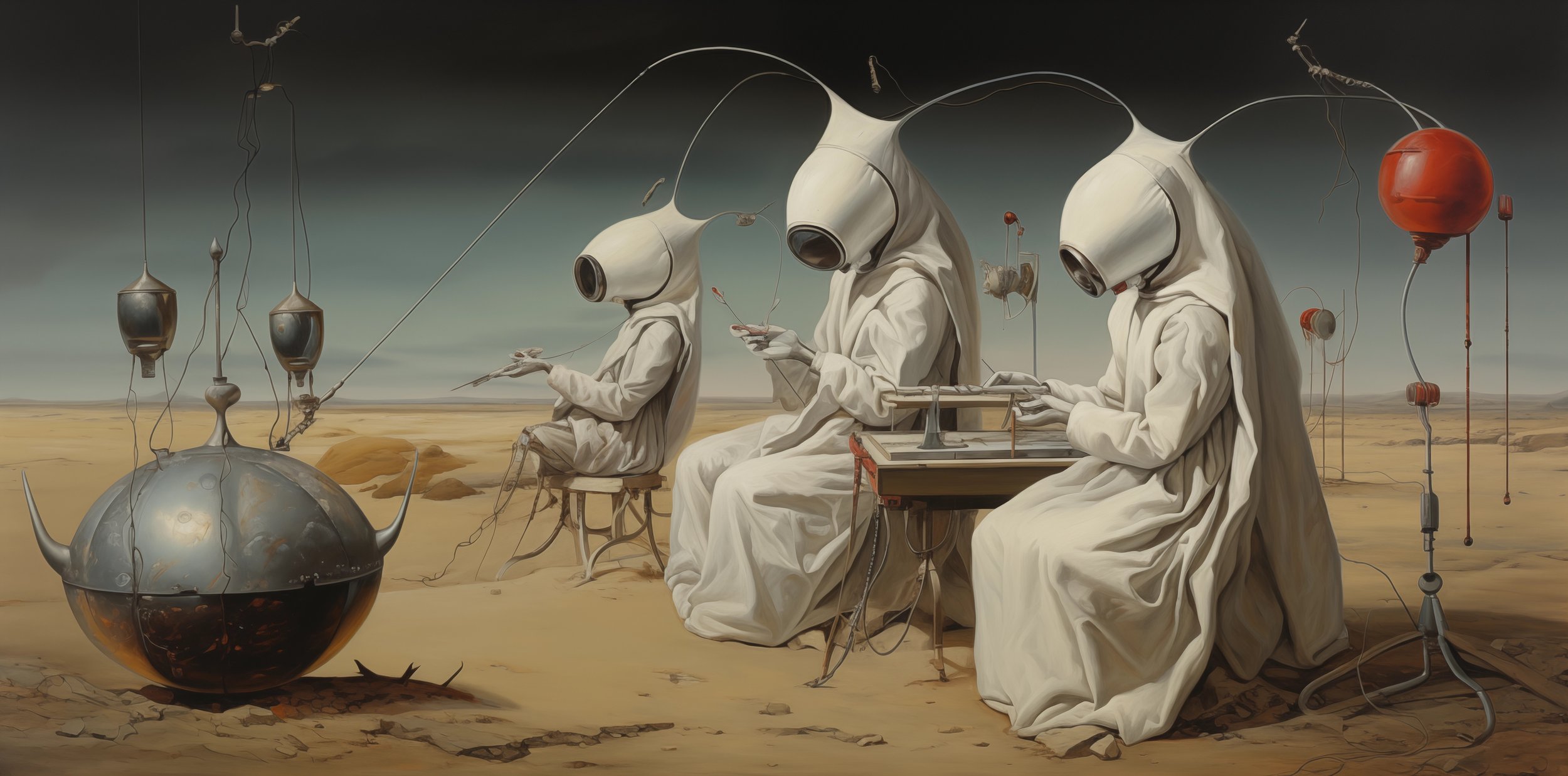
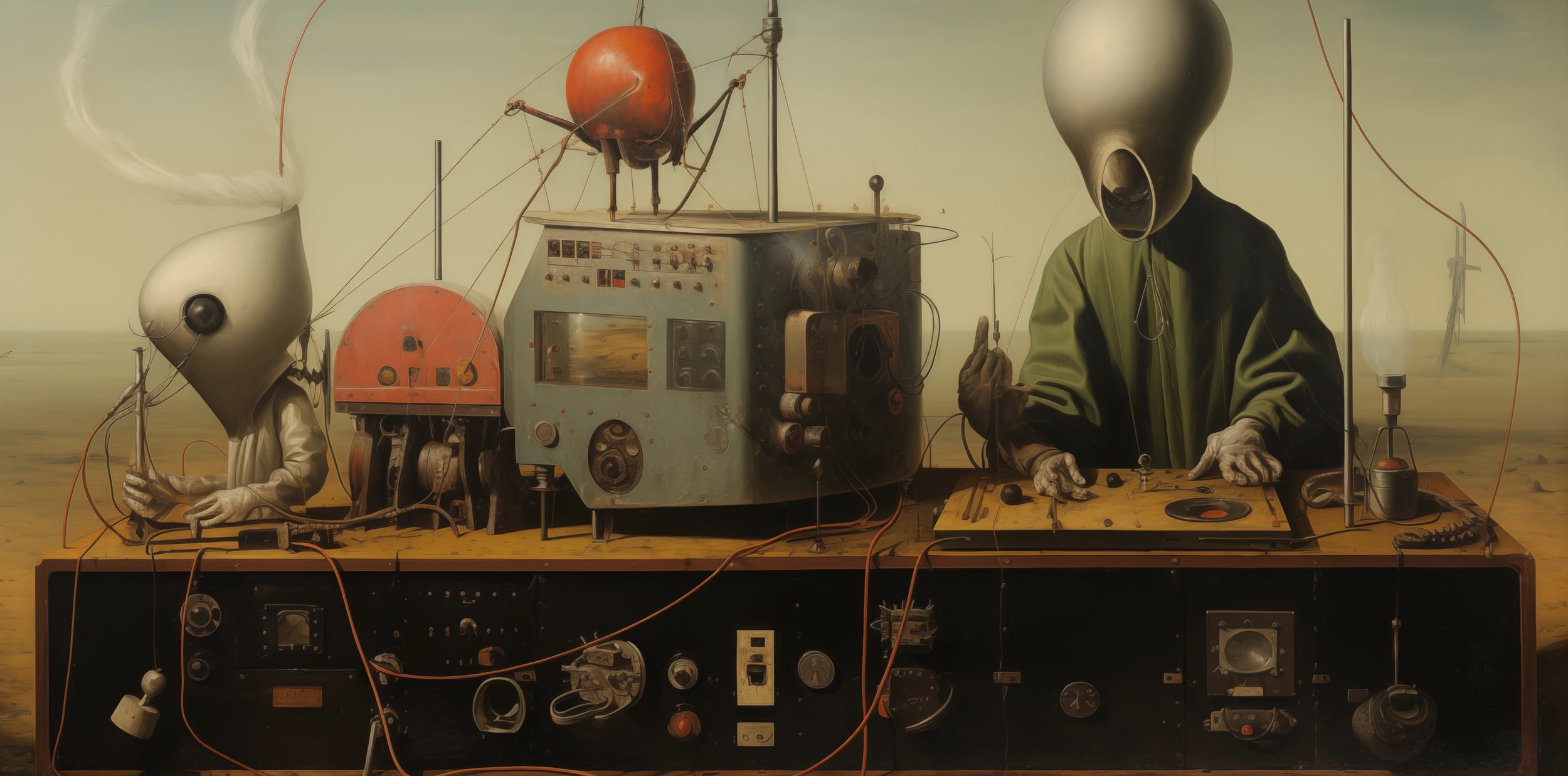
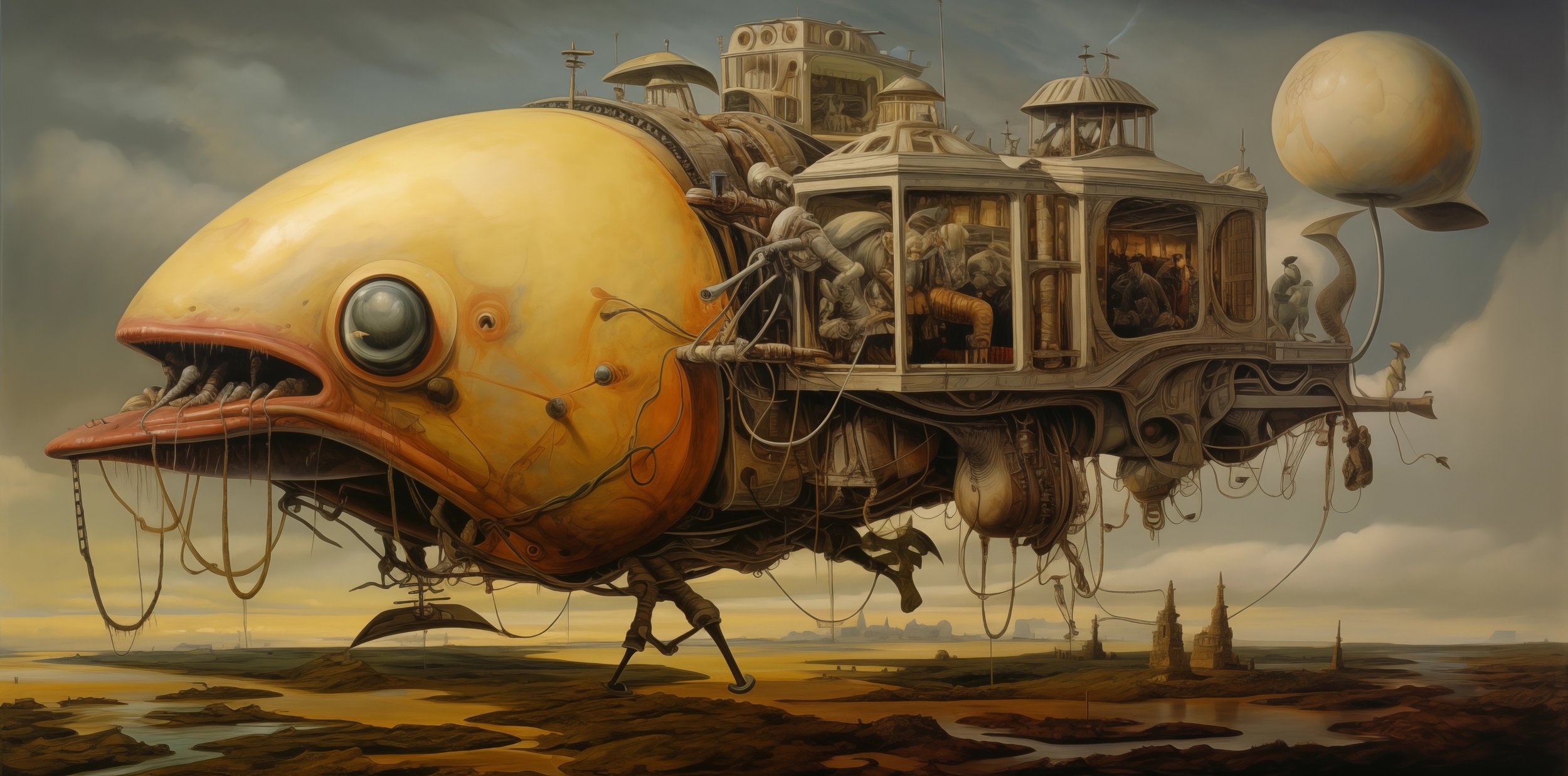

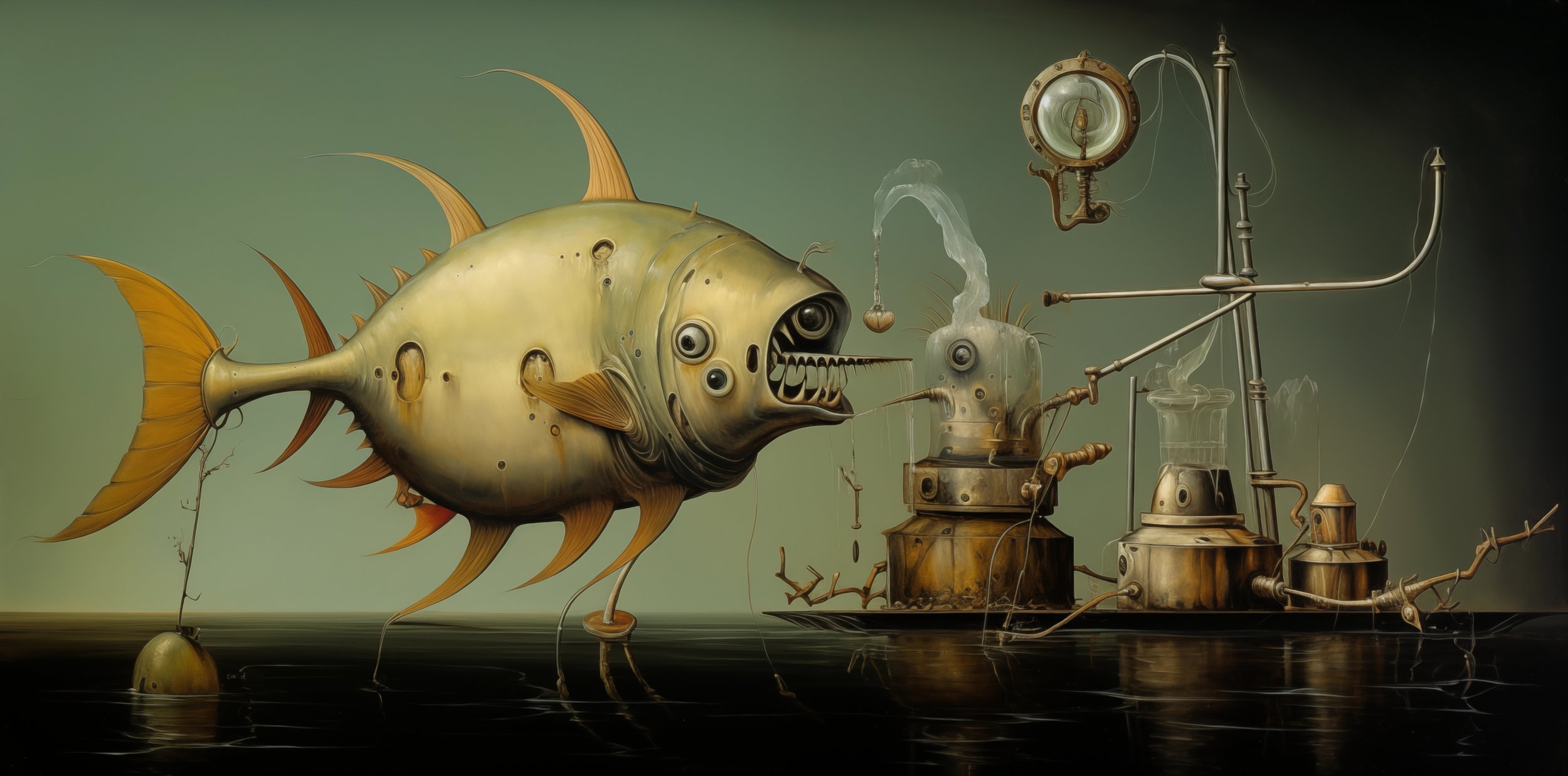
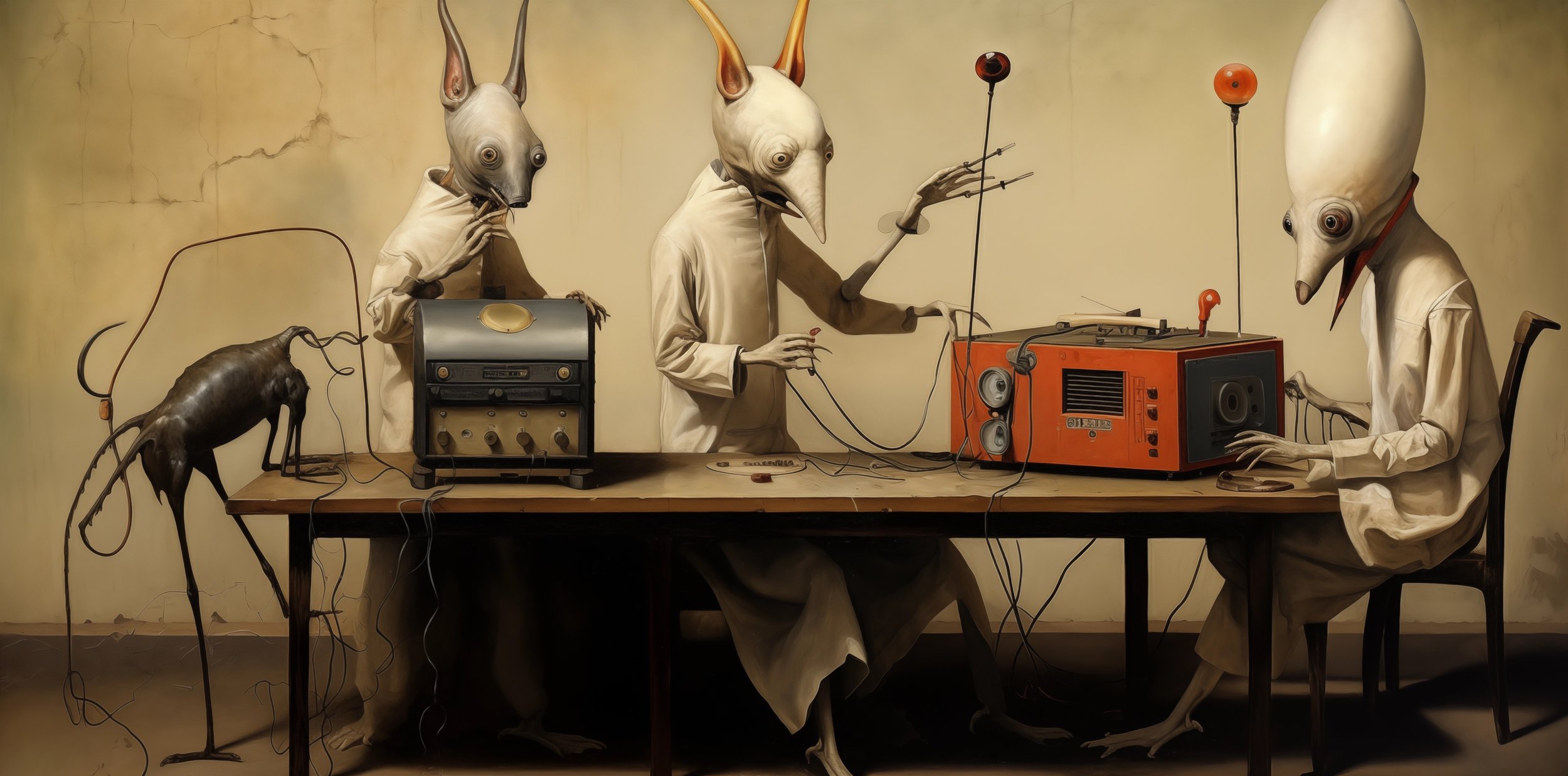
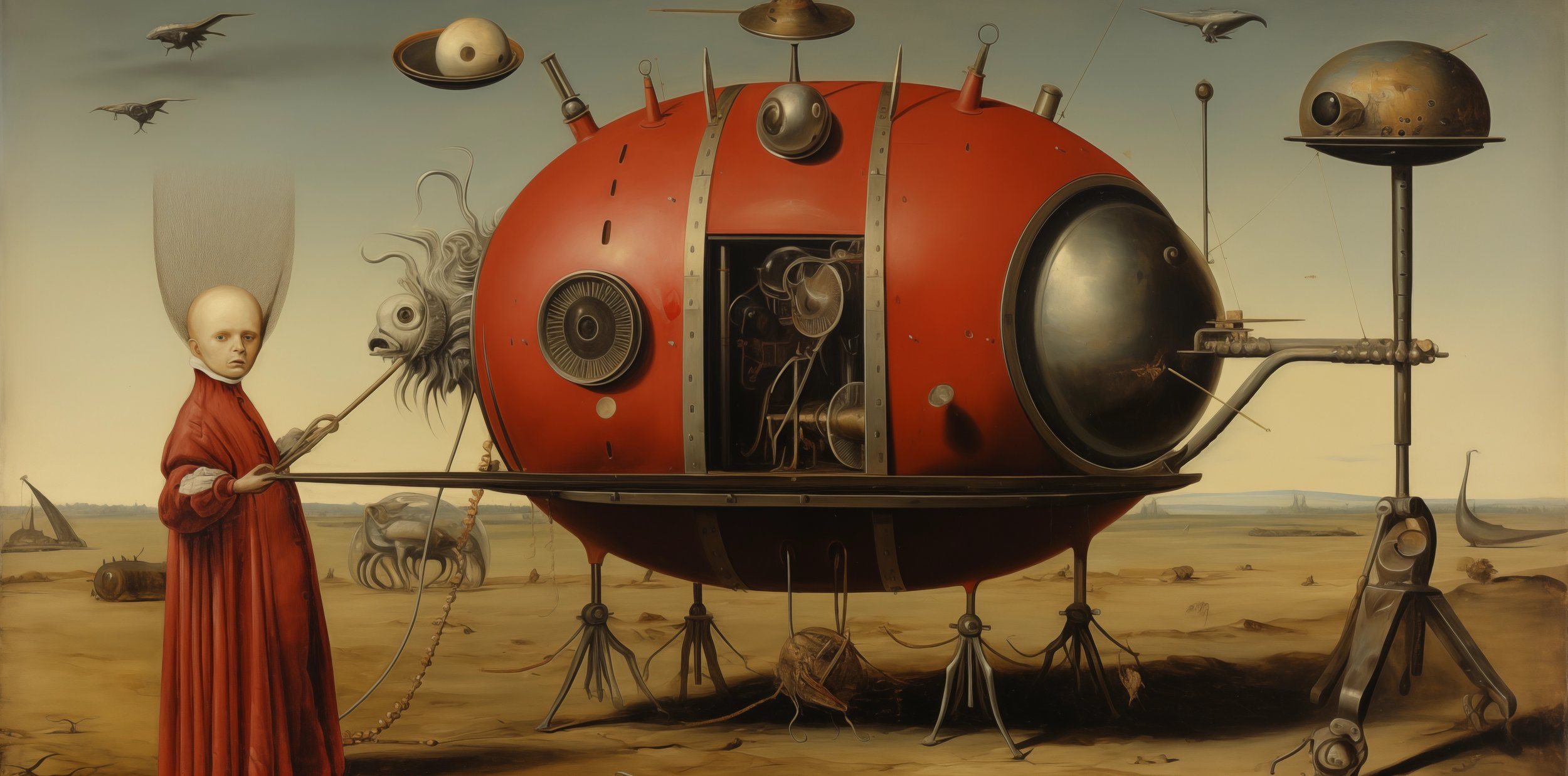
The Guardian of the Red Orb
Amidst a desolate expanse that stretches to the edge of thought, the Guardian of the Red Orb stands sentinel. Clad in robes the color of the setting sun, the figure embodies the silence and solitude of the wasteland it oversees.
Before it, the Red Orb—a spherical construct of otherworldly design—hums with the mysteries of a thousand ages, its surface a tableau of unknown mechanisms and arcane symbols. It is a beacon in the barrenness, a repository of knowledge or power, its true purpose known only to its enigmatic guardian.
Beside the Guardian, a creature as peculiar as the landscape itself seems to draw sustenance or perhaps knowledge from the Orb. This being, part organic, part mechanical, exists in symbiosis with the artifact, a living testament to the fusion of natural and the technological.
The scene is a silent narrative, a single frame in a story that spans the chasm between the conceivable and the inconceivable. It is a testament to the guardianship of secrets, the preservation of that which lies beyond the veil of understanding.
In the stillness that surrounds this tableau, a question resonates, as timeless as the very sands they stand upon: What realms of wonder and wisdom might we discover if we look beyond the horizon of our certainties?
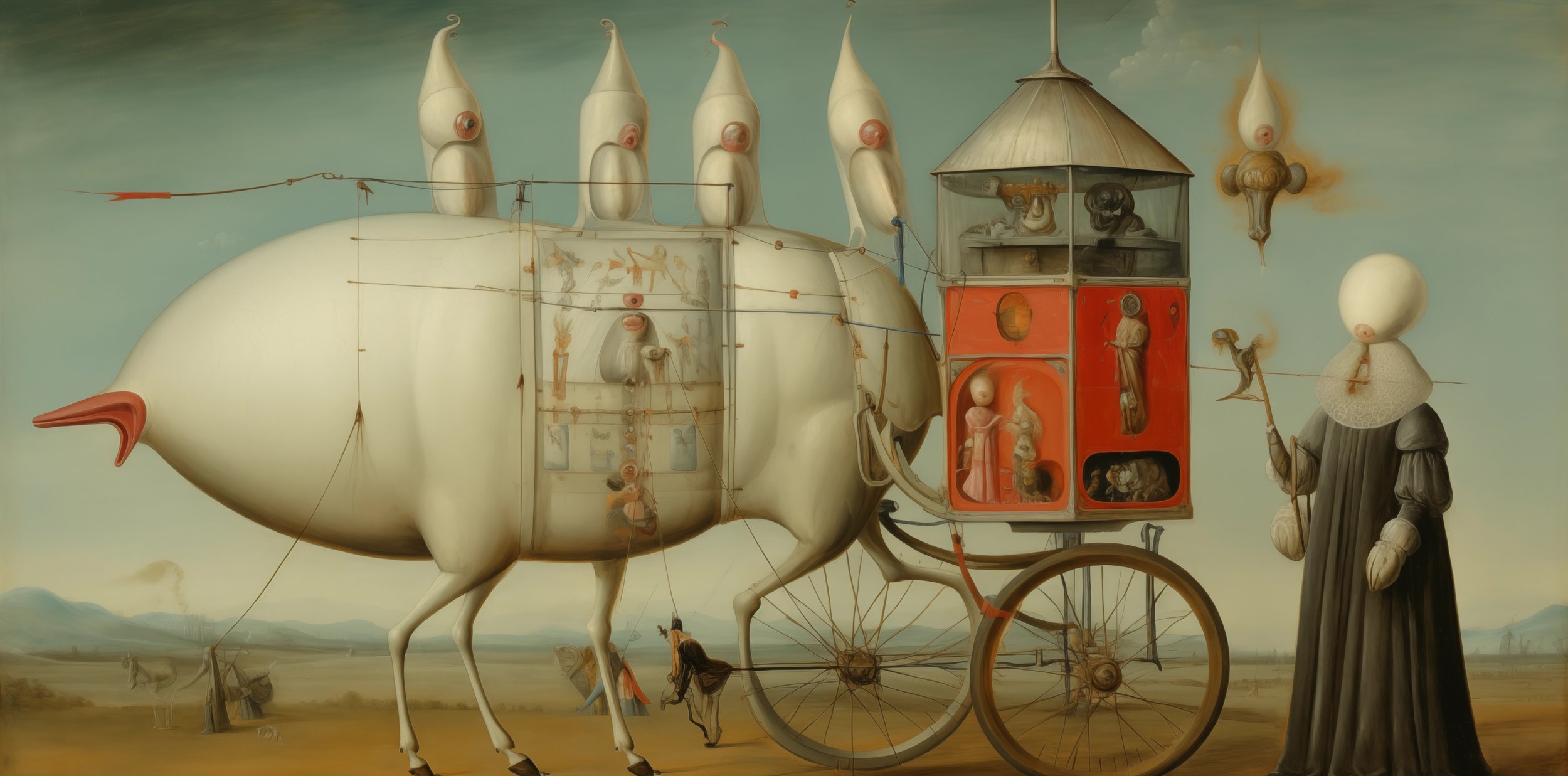
Playing hard, living loud, moving around fast, resting deep and enjoying it all.
